- Skip to primary navigation
- Skip to main content
- Skip to primary sidebar
BanffandBeyond
The Canadian Rockies Through A Local Perspective

A Trip Planning Guide For The Canadian Rocky Mountains
Do you want to plan a trip to the Canadian Rocky Mountains but have no idea where to start? The hardest decision will be narrowing down what you want to see. It will never seem like you have enough time to take in all the beauty the mountains have to offer. We’ve put together this Canadian Rocky Mountain guide to help you plan the perfect trip.

When Is The Best Time Of Year To Visit The Rocky Mountains?
There’s no correct answer to “When is the best time to visit the Canadian Rocky Mountains?” They are a year round destination with spectacular scenery in every season. So how do you decide when to visit? It depends on what you want to see, the activities you’re interested in and what type of budget you have.
Our post on When is the best time to visit Banff National park and the Rocky Mountains will help you narrow down to a time of year that suits you.
You may want to time your trip so that you can attend a specific event such as the Lake Louise Ice Magic Festival or attending the Calgary Stampede .
Keep in mind that winter is a long season in the mountains, especially in higher elevation areas like Lake Louise. Spring time is still skiing season, the summer months pass by quickly to make way for the fall colours and then mother nature will decide how early the snow returns and winter sets in.
Seeing the coloured glacier lakes is on many peoples wish list. If this is your goal make sure your trip accordingly. See our post on when the Rocky Mountain lakes thaw and get their beautiful turquoise colour .
Seasonal Closures, Construction And Maintenance
Occasionally the parks have to do upgrades or maintenance to a popular tourist attraction or site. This could mean limited or no access for a period of time. Areas affected in Banff National Park will be posted here: Banff Maintenance And Construction .
Roads and areas of the parks are closed at various times for wildlife conservation and avalanche risk. For Banff National Park you can see the list of closures here: Banff Seasonal Closures.
Pros And Cons Of Banff And Jasper National Parks In The Shoulder Season Of April And May
Misconceptions and Mistakes Made When Visiting The Canadian Rocky Mountains
How To Pack For A Canadian Rocky Mountain Trip
Weather across Canada varies dramatically. While it may be spring like in Vancouver on the west coast, the mountains are still buried in snow. If you’re visiting between November and March it’s a must to have proper winter clothing including boots, an insulated winter jacket, gloves and a warm hat. During the rest of the year there can be wide variances in conditions and temperatures. Be prepared with several clothing options.
For more information see what to expect for weather and temperatures in the Canadian Rocky Mountains.
What needs to be in your suitcase depends on the time of year, the length of your stay and the activities you plan to participate in.
For information on what to put in your suitcase see our post on How to pack for a visit to the Canadian Rocky Mountains.
What Is An Ideal Length Of Time To Spend In The Rocky Mountains
We recommend a minimum of a week to get a taste of what the mountains have to offer, especially if you are trying to fit in several places such as Banff and Jasper National Parks. Visitors often underestimate how vast these areas are and the driving times involved in getting around. A visit limited to just Banff may be suitable to three or four days. If you plan on doing a lot of sightseeing and adding in activities such as hiking you’ll likely want more time.
Ten days to two weeks is ideal to take in Banff and Jasper National Parks at a leisurely pace. This amount of time might allow you to explore attractions in neighbouring areas Kootenay National Park, Yoho National Park and Kananaskis Country.
When flying make sure you account for the time needed for getting to and from the airport. If your budget and time allows there are more places worth visiting like Drumheller and the Badlands or the small but charming Waterton Lakes National Park . There are several other alternative parks and overlooked areas in the Rocky Mountains that are worth your time.

Driving a circle route that includes the west coast of B.C. warrants at least ten days to two weeks. It’s nearly 850 km’s between Vancouver and Banff and a minimum of 9 hours of driving time each way. It’s best to break up the drive with at least one overnight stay. In addition to exploring Vancouver you may want to add a few extra days to see some of the beauty of Vancouver Island.
For trip options see our post on driving routes between Vancouver to Banff and Jasper .
Getting To The Canadian Rocky Mountains
The flight options available to international visitors may have you accessing the Rocky Mountains through one of several airports. Calgary, Alberta is the closest international airport, followed by Edmonton, Alberta and then Vancouver, British Columbia on the west coast of Canada.
For those coming from other destinations within Canada or North America there are domestic flights as well as train travel, buses, guided coach tours and self driving.
More details are covered in our post on Options For Getting To The Canadian Rocky Mountains.
Navigating The Rocky Mountains Once You Arrive
Self driving in the mountains is the most popular option because it provides the greatest flexibility. The roads are easy to navigate and many people feel comfortable driving in the area. The exception would be the winter season. Driving at this time is not for everyone and shouldn’t be attempted by those without winter driving experience.

If you’re flying into one of the international airports you can conveniently arrange to pick up your rental vehicle there. Banff, Canmore and Jasper also have vehicle rental options. Make sure you understand all the details of your contract including the insurance coverage, whether it has unlimited kilometers and the return policy. There may be restrictions that can void your insurance including driving on unpaved roads or taking the vehicle into the U.S.A. Many companies prohibit using chains for winter driving as they can cause damage to the vehicle.
If you’re thinking of driving one way between the west coast of British Columbia and the Rocky Mountains or vice versa it can be an expensive option. The one way drop of fee between the two destinations can be as high as a thousand dollars. Do your research to see which companies offer the cheapest rate.
If you do not want to self drive you can consider booking a tour as part of a package with your flight or book tours to attractions with local companies. It is possible to get around some areas of the mountains with public transportation and shuttles.
For more information see our post: How to get around the Rocky Mountains without a vehicle .
Canada Driving Road Laws And Safety

Driving and safety tips can be found at the following sites: For the province of B.C. at ICBC Road Safety and for Alberta at Alberta driver and traffic safety . Other provinces may have varying regulations.
Where To Base Yourself In The Rocky Mountains
Whether you base yourself in one spot in the Rocky Mountains or change accommodations depends on what parks you want to see and how much driving you are willing to do. In Banff National Park you can choose between staying in Lake Louise versus the Banff Townsite . There’s usually no need to stay in both places, it’s a 40 minute drive between the two. Day trips to explore the park as well as heading west into Yoho National Park and the southern end of the Icefields Parkway can be done from either location.

There’s an option of using the town of Canmore as a base. It is not in the national parks, but sits just a 15 minute drive east of the Banff town site. One town might appeal to you more than the other depending on your tastes. We’ve covered the differences here in our post on Canmore versus Banff .
If you plan on spending time in Banff and Jasper it’s best to book accommodation in both places. The driving time from the town of Banff to Jasper is approximately 3 to 3.5 hours in each direction. It would be a lot of driving to do as a return day trip between the two and it wouldn’t leave you enough time to see all the incredible attractions along the Icefields Parkway. For more information see our post on Tips For Driving The Icefields Parkway and for comparisons between these two parks check out Jasper National Park versus Banff National Park .
Accommodation And Budgeting Options
The amount of accommodation choices in the Banff and Canmore area can be overwhelming. Jasper is a bit more limited and in Lake Louise the options are very sparse in comparison. There’s times of the year where winging it is simply not an option. During the peak summer demand the lodging in all of these areas may need to be reserved up to six months in advance. If you leave your booking too late it may be difficult to find a room or you can be stuck paying exorbitant prices.

There’s a wide range of accommodation types from high end luxury resort style properties and lodges to mid-range hotels, condo suites, bed and breakfasts and hostels.
No matter how you look at it the Canadian Rocky Mountains are not a cheap place to visit. Restaurants, tourist attractions, car rentals are expensive and you’ll likely find the cost of camping and staying in a hostel more expensive than many other places you have visited.
For more information on seasonal accommodation prices and other costs in the Canadian Rockies see our post on How To Visit Banff On A Budget.
Camping is available for tents and RV’s. If you plan to camp be aware that not all campgrounds are able to be reserved. Some sites operate on a first come first served basis. See Parks Canada Camping Reservations for more information. The main season for camping is from late May to early October, outside of that time frame there are very few camping options.
Canadian And Rocky Mountain Cuisine You May Want To Try During Your Visit
Canada is a multi-cultural country and therefore has a variety of different foods to try as well as some cuisine unique to the country. Many of the same foods can be found in the Rockies along with some dishes specific to the mountains.
See our post on Foods And Drinks To Try During Your Canadian Rocky Mountain Visit .
Required Passes For Visiting Canada’s National Parks
Park passes are required for entry into any national park in Canada. You can buy a day pass at a park gate or at visitor centers within the parks. If you intend to visit several of Canada’s national parks or spend more than a few days in them consider an annual Parks Canada Discovery Pass. With it, you can visit more than 100 national parks, marine conservation areas and historic sites across Canada. Passes are not required for entering our provincial parks or recreation areas.
More information can be found here: Understanding the Parks Canada Entry Fees
What’s The Best Way To Pay For Things On Your Canadian Rocky Mountain Vacation.
If you’re visiting from another country it can be a daunting task to try and figure out the best way to pay for things on your trip. No matter what the method you choose you will incur expenses in the form of currency exchange and transaction fees. It’s just an inevitable part of the cost of traveling.
What many people end up doing is using their credit card for their accommodation, vehicle rental and other major costs and accessing local currency to pay for the lesser daily expenses.
For more information on forms of payment see our post: Tips for currency exchange and using international credit cards in the Canadian Rockies.
Taxes That Tourists Pay In The Rocky Mountains
Whether you are a tourist or a citizen of Canada there are taxes that you will pay on goods you purchase, services used and on our accommodation and other vacation expenses. For detailed tax information see our post taxes you can expect T axes That Tourists Can Expect To Pay In The Canadian Rocky Mountains .
Tipping Etiquette
Throughout the Rocky Mountains and the rest of Canada tipping is practiced. If you’re an international traveling visiting Canada it be confusing knowing who and how much to tip. Our post Canadian Rockies Tipping Etiquette outlines a basic guideline that you can follow.
Required Travel Documents To Visit Canada
Find out what you need to enter Canada long before you book your trip. Most travelers will need a valid entry document such as an Electronic Travel Authorization ( eTA ) or a visa. It will depend on your citizenship. U.S. citizens are an exception. They still need to present acceptable travel documents and identification at the border. A passport is still highly recommended for U.S. citizens traveling into Canada. It may be required by your airline or other transportation authority.
Check the Canada Customs site to find out what items are not allowed to be brought into the country and anything that may have your entry denied. Everything you need to know about the required documentation and entry into Canada can be found here: Government Of Canada/Visit Canada
Medical Insurance And Travel Insurance
Travel with adequate insurance to cover the cost of medical emergencies while you are in Canada. If you do not have insurance the cost of emergency medical treatment could be overwhelming. Trip cancellation insurance can give you some peace of mind knowing you are covered if you have a necessary reason to cancel your trip.
Canada Time Zones
Canada is a large country spread across 6 different time zones from east to west. If your visit is focused on Jasper, Banff, Yoho and Kootenay National Parks you will only have the Mountain Time zone to be concerned with. The entire province of Alberta is on Mountain time and it extends into a small portion of the neighbouring province of B.C.
Most of Canada practices Daylight Savings Time. From late Autumn through to early Spring is Mountain Standard Time (MST), it is UTC-7. From early Spring to late Autumn is Mountain Daylight Time (MDT), it is UTC-6.
West of the Canadian Rocky Mountain Parks it is the Pacific Time zone. It is one hour behind Mountain time. Keep this in mind when traveling. You’ll either lose or gain an hour depending on the direction of travel between the two time zones.
If you’re driving there are signs marking the time change. On the Trans Canada Highway the change occurs at the eastern slope of Rogers Pass. On the Yellowhead Highway the time change is the western boundary of Jasper National Park at the continental divide, signs mark the time zone change in both directions.
A map of Canada time zones with a live clock can be viewed here: Canada Time Zone Map
Legal Drinking Age And Smoking Laws
The legal drinking age is not the same across Canada, it is set by each province. In Alberta it’s 18, but take note if you cross over into nearby B.C. it’s 19. This is for both consuming alcohol and purchasing alcohol. Take note that smoking laws are becoming very restrictive with practically little to no smoking in any indoor spaces and tight restrictions for smoking outdoors in public spaces including cannabis use. More information is available here: Tobacco and cannabis use in Banff.
Cellphone And Wifi In Canada And The Rocky Mountains
Don’t expect that you will be able to get cell phone reception throughout the Canadian Rocky Mountain Parks. It’s not something that can be relied upon outside of the town site areas. For more information on cell phone and WiFi service in the mountains see our post: Cell Phones And WiFi In The Canadian Rockies .
Electrical Plug And Voltage Information For Canada
Depending on the country your electronics are from you may need a socket converter for the plugin and possibly a voltage converter to operate the device in Canada. Many modern digital devices such as laptops and cellphones are now made for world wide voltages, but always check otherwise you could damage the item. For more information on what you may need to operate your electronics see Power And Plugins In Canada .
The Canadian Rockies Travel Guide
Book your individual trip , stress-free with local travel experts
Select Month
- roughguides.com
- North America
- canadian-rockies
- Travel guide
- Itineraries
- Travel Advice
- Accommodation
Plan your tailor-made trip with a local expert
Book securely with money-back guarantee
Travel stress-free with local assistance and 24/7 support
Rising with overwhelming majesty from Alberta’s rippling plains, the Canadian Rockies are one of the main reasons people come to Canada, and few North American landscapes come as loaded with such high expectations. So it’s a relief to find the superlatives scarcely exaggerate the splendour or immensity of the region’s forests, lakes, rivers and snow-capped mountains. Many of the best bits have been hived off into several impressive national parks, but be warned that planning an itinerary that neatly fits them all in is just about impossible. It’s also unnecessary: the parks are equally sensational so it’s best to put as much effort getting deep into the backcountry in one or two spots as it is to tour the most accessible highlights and main hubs.
Bears and other wild animals
The creation of the canadian rockies, rafting in the rockies, banff region.
- Jasper National Park
Winter sports in the Rockies
Joined to their smaller US cousins, the Canadian Rockies extend north of the US border almost 1500km to Canada’s far north, where they merge with ranges in the Yukon and Alaska, forming the Continental Divide in the process – a vast watershed which separates rivers flowing to the Pacific and Arctic oceans from those flowing into the Atlantic. But the range is best known for its virtually unbroken north–south chain of national and provincial parks, and for its world-class ski resorts.
Almost immediately west of Calgary, the region’s main gateway city, lies Kananaskis Country . This series of less restrictively managed provincial parks exists in part to take the pressure off the adjacent Banff National Park , the region’s best known and busiest park. Just north the range is protected by the less visited Jasper National Park , by far the largest park in the region. The western boundary of both Banff and Jasper parks is also the provincial border, so adjacent areas are protected in a separate set of BC parks: Mount Robson Provincial Park , just west of Jasper – which protects Mount Robson, the highest and most dramatic peak in the Canadian Rockies – while Yoho and Kootenay national parks lie just west of Banff National Park. At the southern end of Canada’s Rockies, and coupled with Glacier National Park in the US, is small but impressive Waterton Lakes National Park .
To see as many of the highlights as possible in a couple of weeks, start with Banff National Park, then head north along the otherworldly Icefields Parkway to Jasper and Mount Robson before doubling back – no hardship, given the scenery – to take in as much of the Yoho–Golden–Radium–Kootenay loop as your time allows. With another week to play with, you might try to miss some of Kootenay in favour of a bigger loop south through Kimberley, Fernie and Waterton Lakes – the latter particularly tempting if you are on your way to or from the US.
You can get to all the parks except Waterton by bus , but travelling by car is the obvious way to get the most out of the region. Once here, you’d be foolish not to tackle some of the 3000km of hiking and biking trails that crisscross the mountains, the vast majority of which are well worn and well signed. We’ve highlighted the best short walks and day-hikes in each area, and you can get more details from the excellent park visitor centres , which sell 1:50,000 topographical maps and usually offer reference libraries of trail books. Other activities – fishing, skiing, canoeing, whitewater rafting, cycling, riding, rock climbing and so on – are comprehensively dealt with in visitor centres, and you can easily rent equipment or sign up for organized tours in the bigger towns.
Finally, don’t underestimate the Rockies. Despite the impression created by the summer throngs in centres like Banff and Lake Louise, with their excellent roads and sleek park facilities, the vast proportion of parkland is wilderness and should be respected and treated as such.
Two types of bear roam the Rockies – black bear and grizzly – and you don’t want to meet either. They’re not hugely common and risks are pretty low on heavily tramped trails, but if you’re camping or walking it’s still essential to be vigilant, obey basic rules, know the difference between a black bear and a grizzly (the latter are bigger and have a humped neck) and how to avoid dangerous encounters, and understand what to do if confronted or attacked. Popular misconceptions about bears abound – that they can’t climb trees, for example (they can, and very quickly) – so it’s worth picking up the park service’s pamphlet You are in Bear Country , which cuts through the confusion and advises on how to behave to avoid attacks. Cardinal rules include storing food and rubbish properly, making sure bears know you’re there, not approaching or feeding them, and, if you meet one, not screaming or running away.
Other wild animals can also be dangerous, and while you would be unlucky to encounter cougars, which are relatively rare, the chances of meeting elk are much higher. Generally, these are benign creatures, often seen grazing at roadsides, but can become aggressive if approached or if they are with young; don’t clamber out of your car, or cross the highway, to poke a camera in their faces.
About four hundred million years ago, eroded debris from the mountains of the Canadian Shield (which covered North America from Greenland to Guatemala) was washed west by rivers and deposited as mud, shale and limestone on a “continental slope”. Then, about two hundred million years ago, two strings of volcanic Pacific islands began to move eastward on the Pacific Continental Plate towards the North American coast. When the first string arrived off the coast, the heavier Pacific Plate slid beneath the edge of the North American Plate. The lighter rock of the islands stayed above, detaching itself from the plate as they crashed into the continent. The orderly deposits on the continental slope were crumpled and uplifted, their layers riding over each other to produce the coast’s present-day interior and Columbia Mountains. Over the next 75 million years, the aftershock of the collision moved inland, bulldozing the ancient sedimentary layers still further to create the Rockies’ Western Main Ranges (in Yoho and Kootenay national parks), and then moving east, where 4km of uplift created the Eastern Main Ranges (the mountains on a line with Lake Louise).
Following the first islands, the second archipelago also crashed into the continent, striking the debris of the earlier collision and creating more folding, rupturing and uplifting of the earlier ranges. About sixty million years ago, the aftershock from this encounter created the Rockies’ easternmost Front Ranges (the line of mountains that rears up from the prairies). Three ice ages over the last 240,000 years applied the final touches, carving sharp profiles and dumping further debris.
Rafting in the Canadian Rockies has become very popular, with a range of experiences on offer, from mellow, relaxing float trips to whitewater odysseys that require you to be a strong swimmer. Either way, no previous experience is generally required, but it’s handy to know how rivers are graded : Class 1 water is gentle, Class 6 basically a waterfall. The season runs from May to mid-September, with the “biggest” water generally in June when snowmelt swells rivers. Operators should supply you with everything you need, and will probably also provide a shuttle from the main regional towns. On any trip it’s a good idea to have a change of clothes, wear shoes you don’t mind getting wet, bring a towel and have a bag for valuables.
In the Banff region, the main whitewater river is the Kicking Horse , on the edge of Yoho National Park, an hour from Banff. Its Class 4 sections (including one called “Man Eater Hole”) in the upper sections and stretches of the Lower Kicking Horse Canyon give even seasoned rafters pause for thought. More tranquil is the Kootenay River , in Kootenay National Park, two hours from Banff, a Class 2–3 river; meanwhile, Banff’s stretch of the Bow River is a haven for mellow float trips through pretty scenery.
In Jasper National Park , the Class 2 Athabasca River (from Athabasca Falls, 35km south of the town) is scenic and provides gentle rafting, with one or two harmless whitewater sections, from May to October. The Class 3 Sunwapta River , 55km south of Jasper, offers some thrilling stretches of water, magnificent landscapes and good chances to spot wildlife. The Class 2–3+ Maligne River , 45km from town, includes a lively 1.6km stretch of rapids and is used for a variety of trips from July to September. The Fraser River , an hour west of Jasper in Mount Robson Provincial Park, is Class 4 in places but also has some gentle sections where the chance to watch salmon spawning at close quarters from mid-August to September provides an added attraction.
Operators can be found in Banff, Lake Louise, Canmore, Golden, Radium and Jasper.
With terrific terrain, reliable snow cover, uncrowded slopes and relatively low prices, the Rockies are perfect for a ski or snowboard holiday . The region is also ideal for a host of other winter sports like cross-country skiing, snowshoeing, dogsledding and snowmobiling (though the latter is not allowed in national parks). The season at most resorts runs from mid-December until the end of May, with the best conditions usually in March, when the days are getting warmer and longer and the snow is deepest.
The best known, busiest and most expensive resorts are in Banff National Park and within easy reach of the town of Banff. These include the small and steep Mount Norquay ; the well-rounded, intermediate-friendly Sunshine Village ; and the vast, varied and challenging Lake Louise . The three have a joint lift-ticket system. Locals make up a sizeable chunk of the business, and weekends and holidays are peak times, leaving working weekdays particularly quiet. A glorious three-hour drive north of Banff through craggy montane scenery along the Icefields Parkway lies Marmot Basin . Though far more modest than the Banff resorts, it is quieter and less expensive and has a truly vast system of cross-country ski trails on its doorstep.
In BC’s Rockies, several less accessible resorts are often blessed with even better snow and milder temperatures. And with much of the land here outside strictly regulated national park boundaries, there’s plenty of heli-skiing nearby too. The closest to Banff is Kicking Horse , which bristles with high-alpine expert terrain and awesome views. The grand vistas have provided the name of the next major resort south: mellow Panorama is ideal for cruising around a quiet resort village. Another couple of hours’ drive south is the cheerful, family-oriented ski hill Kimberley . Its multi-day tickets are valid at Fernie , where bountiful mountain bowls and ridges can take weeks to fully explore. With each of these BC resorts no more than a couple of hours’ drive from the next, they make for an ideal multi-resort trip tackled that includes Banff and can be tackled as a loop from Calgary.
Top image: Elk in Jasper National Park, Alberta, Canada © Weekend Warrior Photos/Shutterstock
Discover more places in Canada
- Banff National Park
- The Columbia and Kootenay valleys
- Icefields Parkway
- Mount Robson Provincial Park
- Waterton Lakes National Park
- Yoho National Park
- Kananaskis Country
- Kootenay National Park
The Rough Guides to Canada and related travel guides
In-depth, easy-to-use travel guides filled with expert advice.
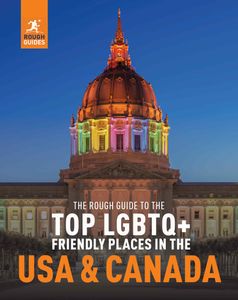
Find even more inspiration for Canada here

Planning your own trip? Prepare for your trip
Use Rough Guides' trusted partners for great rates
written by Rough Guides Editors
updated 06.09.2021
Ready to travel and discover Canada?
Get support from our local experts for stress-free planning & worry-free travels.
- Travel advice
- Where to stay
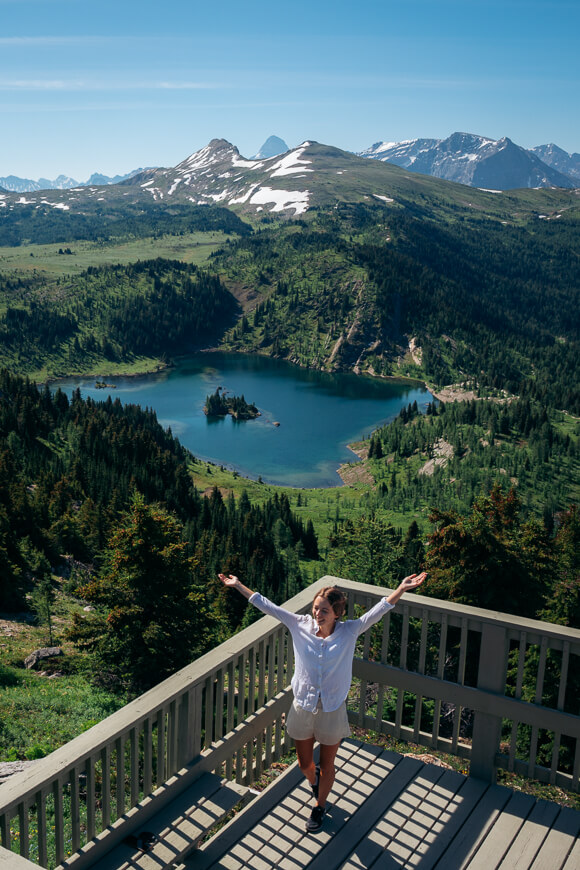
Endless Wonder
Your guide to travel and exploring the endless wonders of life
ALBERTA , CANADA , CANADIAN ROCKIES , NORTH AMERICA , TRAVEL DESTINATIONS · May 1, 2020 updated on June 29, 2023
Canadian Rockies Ultimate Trip Planning Guide
The Canadian Rockies are a trip of a lifetime – everywhere you look you will be captivated by beautiful mountains, lakes and scenery. I grew up living 4 hours from the Rockies, and so I’ve put together my best Canadian Rockies travel tips to help you plan your trip to this stunning region.
Table of Contents
Canadian Rockies Travel Guide

Places to go in the Canadian Rockies
The Canadian Rockies are HUGE and are made up of a few Canadian National Parks and Provincial Parks.
National Parks of the Canadian Rockies:
- Banff National Park (Alberta)
- Jasper National Park (Alberta)
- Yoho National Park (British Columbia)
- Kootenay National Park (British Columbia)
- Mount Revelstoke National Park (British Columbia)
- Glacier National Park of Canada (British Columbia)
Provincial Parks of the Canadian Rockies:
- Bow Valley Provincial Park – Kananaskis Country (Alberta)
- Mount Robson Provincial Park (British Columbia)
- Mount Assiniboine Provincial Park (British Columbia)
Alberta’s Rocky Mountains have two national parks that are popular to visit: Banff National Park and Jasper National Park.
Banff National Park
Banff National Park is home to the Town of Banff and is also the place to go if you want to see the iconic Lake Louise and Moraine Lake. Banff is definitely the most popular place to visit in the Rockies, but rightfully so!
Read more: Banff National Park Bucket list: Everything to see & do there
Read more: 4 Day Banff Itinerary

Jasper National Park
Jasper National Park is home to the Town of Jasper, and is slightly less popular than Banff, but is still quite touristy! Jasper has some awesome hikes to do and is also home to some iconic spots, like Pyramid Lake and Maligne Canyon.
Read more: Jasper National Park Bucket list: Everything to see & do there
Icefields Parkway
The Town of Banff and the Town of Jasper are actually connected by one of the most scenic drives in the world: The Icefields Parkway. It is possible to do this drive in one day, but to make the most out of all of the stops along the way and have time for a hike or two, I would recommend spending at least 2 days if possible! The Icefields Parkway is also the place I have seen the most wildlife during my time in the mountains.
Read more: Best Places to Stop Along the Icefields Parkway

How to Get to the Canadian Rockies
If you’re flying into Canada, the two closest cities to the mountains are Calgary and Edmonton. Vancouver is a bit of a drive, but with enough time it’s doable.
If you fly into Edmonton, Jasper is the closest mountain town. If you’re flying into Calgary, Banff is the closest mountain town. From there, you can visit the other National and Provincial Parks in British Columbia’s Rockies.
The most popular option (and the best option!) is to rent some sort of vehicle. You can rent a car, SUV, travel van, or motor home to give you the freedom to drive at your own pace through the mountains – something that is so worth it!!
If you have your own vehicle you can stop when you want to (if you see an animal or roadside turnout/viewpoint that looks nice), and you can go where you want to when you want to. If you choose to rent a van or motorhome, this also gives you the option to sleep in your car.
Rental companies:
- Canadream – (allows rentals from Calgary &/or Edmonton) campervan & RV rental company
- Wicked Campers (Based in Calgary) – campervan rental company
- Karma Campervans (Based in Calgary & Vancouver) – campervan rental company
- Rental car info/options at Edmonton International Airport
- Rental car info/options at Calgary International Airport
Take the Bus
There are different shuttle bus options that will take you from the major cities (Edmonton or Calgary) and drop you off in either Jasper or Banff. Once you get to your destination it’ll be up to you to get yourself around, but this is a great option if renting a car is too expensive, but you still want to do your own thing! Public transportation and different shuttles are available once you get to Banff. Public transportation does not exist in Jasper.
*Greyhound bus used to be an option, but unfortunately Greyhound buses are no longer running on this route!
EDMONTON AIRPORT – JASPER
- Sundog Transportation & Tours: $99 CAD one way trip
CALGARY AIRPORT – BANFF
- Brewster Express: $72 CAD one way, $123 CAD roundtrip. Brewster Express also has the options of stopping in Kananaskis, Canmore, Lake Louise, or Jasper, and has transportation options between all of these destinations.
- Discover Banff Tours Shuttle Bus: $72 CAD one way
CALGARY AIRPORT – JASPER
- Brewster Express: $167 CAD one way, $284 CAD round trip (offered in the summertime only)
Join a Tour
If you don’t want to worry about planning your own trip, renting vehicles, finding transportation, etc., you can book an organized tour – they will take you everywhere and plan everything for you!
- Gadventures have a few tours going through Banff, most of them continue on into BC as well.
- Intrepid travel is another popular tour company that offers tours in Canada’s Rockies and a few that continue on into BC.
- Topdeck has a tour that starts and ends in Vancouver, taking you through BC and into the rockies on a 10 day tour, with some day tours included in the price. (~$3,099.00 CAD at the time of writing)
* I have never rented from or used any of these companies, but these are the companies I see around most often when I’m in Banff and Jasper and have heard good things! *
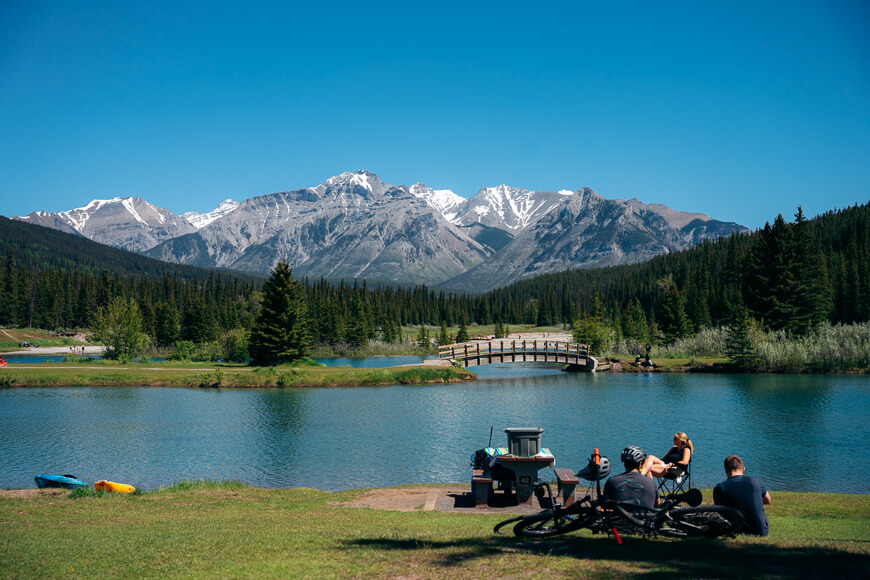
Fees to Enter Banff and Jasper National Park
Canada has fees to enter their National Parks. If you are on a tour, your company should handle the fees for the park, but if you are driving a vehicle into the National Park and parking, you must display your park pass in the windshield at all times . If you don’t, you are putting yourself at risk for a fine!
Daily fees are charged per person/group, per day.
A Parks Canada Discovery Pass allows you to visit any Canadian National Park and is valid for 1 year.
Where do I buy a National Park Pass?
When you arrive at the entrance to any National Park, there will be a toll booth that you have to pass through. These booths will have a Parks Canada member and they will help you figure out what pass to buy for your stay in the park.
You can also pay your admission fees at the visitor center in the Town of either Banff or Jasper.
You can order a discovery pass online in advance, at the toll booths, at the visitor center in the Town of Banff or Jasper, or at any MEC store location (only in bigger cities – Edmonton and Calgary)!

Popular Routes Around Alberta’s Mountains
Most routes tend to go in a circular direction, starting and ending in the same city:
Calgary – Canmore – Banff – Lake Louise – Icefields Parkway – Jasper – Edmonton (or drive back to Calgary the way you came) – Calgary
Edmonton – Jasper – Icefields Parkway – Lake Louise – Banff – Canmore – Calgary – Edmonton
You could work a day trip to Yoho National Park and Emerald Lake while in Banff as well!
Where to Stay in Banff and Jasper

Camping is a popular accommodation option when staying in Banff and Jasper National Park during the summer months. There are a few different options: backcountry camping and frontcountry camping, and there are reservable sites, or first-come first-serve sites.
Reservable sites for the camping season are usually available to book in January, and they are usually all reserved by February/March. So you do have to book early! Otherwise, you can keep checking back and hope for a cancellation.
First come first serve sites are non-reservable, and you can try to get a spot on the morning of your stay.
Camping in Banff National Park
My favourite campground in Banff is Two Jack Lakeside Campground – but it fills up super fast! Like within minutes of becoming available to book – so act fast!
Find more information on all of the campgrounds in Banff National Park here.
Camping in Jasper National Park
My favourite campground in Jasper is Wapiti Campground, but a lot of the campgrounds in Jasper are pretty similar (in my opinion). Snaring is typically the most popular, but it fills up super fast (I’ve never had the chance to stay here – yet!).
Find more information on all of the campgrounds in Jasper National park here.
Camping on the Icefields Parkway
The campgrounds along the Icefields Parkway are technically located in either Jasper National Park or Banff National Park, so you’ll find information on each campground in the two links above, and most (if not all) are first-come first-serve sites.
My favourite campground along the Parkway is Wilcox Creek Campground (the only downfall being there are no services at this campground!).
Staying in a hotel is a more comfortable, but also more expensive choice. When booking hotels, I like to use booking.com because most of their options offer free cancellation up to a certain date before your trip.
Hotels in Banff National Park
It can be pretty expensive to stay within the town of Banff, therefore a popular choice would be to stay in the mountain town just outside of Banff: Canmore. Canmore is a 20 minute drive from the town of Banff, and so it tends to be a little bit cheaper, and still beautiful!
I have only ever stayed at Canalta Lodge in Banff, and highly recommend it! It’s absolutely beautiful, but can be a bit pricey.
For a luxury experience, check out the Fairmont Banff Springs or the Fairmont Chateau Lake Louise.
Check out booking.com for more hotels in Banff .
Hotels in Canmore:
- The Windtower Lodge & Suites (can get pricey depending on the season, but I’ve seen good prices as well).
- The Rundle Chalets for a more rustic experience.
Check out booking.com for more hotels in Canmore – I usually sort the price low – high when on a budget 🙂
Hotels in Jasper National Park
The only hotel I’ve stayed at while in Jasper is the Astoria Hotel. It was a great price and not bad!
I have also heard good things about:
- The Pocahontas Cabins (they are around 30 minutes out of town)
- The Pyramid Lake Resort.
- Jasper Inn & Suites.
- Check out the Fairmont Jasper Park Lodge for a more luxury experience.
Check out booking.com for more hotels in Jasper .
Hotels on the Icefields Parkway
On the Icefields Parkway, there are a few hotels to stay at. Because the Parkway is a famous drive, the hotels along this road can be a bit more expensive! You can stay along the drive, or base yourself in Jasper or Banff/Canmore to explore the parkway. I’ve never stayed at any of these hotels, but a few options are:
- Sunwapta Falls Rocky Mountain Lodge
- The Crossing Resort
- Glacier View Lodge
There are hostels in the Rocky Mountains as well! They are most likely cheaper than hotels, but do your research! I have never stayed at a hostel in the national parks, but these are your options!
Hostels in Banff National Park
- Banff International Hostel
- Samesun Banff
- HI-Banff Alpine Centre
- The Canmore Hotel Hostel
Jasper National Park Hostels
- HI-Athabasca Falls
- HI-Maligne Canyon
- Jasper Downtown Hostel
- Mt Edith Cavell Wilderness Hostel
Icefields Parkway Hostels
- HI Rampart Creek Wilderness Hostel
- HI Beauty Creek Wilderness Hostel

Getting Around The Rockies
It’s possible to get around without a car, but if you can I would highly recommend traveling by car. It gives you the freedom to go where you want to, when you want to, and spend the amount of time you want to at each place. A lot of public transportation/shuttles don’t go to the hike trailheads, and it can be hard to find a tour that will take you to all of the highlights. Nonetheless, you can still enjoy your trip without a vehicle!
The local bus is a great and cost efficient way to get around if you don’t have access to a car.
In the Banff area, you can use the local bus to get between & around the Towns of Banff and Canmore. You can also get to some of the popular attractions using the regional routes these buses offer (Lake Louise, Johnston Canyon). The local bus is called Roam!
Find more information on the Banff Local bus here – routes & fares.
There is no true local bus in Jasper!
There is no local bus along the icefields parkway.
Tour/shuttle
A tour or shuttle bus can get you around as well, and you’ll have the pro of not having to worry about finding a seat or where to get on/off of the bus. However, some shuttles may not stop at all highlights/viewpoints or where you want them to.
Banff National Park Shuttles and Tours
Banff has a new hop on-hop off bus service that takes you to a few highlights in the area, with onboard hosts you can ask any questions you may have. It only runs in the spring/summer/fall months, so, unfortunately, it’s not an option for winter travel. This bus also gives you the freedom to spend as much time as you want at each location.
There are other shuttles available check out Sundog Tours and look at either summer or winter (depending on the season you’re planning to visit). Also, check out Brewster Express to get between hotspots.
Jasper National Park Shuttles and Tours
Sundog Tours and Brewster Express as mentioned above has a few options in the Jasper area.
Maligne Adventures has a shuttle between Jasper and Maligne Lake.
If you’re skiing/snowboarding, there is a shuttle bus between Jasper and Marmot Basin .
Icefields Parkway Shuttles and Tours
Sundog Tours and Brewster Express has a few shuttle/tour options to get between Banff and Jasper along the Parkway.
Tour operators such as Gadventures have the Icefields Parkway worked into larger trips within Canada’s Rockies.
Drive yourself if you have access to a vehicle!
Most areas of the National Parks are only accessible by car. It’s unfortunate, but if you can afford a rental or have your own vehicle, you will definitely have the most freedom! I highly highly recommend renting your own car.
Note – if driving the Icefields Parkway, make sure to gas up at either Jasper or Banff Town, because there is only one gas station on the entire Parkway and it tends to be crazy expensive!
The Canadian Rockies are a trip of a lifetime – everywhere you look you will be captivated by beautiful mountains, lakes and scenery. I grew up living 4 hours from the Rockies, and so I’ve put together my best Canadian Rockies travel tips to help you plan your trip to this stunning region.
Another Canadian Rockies National Park is Waterton National Park in Southern Alberta. Waterton is quite separate from all of the other National and Provincial Parks listed!
- Bow Valley Provincial Park – Kananaskis Country (Alberta)
Canadian Rockies Travel Tips

1. There are Park Fees for All Canadian National Parks
There are park fees for all Canadian National Parks and some Provincial Parks in the Rockies. Rates vary depending on how long you are staying in the park.
You can purchase your park pass at the toll booths when first arriving to any National Park via car. If you’re arriving via tour bus, check with your tour provider as they may include the cost in your tour.
The Kananaskis Area also requires a pass, the Kananaskis Conservation Pass , for any vehicles stopping in the area. This is separate from the National Park Pass and therefore must be purchased separately. Make sure to do this beforehand (it can be done online, in advance), as there is limited cell service/data in the Kananaskis region.
2. Camping Fills Up Fast
If you’re planning to camp in the Canadian Rockies, it’s best to book in advance, and when camping reservations first open . Reservations open sometime in January – March, it changes each year!
If you’re not able to secure a site for the dates you want, there are a lot of “first come first serve” campsites/campgrounds that are not available for reservation. They do fill up though, so make sure you get there early the day that you want the site.

3. Go Early to Try to Avoid the Crowds
Popular places, such as Lake Louise and Johnston Canyon, become incredibly busy during the day and are popular year round. If you want to try to avoid the crowds, the only thing you can really do is to get up early and try to get to these popular places first.
It can even be hard to find parking in some of these locations if you arrive in the middle of the day. So plan to do the more popular places earlier in the day, or try in the evening as well.
This is especially true if you are looking to get photos with as few people as possible in them, or if you are planning to do some of the more popular hikes. Hiking with less of a crowd is typically more enjoyable!
Some popular places in the Canadian Rockies that are very busy include the Lake Louise Lake Agnes Teahouse hike , Johnston Canyon hike, Valley of the 5 Lakes, and iconic lookout points such as Peyto Lake or Lake Louise.
4. If You Want Beautiful Lakes and Green Trees, Plan Your Trip for Summer (the later in the season, the bluer the lake)
A lot of people actually don’t consider this when planning their trip – but the seasons in the mountains do vary! If you want the sunny days and blue lakes, you have to plan your trip between mid-late June – early September.
The reason some lakes are so blue is due to run-off from glaciers. The later in the summer it is, the more time the sediment from run off has had to get into the lakes, and the bluer they are (although the lakes are beautiful all summer long).
The Rockies by season:
- Spring can still be cold and snowy in the mountains (April – early June).
- September – October the leaves change for fall, and near the middle to end of September you are at risk for snowfall!
- Winter is usually middle/late September to around early April in the Rockies.
- Summer is for blue likes and incredible hiking, which runs mid-late June to early September.
The weather can be pretty unpredictable in the mountains, so be prepared for at least one cold day during your trip because it is possible!

5. You Need a Fire Permit if Camping
Usually, when booking a front country campsite online you have to pay for a fire permit if your site has a fire pit, even if you don’t want to have a fire (but it can vary between region). Be sure to factor this into your budget when planning a camping trip to the Canadian Rockies.
In the summer there is a risk of forest fires, which means campfires may be banned and the air can be potentially super smoky. If there is a fire ban, permit costs are typically reimbursed by Parks Canada.
Read more: Banff Bucket List | Jasper Bucket List
6. Don’t Bring Your Own Firewood
The price you pay for your fire permit includes the cost of firewood in most Canadian National Parks. Banff and Jasper National Park don’t want you to bring your own wood into the park, because of the risk of pests such as the Mountain Pine Beetle. In order to keep the parks healthy, you have access to unlimited firewood, which is usually at the entrance of your campsite!
Provincial Parks (such as Kananaskis) typically don’t provide firewood.
7. There’s a Chance for a Fire Ban or Smoke During the Summer
I swear half the time I go camping there is a fire ban happening, which means no fires are allowed within the National Parks. Signs will be posted throughout the National Parks, and campground rangers should let you know upon arrival as well.
Be prepared that this could happen during your trip, and could cause the air to look and smell smoky!
If you did pay for a fire permit before arriving, you should get the payment back if there is a fire ban.
There is a huge fine if you have a fire during a fire ban, so just don’t do it. If you have access to a propane gas fire pit then this is usually aloud, but double check with the rangers before lighting it!
8. The Best Hiking is July – September
It is very possible for snow to linger into the month of June in the mountains, and for this reason, some hiking trails can still be closed or knee-deep in snow until it melts in July! By the time July rolls around, most (if not all) of the snow will be melted, trails less muddy, beautiful green leaves will be on the trees and the weather will be mostly warm. Wildflowers will also start to bloom in July.
In mid-September the larch trees will start to turn yellow, which makes for incredible fall hiking as well!
9. Winter Can Get Cold!
You need to pack at least a toque, gloves, warm socks, a warm jacket, and multiple layers if you want to stay warm in the Canadian Rockies during the winter.
It snows in the winter (and sometimes in the fall and spring) with the weather possibly dropping to -30 C or colder!
10. The Roads Can be Very Icy in the Winter
If you rent a car please be careful when driving! The mountain roads can be twisty and icy. Take your time and be aware when driving. Please know some roads require winter tires and/or chains on your car (like the Icefields Parkway – the road between Banff and Jasper).
It’s also normal for roads to sometimes close due to risk of avalanche, so always have a back-up plan and emergency supplies in your vehicle.
11. Moraine Lake Closes in the Winter
The road to Moraine Lake closes usually mid-October until the middle of May, because of the risk of avalanches. So if you’re planning your trip around this time, you may not be able to see this stunning lake.
New in 2023, personal vehicles are not allowed on the road to Moraine Lake . If you want to visit, make sure to book your ride in advance.
12. Be Bear Safe
You will see garbage cans everywhere in the Canadian Rockies that are bear proof – please use these! If you don’t find one right away, carry your garbage with you until you can dispose of it properly.
Keep your campsite and picnic areas clean. Keep your garbage cleaned up and food locked up in your car or in the food lockers that are provided at the campsite (or sometimes suspended in the trees).
Make sure to keep anything scented locked away as well. Park rangers monitor this closely, and will not tolerate it if you are not following the rules!
It is also important to be aware of bears when you are hiking in the Rockies. Always hike in a group, and carry bear spray (you can usually buy or rent bear spray in towns upon arrival).
Here is more information for being bear aware in the Canadian Rockies:
- Keeping your campsite clean
- Being bear safe
- Seeing bears from your car

13. Respect the Wildlife
There is a ton of wildlife within the Canadian Rockies, including grizzly bears, cougars, black bears, elk, moose, billygoats, bighorn sheep, and more! If you do see animals while driving, remember to keep your distance. They are wild animals and are unpredictable. Do not approach them just to get a photo! Take your pictures from a distance and respect their space. If you see a bear, stay in your car!
I typically see most wildlife along the Icefields Parkway, between the towns of Banff and Jasper. Elk do frequently go into the towns as well!
Keep Reading: How to be a Responsible Traveler in the Rockies and Leave No Trace
14. Gas Stations Can Be Limited
Pay attention to your gas tank if you are driving in the Rockies, especially if you are driving along the Icefields Parkway (there is one gas station on the Parkway).
Gas stations can be few and far between. There are some gas stations in the mountain towns (Banff, Canmore, Revelstoke, Golden, Jasper), but not a lot elsewhere.
The gas in Lake Louise and at The Crossing on the Icefields Parkway is usually a lot more expensive because if you need gas you don’t really have any other option but to fill up there!
Additional Resources for the Canadian Rockies:
Banff Now – For real time information on parking/traffic in specific areas
Trail Conditions – Information about the difficulty level of hiking trails, and the conditions each trail is in
The Rocky Mountains are incredible. Hopefully, this guide for planning a trip to the Canadian Rockies helps you plan your trip or inspires you to visit!
Find me on: Instagram | Pinterest
Keep Reading About the Rockies:
- Tips to Visit Banff National Park on a Budget
- Cycling the Bow Valley Parkway in Banff
- How to Get to Spirit Island in Jasper National Park
- 16 Easy Hikes Near Banff
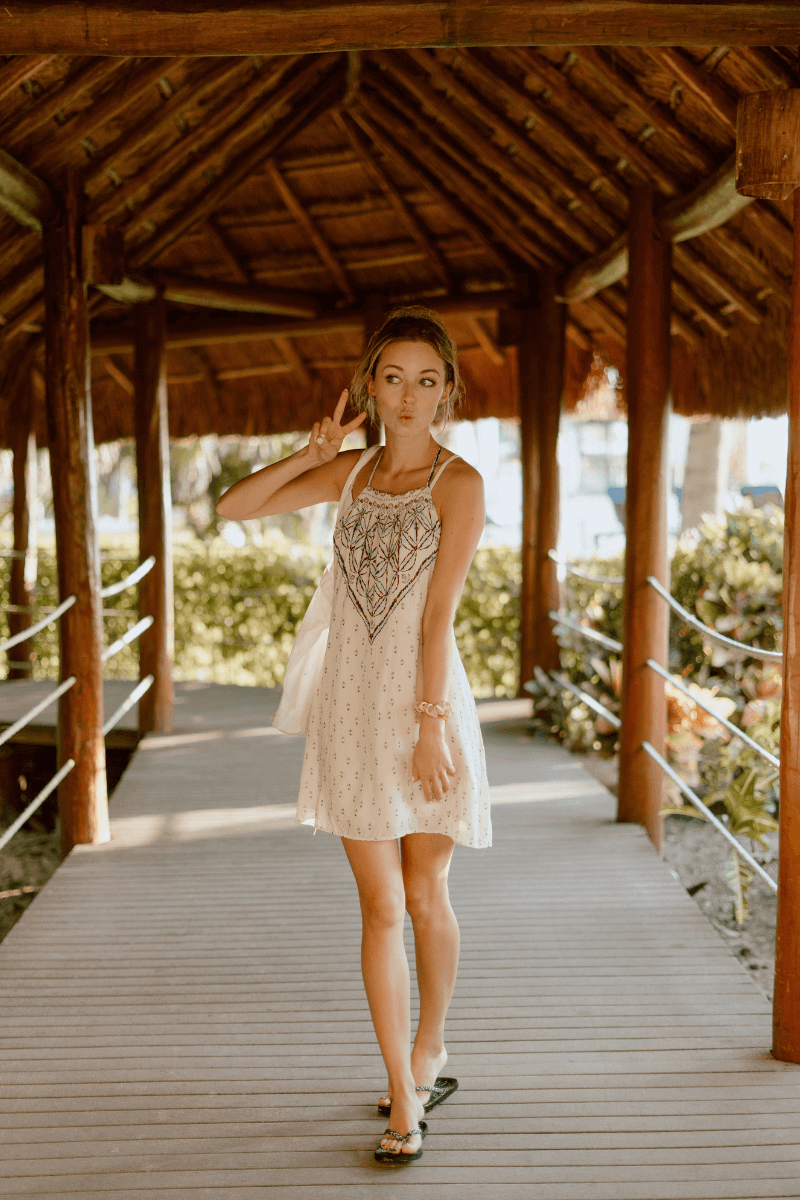
Hey! I’m Kat. Based in Alberta, Canada I love to travel to the Rockies and explore new places around the world. Follow along on my adventures and find inspiration and tips for your own travels.
You’ll Also Love
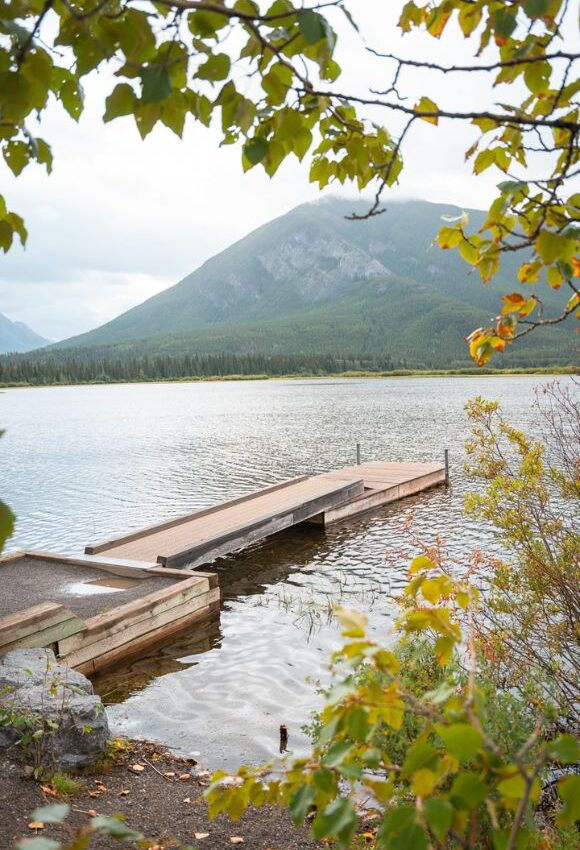
Leave a Reply Cancel reply
Your email address will not be published. Required fields are marked *
Save my name, email, and website in this browser for the next time I comment.
This site uses Akismet to reduce spam. Learn how your comment data is processed .

Banff National Park Bucket List (2024 Bucketlist)
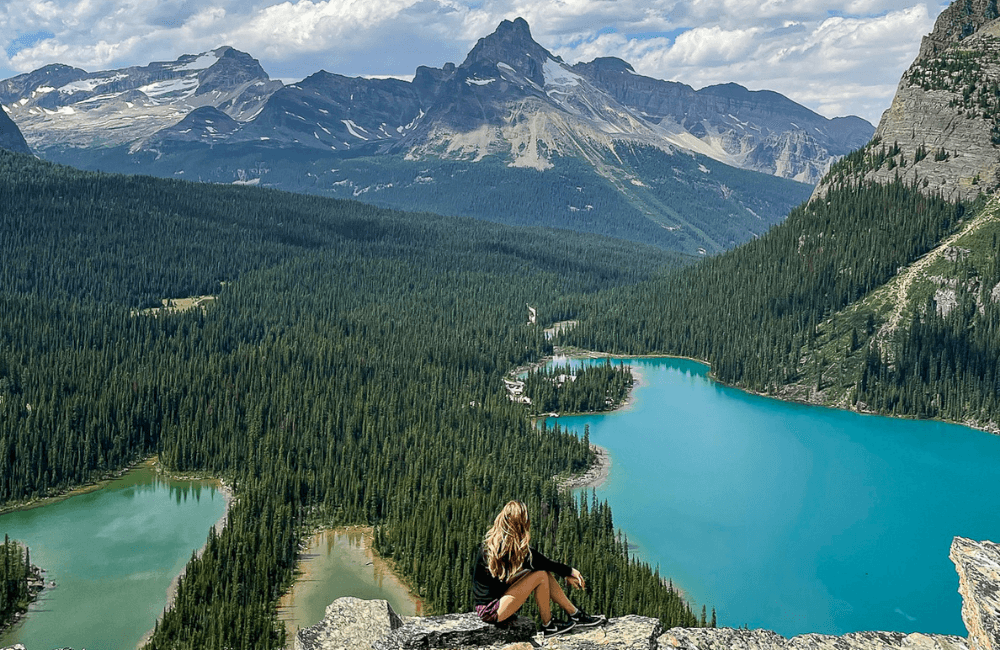
Join the List!
Subscribe to receive access to printable freebies, checklists, itineraries and more!
I'm Kat. Based in Alberta, I'm currently exploring and documenting my adventures in Alberta's Rocky Mountains. I'm also taking smaller international travel every now and then when I get the chance! Thanks so much for stopping by!
- TERMS OF SERVICE
- PRIVACY POLICY
- WORK WITH ME
Destinations
- NORTH AMERICA
- SOUTH AMERICA
Travel Canada
- BRITISH COLUMBIA
Latest on Instagram

Copyright © 2024 Endless Wonder · Theme by 17th Avenue
Privacy Overview
10 Days in the Canadian Rockies: The Ultimate Road Trip Itinerary
Discover the beauty of the Canadian Rockies with this in-depth 10-day itinerary.
A few years ago, I spent a blissful 6 months gallivanting around the Canadian Rockies. I was put on a work assignment in nearby Calgary, Canada, and every weekend I’d rent a car and drive out to admire and hike around the majestic peaks and evergreen forests of Canmore, Banff, Jasper, and Waterton Lakes.
And while some of my memories include run-ins with bears or gracefully getting caught in a thunderstorm while hiking above the treeline, the majority of my Canadian Rockies road trip days were pure happiness.
After my travels there, a lot of friends and readers asked me about my travel tips for a Canadian Rockies itinerary. Several readers even went there solely because they’d seen my photos on Instagram.
To be honest, I’m not surprised at all that people see photos of the Canadian Rockies and immediately book a trip.
Yes, it’s actually that beautiful.
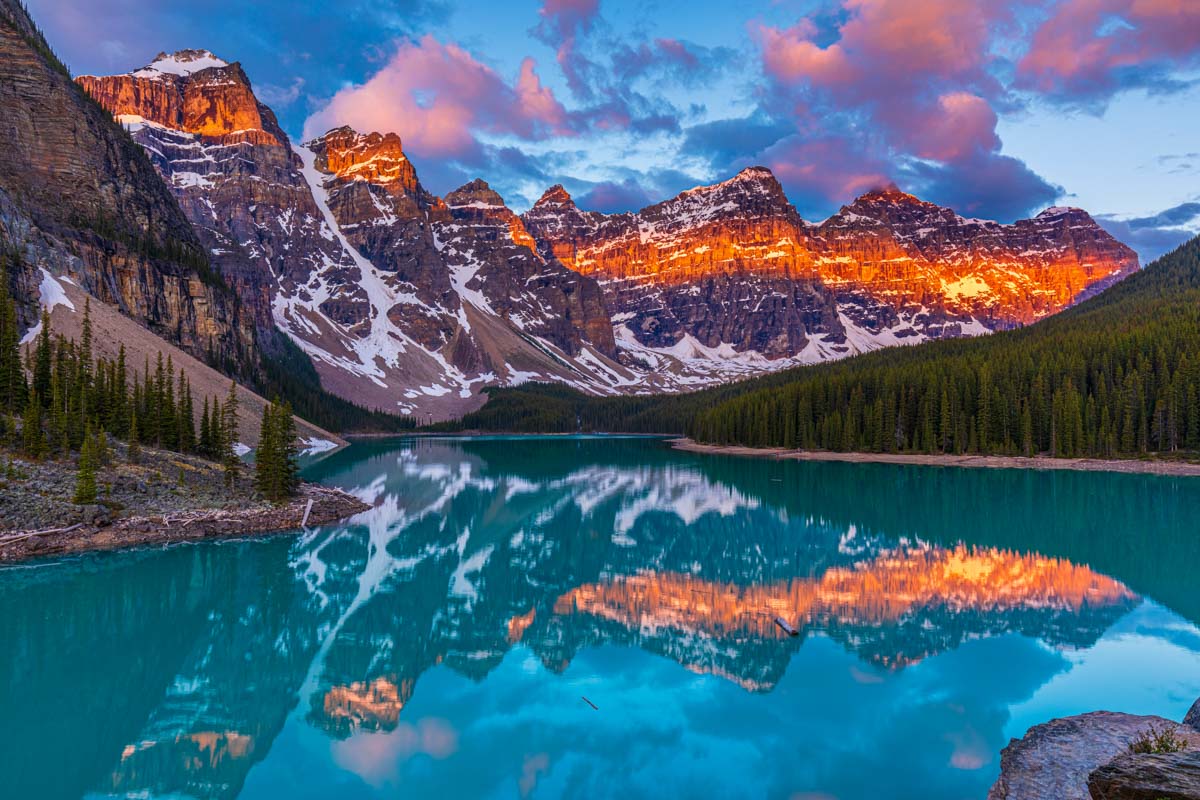
And that’s how this Canadian Rockies itinerary was born.
This itinerary is arguably the most spectacular Canada road trip, and it’s definitely one of the most naturally striking and totally out-of-this-world-beautiful trips you can take in the entire world.
But don’t take my word for it! Read on to learn all of my first-hand tips for planning the ultimate Canadian Rockies road trip.
For your information, this is a SUPER comprehensive guide (read: long and detailed sections to come)! I just wanted to make sure all of our best tips, guides, and resources for the Canadian Rockies were all in one place for you to access easily.
Soooo, grab a glass of your favorite adult beverage, cozy on up, and let’s chat by the crackling fireside about how to plan a kickass Canadian Rockies itinerary!
Travel Tips for Planning Your Canadian Rockies Road Trip
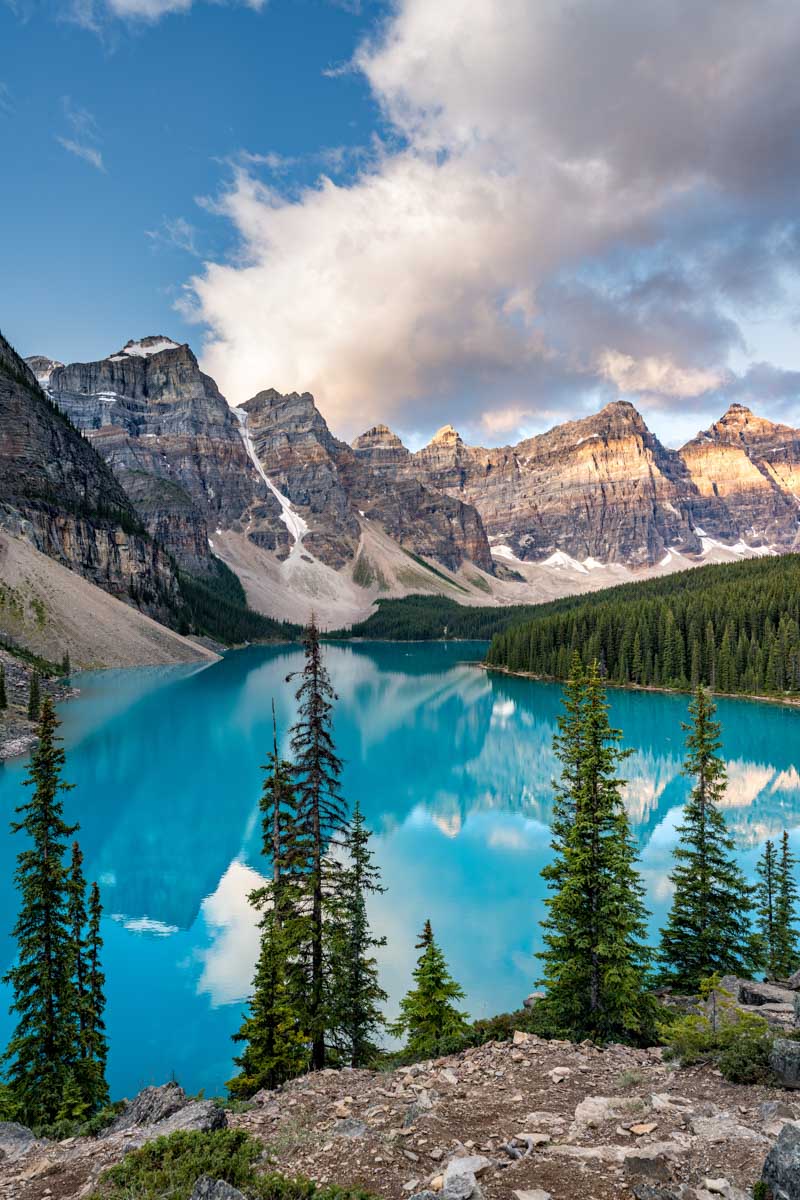
One thing that’s really important to keep in mind is that the Canadian Rockies is becoming a more popular travel destination every. single. year.
That’s why it’s crucial to plan your trip in advance.
If you’re planning on visiting the Canadian Rockies in the highest season (June through August), I’d recommend planning your trip and making all of your bookings AT LEAST 2-3 months in advance.
If you’re going in the shoulder season (May through early June or September through October), you can plan 1-2 months in advance.
From my own personal experience, here’s everything you need to know as you plan your Canadian Rockies road trip:
Important Tips to Know Before Traveling in the Canadian Rockies
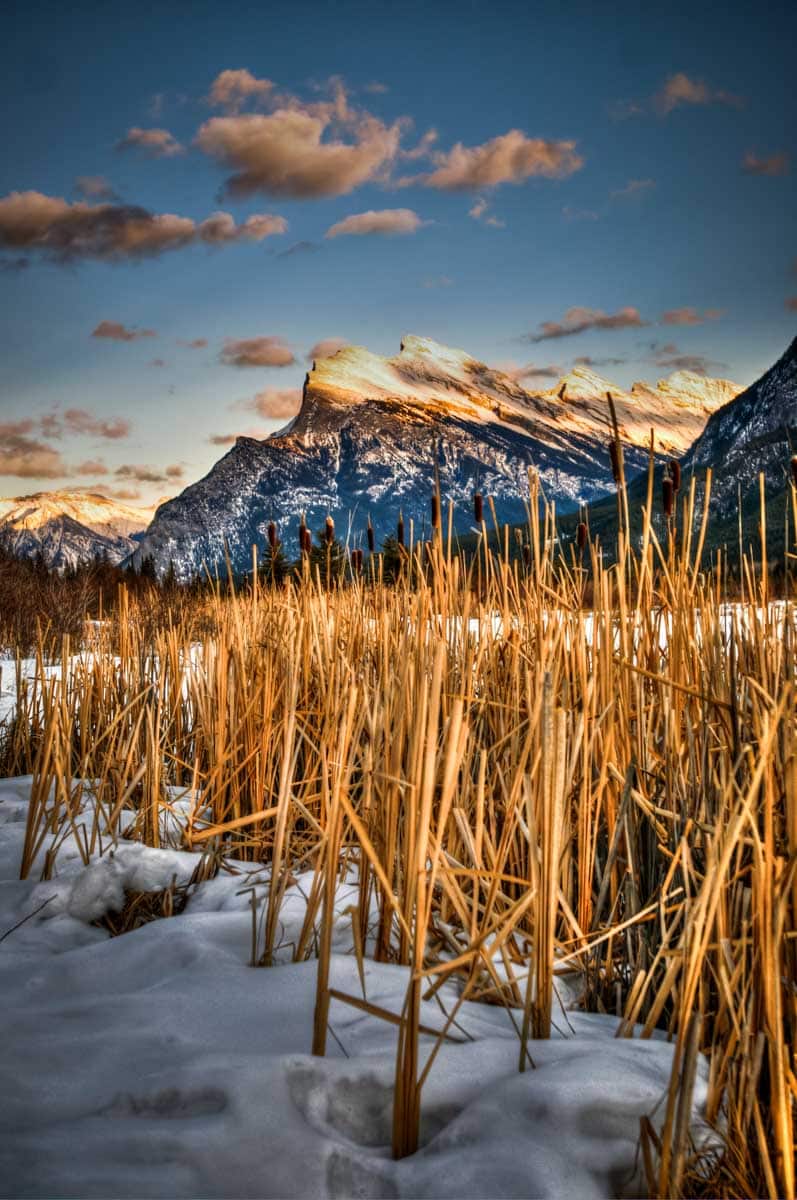
Weather conditions can be very unpredictable. One minute it’s blue skies and sunny and the next, it’s sleeting. This is normal life in the Canadian Rockies, and it’s something you’ll have to get used to if you’re traveling in from a more temperate climate.
Be sure to bring gear for both cold and warm weather (we’ve provided our favorite recommendations a little later in this post), and have waterproof shells for when the weather turns sour.
Accommodation books up very, very quickly. When I was planning my most recent trip to the Canadian Rockies, I noticed Banff and Jasper were already booked at over 80% capacity…2 months before my arrival.
As soon as you think you want to go to the Rockies, you should book cancellable accommodation (Booking.com is great for that!) to make sure you can secure something .
There’s wildlife everywhere. Talk to any local in the area and they’ll tell you wildlife is commonplace here. It’s not out of the ordinary to see a bear or an elk grazing on the side of the road.
You can absolutely admire these animals from a distance (and even go on a special tour to see them!). But whatever you do, KEEP A SAFE DISTANCE and DO NOT FEED ANY ANIMALS. This is their home and we need to respect and protect them.
You need to buy a ticket to enter the parks. While Canmore isn’t part of this, in order to enter Banff, Jasper, or Yoho, you need to pay the entrance fee. The fees are per person, per day, so depending on the size of your group, you’ll either want to pay individually or splurge for a family/group pass. You can see all prices and conditions on the Parks Canada page.
If you want to avoid the crowds, wake up early. This itinerary will be taking you to many different locations, some more popular than others. However, if you’re not a morning person, you miiiiight want to become one during this trip, as the early morning is a) the best time to avoid the crowds and b) the best time for photos of the park because of the lighting.
When to Visit the Canadian Rockies
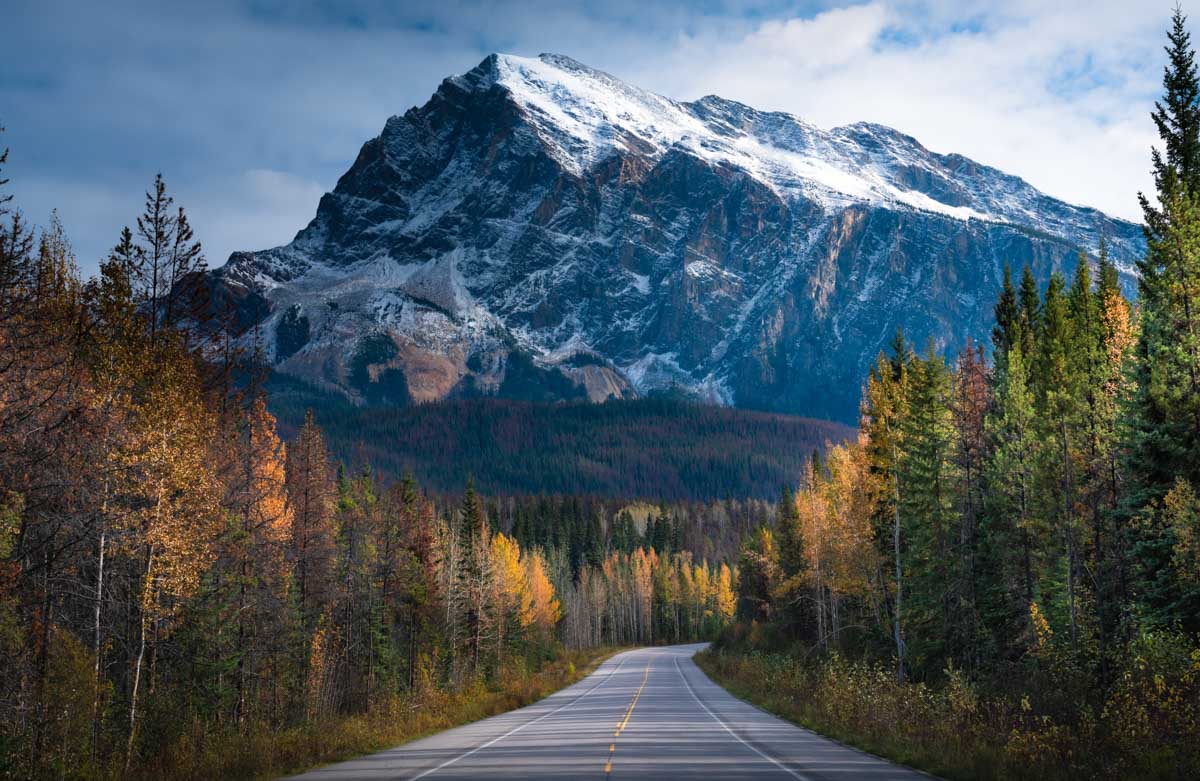
The Canadian Rockies are a year-round travel destination. This means that, yes, you can visit during any month of the year, but what you can do drastically depends on the weather. You’ll need to have the right expectations about weather and available activities.
Visiting in Summer or Fall
Summer and fall usually boast the best hiking and camping weather, but also attract the largest crowds.
Typically, all of the hiking trails and summer adventure activities are open and available during this time of year, meaning that the hotels and lodges are often almost completely sold out and there’s actually traffic.
If you’re planning on visiting the Canadian Rockies during the summer, you’ll need to plan a few months in advance to secure accommodations, car rentals, and tours.
Visiting in the Spring
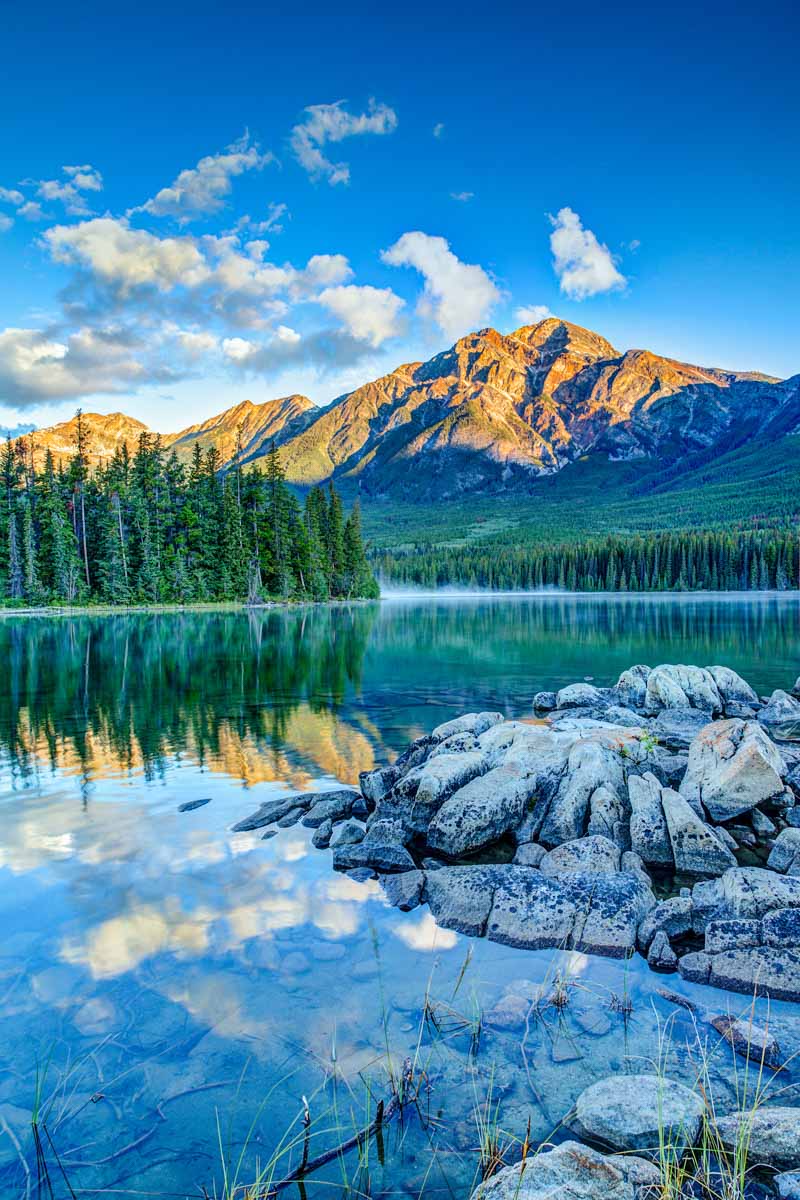
Spring is the shoulder season, especially after the ski slopes begin to melt but the trails are still covered in winter ice. Weather during this time of year can mimic winter or summer, depending on when in the season you visit.
The first time I ever visited the Canadian Rockies, we went in mid-May and, while not all of the hiking trails were open yet, we experienced very few crowds and even had Lake Louise completely to ourselves.
Not a bad trade-off if you’d prefer a more tranquil, quiet experience!
FYI, this Canadian Rockies itinerary is based on a spring, summer, or fall road trip.
Visiting in the Winter
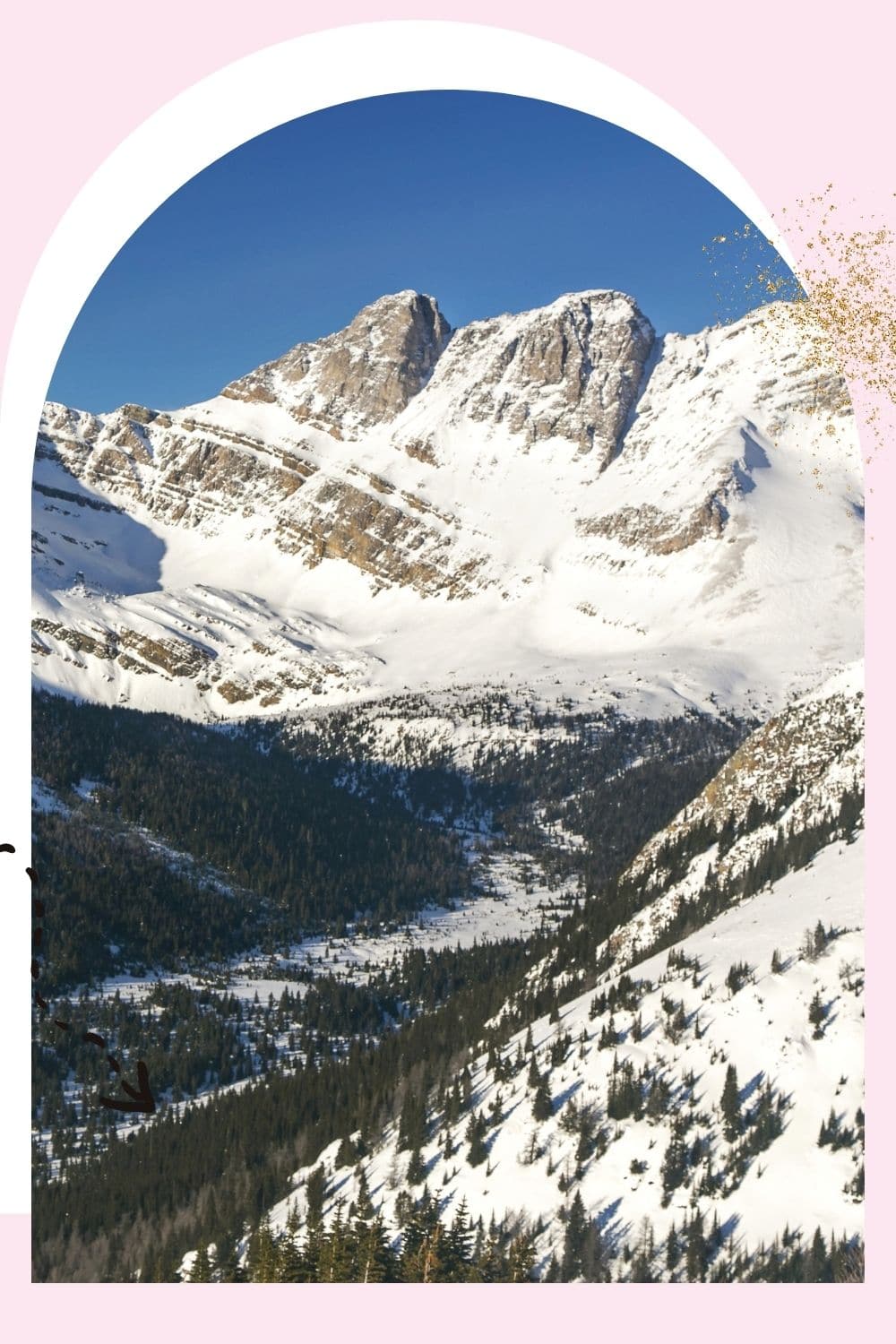
However, that’s not to say you can’t make a Canadian Rockies road trip in the winter. Winter is the least-crowded season in the area, but your activities will be limited to snow sports (e.g., skiing, snowboarding, tubing, etc.) and ice activities (like ice climbing and ice trekking, which are pretty cool, IMO).
If you’re planning on doing any of these outdoor winter sports, I recommend grabbing yourself a pair of crampons, a durable, insulated jacket , and thermal snow pants, as you’ll DEFINITELY need them. Also, make sure that you have all of the most important gear for hiking in winter .
If you’re going to take a road trip during the winter season, I’d strongly recommend having experience driving in snowy/icy conditions, and please make sure to have the right gear, like snow chains, ice scrapers, etc.
How to Get to & Around the Canadian Rockies
If you haven’t already guessed by the fact that this is a “road trip” itinerary, I strongly recommend driving yourself or renting a car to get to and around the Canadian Rockies. Why? Because having your own car gives you the most flexibility for where you can go in the park and what time.
How to Rent a Car in Calgary
Luckily, it’s pretty easy to rent a car at an affordable price from the nearby cities of Calgary, Edmonton, and even Vancouver. You can even rent a car in Banff town. If you’re not from the area, I strongly recommend flying into Calgary International Airport (YYC), as it’s the closest airport to this itinerary’s starting point.
You can rent a car from Avis, Hertz, and Enterprise directly from the airport. However, if you want to save some moolah, I’d recommend checking the prices at Calgary’s downtown car rental locations as well. I’ve found rental cars downtown tend to be cheaper, costing sometimes 20-40% less per day than renting at the airport. Plus, the taxi downtown from the airport only costs ~$15 USD one way.
Getting Around the Canadian Rockies
Once you’ve got a car, there are gas stations all over the Trans-Canada Highway and the Icefields Parkway (the two primary roadways you’ll be using in this itinerary). Before heading anywhere, I strongly recommend checking the Parks Canada road reports, so you know if there are any road closures or bad weather conditions ahead of time.
Where to Stay in the Canadian Rockies
There are places to stay in the Canadian Rockies for any budget level, from penny-pinching backpackers to luxury lovers.
To make planning your accommodations suuuper easy, for each day of this Canadian Rockies itinerary, I’ll be providing two recommendations for places to stay, one budget option and one mid-range option.
I’ll also suggest the most convenient campsite for each day of the itinerary.
However, if you’d like more suggestions or information on where to stay in the Canadian Rockies, we’ve got you covered with 2 complete accommodation guides (Banff and Jasper):
- Where to Stay in & around Banff National Park
- Where to Stay in Jasper National Park
And, for those of you interested in camping in the Canadian Rockies, we’ve got 3 complete and detailed guides on that as well:
The Ultimate Guide to Camping in Banff National Park
- The Ultimate Guide to Camping in Jasper National Park
- What to Pack for a Camping Trip: The Ultimate Camping Packing List
What to Pack for the Canadian Rockies
Clothing to pack for the canadian rockies.
- Waterproof hiking boots – While on a Canadian Rockies road trip, there’s a good chance you’ll be caught walking in mud, snow, and stream crossings. To keep my feet warm and dry during day hikes, I have a cozy pair of Ahnu waterproof hiking boots that always do the trick! My boots have been with me to Patagonia, Peru, Slovenia, and more, and they’re still kicking ( haha, get it?! ).
- Wool socks – You’ll want to bring some warm wool socks to pair with your hiking boots. Not only will these help keep your feet cozy and dry, but they can also help prevent blisters from your boots. We love our Darn Tough hiking socks for all of our outdoor adventures and literally bring them everywhere with us.
- Merino wool layers – It’s a really good idea to bring a merino wool baselayer , which will keep you cool in the summer and warm in colder weather. Merino is soft, sturdy, stink-free, and sweat-wicking, AKA the best fabric ever for staying warm and dry in the Canadian Rockies’ unpredictable climate.
- A waterproof rain shell – No matter what time of year it is, there’s a decent chance of a sudden downpour in the Canadian Rockies. Yes, it literally happens even when the skies are clear and blue minutes before. Bring a sturdy, waterproof rain jacket to stay warm and dry at all times.
- A compressible down jacket – Temperatures in the Canadian Rockies can be chilly even in the summer, especially as you gain altitude. For this reason, I always make sure to pack my thermal puffer, all rolled up into a tiny ball that I can shove into my day pack or clip onto the outside of my bag with a carabiner.
Toiletries & Personal Items
- Mosquito repellent, sunscreen, and sunglasses – Don’t forget these! Just like most other outdoor areas, the Canadian Rockies get lots of sunshine and mosquitoes in the summer, so plan ahead.
- Snacks – Whether you’re hiking, rafting, or driving, you’ll definitely want some snacks to carry with you. I strongly recommend purchasing packaged or resealable snacks as the food scents can be an issue with wildlife in the area.
- Good road trip playlists – You’ll be driving a LOT in the Canadian Rockies, so having a good car playlist downloaded to your phone is a must!
Other Helpful Things to Pack for the Canadian Rockies
- Bear spray – Like I mentioned before, there is a LOT of wildlife in the Canadian Rockies. Be sure to purchase a canister of bear spray if you plan on doing lots of hiking or camping. You most likely won’t have to use it (I never did in 6 months!), but it’s smart to have on you in the event of a chance run-in with a bear or a wolf.
- Head lamp – If you want to catch a stunning sunrise, a colorful sunset, or some epic stargazing, a good, comfortable head lamp is a MUST. Luckily, they’re not too expensive and once you buy one, you can just replace the batteries forever and ever (until the bulbs physically burn out). I like my Black Diamond head lamp for exploring in less-than-optimal lighting.
- Reusable water bottle & filter – We always bring our trusty reusable water bottle (Rafael and I both have Hydro Flask bottles that we LOVE) on our adventures to cut down on plastic waste and keep our water cold. Most of the time you should have plenty of access to clean, filtered tap water, but on long hikes you may need to refill at a stream or cascade. In this case, you’ll also want a water filter or purification system to ensure your water is always potable. We recommend the rechargeable SteriPen, which purifies your water using a portable UV light.
- Carabiners – These are always super useful to have while hiking or exploring. I use them to hang my water bottles, hats, shoes, wet clothes, etc. on the outside of my bag, and they work fantastically. You can literally just buy a pack of 20 carabiners and throw them in your hiking bag when you’re ready for an adventure.
Gear for Camping & Sleeping
- Durable camping gear – If you’re planning on camping, you’ll definitely want some high-quality camping gear to bring with you.
- Hammock – While definitely not a requirement, it’s really nice to have a hammock for relaxing after a long hike or at a riverside campsite. We have an ENO Double Nest (of course, in the brightest, most psychedelic colors they sell) and we basically live it in when we’re not in the car or the tent. It’s perfect for sharing between two people or snuggling up by yourself.
The Ultimate 10-Day Canadian Rockies Itinerary
Day 1: calgary to canmore.
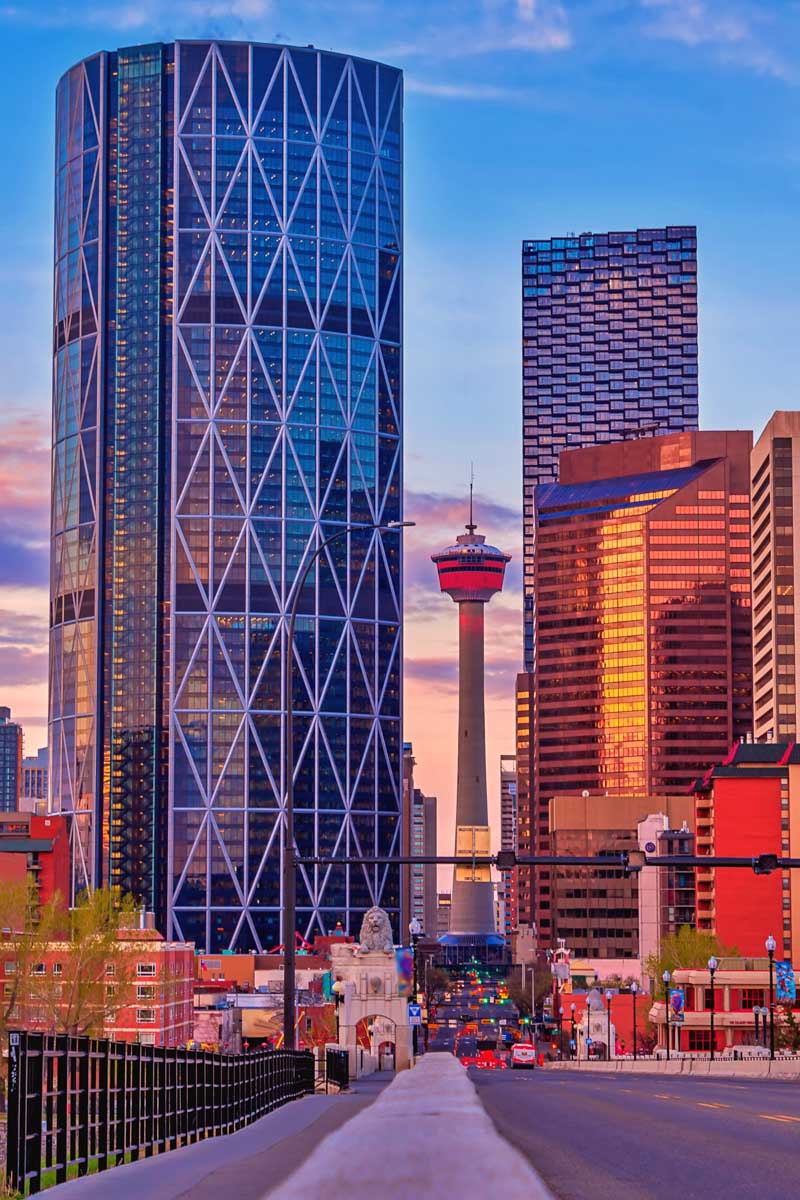
On this day, we recommend arriving in Calgary and driving to Canmore, which is the first stop of our Canadian Rockies itinerary.
You do have the option of staying in the for a day and doing some hikes (which could be a really cool option, especially if the Calgary Stampede is going on).
While many people opt to go directly from Calgary to Banff, I chose to include Canmore because it’s often overlooked by tourists, but it actually is home to some of my favorite hikes and viewpoints in all of the Canadian Rockies.
While often overshadowed by their northern neighbors (Banff and Jasper), Canmore and the Kananaskis area are, in my opinion, some of the most underrated adventure destinations in all of Alberta.
Striking mountaintops, amazing hiking trails, and beautiful alpine lakes will greet you as you explore Canmore, but you can expect smaller crowds here, even during the high season.
Morning: Arrival in Calgary
If you opt for a direct morning flight from anywhere in the USA or Canada, chances are you’ll most likely be arriving in Calgary Airport in the late morning or early afternoon. Once you’ve arrived, proceed through customs (if necessary) and grab your bags.
- For car rentals at the airport: From the arrivals area, follow signs to the main rental car area to pick up your car from your designated agency.
- For car rentals from downtown: Exit after baggage claim and grab a taxi (NOT a black car, these are 2-3x the price!). Make sure you have the address of your rental agency on hand and let the driver know where you’re going. If you’ve decided to rent from Avis (which we usually recommend), their shop is right next to the Calgary Tower.
Lunch in Calgary
After you leave the airport, I recommend grabbing some lunch in nearby Calgary before heading to Canmore.
Known for its ranching industry, Calgary is known around Canada for its meats. For some of the most delicious steaks in the city, Vintage Chophouse is a fantastic place to try. Since I’m not actually a steak person myself, my favorite dish there is the lobster mac and cheese , which is exactly the heavenly deliciousness it sounds like: large lobster chunks mixed in with a perfect blend of pasta and melted cheeses.
For a cheaper, vegetarian-friendly lunch option, The Coup is a fantastic choice. Their bright, open space and delicious, healthy lunch options are AMAZING. Share a Vegan Char”coup”terie board or order the Satay Bowl for lunch… you won’t be disappointed.
After lunch, if you have extra time to check out the city, explore some of the many things to do in Calgary !
Afternoon: Driving In & Exploring Canmore
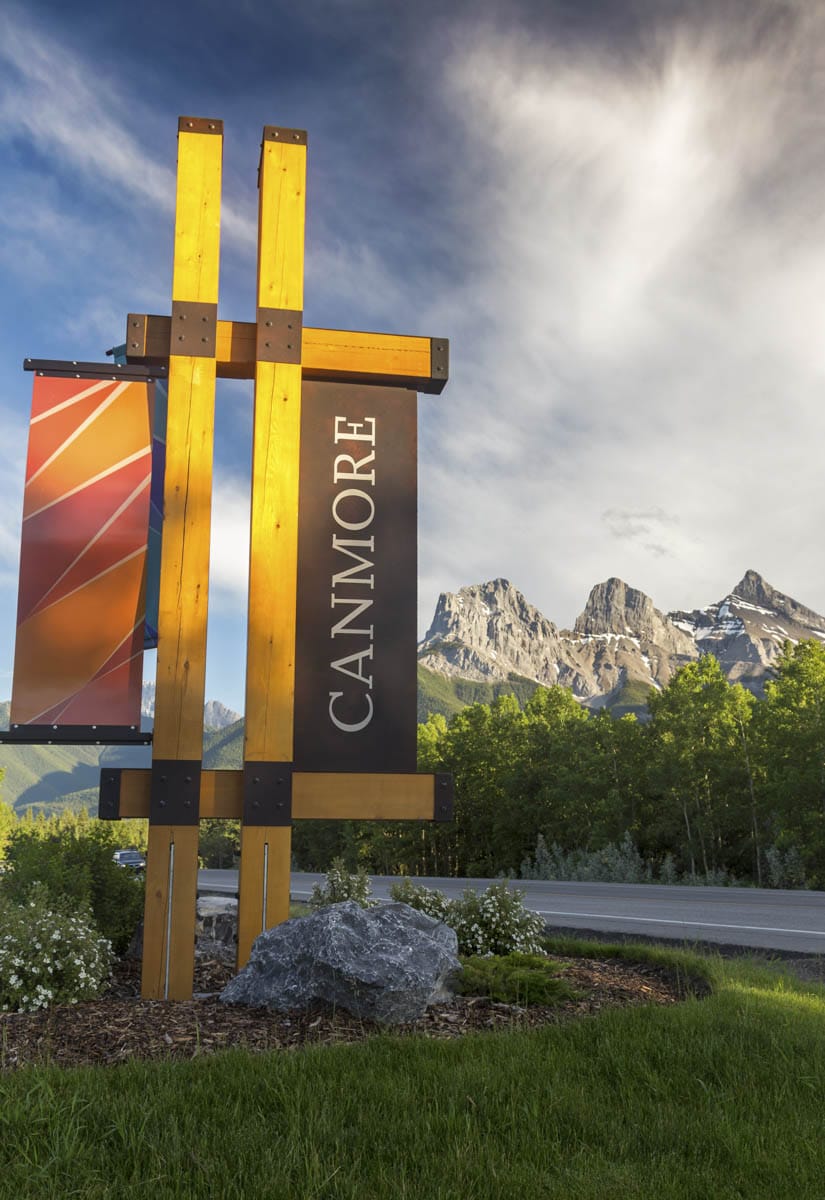
After lunch, you’ll drive ~1 hour down the Trans-Canada Highway (Highway 1) to Canmore. At first, you might think you’re in the wrong place, with flat farmlands for miles.
The plains eventually turn into rolling hills, and then…BAM… you’ll see it: the beautiful, majestic Canadian Rockies. At first just a faint outline on the horizon, they’ll eventually grow larger and bluer right before your eyes.
It’s, like, ridiculously magical.
For outdoor lovers, seeing the Canadian Rockies for the first time is kind of like the feeling you get when you see the Disney Castle. It’s magical, heart-wrenching, glorious. You might cry (I definitely did). Seeing the mountains and knowing that you’ll be spending the next 10 days there? Priceless.
Depending on how much time you have in Canmore before dinner, you can take a drive around the area and even hop on a short hiking trail (see the next section on Day 2 for some recommendations). You can also check into your accommodations (see below for our recommendations) and wander around the town center for a while.
Evening: Dinner at PD3 Blake Canmore
Full disclosure: I’ve never eaten at Blake Canmore . BUT I have a good excuse — the TWO times I tried to go, it was either full with a wait (and I was hangry from hiking) or it was closed. You can choose to dine at Blake Canmore’s more traditional dining hall, but I’d recommend going for the more casual PD3, which is a double decker bus converted into a local dining institution (and the food smelled absolutely heavenly ).
Whatever you choose, don’t be like me: plan ahead and eat your first Canadian Rockies dinner at Blake.
Not only does the food look super drool-worthy (I think I could literally inhale their “crack fries” in approximately 2 seconds), but it’s also reasonably priced and the atmosphere is among the most unique in the region. They also have homemade ice cream flavors and signature drinks/cocktails in case you want to end your day 1 with a sweet treat!
Overnight in Canmore
You’ll spend (at least) the first two nights in Canmore, where hotels and hostels tend to be significantly cheaper than staying in nearby Banff. Here are some of our top recommendations for places to stay in the Canmore area:
- Mid-Range Hotel: The Georgetown Inn – Imagine an old-time pub and inn that magically plopped down in the middle of Canmore and you’ve got The Georgetown Inn. This adorable home-style inn is the perfect landing place for you after long days of hiking, since they boast large, comfy rooms and there’s an attached restaurant.
- Budget Hostel: HI-Canmore – Currently Canmore’s only hostel, HI-Canmore is a fantastic place to stay for budget travelers, solo travelers, and backpackers. With dorms and private rooms, HI-Canmore caters to a wide variety of travel preferences and budgets, while offering typical amenities like laundry, kitchen, and cooking supplies.
- Campsite: Bow Valley Campground – Situated right next to the Bow River and the nearby hiking trails, the Bow Valley Campground is the perfect base in Canmore. The campsites are spacious, the rangers are attentive, there are all of the necessary amenities, and the views are totally epic.
Check Additional Accommodation in Canmore
Day 2: Hiking in Canmore
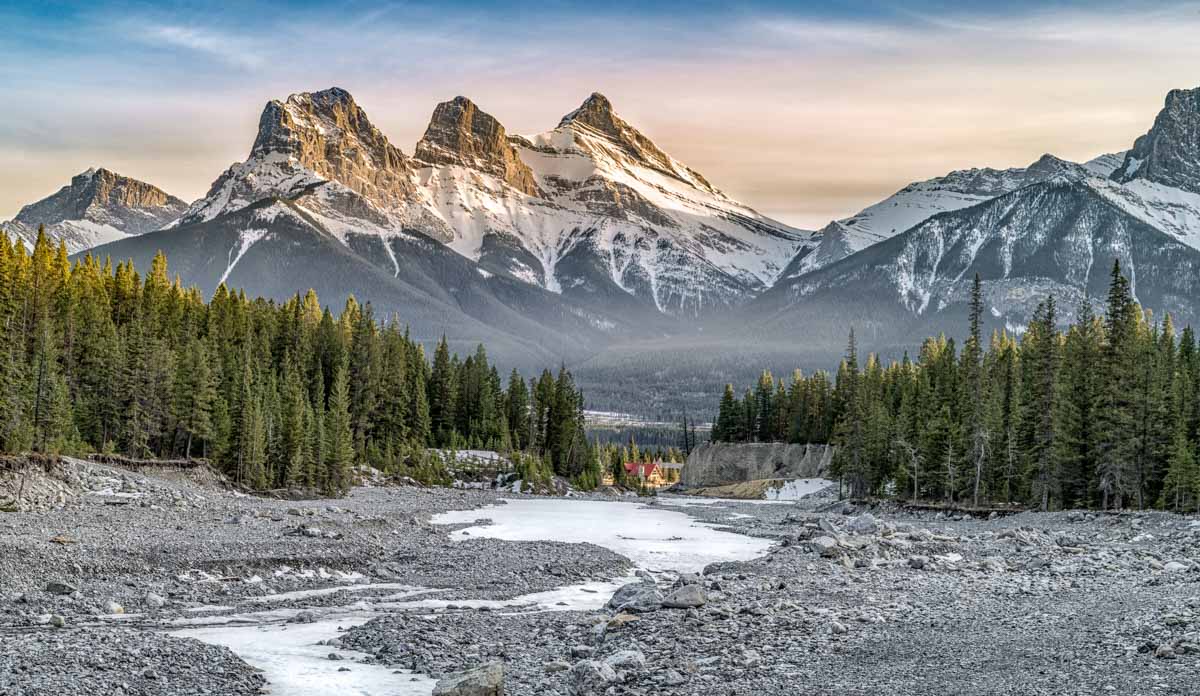
As I say whenever anyone asks me, hiking is the best way to experience the Canadian Rockies , even if you’ve never hiked before or get serious anxiety when you think about climbing uphill (*raises hand and blushes*).
Whether you’ve been hiking since your childhood years or are hitting the trails for the first time ever, there are tons of picturesque hikes in Canmore (and ALL of the Canadian Rockies) suitable for your skill level and preferences.
On day 2 of your Canadian Rockies itinerary, you have a few options: choose 1-2 short hikes in Canmore, or embark on a longer half- or full-day hiking excursion in the area. I’ve listed several hikes, ranging from easy to challenging, in each of the categories below so you have LOTS of options to choose from!
Pro tip: Get started with hiking EARLY. While it will definitely be a little colder outside in the mornings, the most beautiful views of the Rockies happen when the sun is low in the sky, and you definitely won’t want to miss those ideal morning mountain photo opportunities.
Short Hikes in Canmore
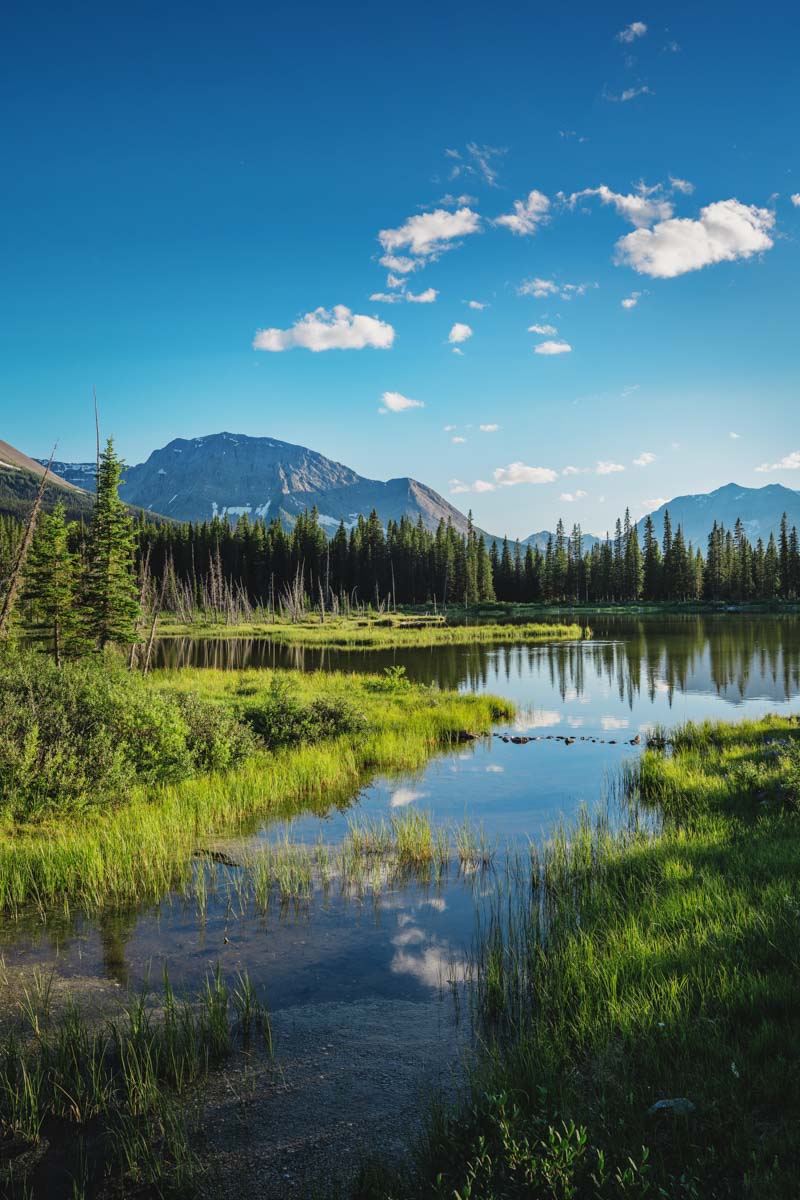
Bow River Loop – (3.5 kilometers, 1-1.5 hours) This is a nice little trail that starts in Canmore town center and loops around to the Bow River. If you’ve arrived in Canmore early enough on Day 1 for a short hike, this is a perfect one to try. Stunning views of the river, evergreen forests, and the surrounding mountains will greet you.
Grotto Canyon – (4.4 kilometers, 1.5-3 hours) One of the most unique hikes in Canmore, the Grotto Canyon trail takes you through huge rock structures where local climbers can often be found scaling the vertical rock faces. The trail is surrounded by large rocks and ends at a waterfall.
Grassi Lakes – (4 kilometers, 1-2 hours) Grassi Lakes is one of Canmore’s iconic hikes and is a local favorite that’s perfect for hikers of all levels. The trail takes you to two deep turquoise alpine lakes surrounded by evergreen trees, and it’s a super tranquil place to go for a short morning hike.
Quarry Lake – (3 kilometers, < 1 hour) This family-friendly loop trail winds around the banks of Quarry Lake, offering beautiful views across the water toward the mountains. You can also swim in the lake if the weather is warm enough!
Half-Day Hikes in Canmore
Ha Ling Peak ( CLOSED UNTIL FURTHER NOTICE ) – (5.3 kilometers, ~4 hours) This is arguably one of the coolest and most picturesque summits in Canmore. But don’t let Ha Ling Peak’s short trail distance fool you: the hike is actually quite difficult, as you’ll ascend well over 800 meters in less than 3 kilometers. The peak itself rewards you with breathtaking panoramic views of the Bow Valley below.
Lady MacDonald Tea House – (9 kilometers, 4-6 hours) This hike, named after a tea house that was never actually built, is a gorgeous trail that has beautiful views start to finish. One of the more popular hikes in Canmore, this moderately difficult hike is a perfect half-day adventure for hikers looking for a bit of a challenge and the reward of stunning photogenic viewpoints.
Full-Day Hikes in Canmore

Mount Yamnuska – (11 kilometers, 6+ hours) By far, Mount Yamnuska is one of my favorite adrenaline-pumping, muscle-throbbing hikes in ALL of Canada! This 11-kilometer trail takes you through an evergreen forest, up a steep rocky scramble, around a chain cliffhanger (seriously), and up to the summit of this iconic Canmore peak. It’s a whopping 900+ meters of elevation gain, so be ready for some SERIOUS uphills and downhills if you choose to tackle this one.
Heart Mountain Horseshoe – (11 kilometers, 6+ hours) I haven’t actually hiked this one, but I’ve heard awesome things about it from friends back in Calgary. This is a moderate to difficult trail that involves a bit of rock scrambling towards the top. The views from the trail and the summit are said to be absolutely incredible.
When You Get Hungry: Breakfast or Lunch at Communitea
Depending on your schedule, you’ll be hungry eventually, and if you need a great stop for breakfast or lunch, I strongly recommend Communitea . It’s a little coffeeshop/cafe hybrid with delicious, healthy dishes and a cute, colorful atmosphere.
Head there for breakfast for a caffeine fix before a big hike, or pick up one of their hot drinks and a delicious, filling savory bowl for lunch after hitting the trails in the morning.
Evening: Dinner at Rocky Mountain Flatbread Co
A Western Canada chain, Rocky Mountain Flatbread Co is literally the perfect post-hiking meal. They’ve got a HUGE oven they use to bake their flatbreads, which come out nice and piping hot to your table. If you’re planning on going during the height of dinner time, I’d strongly recommend making a reservation.
When you check out the menu, you’ll see they have DOZENS of pizza and pasta options to choose from (I may be biased, but you should definitely try the sundried tomato pizza ). You can also grab a Canadian craft beer or a signature cocktail with your dinner.
You’ll spend the night in the same Canmore accommodation you chose on Day 1.
Day 3: Banff Town & Iconic Sights
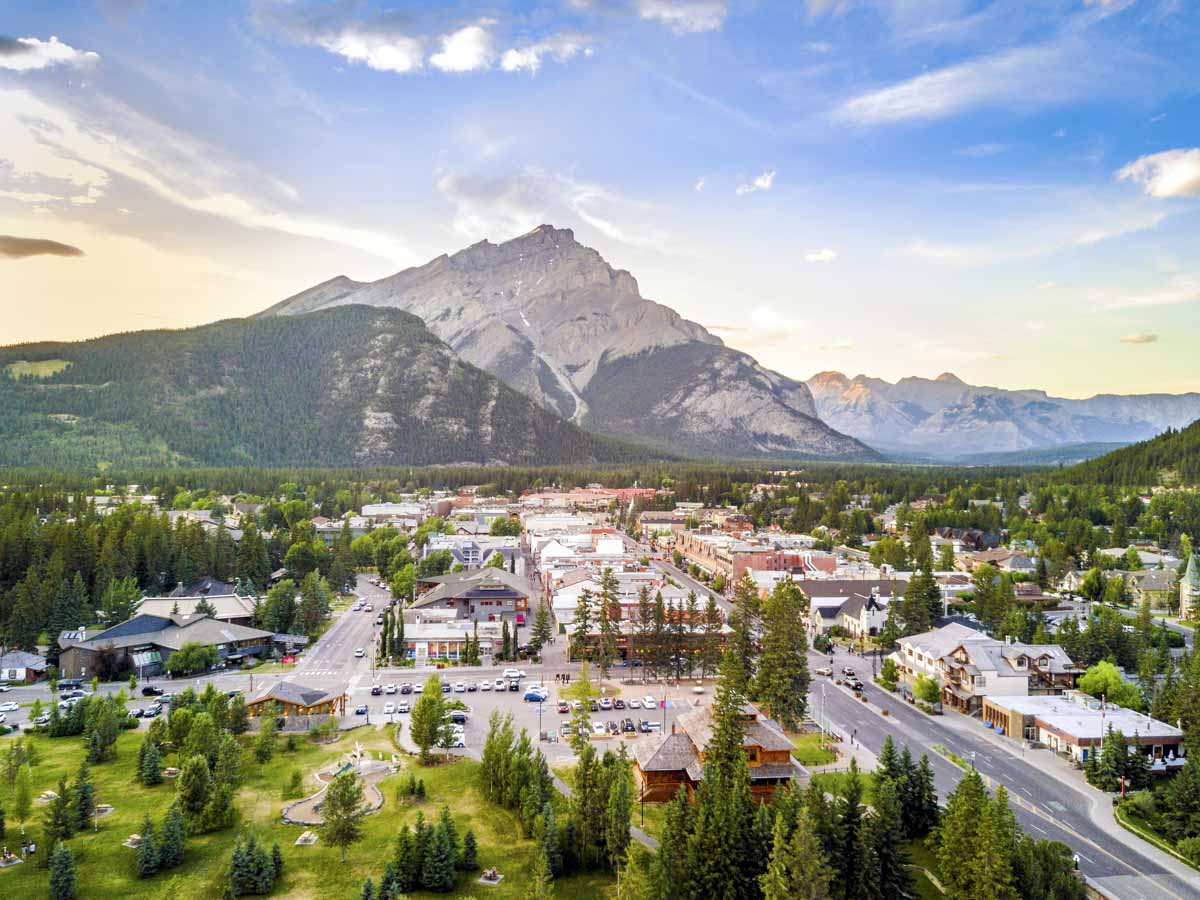
I know I gave you a day full of hiking yesterday, so today, you’ll be taking it a bit more easy on the legs. You’ll drive the short distance to Banff National Park, explore the Banff Town area, eat a delightful dinner at one of my favorite restaurants in Banff, and end the night with some stargazing if it’s clear outside!
Morning: Drive to Banff & Breakfast at Tooloulou’s
Since you’ll be exploring the area near Banff Town today, you can choose what time you’ll want to head out. ( Banff is about a 30 minute drive from Canmore, so make sure you are in the car driving before you get struck with the iron fist of breakfast hanger. )
You’ll continue down the Trans-Canada Highway until you reach the Banff Entrance (which consists of small huts on each lane of the highway where you pay your entrance fee). Pay the fee, which is $9.80 CAD per adult, then continue driving alllll the way to Banff town.
Along the way, you’ll catch a glimpse of Canmore’s stunning Three Sisters and Banff’s Mount Rundle.
Once you arrive in Banff, head to Tooloulou’s , arguably the best traditional breakfast place in town. It’s a Louisiana-style Cajun restaurant with a Canadian flair. Here, you can get french toast, omelettes, and hashbrowns in HUGE (shareable) portions. It’s delicious, especially since I know you’ll be hungry by the time you arrive in Banff.
Late Morning/Afternoon: Explore Banff Town & Surrounding Areas
After you’ve wrapped up breakfast, you’ll hop back in the car and explore the Banff town area. You might be thinking, Kay, I didn’t come to the Canadian Rockies to spend time in a town. But actually, Banff town is pretty small and picturesque, and it’s the town’s immediate surroundings that you’ll be getting to know on this day.
Depending on your energy levels and the amount of time you have, there are several options you can try. Here are a few of the main highlights in and around Banff Town:
Banff Gondola – One of the most fun and picturesque non-hiking activities in Banff is a ride on the Banff Gondola. While the ride is only ~8 minutes each way, the Gondola takes you up to a complex with an incredible panoramic observation deck, a cafe and restaurant, and amazing views for days. ( Pro tip: Head up on the Gondola later in the day when the sun is low in the sky for extra special views!)
Surprise Corner – The Surprise Corner is Banff’s worst kept secret, an unofficial viewpoint that has never *officially* been recognized as a landmark. As a roadside viewpoint just outside the city, the Surprise Corner is actually a popular place to stop off and admire views of the Bow Valley and the Banff Springs Hotel sticking up out of the trees. There are also several trails leading from the parking area around and into the valley below.
Fairmont Banff Springs Hotel – You’ve probably seen photos of the Fairmont Banff Springs all over the internet. If you’re looking for luxury and history all in one place, the Banff Springs Hotel is a fantastic landing spot for you. Situated in the scenic Bow Valley, the hotel boasts several restaurants, a spa, and several amenities for actual guests. However, if you just want to take a look, head there for a leisurely lunch in one of their dining spots.
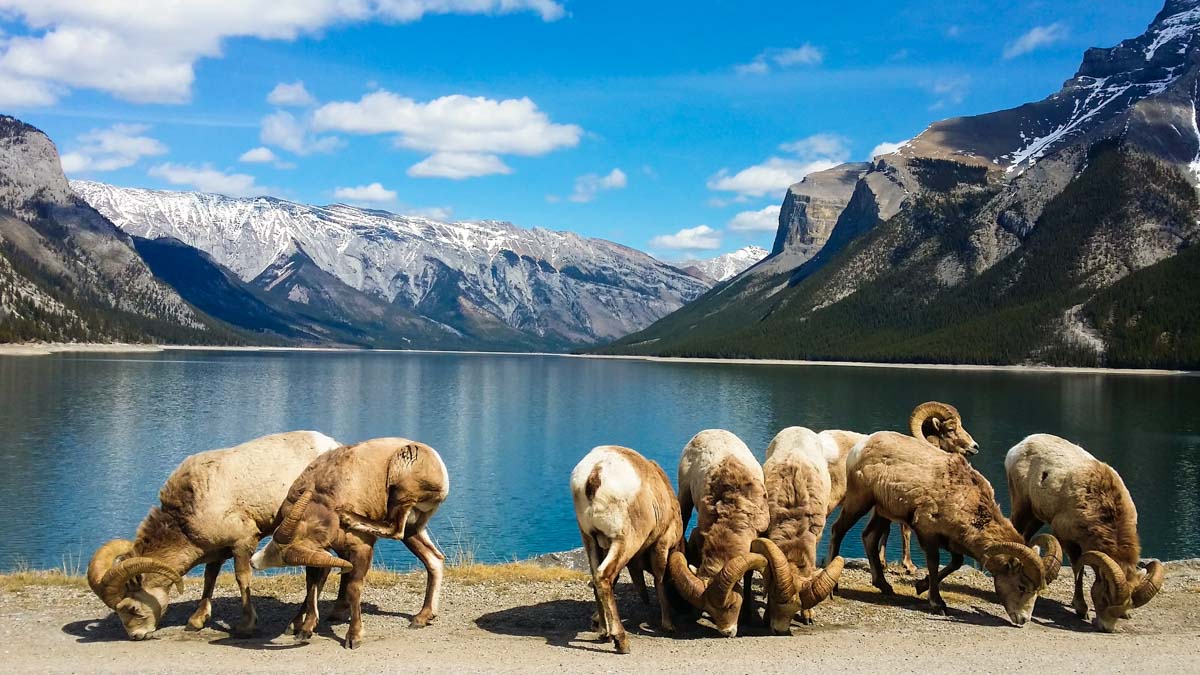
Lake Minnewanka – Lake Minnewanka is one of my favorite places in Banff, if not for the sheer fact that there is SO much to do there. You can rent a kayak or take a boat cruise, wander the lakeside trails or sit down for a picnic. In the night time, you can even stargaze here! I’d recommend heading over there and seeing where the day takes you…but beware: you might end up spending your ENTIRE day here!
Bow River Falls – This is a short, easy hike down to a wide waterfall on the Bow River. It’s a nice, scenic, paved trail that is family-friendly and will take you near Banff town down the river.
Banff town center – If the weather is bad or you’re just too dang tired to do anything, sticking around in Banff town center is NOT a bad option. There are scenic mountain views from the streets, as well as a handful of restaurants, shops, and museums that you can check out to learn more about Banff’s history, including the Whyte Museum of the Canadian Rockies.
If you have more than just 2 days to spend in Banff, here’s our complete guide to the park with a list of 23 amazing adventure activities to try:
Read our complete guide on the best activities & things to do in Banff
Evening: Dinner at Park Distillery & Stargazing
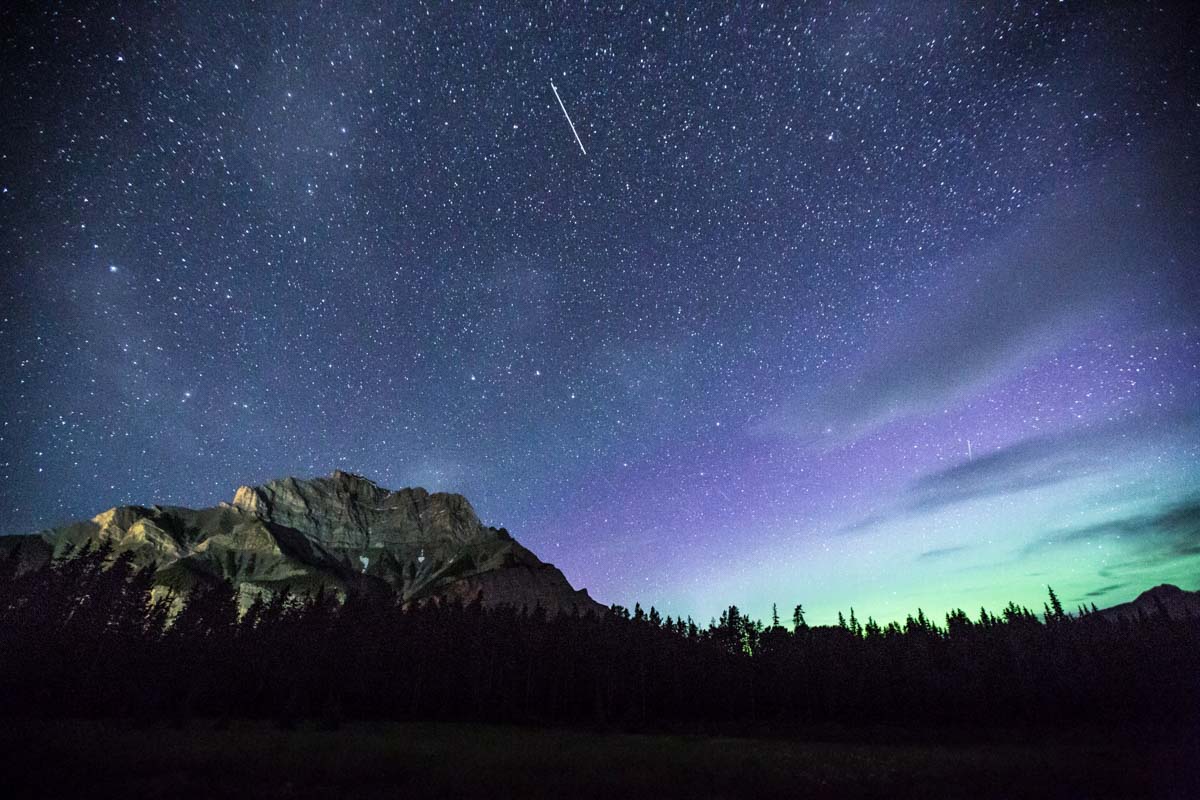
By the evening, you’ll probably be REALLY hungry and ready for a hearty, delicious meal in a relaxed place. I’ve got the perfect place to you: Park Distillery . Their mission is “campfire-inspired meals” and they really do play the part well, from char-grilled meats and steaks to the amazing smell of campfire inside and around the restaurant.
After your dinner, if you’re still a liiiiittle hungry, stop by Beaver Tails nearby for an amazing Canadian dessert: baked (fried?) dough topped with delicious sweet condiments like Nutella, M&Ms, cinnamon, and more.
If the sky is clear while you’re heading out from the restaurant, you can hop in the car and head to a nearby lake for some amazing stargazing opportunities. Outside of the town center, you can see a lot of stars and constellations in areas with little tree cover.
Here are a few beautiful spots in Banff I’d recommend for stargazing:
- Lake Minnewanka
- Vermilion Lakes
- Two Jack Lake
If it’s cloudy or rainy, just head back to your hotel/hostel and cozy up in your blankets. Tomorrow is a day of hiking so you can definitely use a good night’s sleep!
Overnight in Banff National Park
The blessing and the curse of Banff is that there are SO many places you can stay. And making a decision on where to stay in Banff can be a little overwhelming. So, here are my recommendations for a few popular places to stay (or you can read this post for the full list, from luxury lodges to budget hostels):
- Mid-Range Hotel: Moose Hotel & Suites – This is possibly the cutest lodge in Banff, with a big wood fireplace in the lobby and stunning views of the Rockies. If you’re looking for an affordable full-service hotel option in Banff, this one is arguably the best.
- Budget Hostel: Samesun Banff – A cozy hostel located in Banff’s downtown area, Samesun come highly recommend by budget travelers. People really love their laid-back atmosphere, low prices, and kitchen facilities (because, ya know, those restaurants can really add up!).
- Camping: Two Jack Lakeside – This is my #1 favorite campsite in the Canadian Rockies. Located right next to Two Jack Lake, the campsites offer stunning sunrise views of Mount Rundle, as well as amazing stargazing options. Campsites come with access to showers and running water, as well as fire pits (extra fee) and spacious areas to pitch your tent/hammock/whatever.
Click here to check reviews and prices for accommodations in Banff
Day 4: Hiking in Banff National Park
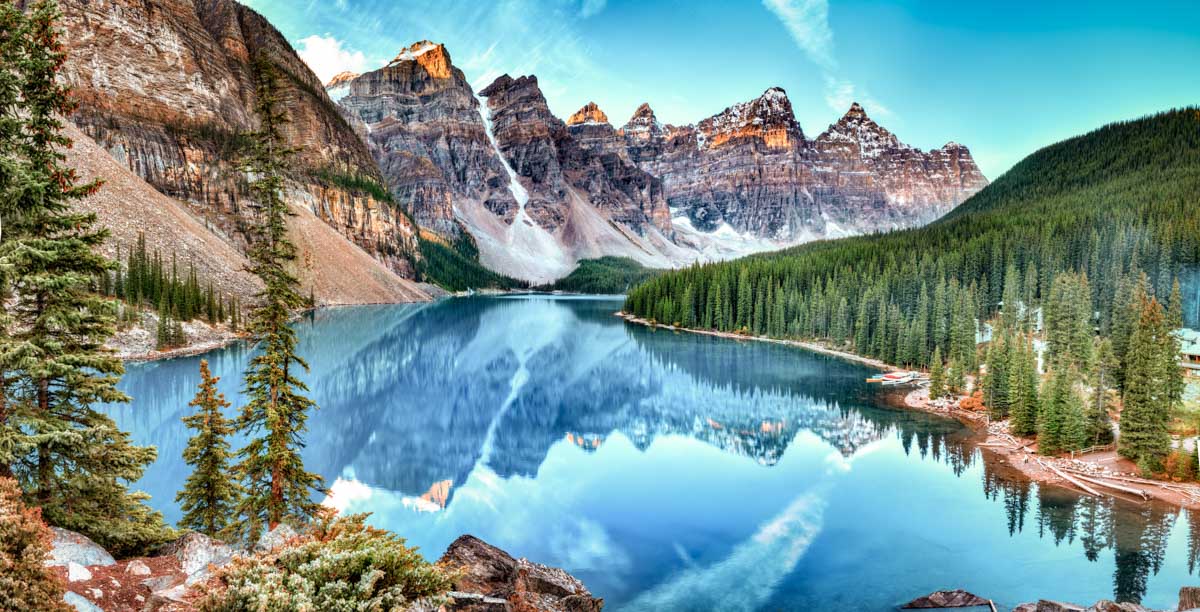
Yup, you guessed it: today is a full day dedicated to hiking! There are SO many fantastic trails in Banff, and it’s worth trying at least 1 or 2 of them before you leave. Before beginning any hike in Banff, it’s wise to check the Parks Canada website for updates on trail conditions and weather forecasts.
Morning & Afternoon: Go Hiking in Banff
Since we’ve got Moraine Lake, Lake Louise, and Johnston Canyon on the agenda for tomorrow, I’d recommend not choosing those for your hiking day today. Here are 3 other wonderful options for hikes in Banff that you can try on today’s itinerary:
Lake Minnewanka Loop Trail (Easy): An easy loop around one of the most beautiful lakes in the area, the Lake Minnewanka Loop is a fabulous day hike for beginner hikers or families. If you didn’t get over to Lake Minnewanka yesterday, I’d definitely recommend this option!
Cascade Amphitheatre (Moderate): Cutting through a valley with rocky mountaintop views, forested trails, and bubbling streams, this hike is a tranquil adventure into the woods. The Amphitheatre itself is a green valley surrounded by vertical rock faces and almost 360-degree views of the surrounding mountains.
Mount Rundle (Difficult): One of the most iconic mountains in Banff National Park, Mount Rundle is an amazing and challenging summit hike to the peak of this beast. If you’re planning to tackle this hike, be sure you’re fully prepared by reading this post and bringing all of the necessary day hiking items you’ll need.
For even more hiking recommendations, check out our complete guide to Banff’s most incredible hikes (for all levels of hikers!):
When you’re not hiking and need some food/refreshments, I recommend heading to Good Earth Coffeehouse in Banff’s town center. It’s a cute, cozy coffee shop that serves warm drinks and food all morning and afternoon.
Evening: Soak in the Upper Hot Springs & Grab Dinner at Banff Ave Brewing Co
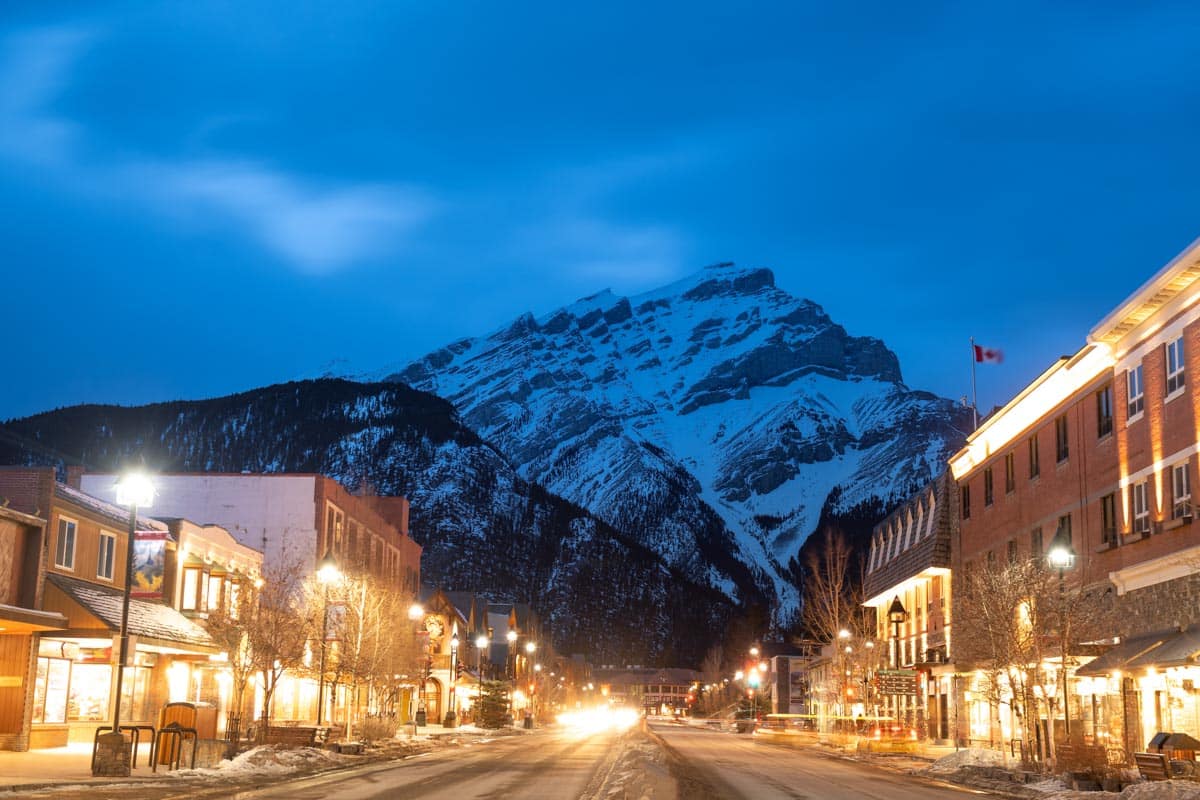
Once you’re done hiking for the day, head to the Banff Upper Hot Springs , which is just outside of Banff town. Here, you can kick back in the steaming hot pool and relax your muscles after a long day of hiking. The pool is clean and spacious, perfect for relaxing for an hour or two before heading off to dinner.
The Banff Upper Hot Springs costs $8.30 CAD for adults and you can rent a towel and/or swimsuit for $1.90 CAD each.
After your soak in the springs, grab some light eats and a beer at Banff’s craft brewery, Banff Ave Brewing Co . They serve up a delicious, affordable, vegetarian-friendly menu and a sizeable variety of beers, ranging from chocolatey darks (my style) to light, sour IPAs (Raf’s style). Get the crunchy fried broccoli and house nachos, or go for a heavier option like the Alberta Beef Burger or the Mushroom Gnocchi.
You’ll spend the night in the same Banff accommodation you chose on Day 3.
Day 5: Lake Louise, Moraine Lake, & Johnston Canyon
This is one of the most iconic days in the itinerary, where you’ll be headed to the famous Moraine Lake (yup, the one you see in all those Instagram photos of Banff), Lake Louise, and Johnston Canyon.
But here’s the catch: this day starts EARLY.
If you can be out of the house by 5:30 AM or before sunrise, that’s ideal.
This way, you’ll avoid the treacherous crowds at Moraine Lake and Lake Louise, and you can spend the afternoon strolling through Johnston Canyon (Or, like, napping in a tree from waking up so early. Both are acceptable.).
Early Morning: Moraine Lake

Set that alarm for 5 AM and grab a Clif bar to go for your breakfast as you leave your Banff hotel to drive ~40 minutes to the Lake Louise area.
You’ll see the iconic Lake Louise a bit later in the morning, but you’ll first want to drive up to nearby Moraine Lake to catch that epic sunrise view that EVERYONE AND THEIR MOTHER wants to see.
The parking lot for Moraine Lake is pretty small, which is why I’m recommending getting up so early. When Rafael and I went there for the first time, we arrived around 6 AM and, while we weren’t the only people there, we had the place largely to ourselves.
Park in the parking lot and go for a stroll around the lake, or up onto the famed Rock Pile to get that incredible view that everyone raves about (there’s a reason why this is one of the most Instagrammed places in Banff ).
Morning: Breakfast & Hiking at Lake Louise
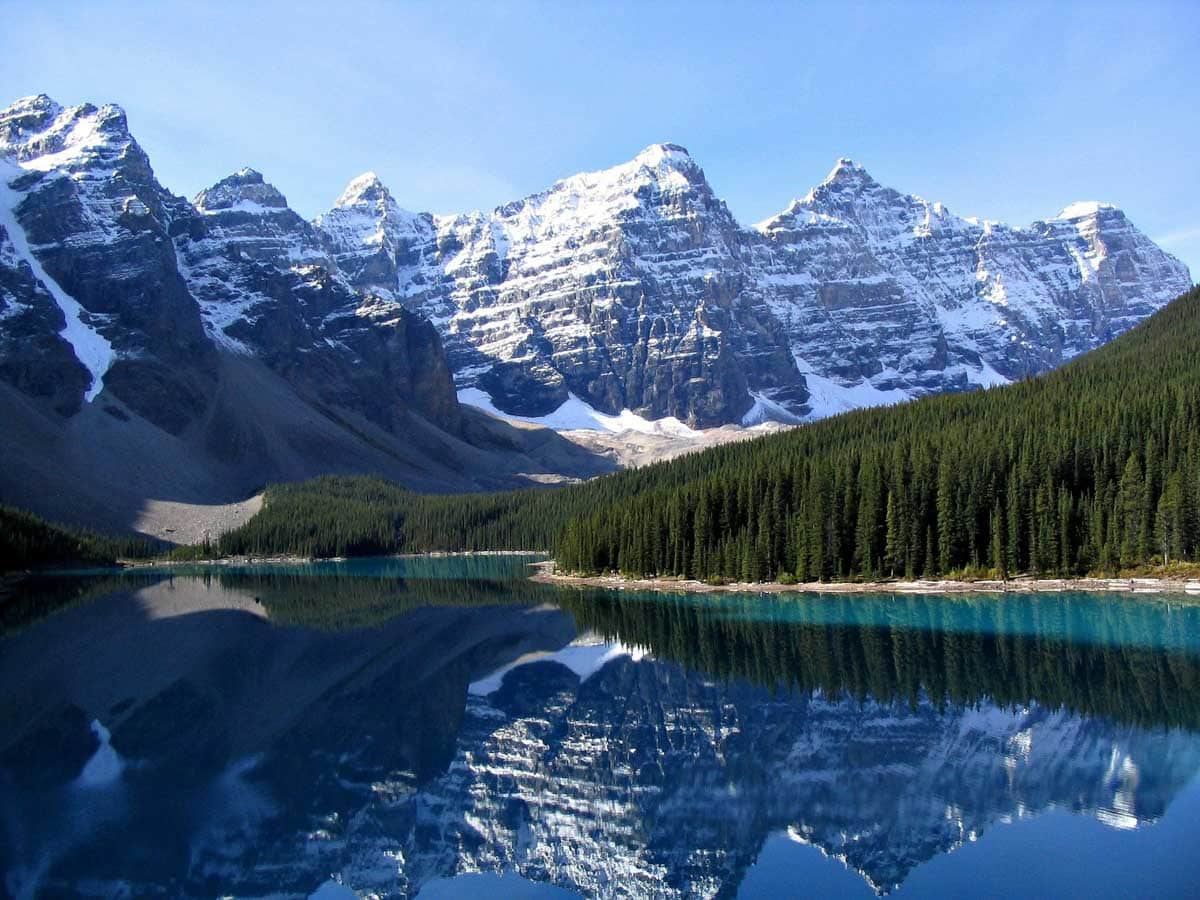
Once you’re finished at Moraine Lake, you can either head straight to Lake Louise or stop at Trailhead Cafe for a coffee and a bite to eat. Their “The Cure” sandwich is amazing to start (continue?) your day.
When you’re ready, head to Lake Louise and try to snag a parking spot as close to the entrance as possible. During the high season, the parking lot fills up and you have to park at a different one a few miles away and then shuttle in (which sucks, don’t do it).
If you get to Lake Louise early enough, you won’t have this problem. Instead, you can park right in front of the hotel and stroll right into the main lake area. Once you arrive at the lake, you’ll see the otherworldly turquoise water, the famous Fairmont Chateau Lake Louise, the amazing glacier, and striking mountains around you.
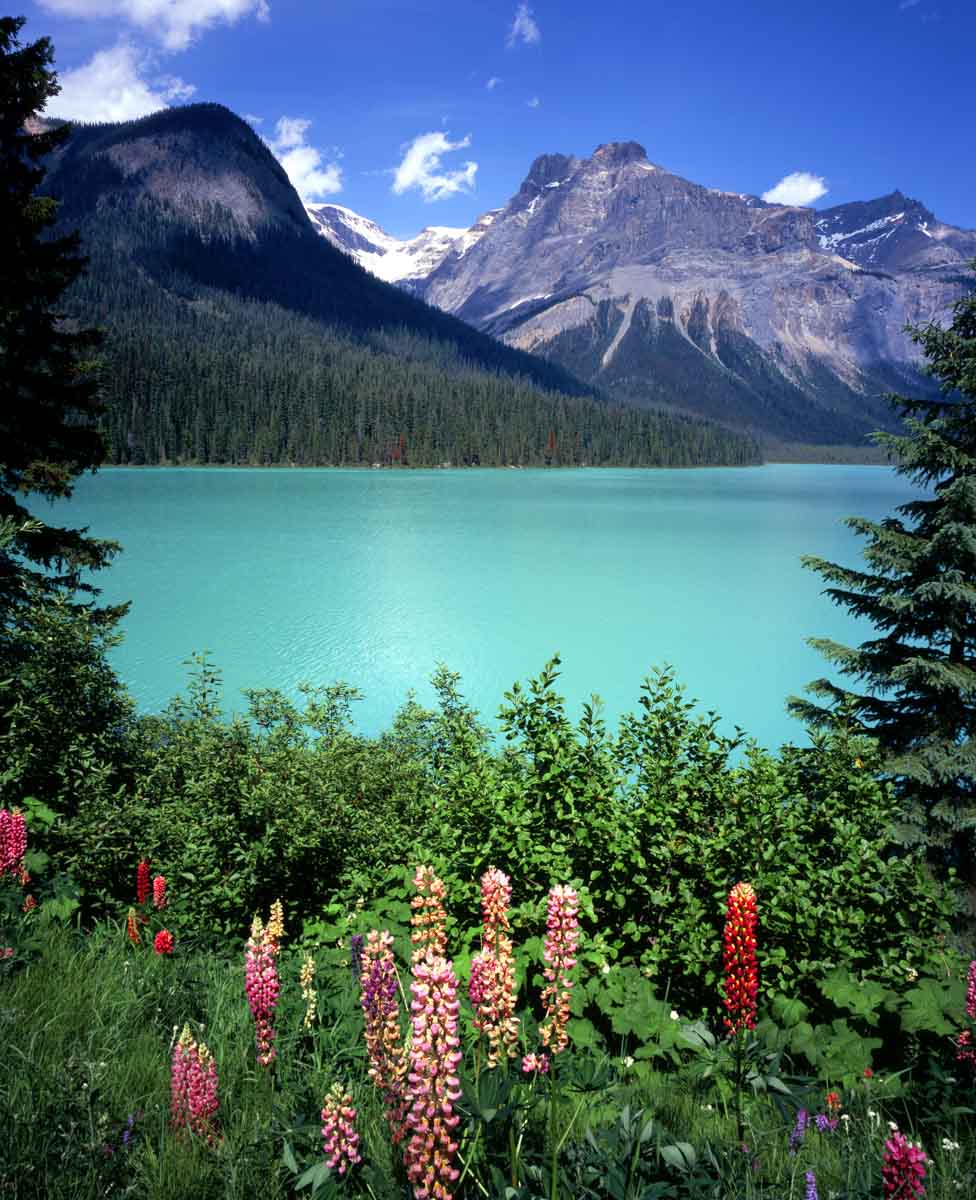
At Lake Louise, you have a few options. You can simply hang out around the hotel and the waterfront, or you can:
- Rent a kayak and explore the lake on the water
- Have brunch at Poppy Brasserie , the Fairmont’s breakfast restaurant which boasts table-side views of the lake and the surrounding mountains
- Do the Lake Agnes Tea House hike , which takes you up to a hidden alpine lake and a cozy tea house that serves warm drinks and snacks in the summer
- Embark on the Plain of Six Glaciers hike , which is a half-day hike that takes you to some pretty epic glaciers and landscapes around and above Lake Louise
If you’re planning on just stopping by Lake Louise, you won’t need more than an hour in the area. However, if you plan on doing any of the above activities, plan for 3-4 hours (5+ hours for the Plain of Six Glaciers hike).
Afternoon: Hiking at Johnston Canyon
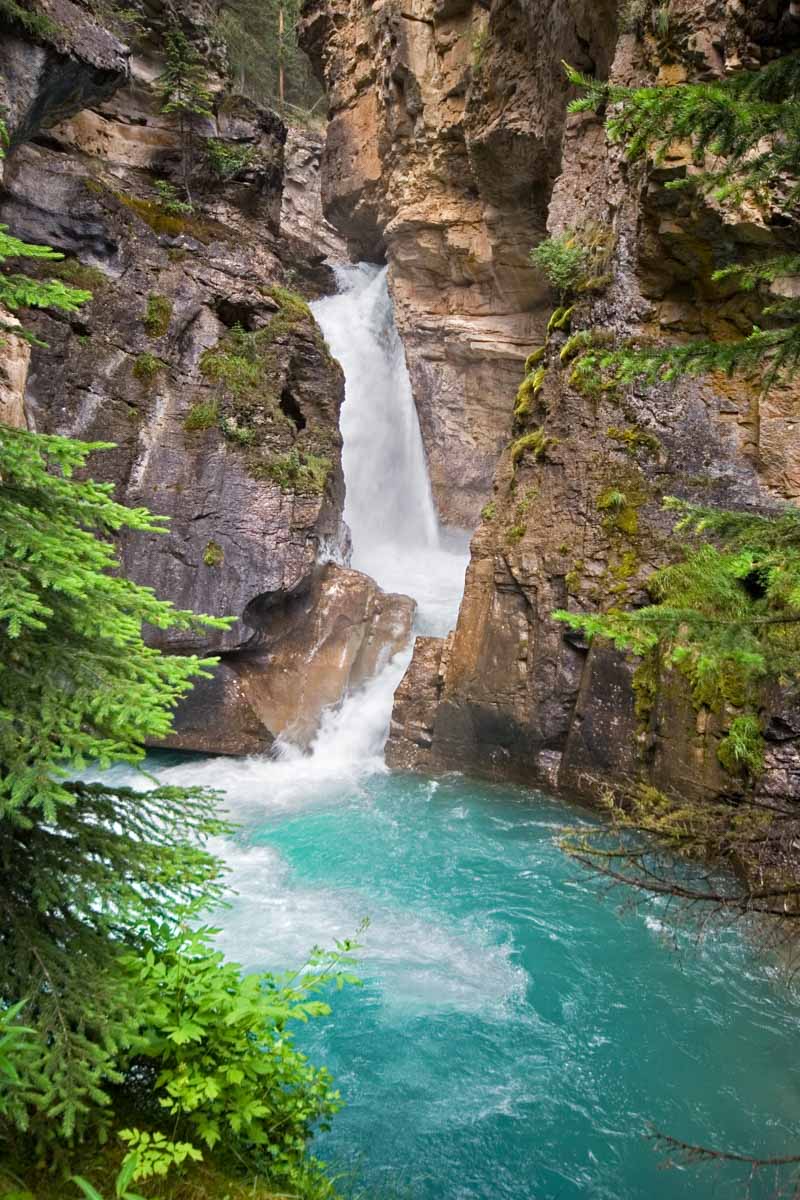
After you’ve wrapped up at Lake Louise, you can head towards Johnston Canyon, which is a nearby trail system that travels through a beautiful, stark canyon with teal rivers and waterfalls running through it. If you’re hungry, at the entrance is a small gift shop and cafe where you can buy soups and sandwiches.
On the trails, there are a series of catwalks that take you through the canyon to two sets of waterfalls – the Upper and Lower Falls – and a lake area called the Ink Pots. At the Ink Pots, you can see multicolored pools of water that look really unique and cool for pictures.
You can choose to only visit one or both of the falls, but keep in mind that the total Johnston Canyon trail from the start to the Ink Pots is ~11.7 kilometers round trip.
Evening: Dinner at Bill Peyto’s Cafe
After your busy, busy day in the northern part of Banff, there’s nothing better than sitting down for a big, warm dinner. Bill Peyto’s Cafe is an affordable and popular choice in the Lake Louise area for exactly that.
Full disclosure: I’ve actually never eaten here , but I’ve heard raving reviews about this place, which is actually attached to the HI-Lake Louise Hostel . After a long day (which this one definitely was), it’s a great place to enjoy hearty, affordable Canadian food and drinks.
Try the elk burger with a side of Canadian craft beer , and don’t forget to try their famous hot sticky toffee pudding cake .
Overnight near Lake Louise
On this night, you can choose to stay in your same Banff accommodation as the last two days, OR you can relocate closer to Lake Louise. I tend to prefer the latter because tomorrow, you’ll be heading north toward the Icefields Parkway, and it will eliminate over half an hour of driving for you the next day. Gotta make up for the sleep you lost last night!
Here are a few options for places to stay near Lake Louise:
- Splurge Resort: Fairmont Chateau Lake Louise – I know I haven’t been giving many “splurge” recommendations for this itinerary, but if you’re going to splurge for ONE NIGHT on your trip, this is it. I’ve been dreaming of spending a night or two in the Fairmont Chateau Lake Louise since the first time I visited, and I’ll be saving those pennies until I can do so one day. Anyway, if you’ve got the cash, there’s no better place to spend a night than this iconic hotel, which rests on the banks of Lake Louise itself.
- Mid-Range Hotel: Paradise Lodge & Bungalows – Perfect for larger groups, this family-friendly set of bungalows is located on the road to Lake Louise and offers large full kitchens in-unit. There’s no on-site restaurant, but the Lake Louise Visitor’s Centre isn’t far.
- Budget Hostel: HI-Lake Louise Alpine Centre – HI-Lake Louise Alpine Centre is located just outside of Lake Louise near the Visitor’s Centre. As another Hostelling International hostel, you can expect clean, cozy dorms and private rooms, large social areas and a kitchen, and affordable rates.
- Camping: Lake Louise – This tent camping spot is located right near Lake Louise and is the perfect place to spend a night in the area.
Day 6: Icefields Parkway
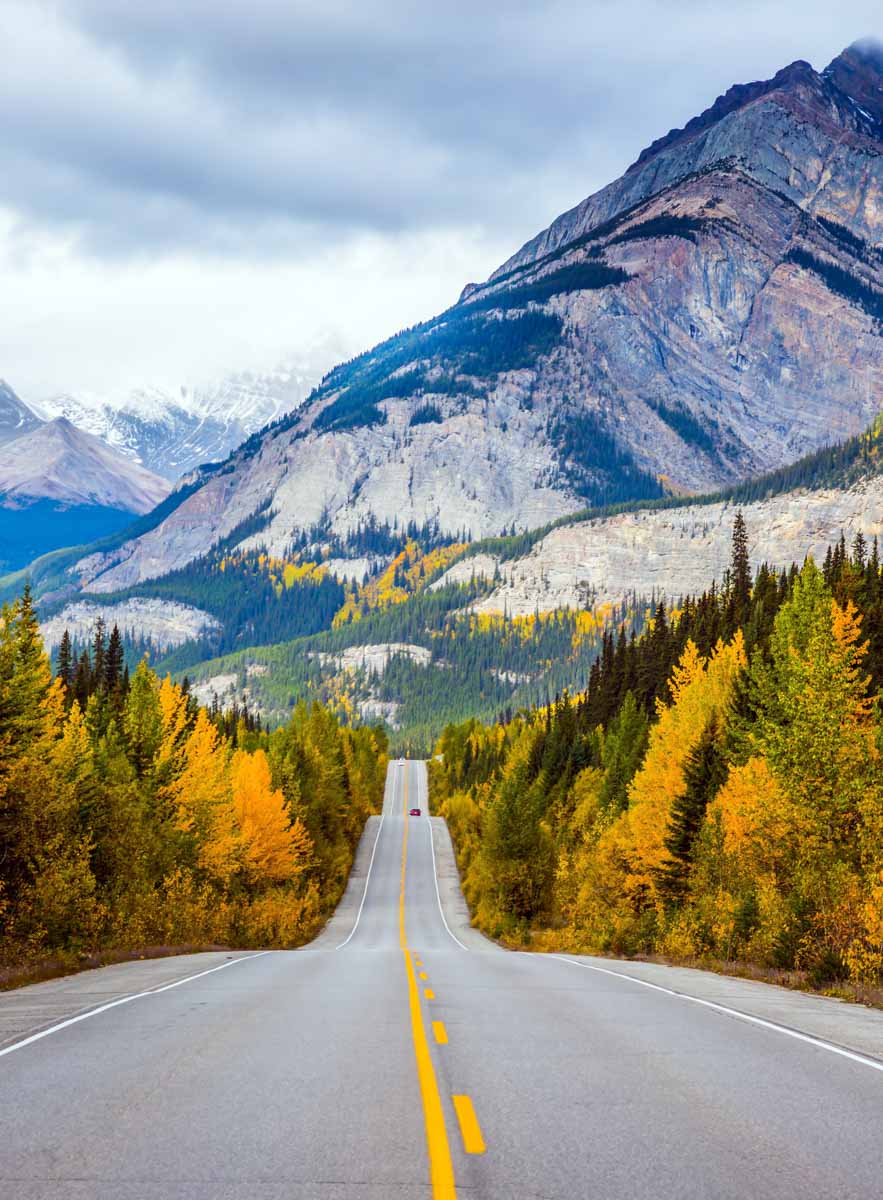
On Day 6, you’ll head up to Jasper via the most beautiful highway in the Canadian Rockies (and maybe in Canada…or the world…).
Nothing screams Canadian Rockies road trip more than driving its most scenic route, and today you’ll have the chance to do that, with a bunch of stops in between.
While the drive itself only takes ~3 hours, you’ll definitely want to stop for some photos, fresh air, hiking, and more. In this part of the itinerary, we’ve laid out all of your options for places to stop and things to do along the Icefields Parkway.
Morning: Alpine Lake Viewpoints
Grab an early breakfast to go at Trailhead Cafe in Lake Louise. I’d also recommend grabbing some extra sandwiches to go for lunch later, as you may not want to stop for food during your road trip.
Then, head out north on the Icefields Parkway towards Jasper. There are tons of amazing places to stop as you leave the Banff National Park area and turn into the Columbia Icefield.
First, stop at Peyto Lake, which is about 40 minutes from Lake Louise. Peyto Lake is a stunning turquoise lake that you can admire from its highway upper viewpoint, and it’s definitely worth at least a short photo stop before continuing onward.
Late Morning & Afternoon: Choose Your Own Adventure
After you’ve stopped at Peyto Lake, you have a TON of options for things to do along the way. Here are just a few of the many hikes, activities, and viewpoints you can stop at along the Icefields Parkway:
Columbia Icefield Discovery Centre – The discovery centre sits off of the icefields parkway about an hour and a half away from the Jasper Information Centre. Here you can get some scenic views from the top of the centre and you can book excursions out into the icefields. If you are feeling hungry, grab a bite in the attached Altitude restaurant. If you are just passing by on the way to Jasper, plan to spend 30 minutes here for a quick pit stop.
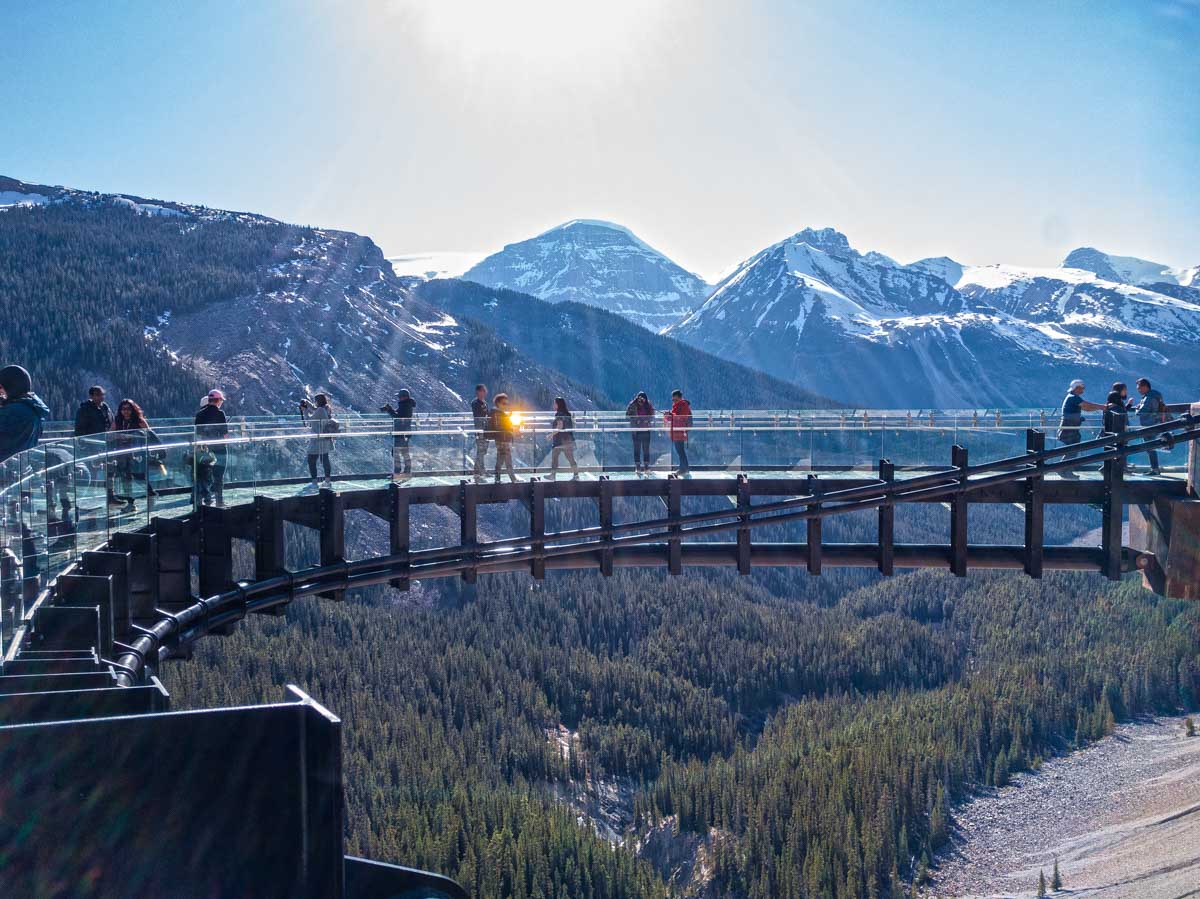
Glacier Skywalk – Take a 400 m walk along a glass-bottomed walkway that overlooks the gorgeous Sunwapta Valley 280 meters below. Tickets for the attraction can be purchased at the nearby Columbia Icefield Discovery Centre, which is about 6 km away towards Banff on the Icefields Parkway. Tickets cost $35 at the door, but you can pre-purchase them online for a slight discount. Plan to spend 30 minutes to an hour there.
Do a Glacier Walk – Take an Athabasca Glacier Tour where you can walk on and drink from the 10,000 year old sheet of ice. You’ll be taken out to the glacier on a huge all-terrain bus with a knowledgeable guide who will teach you about the area’s history. After arriving on the glacier, you’ll get to walk directly on the ice and explore crevasses and hills. Some tours are all day events (10 am – 5 pm), but you can find shorter trips at the Discovery Centre that are 3 hours in length.
Mistaya Canyon – If you are looking for a short half hour break while driving up to Jasper, consider stopping at Mistaya Canyon. Look for a small parking area about 5 km South from the Saskatchewan Crossing. You’ll take a short 10 minute hike that crosses a wooden bridge where you can see beautiful views of the mountains and waterfalls surrounding Mistaya Canyon. This spot is not as well known to many tourists, so it’s a good peaceful place to stop on your way to Jasper or Banff.
Herbert Lake – Herbert Lake is only 6 km away from Lake Louise along the Icefields parkway. Similarly to Mistaya Canyon, looks for a small pull-out area next to the highway where you can park your car. A short 5 minute trail will take you to a brilliant, scenic view of a tranquil, mirrored lake. You’ll have the option of following the trail around the perimeter of the lake if you choose, or simply enjoy the serenity and tranquility of this secluded area.
Chephren Lake – Stop off at the trailhead for Chephren Lake, one of my favorite lakes on the Icefields Parkway. You have to hike in ~3 hours round trip to get there, but I promise the views are totally worth it. By the time you finish up with Chephren Lake, it should be early afternoon and you’ll be ready to continue on to the rest of the Icefields Parkway.
Parker Ridge – About an hour and half from Lake Louise, Parker Ridge offers unparalleled views of the Icefields and Saskatchewan Glacier. The hike is a short 2.7 km that climbs 250 m. You’ll be above the treeline for the majority of the hike. Set aside about 2 hours for the entire round trip. Parking is limited.
Evening: Dinner at Evil Dave’s Bar & Grill in Jasper
For a cozy dine-in experience, Evil Dave’s Bar & Grill is a local favorite. With eclectic decor and delicious, large dishes, it’s a really awesome choice for a post-road trip dinner in Jasper.
They serve up Western Canadian favorites, like Tenderloin and Grilled Chicken sourced from Alberta, but they’ve also got a whole list of amazing vegetarian and vegan options as well.
Overnight in Jasper
- Mid-Range Hotel: Pyramid Lake Resort – This resort looks like a giant log cabin from the outside and sits right next to a lake. Guests will have scenic views of the mountains and can dip their feet in the water just a couple of feet from the hotel.
- Budget Hostel: Jasper Downtown Hostel – With dorms and private rooms, the Jasper Downtown Hostel is the best place for backpackers in Jasper. It offers all the proper amenities of a hostel, including common areas, a shared kitchen, and laundry machines on-site.
- Campsite: Wapiti Campsite – Wapiti is located next to the Athabasca river and offers gorgeous views of the mountains. The site includes access to hot showers, electricity, and fire pits. It is also close to the main town so you can make quick runs for supplies.
Day 7: Hiking in Jasper
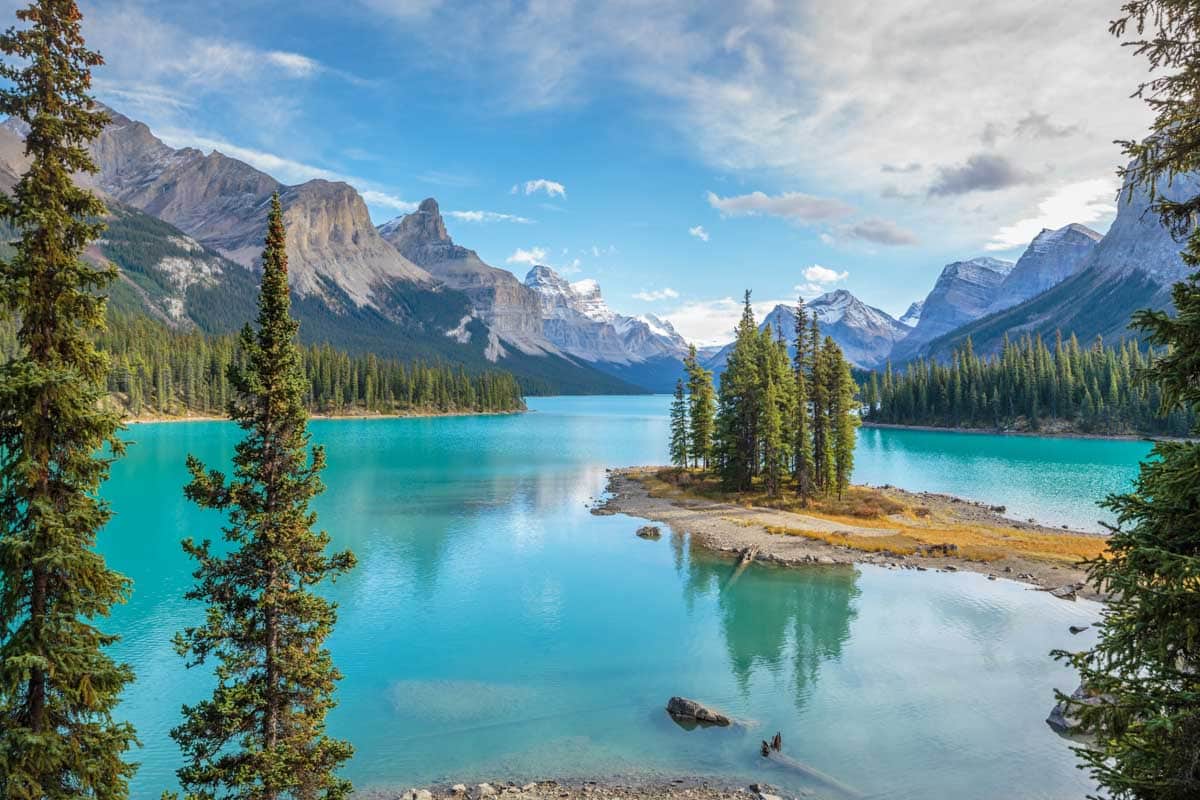
Day 7 is all about exploring Jasper by foot! ( Do you like how I’ve left a whole day in every destination on this itinerary for hiking? Yeah…I kind of like hiking… ) There are several hikes in Jasper for hikers of all levels, from “never hiked before” beginners to experienced mountaineers.
Today, you’ll spend most of the day hiking, then you’ll relax in the hot springs before treating yourself to dinner in one of Jasper’s best restaurants.
Morning & Afternoon: Hiking in Jasper
Like I mentioned, there are dozens of hikes you can try in Jasper ranging from easy, flat trails to rock scrambles. I’ve listed out some of the most popular ones for you here so you can choose 1-2 and plan your day:
Easy Hikes in Jasper
Maligne Canyon: (Easy, 3.9 kilometers) An easy, short hike, Maligne Canyon brings you through a striking canyon, passing by ranging rivers and breathtaking waterfalls in the process. Perfect for families or beginner hikers wanting to see some of the most awesome views in the park!
Valley of the Five Lakes: (Easy, 4.5 kilometers) The magic of the Valley of the Five Lakes trail is exactly what it sounds like: five gorgeous, picturesque lakes with the Canadian Rockies lying majestically in the background. It’s perfect for beginner hikers wanting an easy half-day adventure on one of the most tranquil and iconic Jasper hiking trails.
Moderate/Challenging Hikes in Jasper
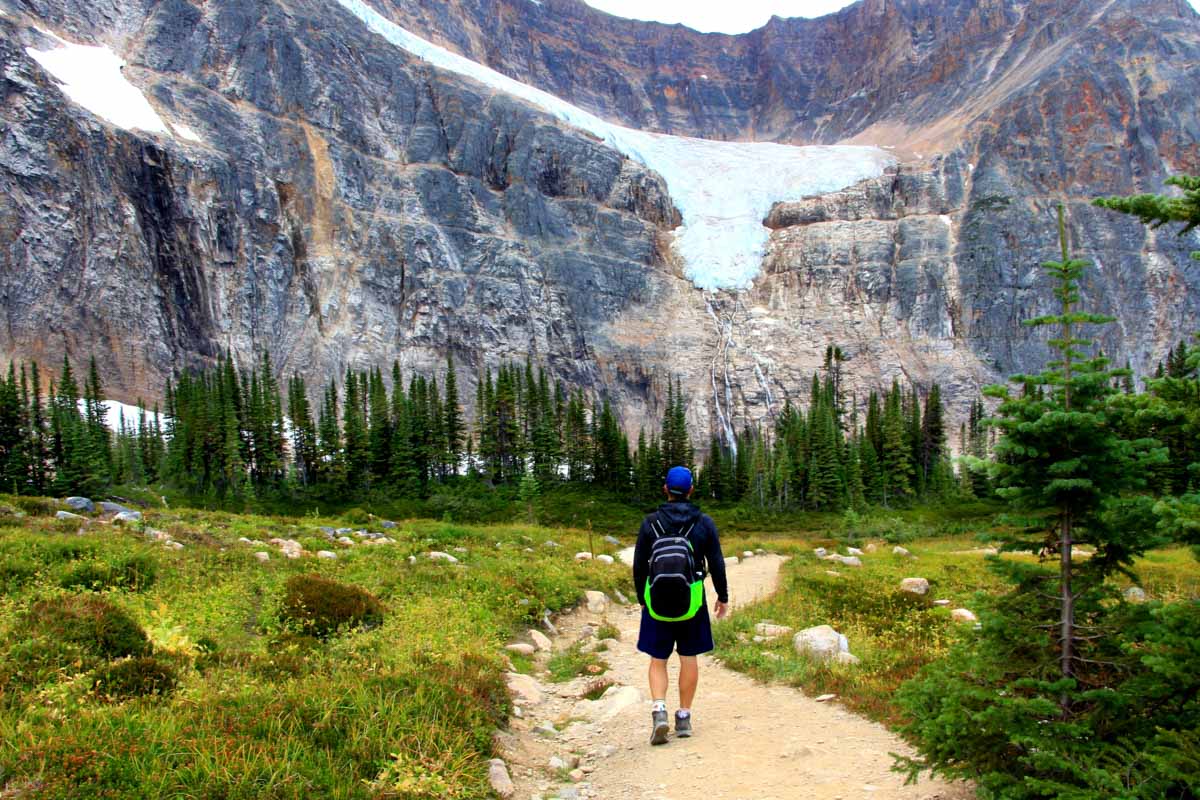
Edith Cavell Meadows: (Moderate, 6 kilometers) Edith Cavell Meadows is one of the most popular trails in Jasper, and for good reason – it’s got a bit of everything, from mountain views to alpine meadows to hanging glaciers and more. The first part of the path is paved, leading you to a lookout point over Angel Glacier. After the lookout point, the trail continues ascending, and the path leads to two more viewpoints – most people (myself included) choose to stop at the second one.
Bald Hills: (Challenging, 13.2 kilometers) As one of the most popular full-day Jasper hikes, Bald Hills is an amazing and challenging trail that will bring you up to some of those drop-dead gorgeous views you see in the postcards. This summit hike is one of the best hikes you can do in the park, and we highly recommend it if you’re up for the challenge.
If you’re in need of some food for fuel or relaxation, head to Coco’s Cafe in downtown Jasper. They serve amazing coffee beverages and snacks for hungry hikers (including some seriously mouth-watering vegetarian and vegan items), and their prices are affordable.
Evening: Dinner at Maligne Canyon Wilderness Kitchen
For the perfect smoky, rich, locally sourced meal, there’s no better place in Jasper to try than the Maligne Canyon Wilderness Kitchen . Located next to the Maligne Canyon trailhead, this small, charming restaurant embodies the spirit of Canadian Rockies gastronomy, with locally sourced meats and produce.
If you’re super tired from the trails, you can also grab their mouth watering dishes to go, but why not stick around and enjoy the fresh smells and flavors in-house?
You’ll spend the night in the same Jasper accommodation you chose on Day 6.
Day 8: Jasper Town & Iconic Sights
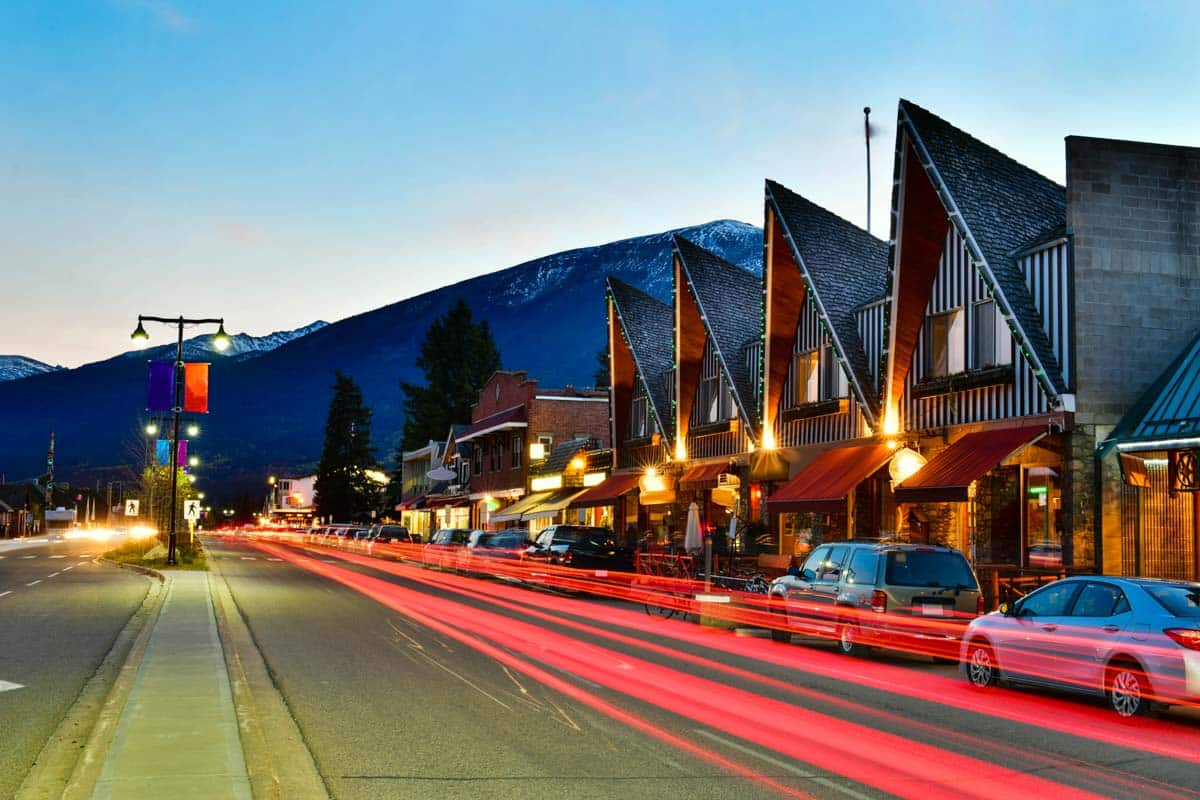
After your big day of hiking yesterday, you’ll take it a little bit easier on Day 8. However, you’ll start your morning super early with a beautiful sunrise view, head to one of the most picturesque lakes in ALL of Jasper, and then explore the area surrounding Jasper town before heading toward Yoho National Park.
Early Morning: Sunrise at Pyramid Lake
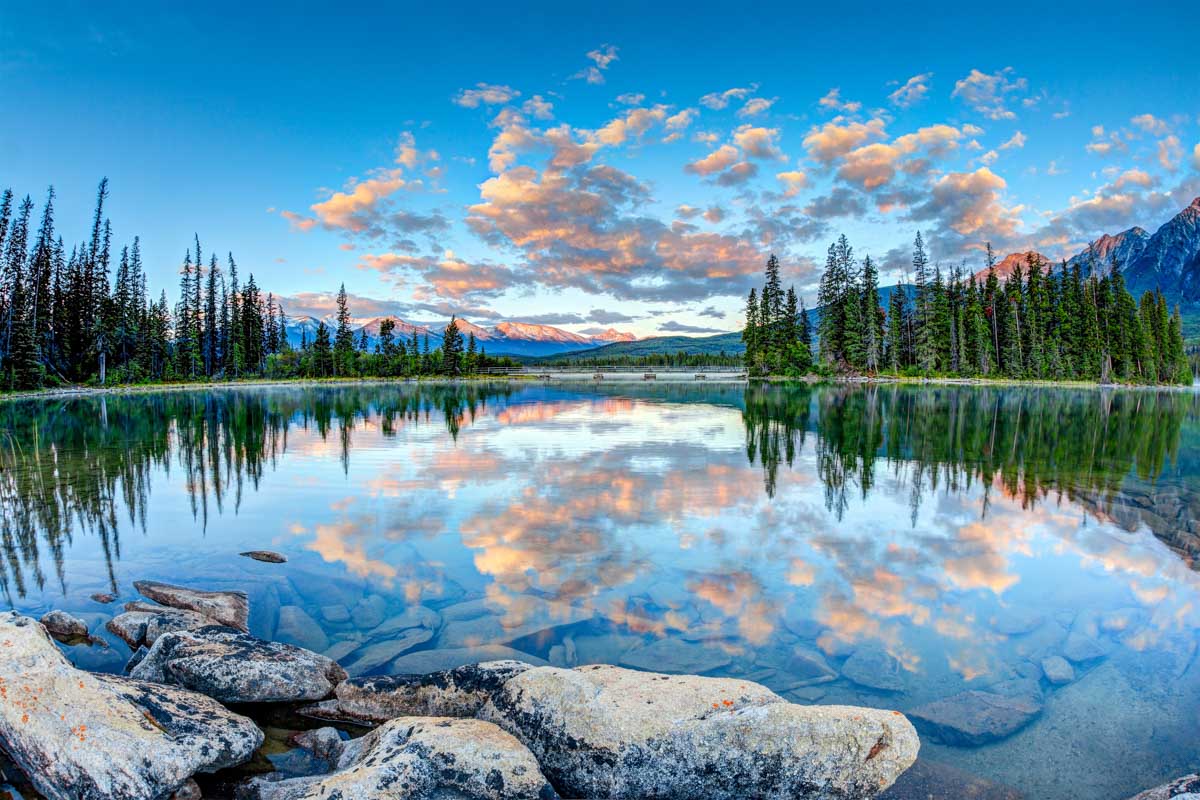
You’ll head out before 6 AM (check the sunrise forecast on your Weather app for a more accurate departure time) to Pyramid Lake.
This dramatic lake is home to a towering mountain peak, a beautiful blue lake, evergreen forests, and a large wooden lodge.
You should get there when the sky is still a deep navy blue, but just bundle up and wait for the sunrise. If it’s clear enough outside, you should start to see the faint hues of pink and red slowly start to paint the mountain face (like the photo I took a few years ago below).
If you’re looking for an alternative view, nearby Patricia Lake is also a really lovely place to watch the sun as it peeks over the horizon. Patricia Lake’s water is a lot more still than the water at Pyramid Lake, creating a gorgeous “mirror lake” effect.
Head back to Jasper town center to grab a quick coffee and breakfast at Coco’s Cafe (or another one of Jasper’s coffeeshops!).
Morning: Maligne Lake
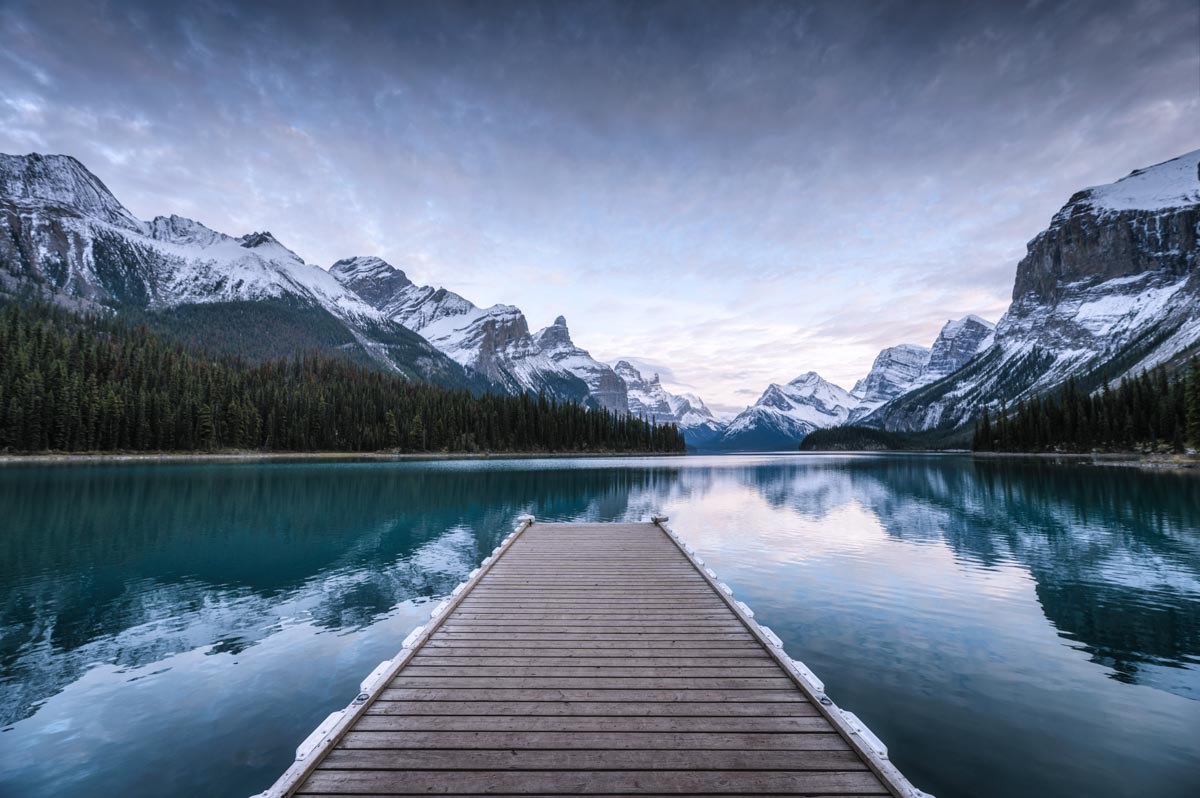
From Jasper town center, it’s a bit of a drive to arrive at Maligne Lake. However, once you’re there, you can spend the rest of the morning simply wandering around the area, doing a nearby hike or getting out on the water.
Here are a few ways to spend your morning in Maligne Lake:
Admire Spirit Island – One of the famous views in Jasper is Spirit Island, a tiny, evergreen-filled island jutting out into the middle of Maligne Lake. It’s super picturesque amidst the backdrop of the clear, turquoise waters of Maligne Lake, and makes for a super picturesque spot to spend the morning.
Take a boat tour – There are a handful of motorized boat tours that travel through the Maligne Lake area, and you can book one very easily. If you’re feeling tired from all of your travel (I understand, this itinerary is SUPER jam-packed!), opt for a relaxing boat cruise around the beauty of the lake.
Kayak around the lake – If you’re looking for an active alternative to the boat cruise, you can rent a kayak and explore around the lake yourself!
Go hiking – There are tons of trails and hiking areas that extend from Maligne Lake up into the nearby mountains.
Early Afternoon: Explore the Jasper Town Area
Now that you’ve spent virtually the entire morning outside, you’ll return to Jasper town center and enjoy some of the more laid-back attractions in the area.
Since you won’t have a TON of time to do things in Jasper town, here are a few suggestions for things you can do with 2-3 hours:
Ride the Jasper Skytram – The Jasper Skytram brings you close to the top of Whistlers Mountain. There’s a sizeable observation deck and an area where you can grab food and drinks. Or, if you’re feeling more adventurous, hop on the hiking trail near the platform to reach the summit of the mountain.
Go cycling on Jasper’s bike paths – Rent a bike at Vicious Cycle Canada and hit the trails! There are plenty of bike trails in and around Jasper’s town center where you can explore on wheels.
Visit the Jasper-Yellowhead Museum – Located in the center of Jasper, the Jasper-Yellowhead Museum discusses how Jasper’s community began, and provides important historical context to the area that’s now largely known for its natural beauty and adventure activities.
For our entire list of things to do in and around Jasper town, check out the complete guide:
Click here to read our complete guide to things to do in Jasper
Late Afternoon & Evening: Drive to Yoho National Park
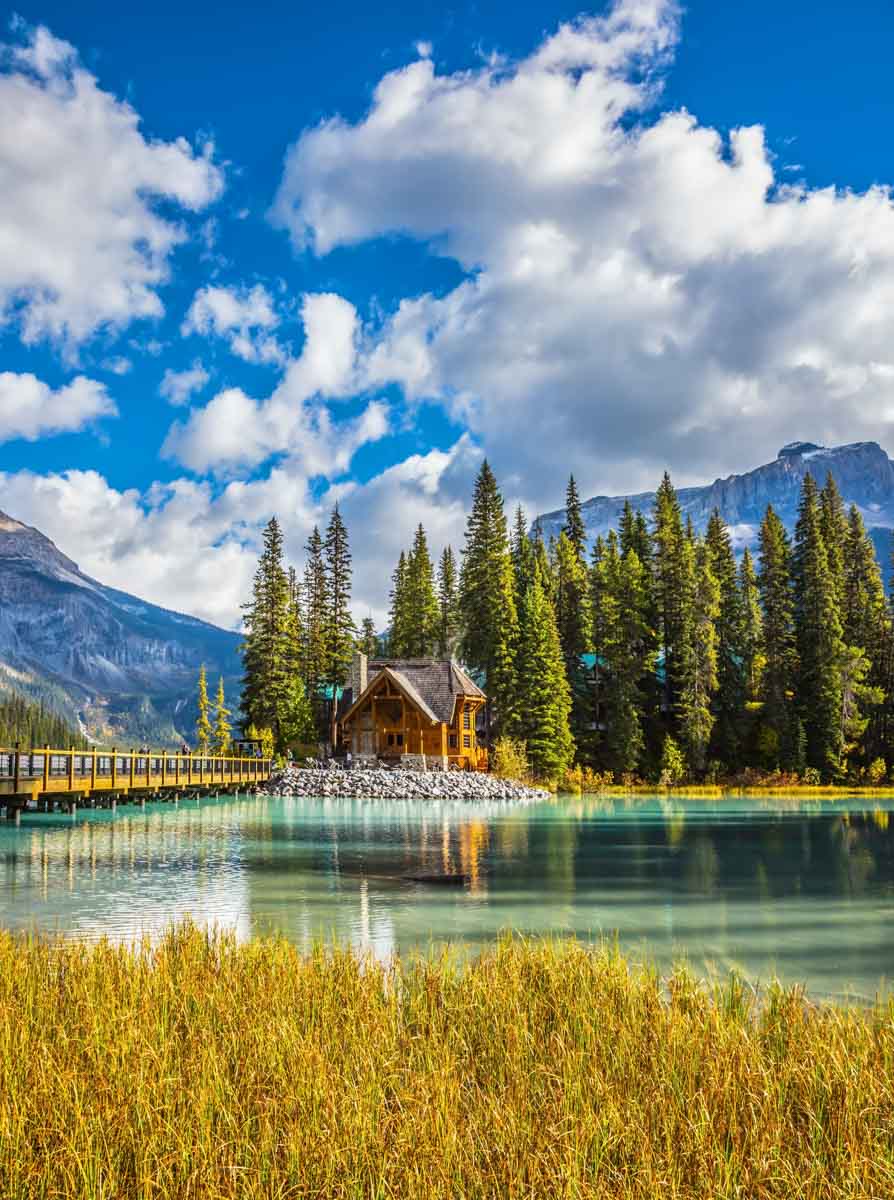
The drive to Yoho, your next stop, takes 3.5-4 hours, and since you’ve already made your stops on the Icefields Parkway, you can drive it straight. However, I’d plan to leave Jasper no later than 2 PM to make sure you have plenty of daylight to drive all the way to Yoho.
Once you’re in Yoho, you’ll actually stay in Field, the town of Yoho. There, you can grab dinner (I recommend Truffle Pigs Bistro & Lodge ) before settling in to your accommodation for the night.
Overnight in Field (Town of Yoho National Park)
- Mid-Range Hotel: Truffle Pigs Lodge – This 12-room inn is a small, comfortable, mid-range hotel option. With private rooms and bathrooms and an attached restaurant, it’s the perfect full-service accommodation option for Yoho. It’s also located in the heart of the tiny town of Field, perfect for access to all of the main park attractions.
- Budget Hostel: Fireweed Hostel – Built into a two-story log cabin, this cozy hostel is the perfect backpacker lodge for budget travelers in Yoho. Located in the town of Field, it’s an easy drive from most of the park’s main attractions, and there are typical hostel amenities like communal hangout space and a kitchen. It’s perfect for backpackers and solo travelers!
- Campsite: Kicking Horse Campground – A well-maintained, quiet campsite in Yoho National Park, Kicking Horse Campground offers campers a place to rest their heads (and shower, and get access to running water) from late June to October.
Day 9: Hiking & Sightseeing in Yoho National Park
Today is your full day in Yoho National Park, which is the smallest Canadian Rockies park and one of the most easily overlooked stops on any Canadian Rockies itinerary.
It’s actually in British Columbia, so it’s often not listed on “places to visit in Alberta” lists. But it’s equally, if not more, beautiful than its neighbors.
In fact, the word “yoho” in Cree, a local indigenous language, means something like “WOW!!!!” When you see it, you’ll probably agree that Yoho National Park is definitely deserving of such a high honor.
On Day 9 of your Canadian Rockies road trip, you’ll take the full day to explore Yoho. Banff is just a short drive (~40 minutes) away, so you can hang out here until about dinner time and then head over to Banff to spend the night.
FYI: Yoho doesn’t actually fully open all of its roads until late June, so you may need to modify your Canadian Rockies road trip plans if you come earlier in the season.
Morning: Takkakaw Falls and Emerald Lake
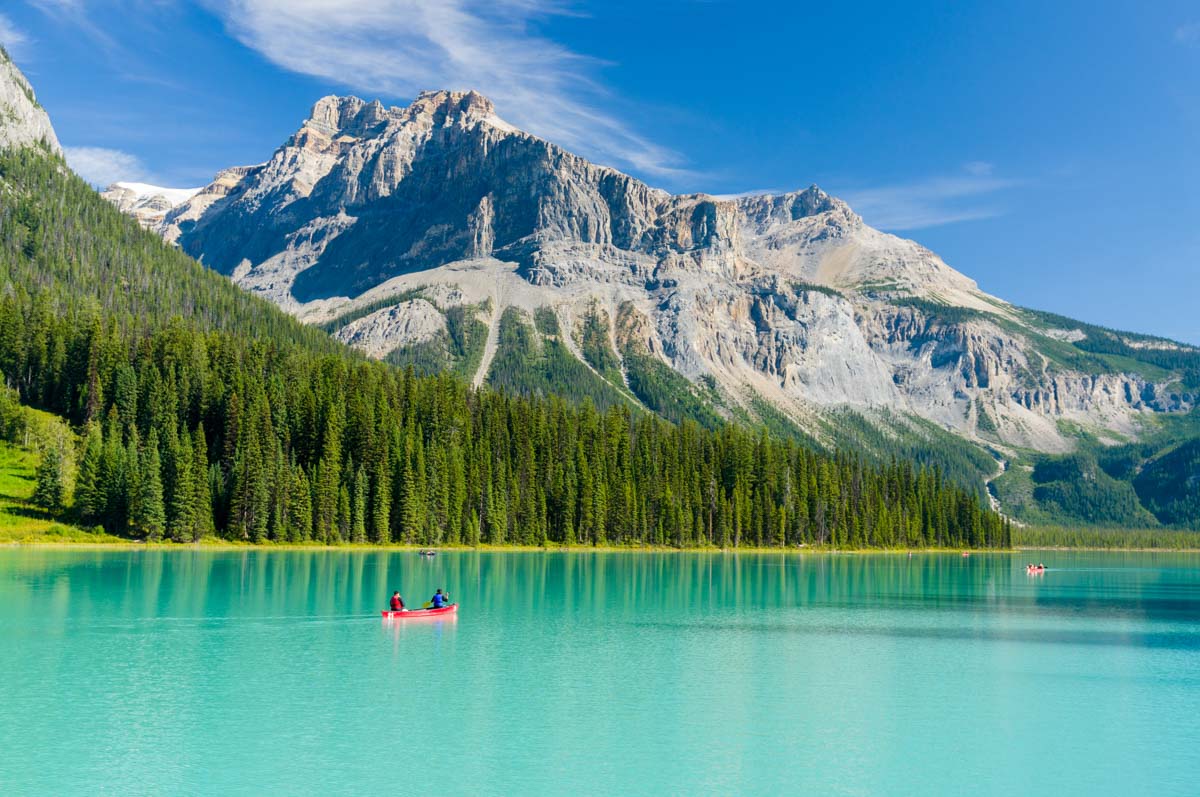
Takkakaw Falls is the second highest waterfall in Western Canada and is a super spectacular spot to head to in the morning. The access road is only open from June through early fall, so unfortunately if you are headed to the Canadian Rockies in the spring, you won’t be able to see the fall at that time.
To get to the end of the falls, you’ll need to take a trail, which is only ~1.5 kilometers. Once you arrive at the base of the falls, you can stand close enough to feel the cool water sprinkle your face. Cool (literally), huh?
Next, head to Emerald Lake, a stunning alpine lake in Yoho not far from Field. Here, the f ine sediment from the glaciers sits in the water and gives it its characteristic emerald color after which it is named. You can rent a kayak here or hike the 5.3 kilometer loop trail around the lake!
Afternoon: Lake O’Hara
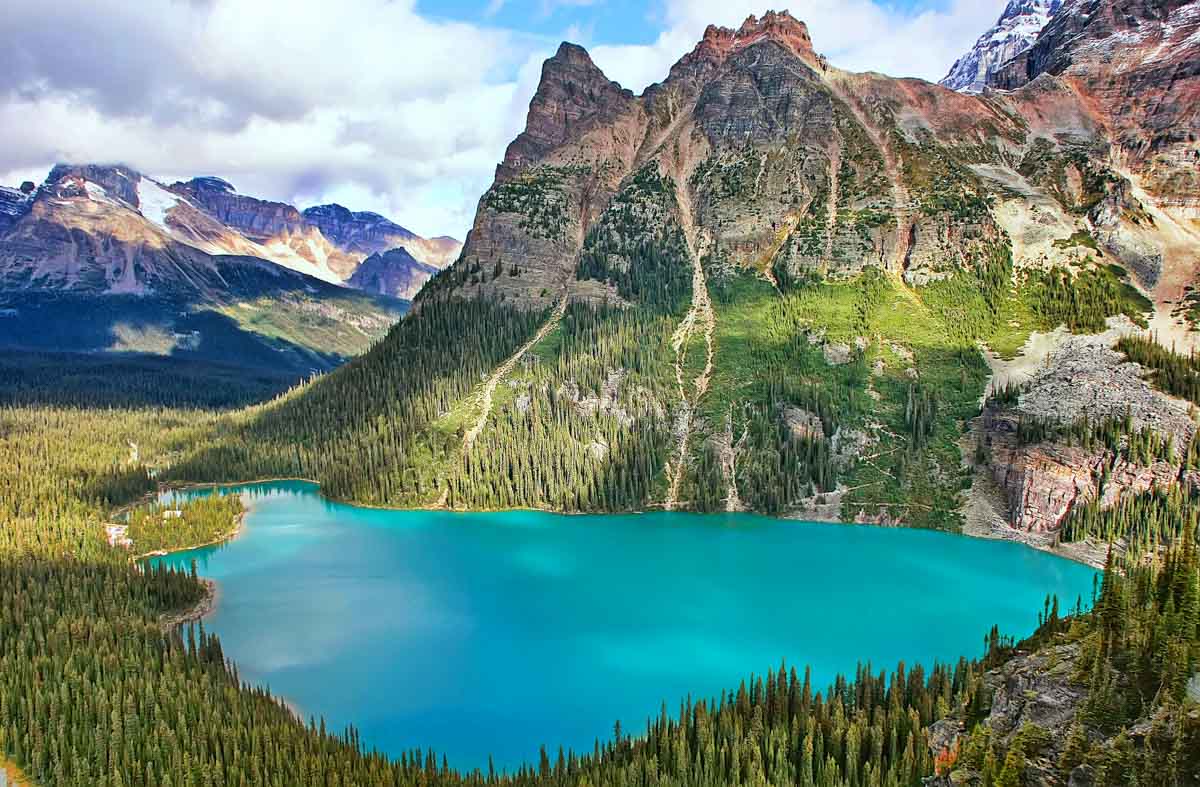
Lake O’Hara is an alpine lake, and is one of the main sights in Yoho National Park. It’s definitely worth the long journey it takes to get there.
Situated at 2000m in elevation, you need to hike up a trail in order to get there (but you may be able to pay to take a shuttle down back to the parking lot during the summer months. Note, however, that this is not a guarantee!)
Advance reservations are required to go up to the lake, however, you are still able to hike the 11 km up to the top even if you weren’t able to get a bus reservation.
If you don’t get a bus reservation, you will have to hike back down the 11 kilometers you came (which means this will easily turn into a full-day excursion!). However, if you are able to take the bus back down, plan to be around Lake O’Hara for 4-5 hours. (If you have to hike both ways, plan for 6-7 hours.)
Evening: Dinner in Banff
For your last dinner, you’ll head back to Banff’s town center. You can eat at one of your favorite restaurants from before, or opt for a bit more of a “fine dining” experience at one of these Banff local restaurants:
Saltlik – Enjoy a nice quality steak dinner at one of Banff’s premier steakhouses. There is a separate bar area for drinks. The restaurant has a great selection of side dishes. Try the mac and cheese!
The Bison – This picturesque dining establishment features wood-fired inspired food, and their dishes are LITERALLY to die for. For meat lovers, choose between ribs, bison, duck, or trout. Vegetarian dishes are also available. And, of course, before you leave Canada, you’ve got to try their poutine!
You’ll be back in Banff for your final night of this Canadian Rockies itinerary, so enjoy it! Again, here are my recommendations – the same ones as before – for a few popular places to stay (or you can read this post for the full list, from luxury lodges to budget hostels):
Day 10: Return to Calgary
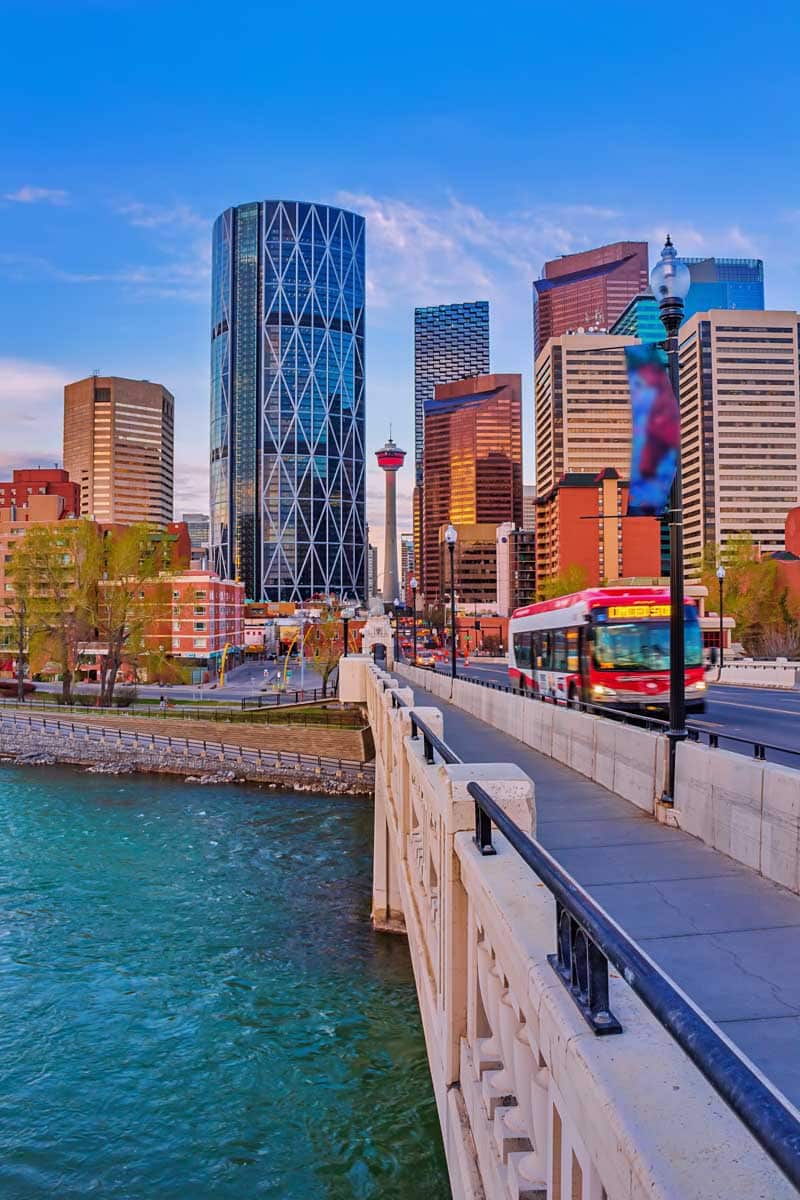
It’s the last day of your Canadian Rockies itinerary, and sadly you’ll have to return back to your normal life soon. But before you go, you’ll spend one last blissful morning amidst the peaks and forests before heading back to Calgary.
Morning: Sunrise at Vermilion Lakes
Wake up early (before 6 AM) and head to Vermilion Lakes for your final morning in the Canadian Rockies. This is THE sunrise spot, and we left this for the last day so that you can enjoy one last morning of tranquil mountain magic before heading back to the real world (*sobs*).
Even on misty mornings, the sunrise here can be quite beautiful, so I’d recommend going even if it looks cloudy outside. Park in the parking lot at Vermilion Lakes and walk into the shore area, where you can sit and enjoy a warm drink or just listen to the sounds of the morning.
It’s here where you’ll bid farewell to Banff and the Canadian Rockies and all of your amazing memories you’ve just made over the last 10 days. From personal experience, I will say that this place really sticks with you, forever. The landscapes of the Canadian Rockies have truly made an impression on me that my heart will always yearn for.
Returning to Calgary
You’re finally reaching the end of your Canadian Rockies road trip. (Sad face emoji!)
Depending on what time your flight is scheduled to depart, you’ll need to make your way back to Calgary. When you’re ready, dry your eyes and hop in the car, taking the Trans-Canada Highway all the way back to the city. Drop off your rental car wherever you picked it up, head back to the airport, and bid those incredible mountain vistas adieu .
Feeling some serious post-Rockies depression already? Well then you’ll just have to plan another trip up here! There are LOADS MORE things to do in the Canadian Rockies than we had time for in this itinerary, and until then, you can drift off to sleep at night with visions of the snow-capped rocky peaks and magical turquoise lakes dancing around in your mind…
Other Places to Visit on a Canadian Rockies Itinerary
If you’re one of the lucky ones who actually has more time in the Canadian Rockies than 10 days, read on for a few more areas you can add to your Canadian Rockies itinerary:
Waterton Lakes National Park
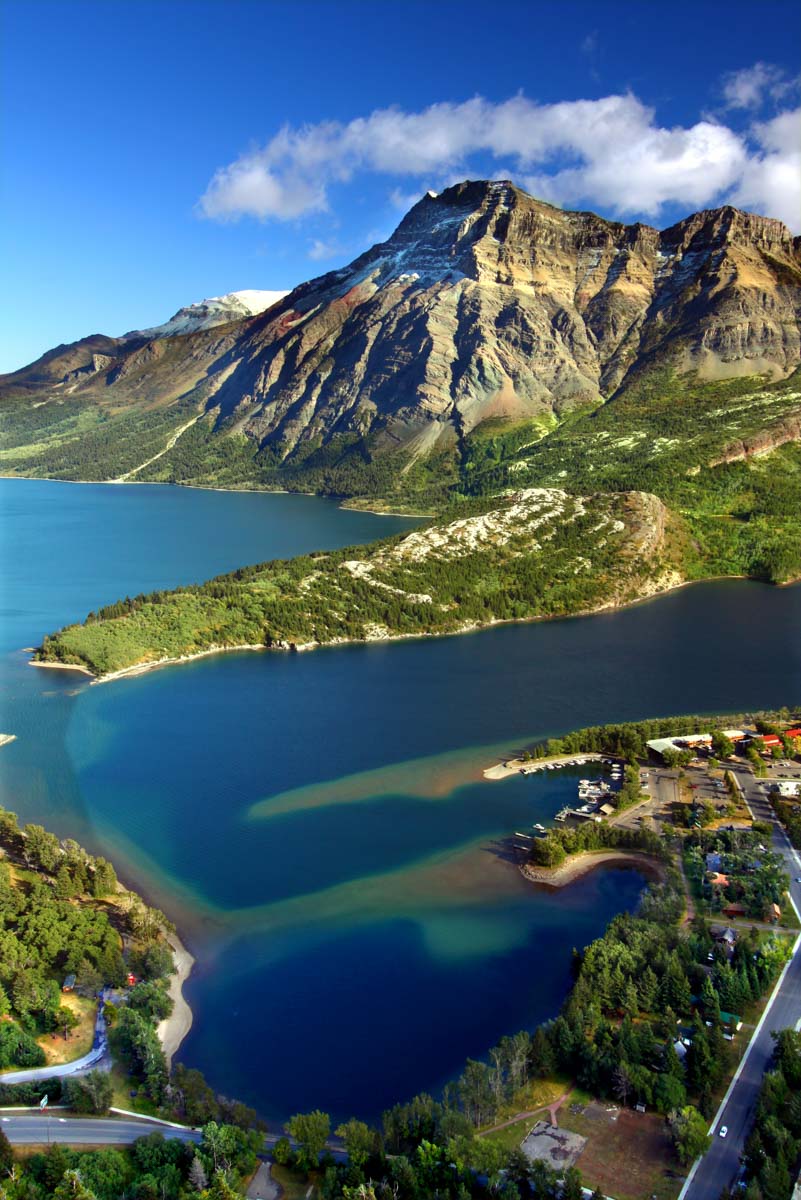
Waterton Lakes National Park (along with its US neighbor, Glacier) is a UNESCO World Heritage Site and International Peace Park. This Alberta national park consists of a giant glacial lake system surrounded by mountains, and it rests on the Canadian border with Montana. Its a bit far from the rest of the parks on our itinerary, but it’s definitely a worthwhile addition to any Canadian Rockies road trip!
Like its northern neighbors, Waterton Lakes is full of amazing, spectacular views and hiking trails, including its famed Triple Crown hiking challenge. To learn more about Waterton Lakes and the hiking trails there, visit our complete guide:
Kootenay National Park
Kootenay National Park , located in British Columbia, is another lesser-known Canadian Rockies national park. Located southwest of Banff National Park, you can experience all kinds of beautiful hiking trails here, with amazing, breathtaking alpine lakes and mountain passes to explore. It’s not far from the rest of the places on this Canadian Rockies itinerary and would be the perfect addition if you have a few extra days to spend in the region.
I haven’t actually personally been to Kootenay National Park, but this guide to 25 things to do in Kootenay is an excellent starting point if you’d like to explore the area.
Additional Canadian Rockies Travel Resources
Phew! If you’ve made it this far, congratulations. You’ve literally gotten your hands on all of the information you need for all of the stops on this itinerary. However, we do have even MORE detailed guides on each of the stops in the Canadian Rockies on our website and beyond.
The below resources (both our guides and the external ones) are all really helpful for learning more about the attractions at each stop on this itinerary, or for adding activities and extending your trip.
Have a look and remember — these are ALL just our recommendations. Doing more research on the area enables you to make your Canadian Rockies itinerary the perfect one for YOU!
Our favorite (external) Canadian Rockies travel resources:
- Lonely Planet: Banff, Jasper, and Glacier National Parks – If you’re into physical guidebooks to take with you when you travel, this is the ultimate companion to our Canadian Rockies itinerary. The Lonely Planet guide to Banff, Jasper, and Glacier has all the information you need to get around, find a nice place to stay, and book tours for the adventures you want to try.
- Moon Canadian Rockies – Another comprehensive print guidebook about Banff, Jasper, and more! It never hurts to have more than one, right?
- Parks Canada Website – This website is the ultimate resource for up-to-date information about the national parks in Canada. Here, you can find out about road and trail closures, construction occurrences, weather warnings, and more.
- To Banff and Beyond – A wonderful Banff-focused travel blog which includes several tips, hikes, and activities to do in the Canadian Rockies area!
10 Days in the Canadian Rockies Itinerary: Read Next
All of our own guides, tips, and misadventures in the Canadian Rockies
- Incredible Hikes in Canmore
- 23 Incredible Things to Do in Banff National Park
- Where to Stay in Banff National Park
- 17 Spectacular Things to Do in Jasper National Park
Love This? Save and Share on Pinterest
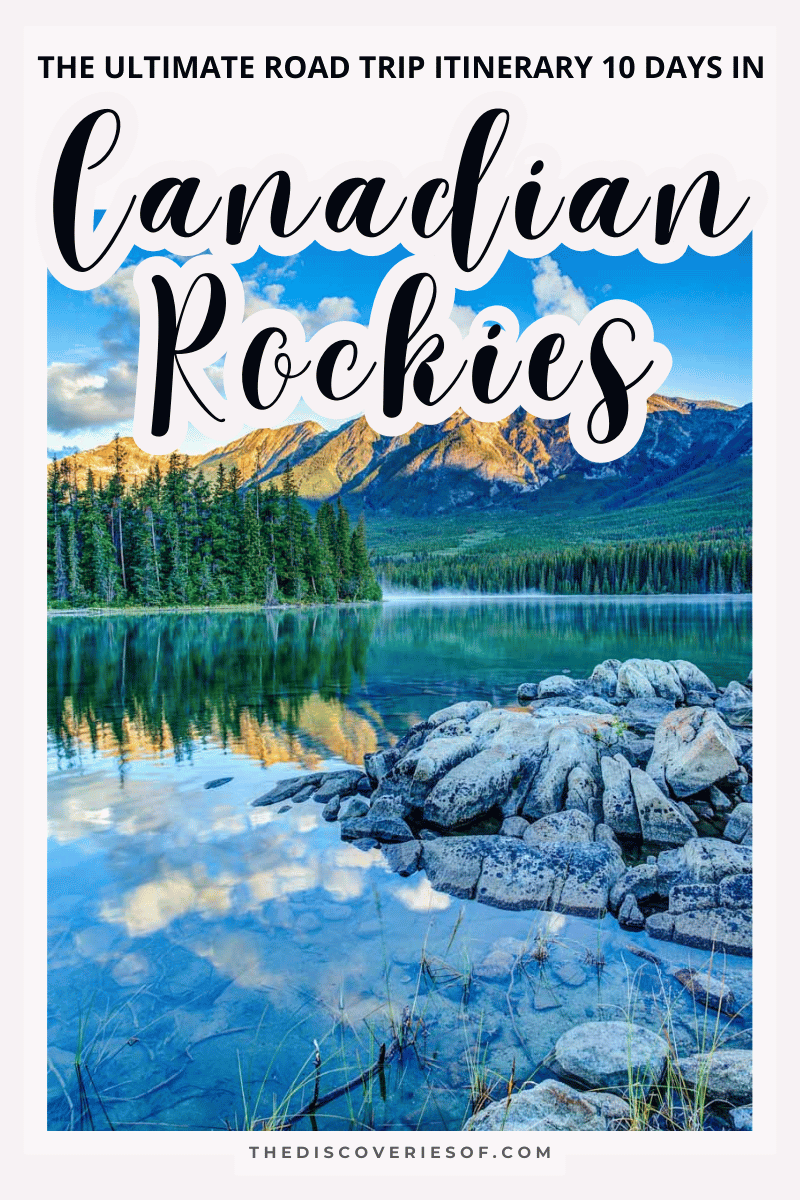
I’m Kay. I’m originally from small town Virginia, but have moved all around the East Coast and the United States for basically my entire life. I spent my childhood days blissfully wandering through the Blue Ridge Mountains, rolling in leaves, playing in creeks…you know, the usual overly adventurous 5-year-old stuff.
But those early years spent outside gave me a real problem: I’m now an adventure addict. Basically, if I’m not at my computer banging out articles or photos, I’m probably out hiking, biking, or camping somewhere beautiful.
Related Posts
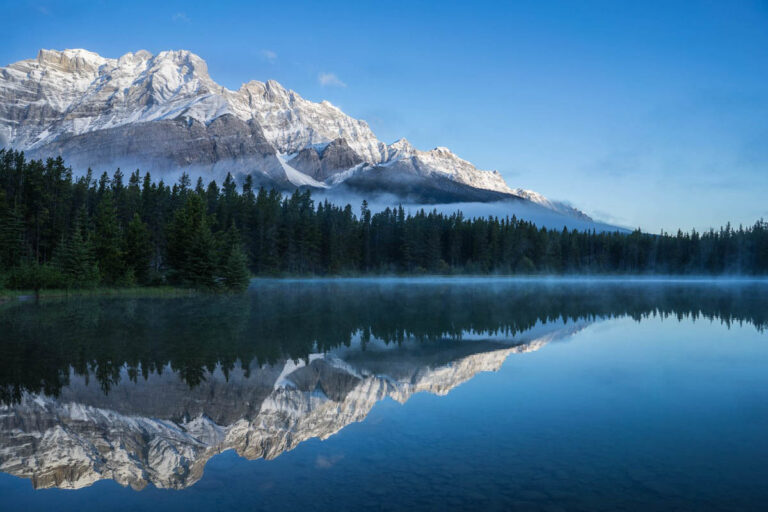
2 Days in Banff – A Rather Brilliant Banff Itinerary
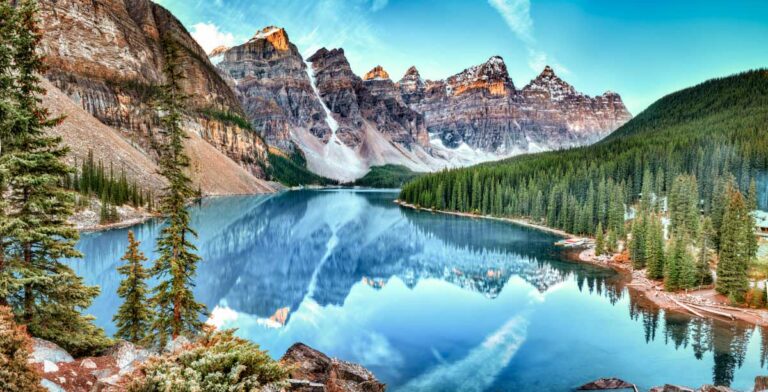
The Best Time to Visit Banff National Park
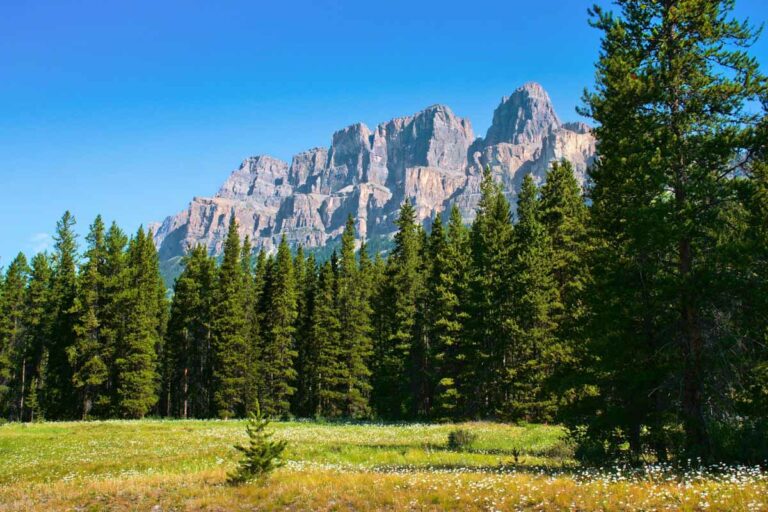
The Best Things to do in Canada: 27 Unique Adventures Up North
Hey – What an amazing blog, thank you so much.
If you had an extra 3-4 days, where would you spend them? Additional destinations or adding more days to places like Banff and Jasper?
Thank you SO MUCH (!) for putting this together. I am planning a canadian rockies road trip with my dad this summer and this is perfect. I honestly dreaded planning a bit because I know how much there is to do / see and to think of but this just made my life so much easier and now I can’t wait!
Leave a Reply Cancel reply
Your email address will not be published. Required fields are marked *
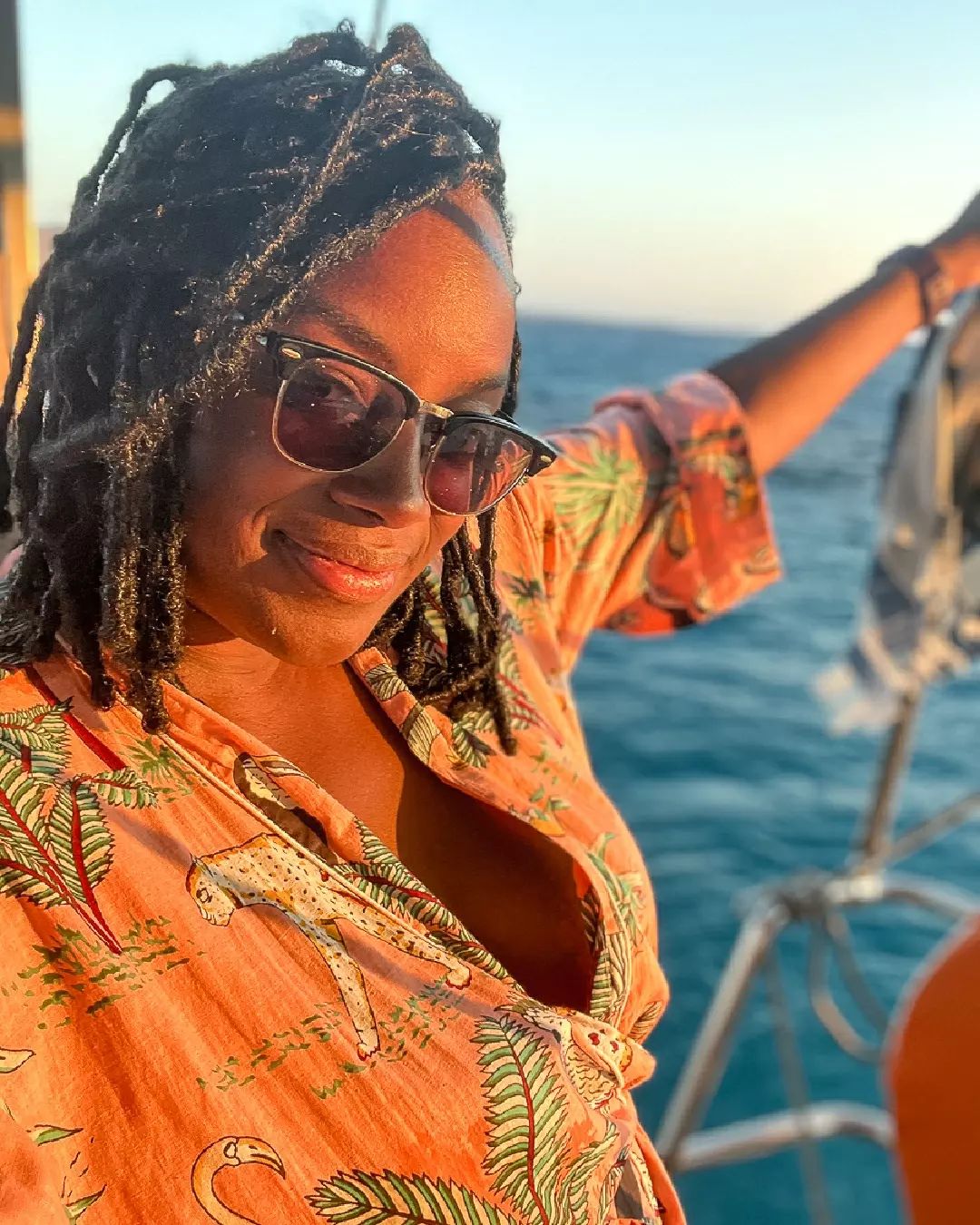
Follow me on Instagram for travel inspiration, tips, and guides.

Two Weeks In The Canadian Rockies – An Epic Road Trip Guide for Motorhome Travellers and Nature Lovers (2024 Update)
April 11, 2023
Table of Contents
Thousands of kilometres of breathtaking mountain valleys and icefields three times the size of Paris, as well as more unique photography locations than you can visit in your lifetime. That’s what awaits you on my road trip itinerary around the Canadian Rockies.
Canadian Rockies Two-Week Road Trip Overview

What type of traveller is this Canadian Rockies road trip perfect for?
Do you like to venture onto backcountry trails? Are you up for some hiking adventures? This Canadian Rockies road trip is designed for those who love to be outside and don’t plan on seeing the Rockies through the window of their car.
This road trip is mainly designed for Motorhome travellers, but don’t worry. You can easily follow along with a regular car and book accommodation. I included hotel recommendations for each destination.
When is the best time to do this road trip?
The ideal travel time for this Canadian Rockies road trip is between June and August when the nights are warm(ish) and the campsites are operating.
Though campsites reopen in May and remain open until September, during shoulder seasons, I recommend that you opt for hotel stays. The nights can still be freezing in May or September.
Finding an open campsite may be difficult any time before May or after September. If your main objective is to hike, aim to go between mid-June and mid-October.
Where does this road trip start and finish, and what area s does it visit?
The itinerary starts and finishes in Calgary – the nearest international airport hub, and takes you through Banff National Park, along the Icefields Parkway and up to Jasper National Park.
From Jasper, you will return through Yoho National Park and finish in Kananaskis Country Provincial Park near Canmore.
How much time do I need to complete this Canadian Rockies road trip?
The optimal time for this road trip is 14 days, but it can also be shortened or prolonged depending on the time you have planned for your holidays. However, you need at least seven days to get a good taste of what the Canadian Rockies offer.
More Canadian Rockies itineraries

Are you travelling from Vancouver? You may find my other custom itineraries helpful:
- Vancouver to Calgary through Canada’s Epic Landscape or
- The Ultimate 3-week road trip across Western Canada, starting and ending in Vancouver
The Canadian Rockies road trip map
Above, you can find the map of the whole itinerary. If you click on the top left of the map, you will find separate layers marking the route, photography spots, hikes, points of interest and campsites.
How to use the map?
Click the check box next to the layer’s name to hide and show different layers. You can also click on the icons on the map to see the names of the places I have marked.
I will be talking about them as I break the itinerary down daily.
Canadian Rockies Road Trip: The Logistics

What’s the best way to travel around the Rockies?
I’ve spent many months travelling through the Rockies in my minivan, which I converted into a tiny motorhome.
Understandably enough, if you choose Canada as your holiday destination, you won’t have time to do what I’ve done. In this case, if you want to follow this itinerary, you must rent a car or a motorhome.

Rent a Campervan with Motorhome Republic
There is a wide array of campervan rental companies in Calgary, and going through them all to find the best option will almost certainly give you a headache. To ease up your planning, try the Motorhome Republic.
It’s an excellent RV search engine that will help you choose a camper van tailored to your needs by scanning the top Motorhome rental companies in the area.
TIP! The rough estimate of this itinerary is 1500km. You must know this when booking your campervan, as you must prepay for your kilometres.
Rent a Compact Car with Discover Cars
This itinerary is optimised for camper vans but could quickly be done in a regular car, providing you bring camping equipment or stay in hotels.
If you are looking to rent a compact car , try Discover Cars, the World’s best car rental search engine.
Park Entries and Fees: National Parks Discovery Pass
This itinerary crosses several national parks, including the famous Banff and Jasper. Visiting a Canadian national park requires paying entrance fees.
If you are travelling for more than seven days, consider investing in a Discovery Pass, which is cheaper than buying daily passes. For example, the family/group pass covering up to seven people in one vehicle costs CAD$151.25 per year.
To avoid waiting in lines, purchase the pass online on the Parks Canada website before your trip. You can also buy one at the entry toll gate just a few kilometres past Canmore at the entrance to Banff National Park, which you will be crossing on this road trip.
TIP! Make sure to have your pass on display in the car at all times.
Information about staying at Parks Canada campgrounds

An ample variety of campsites along the spots listed in this itinerary. Most of them have been equipped with toilet and shower facilities and plug-in options for those travelling in bigger motorhomes requiring re-charging.
The cost of staying at the campsites in 2024
The cost in the Province of Alberta is usually around CAD 35 per site per night. Each site is permitted to hold up to 6 people and a maximum of two cars.
There’s an option of buying a fire permit for an additional fee. The permit also includes the firewood, so it’s an easy decision. What’s a campsite without a fire, right?
Tip! If there are only two of you and you don’t hold a reservation, consider asking other travellers in the check-in line if they want to share a site and, subsequently, the cost. I did this a few times when the campsites were full.
When should we book the campsites in the Canadian Rockies in 2024?
If you travel during the peak summer months (June to August), you will find it very handy to book the sites well in advance, especially in the more popular areas like Banff, Lake Louise, or Jasper. After all, tourism has boomed here in recent years.
All bookings can be made on the Parks Canada Reservation Website , which usually opens in March.
Upon arrival at each campsite, you will be briefed about wildlife awareness and the measures you will have to undertake to keep wildlife safe.
Stocking up on groceries before starting the road trip
Once you’ve arrived at Calgary International Airport, pick up your car or campervan and head to the closest supermarket.
Although there are supermarkets in all of the road trip destinations, Calgary has the cheapest prices, so it’s better to stock up before you hit the road. Besides, once you get it over with, you will have more time to enjoy your holidays!
14-day Canadian Rockies road trip: day-by-day breakdown
When you become acquainted with your new home on wheels for the next couple of weeks, it’s time to hit the road. The main road from Calgary to the mountains is Trans Canada Highway 1, which will take you to your first destination – Banff.
Day 1-4: Banff and its surroundings
- Distance from Calgary International Airport : 143 km / 89 mi
- Travel time: 90-120 minutes

Many consider Banff the main hub in the Canadian Rockies. Its dream location, coupled with its incredible geological features, makes it a top hit on our road trip.
Its quaint high street gets pretty busy in the summertime, and so do many of Banff’s famous photography spots.
Best things to do in and around Banff
Sulphur mountain.

A series of relatively steep switchbacks for 5.5km (3.4 mi) will take you to the Upper Gondola Terminal on Sulphur Mountain. You’ll ascend 700m (2,300ft), which will take around 1-2 hours one way.
The views of Mount Rundle and Cascade Mountain are well worth the effort. If you are not up for hiking, you can take the gondola up and down instead. Whether you choose to hike or ride the gondola, you are up for the best views of Banff from above.
Banff Upper Hot Springs
The Banff Hot Springs, conveniently located near the lower gondola terminal, are a treat after a long day of exploring.
They are run by Parks Canada, and at around $17.50 / person, they’re a bargain. If you decide to hike up Sulphur Mountain, you can treat yourself to the hot springs afterwards. It will be a perfect end to a long day.
Join a lake cruise

A cruise along Lake Minnewanka is an excellent way to see the Fairholme Range and the iconic Mount Inglismaldie. They depart every 30 minutes from the boat dock near the car park, and prices start at 65 CAD per person.
Practice your photography skills.

Banff is any photographer’s wet dream. Amateurs, hobbyists, and professionals flock from all over the world to take their own version of photos from locations that have already been photographed to death.
The most extensive advice I can give when visiting photography spots in Banff National Park is to make the most of blue hour, golden hour, sunrise and sunset.
Bow Valley Parkway

Reserve one of the days you spent in Banff for the Bow Valley Parkway. It’s a beautiful stretch of road which hides many natural gems.
What to see along the Bow Valley Parkway
The Bow Valley Parkway is a mini version of the Icefields Parkway , but it still packs one hell of a punch. Although it’s only a 51km (32 miles) stretch of road, you can easily spend a day there.
Johnston Canyon

Since your time is limited, I highly recommend visiting Johnston Canyon. Make sure to get there early.
The morning light coming through the trees and shining upon some waterfalls in the early morning hours is a sight to behold—provided the weather is good, of course!
One of the best ways to explore the Bow Valley Parkway and Johnston Canyon is on an E-bike and walking tour with an experienced guide.
My favourite time of the year for visiting Johnston Canyon is in the winter when all the waterfalls are frozen, giving an impression of being in a fairytale ice castle. You can join a guided ice walk across the Johnston Canyon in winter.
Morant’s Curve

At first glance, it seems like just some train tracks running through a forest, but the famous Morant’s curve has become one of the photography hot spots. If you are patient enough to wait for a train to pass for some long exposures, you are guaranteed a great shot!
Please note that From March 1st to June 25th, travel is prohibited between 8 p.m. and 8 a.m. on the 17-kilometre parkway from Johnston Canyon Campground to the Fireside Picnic Area. This is to ensure the area remains a high-quality home for wildlife. Remember always to keep your eyes on the road at all times.
Accommodation in Banff
Once you arrive in Banff, you can stay at these campsites for the next few days.
My favourite, due to its location and the beautiful views it offers, is the Two Jack Lakeside campground . However, to be closer to the town centre, you should go to the Tunnel Mountain Campground .
If you would like to be in a more remote location , another great campsite to consider is the Johnston Canyon campground along the previously mentioned Bow Valley Parkway, which is a 30-minute drive from the township.
Banff International Hostel
What guests loved about it:
- Great loft space
Moose Hotel and Suites
- Beautiful decor
- The welcoming smell of the fireplace
For Luxury Fans
Rimrock Resort Hotel
- Unparalleled views
- Excellent attention to detail
Day 4-6: Lake Louise
- Distance from Banff: 57 km / 35 mi
- Driving time: 40 minutes

Although Lake Louise is a popular winter skiing destination, it is also famous in the summer for two big reasons: Lake Louise and the one and only Lake Moraine.
There’s not much directly at Lake Louise Village, but it’s an excellent central hub to explore the beautiful surroundings.
Things to do in Lake Louise
Lake Louise is a few minutes’ drive away from Lake Louise Village. I hope I am not confusing you here. The village and the lake have the same names. The lake’s shoreline is a perfect location for the countless hikes in the area .
If you don’t feel comfortable hiking alone, you can book a guided hike around Lake Louise.
Lake Louise lakeshore

The 4km (2.5 miles) 1-hour return flat lakeshore stroll gets you away from the hustle and bustle of the world-famous Chateau Lake Louise, built right on its shoreline, and gives you the perfect view of the surrounding mountains and glaciers.
The Plain of the Six Glaciers

Further along this path is the way to the much more impressive Plain of the Six Glaciers. It’s a longer 11km (6.8 miles) uphill 4-hour return, but it’ll transport you to some of the most pristine wilderness Canada has to offer.
You’ll be blown away by the towering peaks and frozen glaciers. Make sure your camera has enough battery and take some cash, too, because there’s a teahouse on the way there.
Discover Banff Tours runs guided hikes on classic trails around Lake Louise, including the Plain of the Six Glaciers.
Visit Lake Agnes Teahouse

If you’re feeling more energetic than the Lakeshore but can’t tackle the Plain of the Six Glaciers, the hike to Lake Agnes is a good middle ground. It’s a 7km (4.4 miles) uphill return that should take around 3 hours.
You’ll be treated to the view of Lake Agnes at the top, the sensational Mirror Lake, and several vistas overlooking the Bow Valley on the way.
Again, take some cash because there’s another tea house up there – the world-famous Lake Agnes Tea House.
Get a glimpse of the Moraine Lake

Moraine Lake is the most famous Canadian lake and one of the many renowned postcard pictures of the Canadian Rockies . Its turquoise waters glisten in the sun and are incredibly framed beneath the famous Valley of the Ten Peaks.
The Lakeshore stroll is one of my favourites as it offers fantastic views with minimal effort. It’s a 2.4km (1.4 miles) flat return, which only takes 40 minutes.
IMPORTANT (NEW IN 2023 ): Due to the high traffic volume, the road to Lake Moraine will stay closed for the entire summer season. Only shuttle and commercial buses will be able to bring visitors to its shoreline. Prebook your shuttle directly with Parks Canada or a private company I linked below.
Hike the Larch Tree Valley

Another one of my favourite hikes in the Canadian Rockies (especially during September) is the Larch Valley Trail. It takes you 400m above the shimmering Moraine Lake through the forest amongst all the Larch trees before opening out amidst the valley of the Ten Peaks.
If you’re there at the right time of the year (early fall), you’ll be amazed at all the different colours, but the surrounding peaks are enough to leave you speechless.
It’s a 10km (6 miles) 4-hour return to the Minnestimma Lakes and a 14km (9 miles) 6-hour return to the Sentinel Pass across the Larch Tree Valley.
Accommodation in Lake Louise
There are two campsites at Lake Louise: Lake Louise Tent and Lake Louise Trailer. Both have electric fences encircling the area to deter the abundant wildlife.
HI Lake Louise Alpine Centre Hostel
What guests loved about it
- Very friendly staff
- Great for meeting other travellers
Paradise Lodge & Bungalows
- Great location, a 15-minute walk from Lake Louise
- Rustic lodge feeling
Chateau Lake Louise
- Superb location right on the lake
- Choice of restaurants
Day 6-8: Icefields Parkway
Lake Louise Village marks the start of the Icefields Parkway (93N). This is the main drag connecting Lake Louise and Jasper, and you will spend your next two days there.

The 232 km stretch of road from Lake Louise in Banff National Park to Jasper encompasses what I consider to be the heart of the Canadian Rockies.
Travel past monumental glaciers, icy blue lakes, enormous mountains , and stretches of road that simply have to be seen to be believed. There are plenty of stops along the Icefields Parkway, so I believe you should spend at least a couple of days exploring it.
I have driven up and down this road countless times and still haven’t experienced everything!
This brilliant smartphone audio tour between Lake Louise and Jasper lets you learn everything about the incredible Icefields Parkway .
Watch as your audio guide points out must-see sights, attractions, breathtaking mountains, and glaciers you pass along the journey. Learn about the area’s early pioneers, animals, geography, and the historical events that led to the highway’s creation.
Accommodation on the Icefields Parkway
HI Rampart Creek Hostel
- Clean and functional kitchen
- Great value for money and location
Sunwapta Falls Rocky Mount ain Lodge
- Friendly and dedicated staff
- A rustic place far from the madding crowd
Day 8-10: Jasper National Park
- Distance from Lake Louise: 232 km / 144 mi
- Driving time: 3 hours (without stopping)

At the end of the Icefields Parkway, you’ll end up in the townsite of Jasper, a well-located little town with plenty of things to see and do.
I would recommend staying a couple of nights here. Jasper is the central hub of many beautiful spots in the Jasper National Park region.
Best things to do in Jasper National Park
Cruise down maligne lake.

Maligne Lake is around a 1-hour drive from Jasper. A boat cruise on the lake has to be one of the best activities in Jasper National Park.
It’ll take you halfway down the lake to Spirit Island (one of many top photography spots in Jasper, NP ), where you’ll disembark and have a chance to take in the view.
Self-guided paddling trip
If you are feeling more adventurous, rent a kayak or canoe and paddle there yourself; just be prepared for a long day (26 km round trip).
If you have an extra day, you can consider staying a night at the Fisherman’s campground, accessible only by boat or canoe. This will require more organizing, though, as backcountry camping spots sell out faster than tickets to the Glastonbury Festival.
Hike the Sulphur Skyline

The Sulphur Skyline is one of my favourite hikes in Jasper National Park . It departs from the Miette Hot Springs car park, a 61 km drive from Jasper.
Head north on Highway 16 for 44 km, then turn onto Miette Road next to the Pocahontas bungalows.
Follow the Miette Road until the end, where you’ll find the trailhead. The hike offers unbelievable 360-degree panoramic views but is a steep 8km return that should take around 5 hours.
When you get down, a geothermal hot pool soak will await you.
Soak in the Hot Springs
Like the Banff Hot Springs, The Miette Hot Springs are owned and operated by Parks Canada.
They have two hot pools and two cold pools, which contain many minerals for your skin and body. If you’re brave, try the coldest pool.
If you’ve done the Sulphur Skyline hike, the hot springs are only 100 meters from the trailhead, making them the perfect place to relax afterwards .
Take the SkyTram up the Whistler Mountain

Like Banff, Jasper has its gondola. It costs CAD62.95 and offers spectacular panoramic views from the top.
You can hike up there, too, but it’s a 1000m elevation gain, so I haven’t yet attempted it. You can also hike to Whistlers Peak and Indian Ridge . They start at the upper gondola station.
Hike along the Maligne Canyon

Maligne Canyon is just 11km outside Jasper along Maligne Lake Road. The return trip is an undulating 7.4km, which should take around 3 hours.
It’s beautiful at all times of the year, but my favourite is when the snow melts at the start of summer, and the river is at its most ferocious. It’s a busy spot, but the further you get away from the parking lot, the quieter it becomes.
Get a cinnamon bun at the Grizzly Paw bakery
There are two bakeries in Jasper called the Grizzly Paw, and they make the most amazing cinnamon rolls. I spent a little fortune on those and made sure to have one after every hike I did in Jasper. I am still trying to crack their recipe but to no avail.
Accommodation in Jasper
The two most popular campsites here are Wapiti and Whistler. Both are huge and have plenty of sites.
I prefer Whistler, but both are pretty similar. Both campgrounds are close to each other and are only around 5 minutes south of Jasper’s town centre.
Jasper Downtown Hostel
- Well-stocked kitchen for self-cooking
- Great central location
Jasper House Bungalows
- Great location right on the banks of the Athabasca River
Fairmont Jasper Park Lodge
- Heated pool, hot tub, and spa
- Location and scenery
Day 10-12: Yoho National Park
- Distance from Jasper: 260 km / 162 mi
- Driving time: 3.5 hours (but it will probably take a whole day)

On your return from Jasper toward Calgary turn right at Lake Louise junction on the Trans Canada Highway 1. This road will take you to the little town of Field. You will now be entering Yoho National Park.
What to do in Yoho National Park
Takakkaw falls.

An excellent half-day hike and one of the most popular in Yoho National Park. It’s a 12km (7 mi) loop that should take around 4 hours.
It will leave you in awe of its natural beauty. After all, Yoho is the *Cree word for awe. That’s a Yohosome fact, isn’t it?
Emerald Lake

Another beautiful place to photograph in this area is Emerald Lake. Just a short 15-minute drive from the campground, this photogenic lake should be on your list of things to do and see, as it’s one of the most photogenic places in the Canadian Rockies.
Visit Lake O’Hara

Suppose you are one of the lucky ones who pre-booked their bus trip to Lake O’Hara; good on you. This remote lake has a minimal visitor allowance per year, making it sought after by outdoor lovers.
I’ve been here in both the Winter and Summer seasons and compiled a separate Lake O’Hara guide . You should check it out!
*Cree is a 3000-year-old language spoken by the Cree people.
Accommodation in Yoho National Park
The best-located campsite in Yoho National Park is called Kicking Horse Campground.
Canadian Rockies Inn – Adult’s only
- Comfortable, quiet rooms
- Very welcoming and personal staff
Charlie’s Guesthouse
- Cosy and homely feeling
- Great location in the middle of Yoho Park
Cathedral Mountain Lodge
- Delicious food
- The most beautiful setting
Day 12-14: Canmore and Kananaskis Country
- Distance from Field: 105 km / 65 mi
- Driving time: 70 minutes

Canmore is where I spent the picturesque winter living in Canada, so maybe my opinion is a bit biased. Still, I find Canmore and its surroundings more beautiful than any other place on this Canadian Rockies itinerary.
Best things to do around Canmore
Hike the ha ling peak.

Ha Ling Peak is the most famous summit in the Bow Valley. From the car park down Spray Lakes Road, it takes most people 2-3 hours to reach the summit and just over one hour to descend.
The short 6km hike is quite steep, with an elevation gain of 737m (2417ft), but the views from the top are spectacular. I have done this hike multiple times, including one sunrise quest to the top.
You can either do this trip alone or join a certified hiking guide on a half-day trip to the summit.
Rawson Lake and Sarrail Ridge

The Sarrail Ridge is a moderate 11km (7-mile) 5-hour return hike that starts in Kananaskis Country near the eastern tip of Upper Kananaskis Lake. Although slightly uphill, the first half is relatively easy.
The second half is a much harder 45-degree, almost scramble to the lookout. This route, popular on weekends with Calgary locals, is tranquil during the week. It’s one of many superb hikes in Canmore and Kananaskis Country.
Look for moose near Mount Engadine

Engadine Lodge and the Moose Meadows is a 38km drive (1 hour) down the Spray Lakes/Smith Dorien trail from Canmore. It’s a beautiful place for a nice cup of tea or a slice of cake in the afternoon.
The meadows surrounding it are picturesque, with little streams flowing through them. As the name suggests, it’s also an excellent spot to see moose. The meadows are among the best spots in the Canadian Rockies to spot wildlife.
Practice your photography

Canmore and Kananaskis, just like any other area in the Canadian Rockies, have some incredible photography spots.
They range from mountain peaks to alpine lakes and will inspire your soul. See how many of my favourite photography locations in Canmore and Kananaskis you can fit into your trip!
From Canmore, it’s just 120km or 1 hour and 15 minutes to Calgary International Airport. Follow the Trans Canada Highway back east and follow the signs for the airport.
Accommodation in Canmore
I recommend the Bow River Campground and the Spray Lakes West Campground near the Spray Lake Reservoir, with the latter being my preferred choice.
Spray Lakes site is around a 20-minute drive from the town centre on the Smith Dorien highway (or more like a well-maintained gravel road). The views next to the campground are some of the best you will get.
However, if you want to be closer to the town, Bow River Campground should be your choice. Do bear in mind that it’s a bit close to the highway and maybe a bit noisy.
Canmore Downtown Hostel
- Well-designed spaces
- Very clean and well-organized
Tama rack Lodge
- Well-appointed, clean, and modern
- Beautiful and well-stocked units
The Malcolm Hotel
- Fantastic views from the pool
- Very comfortable beds
How can this two-week Canadian Rockies itinerary be shortened?
I get asked this question quite often. I get it; unfortunately, it can be difficult for some to carve out a full two weeks of holidays to travel up and down the Rockies. Here are a few ideas for making this road trip plan shorter.
- Connect the days spent in Canmore with the days spent in Banff. They are only a 20-minute drive apart. That way, you can save yourself a couple of days.
- Don’t stay overnight on the Icefields Parkway. While I highly recommend it, don’t feel bad about it if you don’t have a spare day. You can spend the whole day driving from Lake Louise to Jasper and then another day when moving back. This will already give you almost two full days on the Icefields Parkway.
- Cut out, Yoho National Park. While impressive, you must face that you can’t see everything! I spent 15 months in the Rockies and still feel like I only scratched the surface. It’s better to take it slow than to try and see it all!
Support my website!
Hi Reader! If you found any of my articles about the Canadian Rockies useful please consider using the affiliate links below (at no extra cost to you) when booking your holiday. Thank you
- Reserve your hotel with Booking.com
- Book your rental car with Discover Cars
- Find your perfect campervan with Motorhome Republic
- Book your tours with Get Your Guide
- Buy your outdoor gear with Backcountry.com (US readers)
51 thoughts on “Two Weeks In The Canadian Rockies – An Epic Road Trip Guide for Motorhome Travellers and Nature Lovers (2024 Update)”
Hello Marta, thank you for putting this blog together. Amazing gem of information! I am planning to visit western Canada for 2 weeks and now I am in the middle of a decision and I need help :). Which route should I choose? Vancouver – Calgary or Calgary-Calgary? I really love hiking in nature (so I guess it would be better to have more time in parks near Calgary), but I also heard that Vancouver and Whistler are amazing….
Hi Petra. Thanks for your great feedback. If you want my honest opinion I would say go for Calgary to Calgary. Vancouver to Calgary is a long distance and I am the type of traveller who prefers to travel less and have more time to hike. You could even plan one of multiday hikes through the Rockies during your trip. There are so many amazing hikes in the Rockies that a lifetime won’t be enough to do the all. Focus on one area instead 🙂 Yes Whislter is nice but it doesn’t beat the Rockies.
I travel with a miniature aussie, 19 lbs. Can she come with me on Park shuttles or buses? like Lake O’Hara or Lake Lorraine?
Hi Teya. It really depends on the area. Lake O’hara area is restricted to dogs at it is very fragile alpine and wildlife environment. Parks Canada shuttle to Moraine lake allows dogs but they need to be in a carrier and fit onto owners lap. Check the FAQ section in this post https://parks.canada.ca/pn-np/ab/banff/visit/parkbus/louise
Hello, thank you for this amazing blog. One question. I am planning to arrive at Calgary by September 27th. Do you think I can do this 14 days itinerary by then? Ending around 1-12th of October. By that I mean, there won’t be places closed due to snow or being end of season? Please do let me know!
Hi Chae! Thanks for your feedback. Yes you can still do this itinerary at the start of October. Moraine lake usually closes in Mid-October and that’s kind of the cut off time for the hiking tourists. The nights do get cold already but hiking is still possible. Some peaks might already have some snow on them, but this can generally happen even in the summer season when the temperatures drops. The snow in the early season never lingers for too long and disappears really quickly. With that said you should always monitor the weather before heading out into the mountains. I hope that helps.
Hi Marta, Thank you do much for so detailed advice for 2-3 week road trip in West Canada, especially who want to use campsite in July, August. My plan is nearly 3 week from Vancouver (we will flight from Vietnam to Vancouver that’s halfway of the earth 🙂 We have 8 member (1 below 12) in a rented van, we dont know how we can gather, use only one campsite for 8 while the rules for up to 6 persons. We can book serviced camp or bring tents, either will best choice? Can we pay extra 1 adult and 1 kid via Parks Canada online? Or should we book 2 campsite and use 1? I read repeatedly your posts to make the plan and book along with your guidance!!AGain thank you that much!!!
Hi Angelina. Thanks for visiting. Since you have 8 people in the van I presume you are travelling with tents (I don’t really understand what you mean by saying we can book serviced camp). Yes there are rules in place when it comes down to how many people can be on one campsite, mainly so the facilities don’t get overloaded. You should book two campsites and you also should be asigned to campsites that are next to each other. This isn’t really a big deal and you still will be all able to hang out together on one of the sites, but sleep in separate tents on two campsites. It’s not like they are fenced off from one another or anything. You will be within each other sight. I hope that helps.
Hi Marta, we want to travel light but still want to experience camping site, and we found out all equipped camping in Two Jack Main are fully booked or unlaunched to be booked, is there any campsite provide equipped camping nearby?Or should we wait till May to book for late July trip?Thank you alot for you advices!
As far as I understand the all equipped camping still requires of you to bring your own sleeping bags which would be a lot of hassle to do if you are travelling from vietnam. I understand that you would like to try camping but ask yourself if it is really worth the effort. As for reservations I am afraid it all comes down to keeping your hand on the pulse in order to not miss the dates when the reservations open.
Wow, I really liked your Rockies road trip guide, I plan to visit them a few times during my one-year stay in Canada, I already passed by from Calgary to Kelowna and spent 2 nights at Canmore/Banff three weeks ago. Although, I will visit them again at the end of the summer to see the beautiful blue colour of the lakes. My family is coming to travel to Canada, they are arriving in Vancouver on April 26th and leaving Vancouver on May 11th, I would love to do the Rockies Mountains with them in RV during this time. I hope the spring weather will be ok, that is not what you are recommending (mid-June to mid-October) but that was the only period they could come.
Hi Louis. Thanks for your great feedback. I am sure your family will love the road trip regardless. Whilst May is not the best time for hiking, there are still plenty of spot to see and visit on a road trip from Vancouver to Vancouver. By the way I have a dedicated Vancouver to Vancouver Itinerary which might be worth for you to look into. I hope you and your family have an amazing time on the road trip. Happy travels!
Hi Marta ! We are a family with 2 teens visiting BC and the rockies for the first time this summer. We really like your blog, it is great ! We intend to rent a VC or motorhome to do the trip you suggested in 2 weeks from Vancouver. Can we park anywhere for the night ? Do we have to book all campsite ? What is the best way to buy the pass to enter the parc ? Do we need to know already all our itinery per day ? Thanks for your precious help.
Hi Elodie. Thanks for visiting. I am glad you decided to follow my trip. As for your question, no parking anywhere is not possible. Whilst you might be able to park free of charge outside of National and Provincial Park boundaries, within those boundaries you have to stay at a campsite. Now another thing, campsites do book out well in advance so do get on it asap. Which answers the last question, pre-booking campsites doesn’t give you much of a room for spontaneous changes in your itinerary. 10 year ago you could have just go and get a campsite on the spot, but those days are long gone. As for the Discovery Pass you can either order it online or buy them at the gates of the park or in visitor centres.
My husband and I plan to take a trip in the northwest US and on up into Canada, Alberta and BC, probably in August or September of next year. Do you have any information on dispersed camping? i’m hoping there is dispersed camping in Canada, to save money along the way. Thanks.
Hi Sue, Thanks for visiting. Camping outside of designated areas in National and Provincial Parks is unfortunately not allowed. Most of the places on this itinerary are indeed within Parks boundries. I am afraid you will have to book campsites. I hope that helps!
Your itinerary is perfect! I did this trip in 2021 with some photographer friends, staying at hotels. We followed all your recommendations here! I loved it so much, that I want to take my husband back in July 2024. We are going to rent a motor home and stay in the campgrounds. My question is this… you don’t have any campgrounds listed for the icefields parkway. Where do you recommend staying for that part of the trip? I see they have rustic campgrounds through out the icefields parkway. Do you have a recommendation?
Hi Kari. You just made my day. Thanks so much for your awesome feedback. I do have a separate post about Icefields Parkway with all campsites enlisted. I really liked the Waterfowl lakes campground because of its proximity to the lakes. Yes the campsites along the Icefields Parkway are quite basic, but your camper should provide you enough electricity for a couple of days if you arrive with a fully charged battery. I hope that helps. I would really appreciate if you used my afiliate links to book your campervan. Let me know if you have more questions!
Hi Marta, thanks for sharing a very informative blog. We are planning a 2 week motorhome trip for May 2024. We’re basically following the route from Calgary that you have described. We’re aware that many campgrounds will be closed at this time of year, but understand that there are a few year-round campgrounds. Do you have any particular recommendations or advice for Motorhoming in the Rockies in May. Many thanks in advance!
Hi Steve. Thanks for visiting. Yes there will be campsites in the Rockies that are open in May. The downside to travelling at this time is that most hikes still won’t be accessible, but with some research you will be able to do some regardless. Especially those facing South Side. Definitely pack warm clothes with you. The nights can still get very cold. Always have some windows cracked open because the condensation is relentless when outside temperatures dropped. You don’t want to wake up inside the campervan to wet blankets and clothes.
Hi Marta, I truly enjoyed reading your travel blogs. We are planning on a week trip in late August to September, if it’s doable and we’d like to start from Calgary. I would like to know which main places I can get into a hotel. Possibly 7-10 days to maximize our trip. Can you please suggest what highlights I should be concentrating on. I know that there are so many nice places to see. Are there chances on seeing wild animals a well? I hope you can suggest things for us so I can get started on making my reservations. Thank you. Hope to hear from you.
Hi Revelyn. Thanks for visiting. I know the information can get overwhelming. If you have 7-10 days I would divide them as follow 2-3 days Kananaskis country, 2-3 days Lake Louise and 2-3 days Jasper. If you need help planning an itinerary I am happy to do that. Here is the link to my travel planning services.
Hi Marta, We have our trip planned for end Aug, start Sept but only have 12 nights RV hire, where would you recommend cutting down the overnight stays. We will only be able to visit once so would love to get the most from our trip. We are more focused in the quiet than the hustle & bustle. Any help would be most appreciated. Many thanks 🙂
Hi Sally. Thanks for visiting. This is the itinerary I would follow then: Day 1-3 Lake Louise, Day 4-5 Icefields Parkway, Day 6-8 Jasper, Day 9-12 Kananaskis Country. Don’t feel bad about not staying in Banff. This is definitely the most touristy area and if you wanted to check it out anyways you can do it from Lake Louise or en route back down from Jasper to Kananaskis. Lake Louise is in Banff National Park and most of its hot spots are there not in actual Banff. As for Kananaskis I recommend staying at either the lower or Upper Kananaskis campsites. It’s a wonderful area! One of my favorites in the Rockies. Do prebook your campsites though! Let me know if I can help any further.
Hi Marta, great read thankyou, myself and my husband are due out for 3 weeks in an Rv sept 23, we plan to do a similar route to yours but over more time, jasper we are planning 6 nights, would you stay in one campsite or maybe two for change of scenery and different location? Also we would like to stop mid way on the ice field parkway but would this be possible in a 29ft rv? Also I’ve read Edith cavell you can’t drive to the parking lot in an rv? Is this the case? If so do you know another way to get there? Finally my husband is also a keen photographer so we are super excited and your photos on your blog are amazing. Many thanks kate
Hi Kate. Thanks for visiting. Sounds like you have an amazing trip planned. As for your question regarding Jasper. The campsites are in mostly forested areas with not many views, so I don’t really see a point in moving from one campsite to another. Yes, Edith Cavel road has restrictions in place. Here is the info directly from the Parks Canada website “Maximum length 25 feet No trailers and large motorhomes are allowed on Cavell Road. Drop-off area located in the parking lot at the start of Cavell Road on 93A.” You could cycle it but unfortunately, I don’t know of any shuttle. You could travel down the Icefield’s Parkway. Plenty of campsite there and I have a whole post about it . There is a huge parking lot near the athabasca glacier with RV parking. Let me know if you have more questions!
Hello Marta! I love your blog and I am dreaming with this trip since 2020 when de Covid “pauses” all plans… We are again planning our trip with all your valuable comments and recommendations 🙂 Thank you so much for sharing. We are not sure wich month we should choose for this trip. We are not thinking in “July and August” because are the busiest times. September is your recommendation and we are wonder if the best days are early or mid September. The great balance for weather , colors 😉 and the best experience. We are going to rent a car and stay at hotels. Manuela
Hi Manuela! thanks for stopping by my site and sorry to hear about your ruined plans! Fingers crossed they will finally come to fruition. As for your question. Let me start by saying, the weather is never a guarantee. Whilst September is still a pretty stable month for travelling in the Rockies and in fact one of my favourite times there, you still should consider that you probably won’t have the perfect weather for the entirety of the trip. If you do, then you can consider yourself very lucky 🙂
As for the best time. Mid-September onwards is when the autumn colours start showing up so if you are after seeing the foliage that’s when you should plan your trip. I would even go as far as the end of September if you want to see the peak of autumn. I am very glad you are choosing to stay in hotels though. Camping in the Rockies during September can be quite extreme with temperatures reaching well below zero Celsius during nights. Let me know If I can help further!
Your blog has helped me so much- our trip starts the 10th sept ( stay in Vancouver for 2 nights then we head over to Calgary).
I have made lots of notes and recommendations re hikes/photo points. Cant wait to do this now 🙂 Heather
Hi Heather! Yey I am so happy to hear that! have an amazing time and let me know how your trip went. If you have any questions, please do let me know!
Hi, first thing, love your blog and your posts, we’re a group of 4 friends and we want to start our trip in Calgary but to end it towards Vancouver, what is the trail that you would recommend on? Thank you so much for your help!
Hi there! Thanks for visiting! I have another itinerary from Vancouver to Calgary which you could reverse and start in Calgary and end in Vancouver. It’s the most extensive itinerary I have built on my site! Do check it out and let me know if you have more questions!
Dear Marta I am so happy I stumbled upon your amazing blog, thank you for these awesome tips, these are super helpful!
I‘ve got a question, we (two from Switzerland who would enjoy to explore the canadian rockies☺️, most probably from Calgary with an RV) would want to visit around Mid September to beginning of October. According to your recommendations about Motor Home Republic, the vehicles are most likely winterized during the winter season (starting usually from October 1, depending on weather conditions), meaning there would be no access to shower toilet or sink. This sucks as we would really want to drive around with an RV and it wouldn’t be worth the cost if we couldn‘t use its amenities. We really aimed to come over after the high season ended (mid September), would you say it would be just better to rent a car and pay for the amenities on the camping site so we‘d have access to the shower rather than booking an expensive RV? Or should we risk it and book the RV and book camping spots that have shower amenities (does that generally cost more compared to a normal parking spot) Sorry for this long text but I am quite unsure on how to plan this😅. Thanks so much in advance for your time and sharing your thoughts ☺️🙏🏻
Hi Kim! Thanks for the visit and your feedback. I am not exactly sure if I understood you correctly. You are afraid that when you book your campervan you won’t have access to its shower and sink? To be honest I don’t see why you wouldn’t. It has to get really cold before the water tanks start freezing and since the water tanks are usually somewhere inside the campervan and campers are often equipped with diesel heating I reckon you would be fine. What I suggest is to write to the companies directly, but plenty of people still rent campers during that time. Just bear in mind that during September and October it does often already get cold overnight. As for campsites, they usually remain open until the end of September and some are even open year-round. The ones that close sooner are the campsites on the Icefields Parkway, but you can also check which ones stay open and which ones stay close. It doesn’t cost more to book campsites when you want to use the shower amenities. As for your second question, I also don’t really understand: “would you say it would be just better to rent a car and pay for the amenities on the camping site so we‘d have access to the shower”. Do you mean you would be bringing a tent then? It it is a yes, then I wouldn’t recommend staying in a tent at this time of the year. Let me know if that helps and if you have more questions.
Fantastic – thanks very much – I’m sure I’ll have more questions to follow!!
No Worries! Ask away any time!
Hi Marta – great blog, we’re heading to Canada this summer and planning to hire an RV for 5-6 days to travel from Calgary to Banff and Jasper (then back to Calgary).
Can I ask a couple of questions – is there an RV Park/Campsite between Banff and Jasper – keen not to drive it all in 1 day.
Also, if you stay in a place for a few days (such as Banff) can you walk everywhere from the campsite or do you need to use the RV to get around town/to locations?
Hi Edward! Thanks so much for stopping by! I will get straight to the answers. Yes, there are plenty of campsites between Banff and Jasper. There is a campground near Johnston Canyon on the Bow Valley Parkway and also one in Lake Louise. Also definitely visit my post about Icefields Parkway, where I have a whole list of accommodation and campground options between Lake Louise in Banff NP and Jasper. https://inafarawayland.com/icefields-parkway-travel-guide/ As for the second question depends on what campsite you stay at. The tunnel mountain campground has a shuttle bus to town, but there is also a big RV parking lot right at the entrance from Banff which is a walkable distance to downtown. If I were you though, try to avoid Banff downtown as much as possible in the summer. It’s just one big commercial zone. Take advantage of what the Rockies have got to offer and plan a route that avoids towns and spends as much time in the beautiful mountains as possible. Let me know if you need any more help! Always happy to help!
Marta, Thank you for your wonderful travel guides! We are planning to rent a very large RV in August 2022 and follow your Calgary to Calgary trip! My question is…will we need to “unhook” the RV each morning to venture out sightseeing and hiking in the surrounding area, then “re hook” back up each evening in the campsite? Sincerely, Kelley
Hi Kelley! Thanks for visiting my site? I would love to help you but what do you mean by “unhook”? Are you renting an RV or did you meant to say trailer that you will pull with car?
This Canadian Rockies 2-week trip guide is fantastic, and I will make use of this guide immediately. I am planning a trip right now, including all the things provided in this guide.
Hi Marta, such an informative blog! And really stunning photos! I came across your website while searching for info on New Zealand some time ago, but actually you inspired us to go to Canadian Rockies now:). We plan to travel around mid-July for about 3 weeks (if the pandemics allows..), trying to squeeze in some day hikes. We plan to travel in a rented saloon car and our own tent + camping gear. The thing is we really don’t want to book everything in advance but rather have flexibility and go day by day (or few days in advance max). Would you say it is feasible? At the end we just need a place to pitch a small 2-people tent (no need for electricity for campervan etc). I understand that all the prime locations in National Parks might be fully booked, but maybe there are many other campsites in the vicinity of the NPs where finding a spot is easier? What would you recommend? Thank you!
Hi Bart. Thanks for stopping by and your awesome feedback! I am glad to hear my website inspired you to go to the Canadian Rockies. As for your question if you were going in the second half os September then I would say you can definitely wing it (apart from some places) but because you are going in July, going without bookings is a bad idea, unless you only plan on visiting off the beaten path places (and even those are often very busy with locals). Campsite bookings are notoriously difficult to get in July and August and that applies both to backcountry and front-county. Campsites are also quite limited. Now given the circumstances we are currently in, this July might turn out (and it probably will) a lot quieter than the previous years because a lot of people will be cautious about travelling overseas, but if it was me I would definitely make bookings (or move your travel to September) or you can stick to the area where campsites operate on a first come first serve basis (Icefields Parkway). Anyways I hope that helps! let me know if you have any more questions!
Hi Marta, many thanks for your reply! I am just reading on Banff NP website that there ~2500 camping sites / 14 campgrounds available in the park, which at first glance seems to be a rather high number to me. If you say these fill up quickly, it means the Park really gets crowded. Let’s see how the situation evolves this year. Thank you again for help, cheers 🙂
Hi Marta. First off, thank you for this unbelievable travel guide throughout Calgary! You have definitely taken some of the stress out of planning this trip by providing some great advice and tips on where to go, where to stay, and what to do. I can’t wait to get to Canada to see some of these breathtaking destinations! I am trying to follow this itinerary as close as possible, but will only have 9-10 days in Calgary. Do you have any recommendations on how to plan this trip in 9-10 days? Maybe cut certain things out of the trip (even though that may be hard). I plan on going in September and will be staying in hotels. I am mostly going to see the breathtaking scenery, do some light hiking, and do small activities throughout the trip. I am open to any ideas you may have so please let me know what you recommend! Thank you!
Hi Patrick. You can connect the days and Stay 3 days in Canmore visiting the areas around Canmore and Banff. Then drive on the Icefields Parkway to Jasper , stay 3 nights in Jasper. From Jasper drive back on the Icefields Parkway to Lake Louise and stay there for 3 days. That way on you last day you will be closer to Calgary. From Lake Louise you can also visit the Yoho NP. As for hikes I have recommendations for each regions so make sure to check out my other articles.
Hi Marta. What a great website, and stunning photos. Thanks for sharing all your info. I will be travelling through Canada independently this August, and wanted to ask your opinion regarding which of the hikes detailed on your website you think are appropriate to complete solo, and which would require navigating in a small group (either with like minded travellers or an organised guide). At this stage I plan to stay in hotel accomodation and hire a small car for transport. Many thanks 🙂
Hi Abby thanks for stopping by. Because of the wildlife on the trails none of the hikes are really recommendable by Parks Canada to do solo, but there are some hikes that are lots busier than others meaning chances of running into wildlife are very slim. For example Edith Cavell meadows in Jasper has quite a few people on it, Parkers ridge on the Icefields Parkway, All day hikes in Lake Louise (particularly the plain of 6 glaciers, Lake Agnes and Larch tree valley). In Kananskis country Ha Ling Peak, EEOR and Rawson Lake always have people on them). Just don’t go super early in the morning when there is still noone on the trail. You can also always team up with others at the car park. I have done that once on the trail to Burstall Pass, as we have run into a couple who has run into a grizzly on that day. We were still at the start of the trail so we decided to turn around and then met a group of 6 at the carpark and asked them if we could join (I was there with my friend on the day). I hope that helps!
Sure does. Thanks for the advice.
No worries!
Hi Marta, will this 2-week itinerary be suitable if the travel period is last week of July and first week of Aug? Will there be swarms of mosquitoes on the hikes mentioned? 😀
Leave a Comment Cancel reply
Save my name, email, and website in this browser for the next time I comment.

Disclaimer: The locations and hikes on this website have been researched by the author and are believed to be accurate at the time of publishing. The author can take no responsibility for any unforeseen circumstances encountered along the routes. Anyone following these trails or road trip itineraries should be aware of any danger that hiking and climbing bring and understand that they are solely responsible for their safety.
Copyright © In A Faraway Land 2024
Change location
- UK / International
- Call toll-free from 9am EDT
- 617-223-4521 617-223-4583 or
- REQUEST A QUOTE
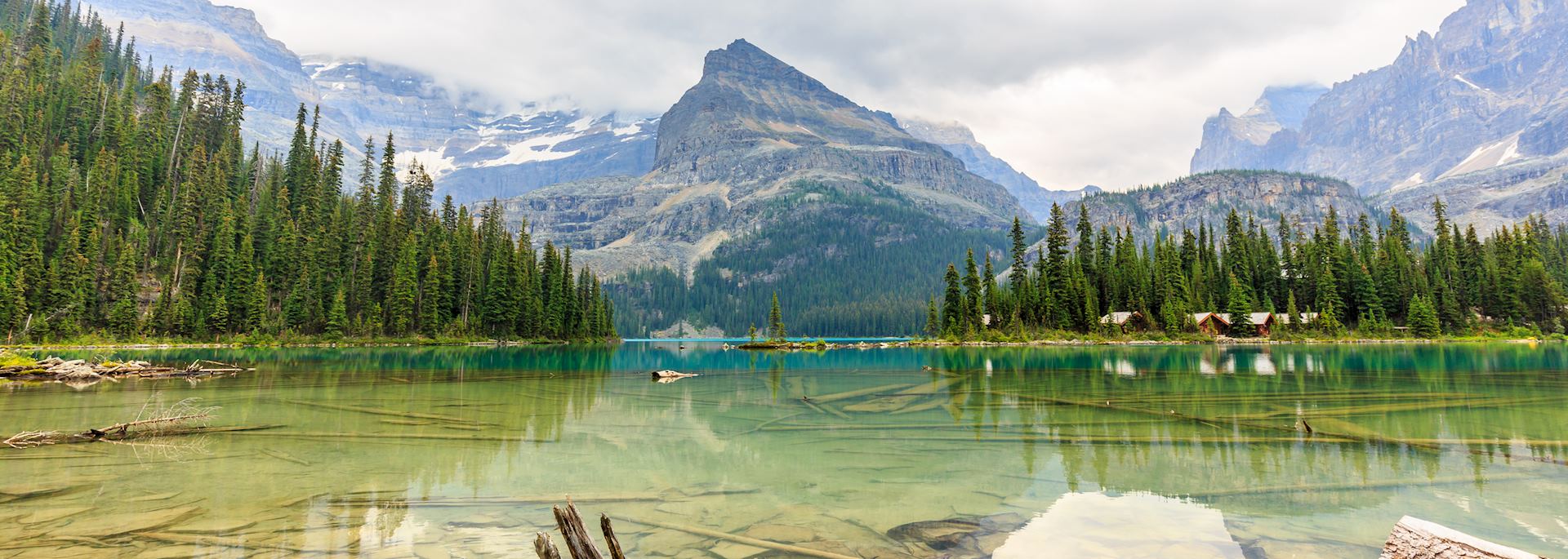
Highlights of the Canadian Rockies
- Yoho National Park
By Canada specialist Emily
Driving out of Jasper along the Icefields Parkway, I couldn’t help stopping to admire the view. It’s difficult to grasp the scale of the Rocky Mountains until you’re surrounded by them, their sharp peaks layered one in front of the other like a pop-out card.
A trip to the Rockies isn’t about cramming in as much as possible, it’s about putting on a waterproof and a pair of boots and just getting out there, pausing to watch a passing elk or moose, gazing up at some of the world’s darkest, star-crowded skies (occasionally graced by the northern lights), and wandering away from the busier spots to find your own secluded tract of land.
How to explore the Canadian Rockies

Outside of the winter months (when flying or coach journeys are safer), self-driving is your best option for getting around. It means you can travel at your own pace, dictating where you stop to take in views or explore places that pique your interest.
You could visit the Rockies as part of a wider trip across western Canada , beginning or ending in Vancouver with stops in-between at Whistler and Wells Gray Provincial Park . Alternatively, you could fly directly into Calgary , just a two-hour drive from Banff . There are also several train routes that cross the Rockies.
As the main routes through the Rockies get busy during the summer months, I also recommend following a quieter loop that takes you from Calgary to Waterton Lakes National Park, on the US border, and through small mountain towns like Fernie, Nelson and Golden.
You can also add on time in the Okanagan Valley wine region and switch Banff and Jasper National Parks for lesser-visited options like Kootenay, Yoho and Glacier National Parks. Read more about this route through the Rockies in our guide to self-driving western Canada .
When to visit the Canadian Rockies

June to September is the main travel season, but to avoid the crowds I prefer visiting in late September, when the landscape is dappled bright yellow from the changing leaves of larch and aspen trees. At this time, visitor numbers have thinned out, but you can still enjoy the same activities before temperatures plummet.
I also like visiting in May — while lakes are sometimes still frozen at this time, meaning some activities are off-limits, the snow-covered mountain peaks create a dramatic backdrop and visitor numbers are still relatively low. As May turns to June, everything becomes vivid green and wildflowers spring up.
In winter, everywhere is much quieter, the landscape is transformed by snow and you have a whole new set of activities to choose from — you can read about some of them in our guide to active winter experiences.
Jasper National Park
Jasper town.

The alpine town of Jasper is situated in the heart of the national park, set against a backdrop of huge mountains. It’s compact enough to explore on foot, with a good range of restaurants, bars and shops.
It’s mainly used though as a gateway for enjoying the park’s outdoor activities, from hiking, canoeing and white-water rafting along the Athabasca River, to taking a guided motorcycle ride in a Harley-Davidson sidecar.
Close to the town is the Jasper SkyTram, which takes you to the top of Whistlers Mountain. Standing at an altitude of 2,500 m (8,100 ft), the views in front of you stretch for miles, encompassing the town, distant mountains that seem to be shrugging off wispy clouds, and lakes gleaming blue and silver in the sun.
Maligne Valley and Maligne Lake

Many of the park’s natural highlights lie within Maligne Valley, 15 minutes northwest of the town. I suggest taking a guided trip out to explore them, stopping first at Maligne Canyon, a 50 m (160 ft) deep gorge carved by the Maligne River over the course of 10,000 years. Taking a short walk to the canyon’s rim, you can see the river flowing through and a series of waterfalls gushing down the limestone rock face.
Next you visit Medicine Lake. Formed by meltwater flooding the valley in spring, it dries up completely as the temperature rises. It’s a pretty spot at any time of year thanks to the steep-sloped mountains and bottle-green firs on all sides.
For me, though, the highlight of the valley is Maligne Lake. This is the quintessential Canadian lake, whose smooth, aquamarine waters lap the shores of Spirit Island — a tiny islet with huddled trees that forms one of the most photographed views in the Rockies.
You can take a 90-minute boat cruise around the lake and up to the island, looking out for ospreys diving to catch fish. Kayaks and canoes can also be hired — I find it impossible to visit the Rockies without taking up a paddle.
Walking in Jasper National Park

I headed out with a guide to learn more about the history, geology and wildlife in this part of the Rockies, but the park’s many walking trails are easy to navigate if you want to explore independently. Maps are available from the park’s information points.
I like the 3.2 km (2 mile) Mary Schaffer Loop, which takes you around the shores of Maligne Lake to a viewpoint above, before winding through pine forest. The trail is named after the park’s first official visitor, who arrived in the area in 1908. You can learn about her explorations through the interpretive displays set up along the trail.
For a tougher challenge, the 9 km (5.6 mile) Path of the Glacier trail takes you up to Mount Edith Cavell — one of the most prominent peaks in the Rockies — and rewards you with close-up views of several glaciers. You also pass Cavell Glacier, where chunks of ice occasionally fall with a splash into the milky-turquoise waters of Cavell Pond. You’ll also see the Angel Glacier, which resembles an angel with outspread wings.
Where to stay in Jasper National Park

I like staying at Alpine Village Cabin Resort because you have the best of both worlds — you’re only 2 km (1.2 miles) from central Jasper, but can enjoy the classic ‘cabin-in-the-woods’ experience. The stone and pine log cabins, each featuring a private terrace, are set among the trees close to the river and can sleep up to five guests.
Icefields Parkway

I’d never have thought that a day of driving would turn out to be the highlight of my trip. But the journey south from Jasper to Banff along the 232 km (144 mile) Icefields Parkway is no run-of-the-mill road trip.
While, taking the parkway, you could arrive in Banff after just four and a half hours, you’ll pass so many tempting viewpoints and walking trails that your journey time can easily double — I’d urge you to blank out a whole day. You can read more about the drive and its highlights in our guide to the Icefields Parkway .
Banff National Park

Banff is the flagship town of the Rockies, watched over by towering mountains in the middle of the park. It was the area’s natural hot springs that first attracted people here over a century ago, and you can still take a soak in the warm mineral waters at Banff Upper Hot Springs.
I found Banff was busier than Jasper, with a good choice of restaurants and shops. Calgary’s airport is just two hours away. Its central location in the park gives you easier access to the quieter areas, as well as the lesser-visited Kootenay and Yoho National Parks.
Lake Louise and Moraine Lake

In summer, people head to Lake Louise for a walk or to navigate the calm turquoise waters by canoe or paddleboard. In winter the lake freezes over, and the canoeists are replaced by ice skaters. Despite the lake’s popularity, it’s possible to walk a few minutes from the car park and find relative solitude.
You could then head just 20 minutes up the road to explore Moraine Lake, whose natural beauty also draws in visitors. Its water is even more vivid, pooled at the foot of huge, steeply rising mountains.
Moraine Lake Lodge has the best setting of any hotel I’ve stayed at. After a technology-free night in one of the log cabins, I was able to explore the lake in the early morning and late afternoon when no other visitors were around. You can rent canoes from the lodge’s boathouse, or take guided walks with the resident naturalist.
Walking in Banff National Park

From Lake Louise, I followed the 3.4 km (2.1 mile) Lake Agnes trail to a friendly teahouse on the shores of nearby Lake Agnes, where far fewer people tend to venture. The trail is fairly steep in places, but offers views over Lake Louise and nearby Mirror Lake, which is much smaller. The teahouse is a worthy reward, stocking over 100 varieties of loose-leaf tea and plenty of cake.
Setting off from Banff town, you can follow the 4.3 km (2.7 mile) Tunnel Mountain Trail, which winds up 300 m (984 ft) through pine forest to a viewpoint at Banff’s lowest summit. Again, the trail is quite steep in places, but well maintained and signed. At the top, stop to take in a panorama of the town and the Bow and Spray River Valleys.
Another route I recommend is the 10 km (6.2 mile) Bow Falls to Hoodoos Trail. Following the banks of the Bow River, you can stop to watch the falls and turbulent rapids frothing over rocks and boulders. The walk is relatively flat, much of it through forest, but the highlight is reaching the hoodoos — otherworldly spires of rock sculpted by the wind.
Where to stay in Banff National Park

Rather than staying in Banff, I base myself in the smaller town of Canmore, half an hour southeast. This peaceful town has several B&Bs, including my personal choice, Ambleside Lodge . Its living room has floor-to-ceiling windows overlooking the mountains, and there are just three guest rooms, so it feels like a home.
Lesser-known highlights of the Canadian Rockies
Kootenay national park.

Just over the provincial border, Kootenay National Park fringes Banff National Park but sees far fewer visitors. Following trails through the same mountain and lake scenery, it often felt like I had the whole park to myself. There’s also more chance of spotting wildlife such as elk, moose, deer and bears.
The park has several natural springs you can visit, including the Paint Pots — a collection of iron-rich springs that bubble up to the surface, creating orange, yellow and green pools and turning the ground rusty red. There’s also Radium Hot Springs, a pool complex where you can bathe in warm natural spring waters.
Cross River Cabins

Tucked away on the southern edge of the park, Cross River Cabins is a place where guests wish they could spend an extra night. The epitome of seclusion, it’s hidden at the end of a long gravel track with mountains looming large in the near distance.
Just a handful of log cabins are dotted among the pine trees, and the main lodge has a wood-fired hot tub. There’s an emphasis on sustainability here, and the Patenaude family who own the property are keen to ensure it has minimal impact on its surroundings.
From the property, you can head out with experienced local guides along some of the area’s hiking trails, formed from old animal trails or logging roads and generally unknown. There are several rivers nearby for canoeing, kayaking, white-water rafting or fishing.
Start planning your trip to the Canadian Rockies
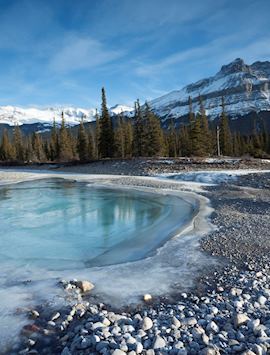
Express western Canada self-drive tour
8 days from $2,705pp

Hidden gems of Canada's Rockies self-drive tour
14 days from $4,775pp
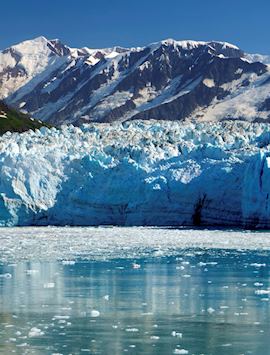
Alaska cruise & Canadian Rockies by train
15 days from $6,995pp
Start thinking about your experience. These itineraries are simply suggestions for how you could enjoy some of the same experiences as our specialists. They're just for inspiration, because your trip will be created around your particular tastes.
Further reading
- Self-driving in western Canada
- Hiking in the Canadian Rockies
- Family vacations to Canada
- Honeymoons in Canada
- Luxury vacations in Canada: heli-hiking, glamping and ranch stays
Plan your trip
Tell us about your plans and one of our specialists will plan a unique trip for you...
Request our brochure, The World Your Way

Order your digital copy via email.
National Geographic content straight to your inbox—sign up for our popular newsletters here

How to plan an epic road trip through the Canadian Rocky Mountains
Canadian travel writer, tour guide and Rockies native Patrick Twomey shares his expert tips on how to get the most out of Canada's big mountain country.
Calgary in Alberta and Vancouver in British Columbia are the key international gateway cities to the Canadian Rocky Mountains, which sit astride the two provinces. For an instant hit of big country vistas, start in Calgary and drive west, and you’ll be in the deep Rockies within 45 minutes. That ‘wow’ moment takes much longer from Vancouver or Edmonton, Alberta’s other gateway city.
The classic trip
Start in Alberta’s capital, Edmonton , and allow time to visit River Valley, Canada’s largest urban park. Heading west, the drive to the mountains takes about three hours as you transition from the prairies to the foothills and finally enter Jasper National Park . Spend two nights in the area — you’ll see wildlife throughout most of the year. Jasper has half as many hotels as Banff, so book ahead and shop around for deals. Next, drive south on Highway 93 to Banff National Park, taking in the Columbia Icefields. Stay two nights in the Banff/Lake Louise area and then continue south on Highway 93 through Kootenay National Park. Stay a night in Radium Hot Springs (take a dip in the pools) before continuing south for spectacular views at Crowsnest Pass and Waterton Lakes National Park. From Waterton, it’s a nice three-hour drive to Calgary, but I recommend stopping at UNESCO Heritage site, Head-Smashed-in Buffalo Jump, an Indigenous mass-hunting site where bison were driven off the cliff. Then backtrack to Highway 22 for panoramic views at Highwood Pass, the highest in Canada.

The fast-track trip
On a two-to-three-day route from Calgary don’t miss Three Sisters, a spectacular trio of mountains near Canmore, and visit Canmore Nordic Centre , a hub for cross-country skiing at the 1988 Winter Olympics — also great for mountain biking. As a base, Canmore is a good alternative to Banff or Jasper, offering a more diverse range of accommodation. Follow the unpaved road to the lakes and river of Spray Valley Provincial Park or, from Canmore head to Banff National Park to loop around Lake Minnewanka. Beyond the town of Banff, Cave and Basin, a significant indigenous site for more than 10,000 years, was the birthplace of Canada’s national park system.
From Banff the following morning, walk up Sleeping Buffalo (aka Tunnel Mountain) to summit an easy Rockies’ peak. Alternatively, drive to Norquay ski resort to walk the 2.6 mile Stoney Lookout loop through evergreen forest. Accessible year round, it has virtually no foot traffic and offers the best views of distinctive Cascade Mountain and the mighty Western Cordillera’s front ranges.
On day three, drive to Lake Louise for sunrise. In good weather take the summer chairlift from its ski area, a good vantage point for grizzlies. Then head into Yoho National Park and drive up to Takkakaw Falls; the road open May/June-September/October. Don’t miss lunch at Truffle Pigs Bistro & Lodge in the town of Field, for laidback, gourmet Rockies dining. See more of Patrick’s travel tips
Peter Lougheed Park
This provincial park in Alberta’s Kananaskis Country is home to Highwood, Canada’s highest pass (closes Oct-May for animal migration). It’s less accessible for coach tours, but wildlife is abundant including grizzly and black bears, elk, deer, moose, and even cougars, lynx and Rocky Mountain wolf.
Takakkaw Falls
Near Lake Louise, via a hairpin road, these ‘magnificent’ waterfalls (their meaning in Cree) are among Canada’s highest. Here, meltwater from the Daly Glacier thunders into the Yoho Valley overlooked by 3,189m Cathedral Peak. This is excellent terrain for backcountry hiking and camping (pack your bear spray).
Jasper dark skies
A wider valley than Banff, Jasper has dimmed its lights, making the Aurora Borealis more visible. Along with Yellowknife in the Northwest Territories, this is one of Canada’s Northern Lights hubs. December to March is peak season, with starry skies year-round in good weather.
Head-Smashed-in Buffalo Jump
Until the Industrial Revolution, this precipice, where the Rockies rise from the prairies, hosted the world’s largest meat harvest. Today, it’s one of the best-preserved sites illustrating the hunting techniques used for millennia by Plains People.
Become a subscriber and support our award-winning editorial features, videos, photography, and more—for as little as $2/mo.
Related Topics
- ADVENTURE TRAVEL
- TRAVEL AND ADVENTURE
- ADVENTURE SPORTS
You May Also Like

Banff, Jasper and more: 4 wild places for Canadian outdoor adventures

From ice roads to the Klondike Highway: 6 of Canada's most adventurous road trips

The ultimate Andes road trip, from Chile to Bolivia

Free roam safari: a self-guided campervanning trip through South Africa & Eswatini

Following early polar explorers on a journey through Canada's Northwest Passage
- Environment
- Paid Content
History & Culture
- History & Culture
- Destination Guide
- Terms of Use
- Privacy Policy
- Your US State Privacy Rights
- Children's Online Privacy Policy
- Interest-Based Ads
- About Nielsen Measurement
- Do Not Sell or Share My Personal Information
- Nat Geo Home
- Attend a Live Event
- Book a Trip
- Inspire Your Kids
- Shop Nat Geo
- Visit the D.C. Museum
- Learn About Our Impact
- Support Our Mission
- Advertise With Us
- Customer Service
- Renew Subscription
- Manage Your Subscription
- Work at Nat Geo
- Sign Up for Our Newsletters
- Contribute to Protect the Planet
Copyright © 1996-2015 National Geographic Society Copyright © 2015-2024 National Geographic Partners, LLC. All rights reserved

ABOUT THE CANADIAN ROCKIES
Snowcapped mountains, glaciers and icefields, turquoise lakes, rushing rivers, colourful wildflower meadows, abundant wildlife, and outstanding recreational opportunities make the Canadian Rockies a destination that is rivaled by few places in the world.
Places to Go
The vast wilderness of the Canadian Rockies is protected by a number of parks, including five national parks. Nearby are provincial parks, other protected areas, and the gateway town of Canmore.
Banff National Park
Jasper national park, kootenay national park, yoho national park, columbia valley, kananaskis country, waterton lakes national park.
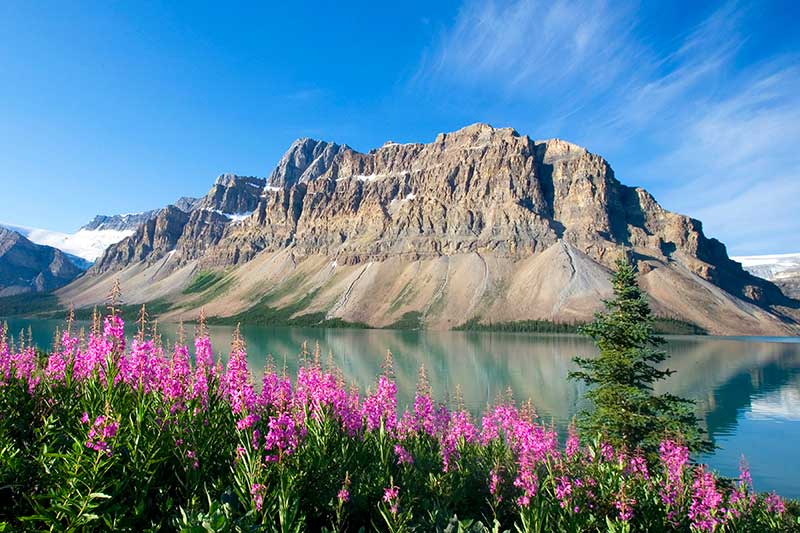
BANFF NATIONAL PARK
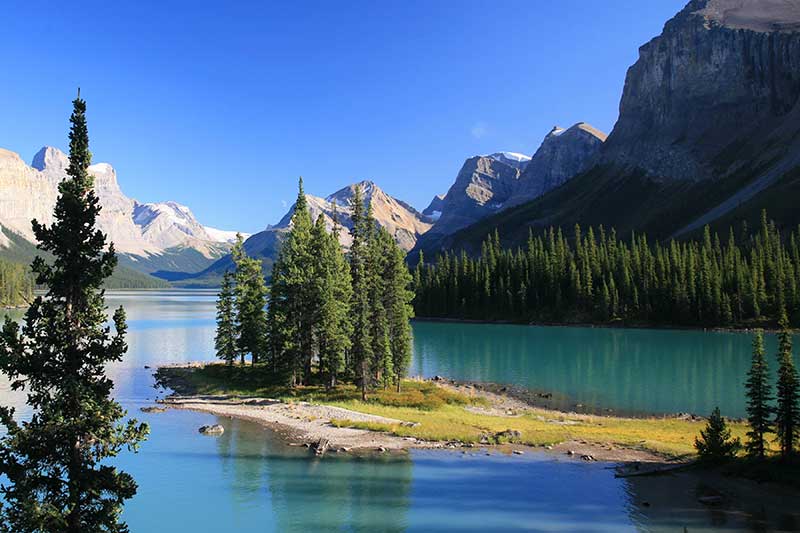
JASPER NATIONAL PARK
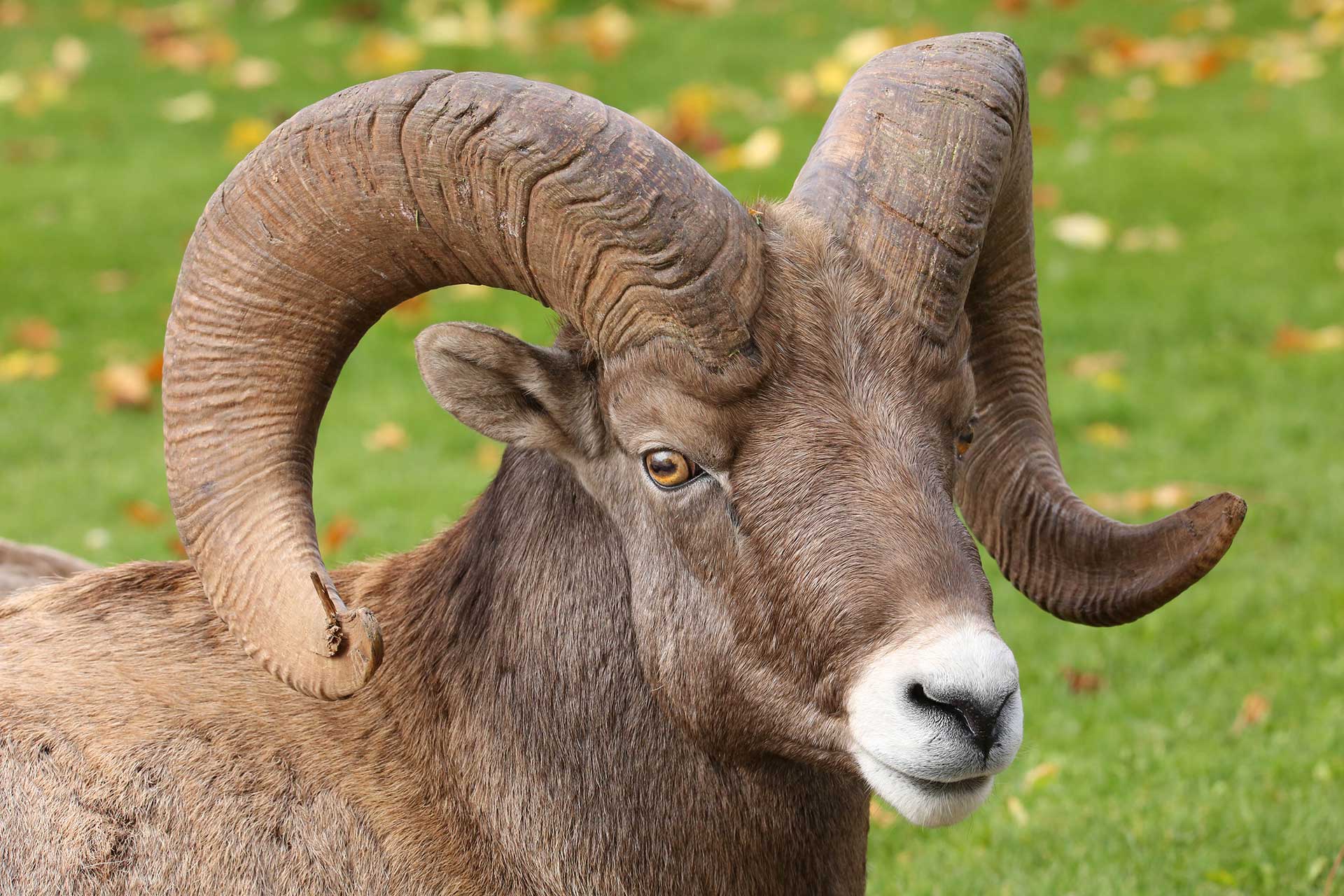
KOOTENAY NATIONAL PARK
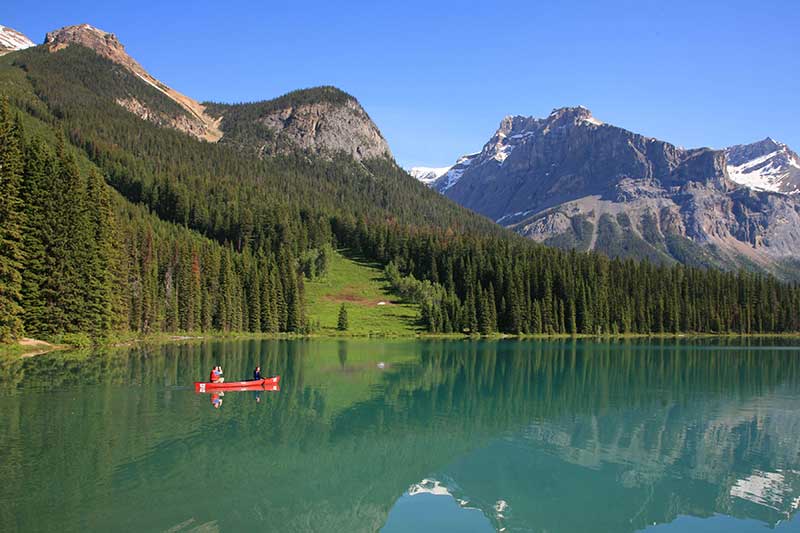
YOHO NATIONAL PARK
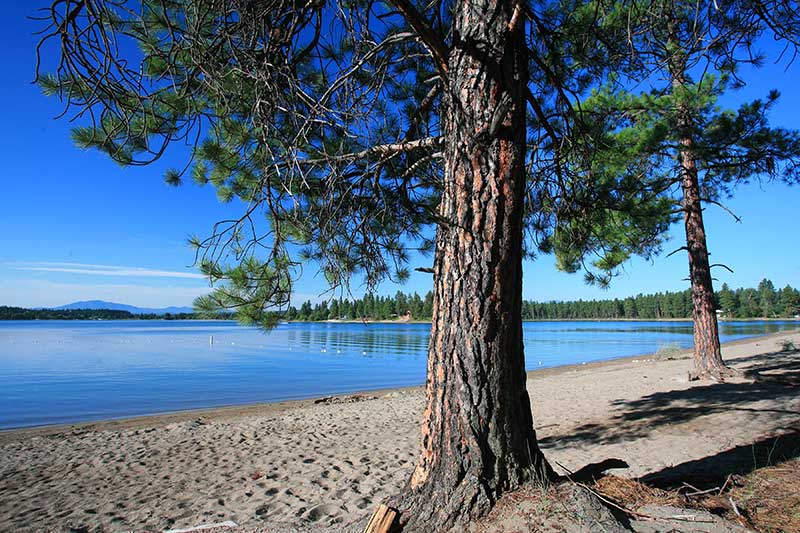
COLUMBIA VALLEY
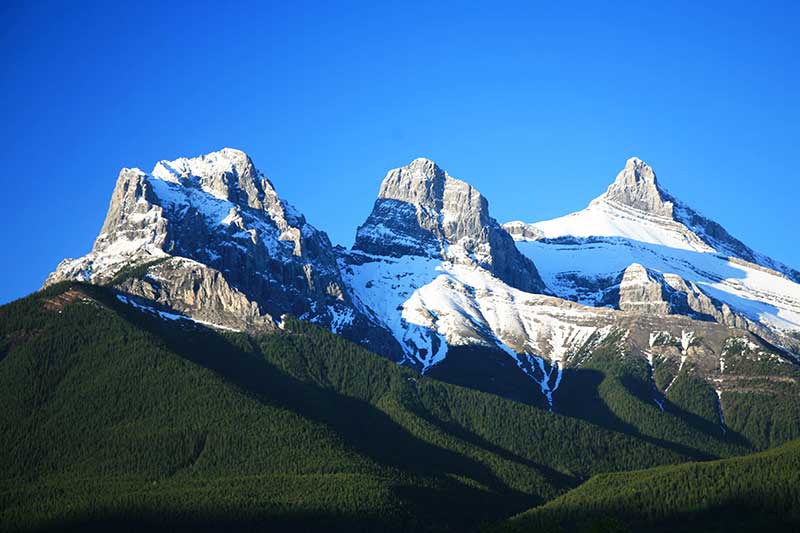
KANANASKIS COUNTRY
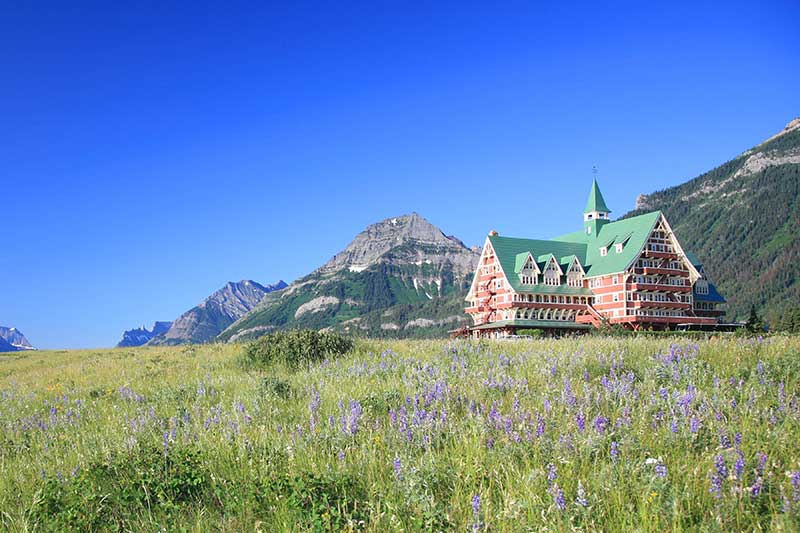
WATERTON LAKES NATIONAL PARK
Things to do.
The Canadian Rockies are a four-season playground – the great outdoors offering activities for everyone.
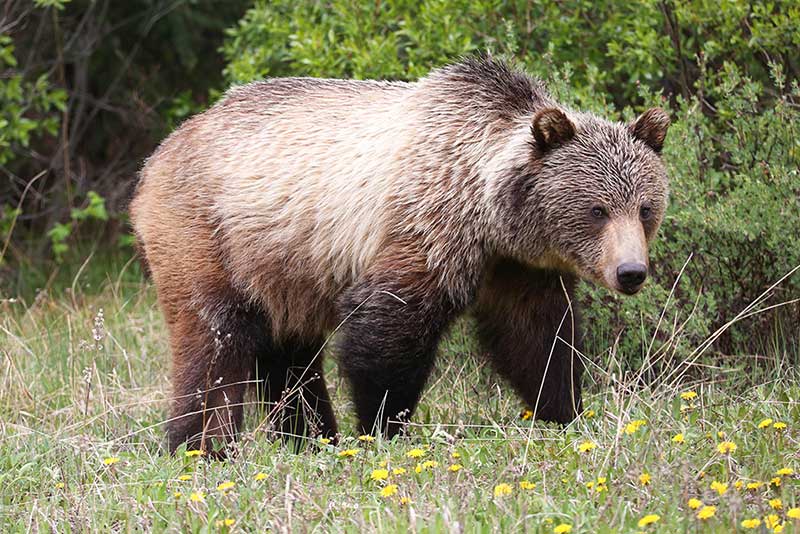
HOT SPRINGS
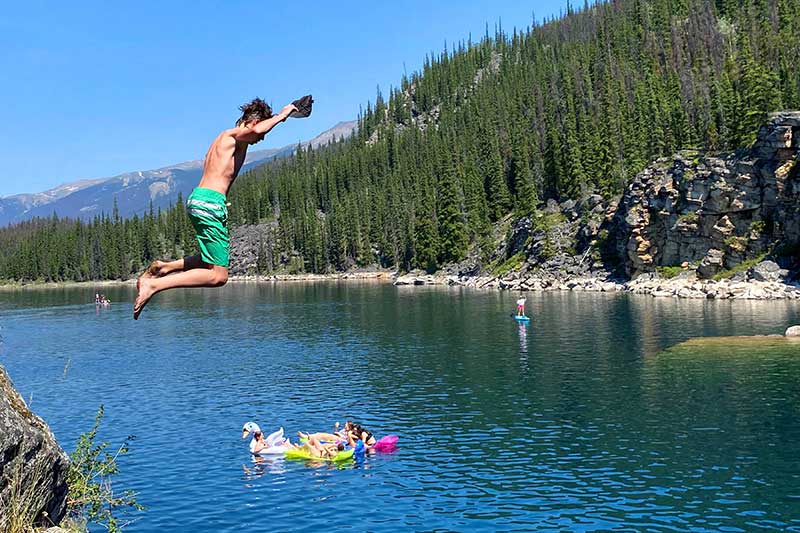
Check out the most popular destinations that are off the beaten path!
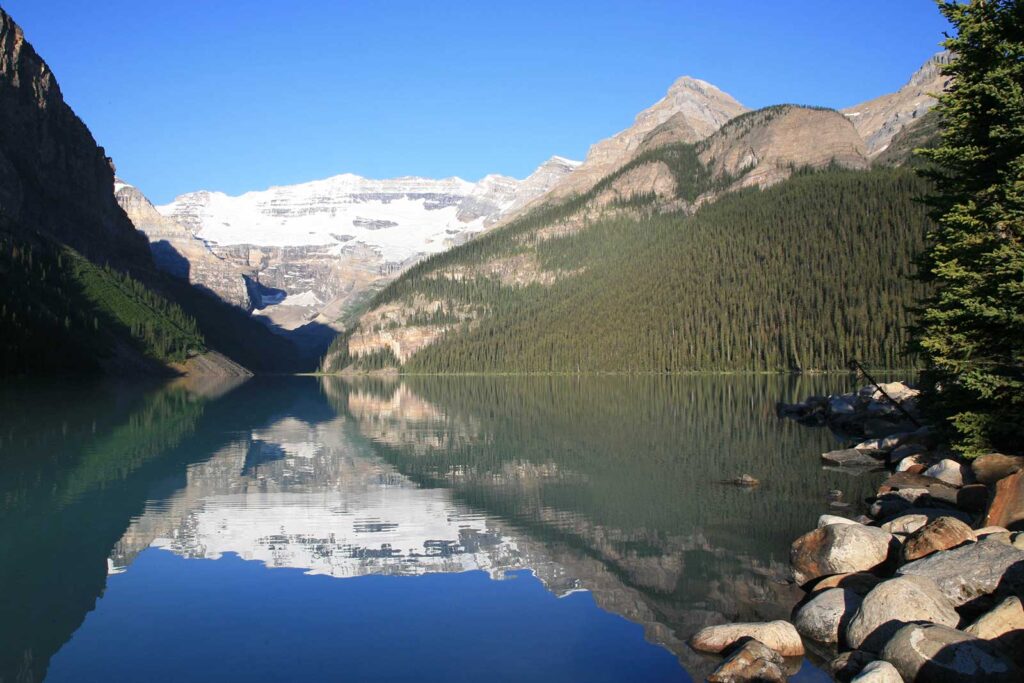
LAKE LOUISE
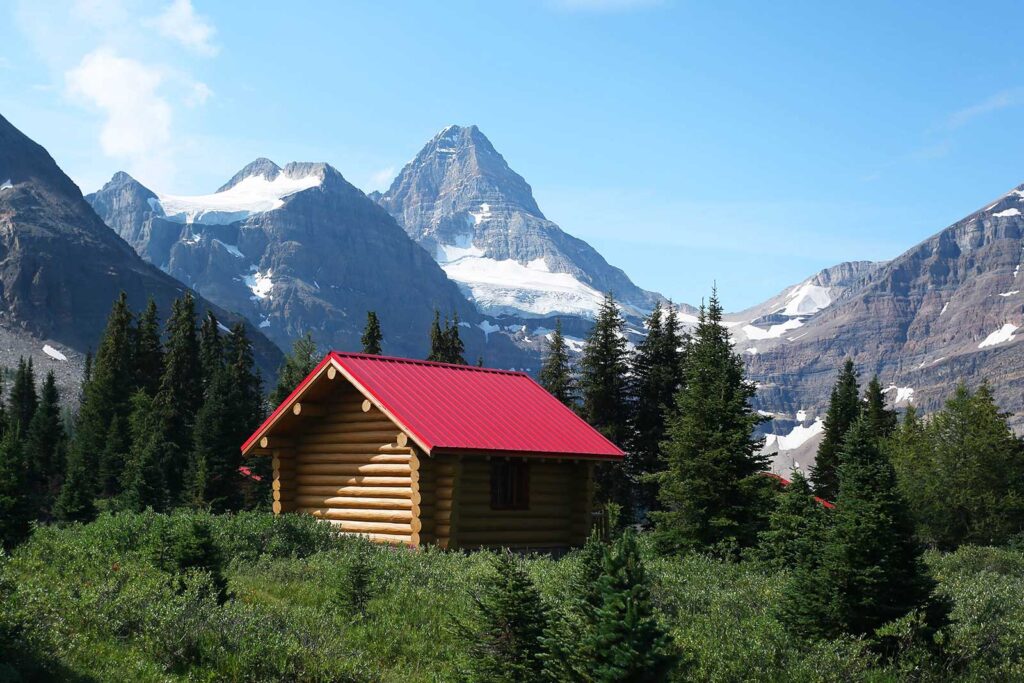
MOUNT ASSINIBOINE
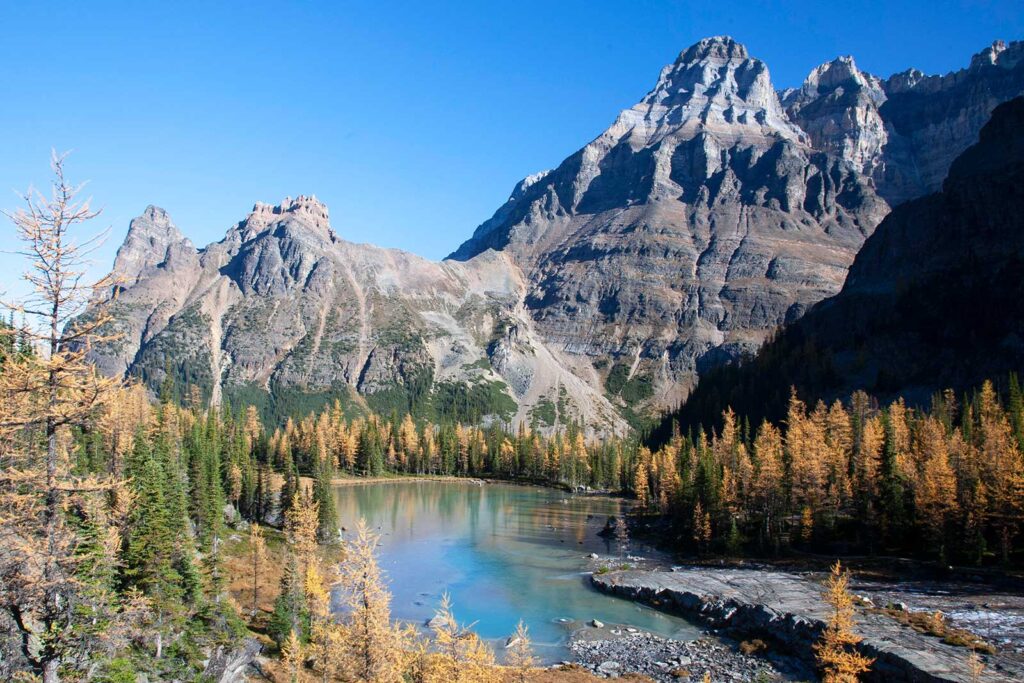

LAKE O'HARA
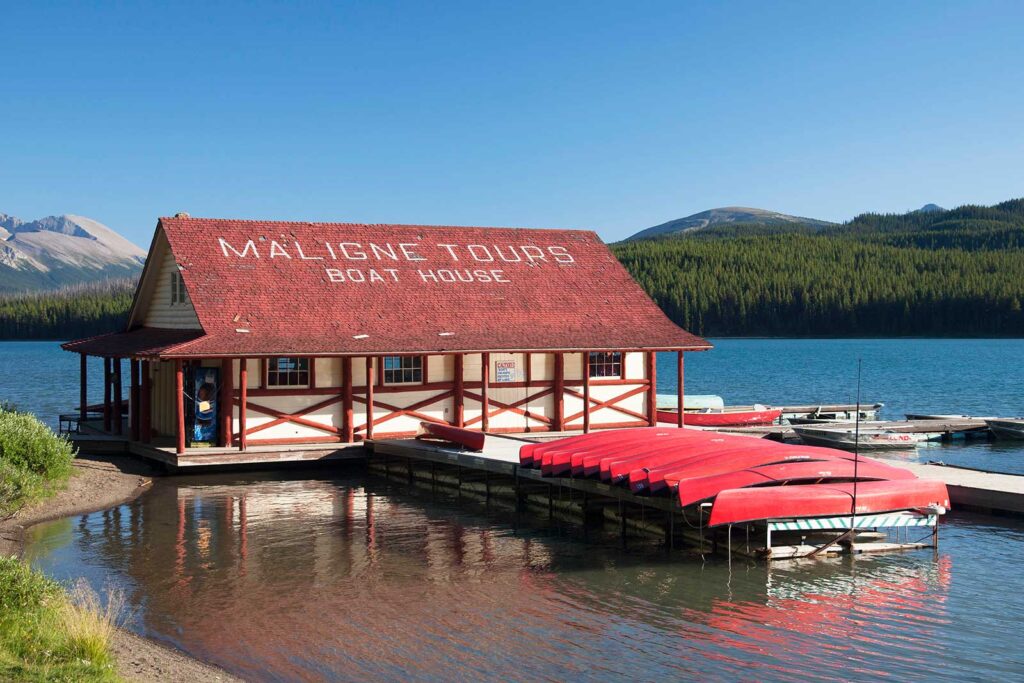
MALIGNE LAKE
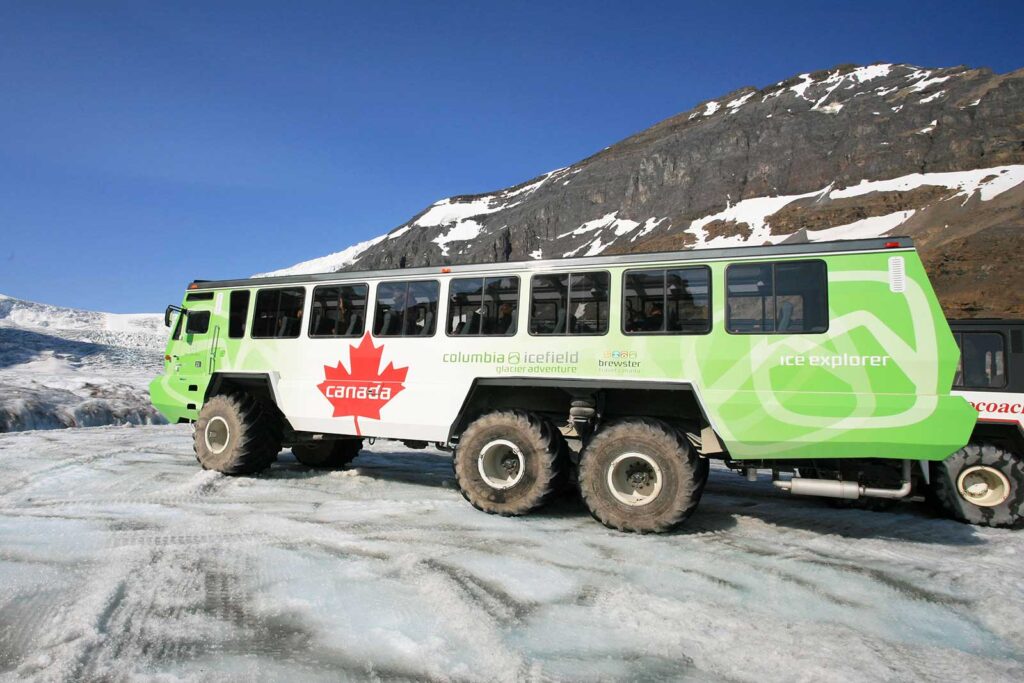
ICEFIELDS PARKWAY
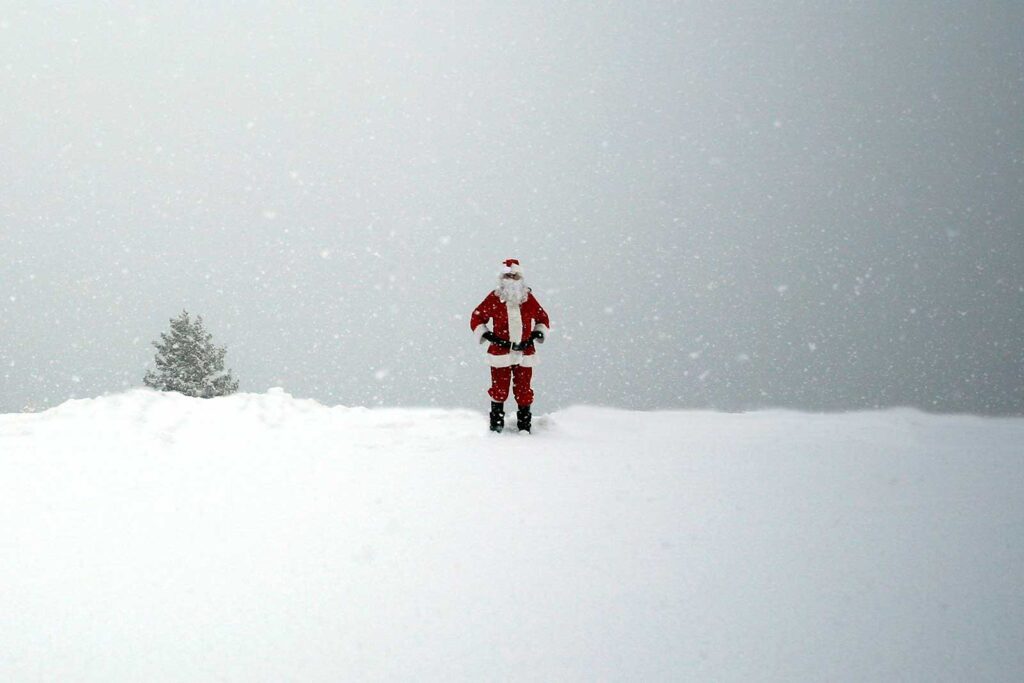
ITINERARIES
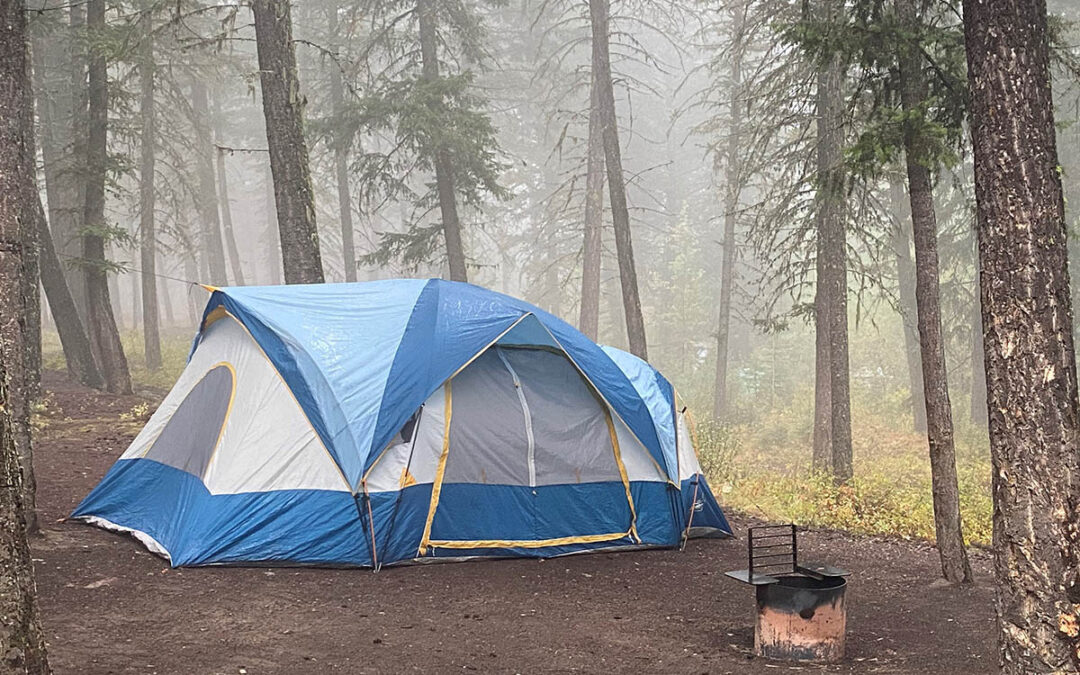
Canadian Rockies Campground Reservations in 2024
Canadian Rockies Campground Reservations in 2024 Parks Canada recently released launch dates for Canadian Rockies national park campground reservations in 2024. As usual, dates are staggered, but on launch day for each park, the entire season opens through Parks...
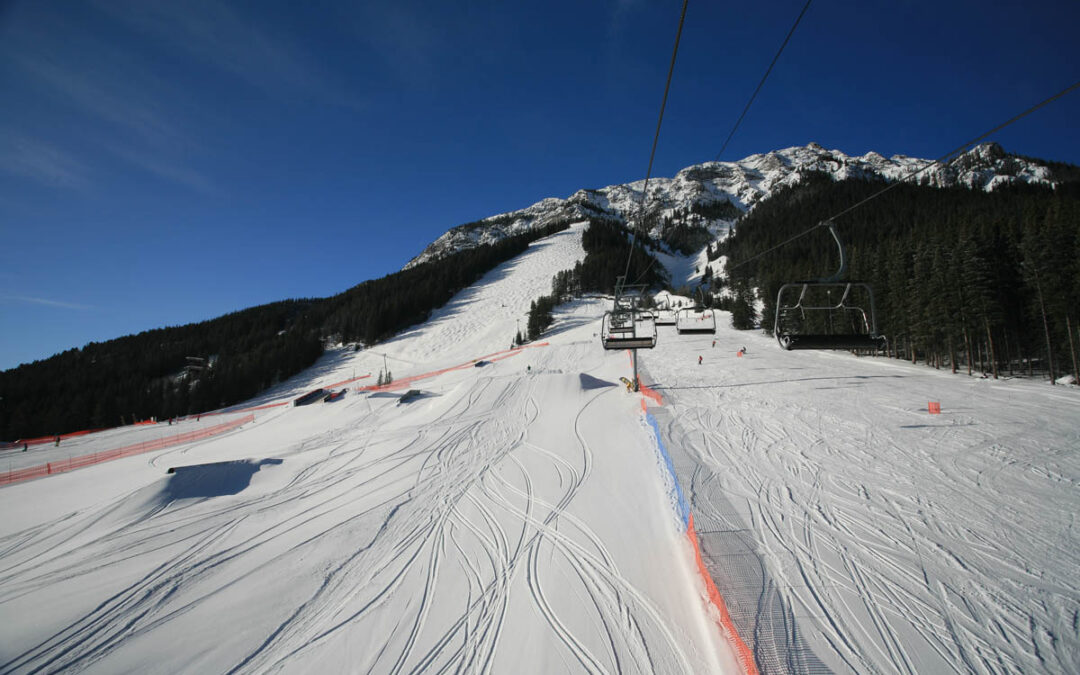
Ski Pass Comparison 2023-2024
What is the cost of day ski passes in the Canadian Rockies for the 2023-2024 season? All major resorts are compared including lake Louise, Sunshine Village, and Marmot Basin.
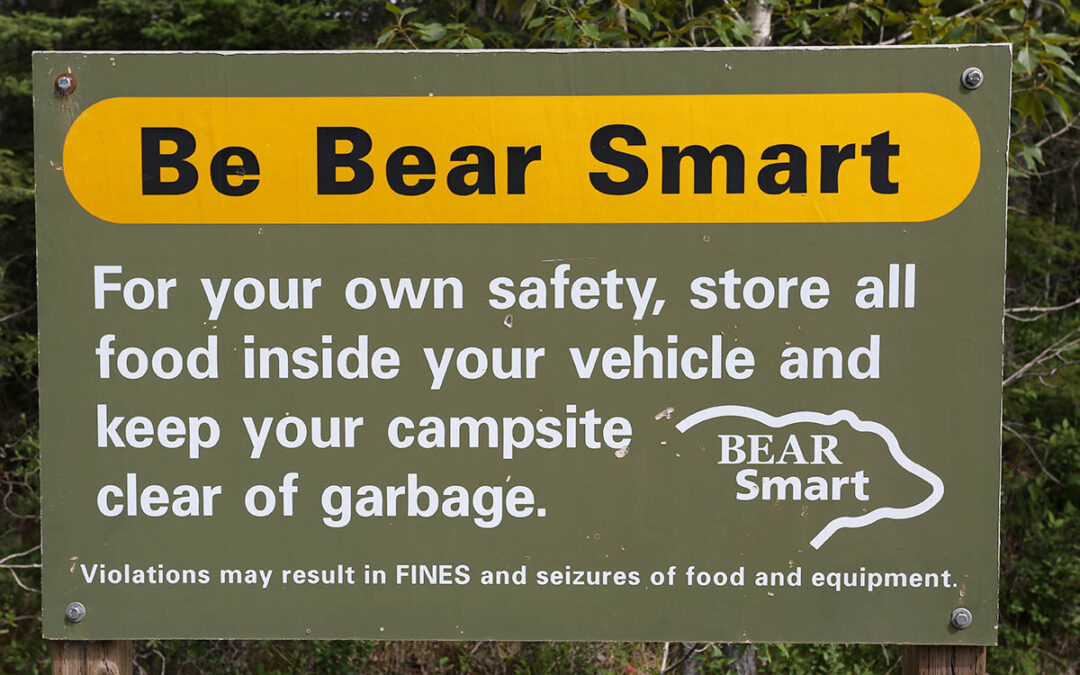
Bear Safety When Camping
Bear Safety When Camping Bear safety when camping in the Canadian Rockies is very important. The Canadian Rockies are home to modest populations of black and grizzly bears. Almost every year, bears are reported in at least one campground somewhere in the Canadian...
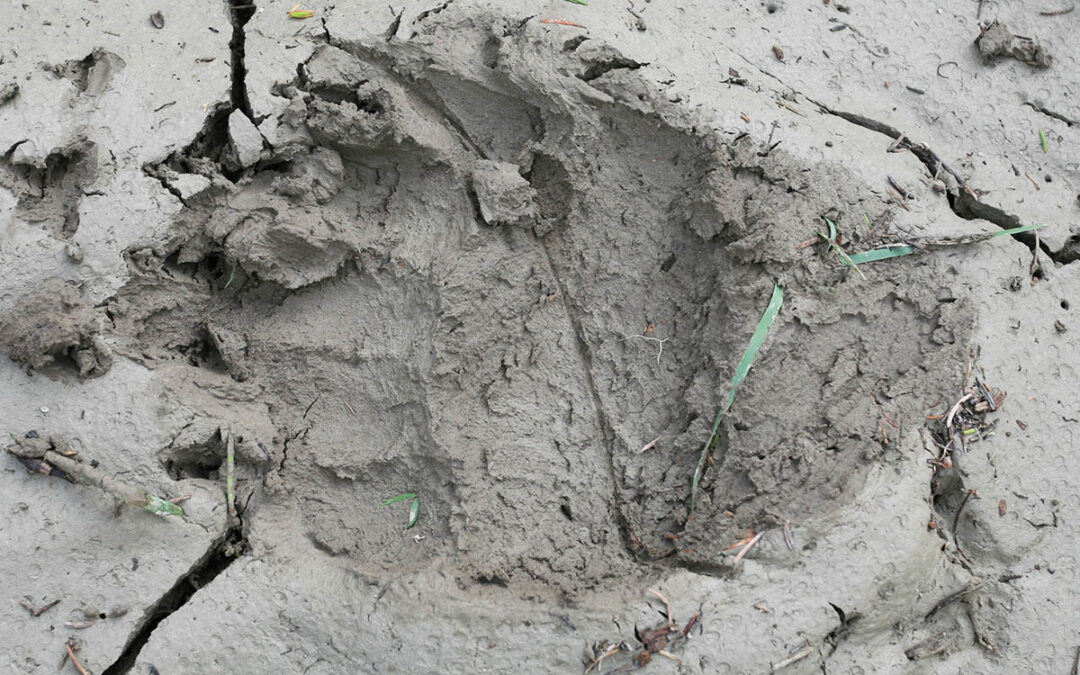
Bear Safety When Hiking
Bear Safety When Hiking Bear safety when hiking in the Canadian Rockies is very important. The Canadian Rockies are home to modest populations of black and grizzly bears. Almost every year, at least one hiker has a bear encounter somewhere in the Canadian Rockies,...
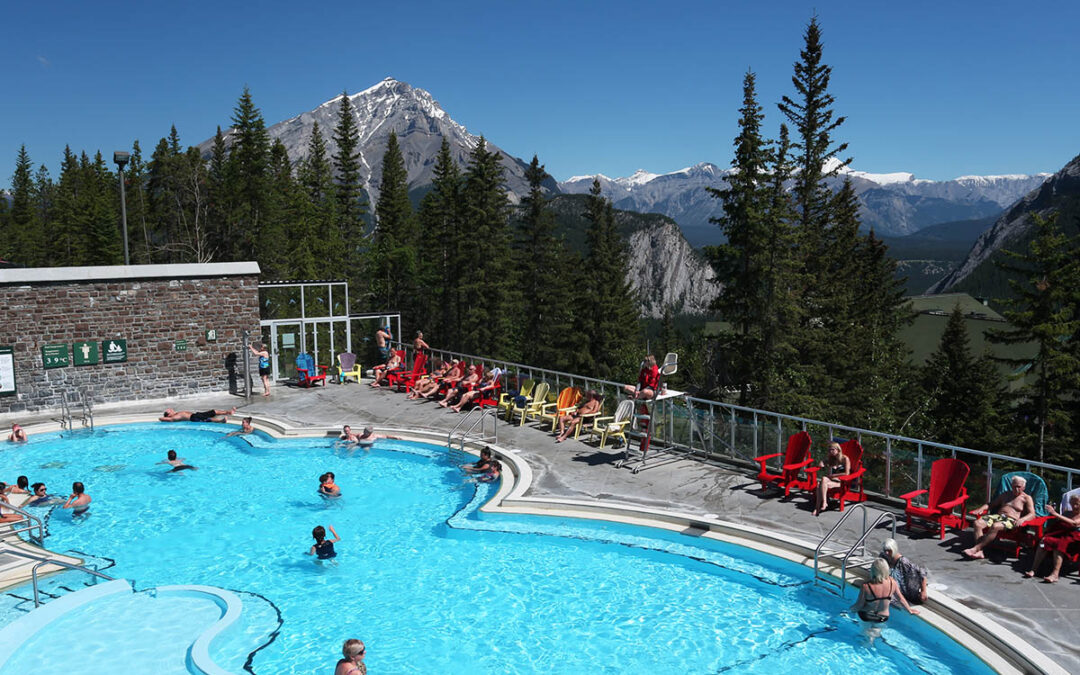
Best Canadian Rockies Hot Springs
What are the Best Hot Springs in the Canadian Rockies? The best hot springs in the Canadian Rockies come in two different types—hot springs that have been commercialized and hot springs left in their natural state. Canadian Rockies hot springs are particularly...
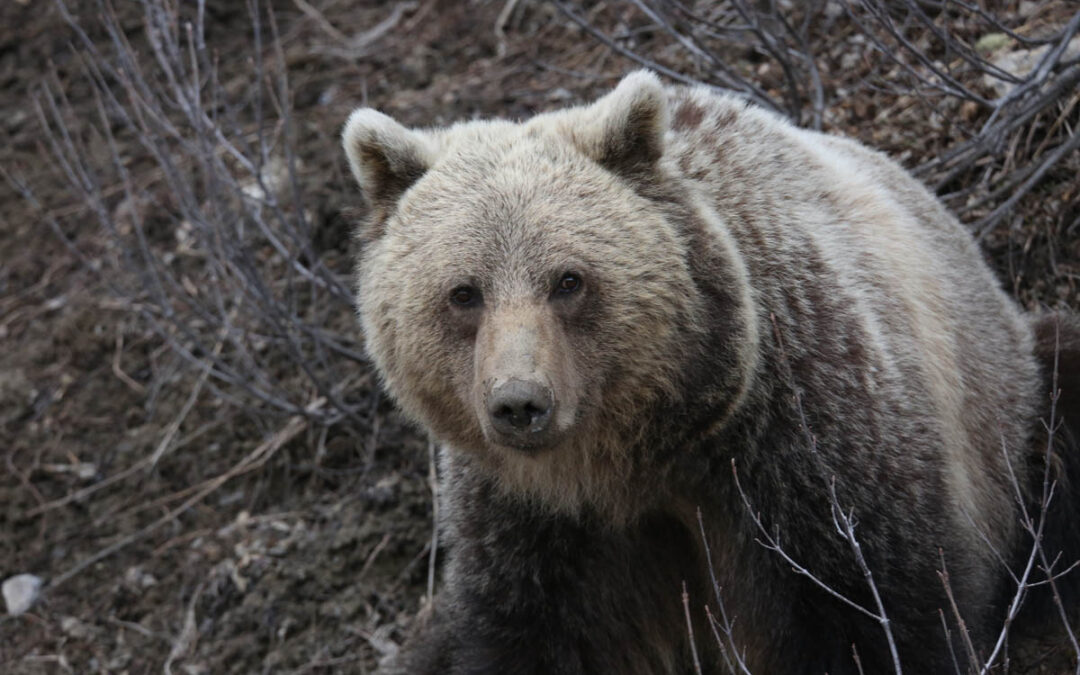
Bears in the Canadian Rockies
Bears in the Canadian Rockies—an Essay by Brian Patton There are certain trails in the Canadian Rockies where I always think about bears. But I always think about them more, and somewhat nervously, when hiking alone in the autumn. The incidence of serious grizzly...
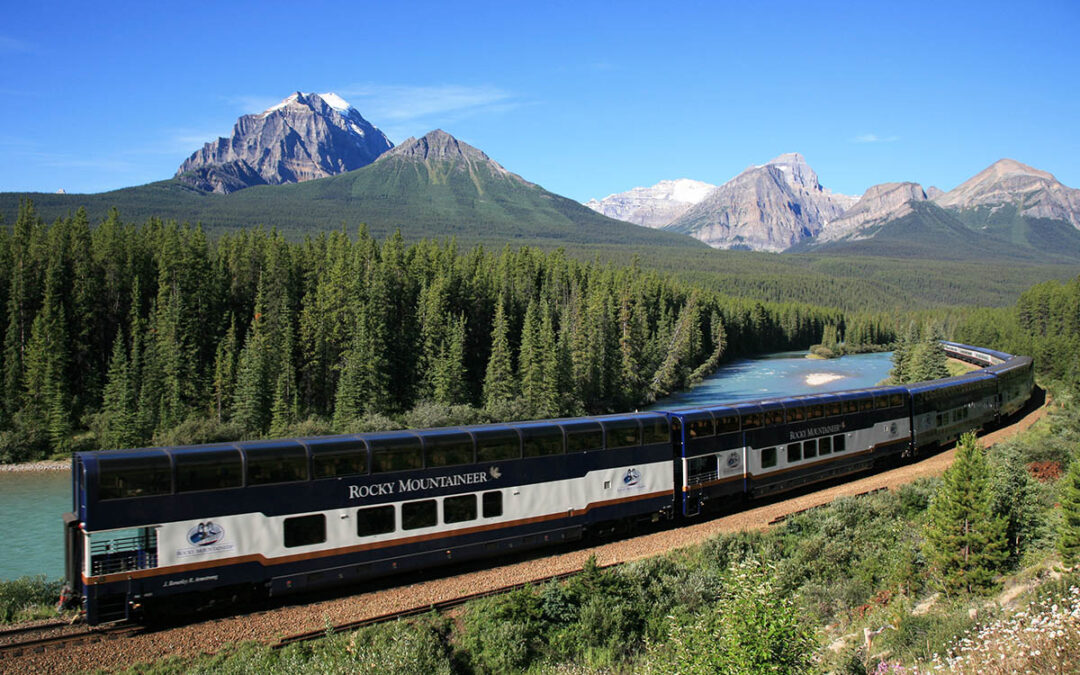
Canadian Rockies Train Trips
Best Canadian Rockies Train Trips If you enjoy rail travel, there are two Canadian Rockies train trips. VIA Rail is a government-run service across Canada that crosses the Canadian Rockies through Jasper. The Rocky Mountaineer is a private company that operates a...
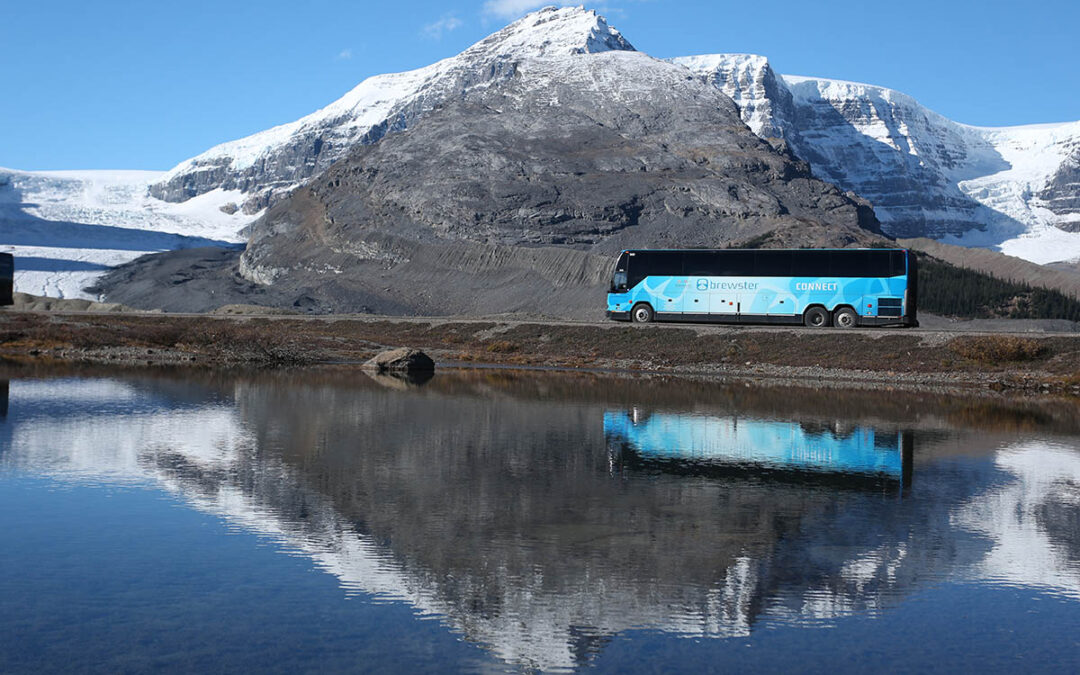
Canadian Rockies Escorted Tours
Canadian Rockies Escorted Tours Options for Canadian Rockies escorted tours range from local companies to international operators offering tours throughout the world. Below we describe some things to consider before booking an escorted tour. What is a Canadian Rockies...
Let's be friends! Sign up receive our monthly newsletter with updates and new in-depth guides.

How to plan an Amazing Canadian Rockies Road Trip Itinerary
The Canadian Rockies are nothing short of spectacular. In many ways, it was our first trip to the Canadian Rockies years ago that set us (mostly Matt, who wasn’t into hiking and the outdoors until relatively recently) onto this path to running this site full time.
It seemed like around every bend in the road or trail, there was a somehow more spectacular view awaiting us.
How can one relatively compact place (relatively is doing a lot of work here) contain so much sheer natural beauty? Glacier-fed alpine lakes with that trademark shade of turquoise. Never ending ranges of rocky peaks. Abundant wildlife, including moose and Grizzly bears.
It’s no wonder that so many people – including us – flock to this slice of alpine paradise. And, to be clear, there will be A LOT of people, but we’re going to do our best in this guide to give you specific tips based on our own trips to the Canadian Rockies to help you avoid the worst of the crowds.
In this guide, we’re going to go through ALL the information we think you need to plan an incredible 10 day Canadian Rockies itinerary.
We’ll start with some important logistics – like where to fly in and out of, how to structure your trip to maximize your time, etc. – and then move on to a day-by-day itinerary that you can copy and paste for your own trip (in this case, we’re okay with plagiarism!).
The intention is to put all the information you need to plan your once-in-a-lifetime Canadian Rockies road trip all in one place.
Plus, it’s all based on our own personal experience over multiple trips to the Canadian Rockies, and we’ll give you the lowdown on what’s worth it, what’s not, and what we wish we’d done differently.
Sound good to you? Let’s get into it.
P.S. Strap in with a cup of coffee (or wine, no judgement here), because this guide is LONG and DETAILED. We really tried to shave it down, but a lot of the details we’ve included are essential for planning your trip, so we’re leaving them in!
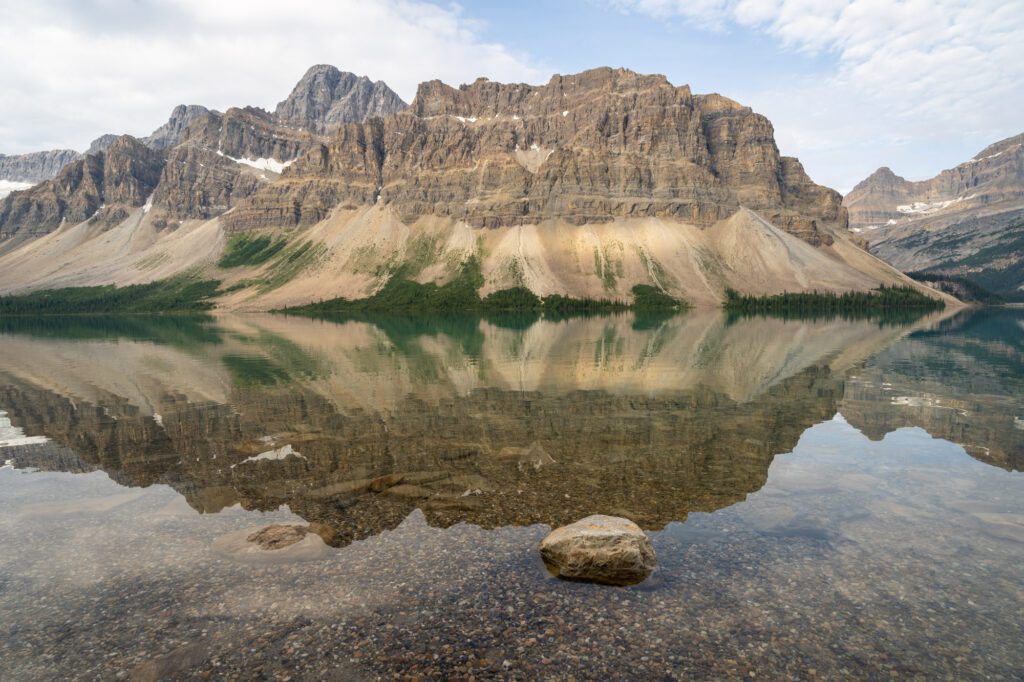
Disclaimer: Some of the links in this post, like hotel links, are affiliate links, meaning at no additional cost to you, we make a little bit of money if you click through and book. That being said, we would never recommend something to you that we don’t stand behind 100%.
How Many Days Do You for This Itinerary?
To see the best of Banff, Jasper, and Lake Louise (including Moraine Lake), you really need a MINIMUM of 7 days. It’s a lot of driving, and trying to pack it all in just 7 days is going to mean you’re missing key highlights and hikes.
Plus, with only 7 days, you basically have no flexibility when it comes to the weather (I’m currently writing this on a rainy July morning in Jasper).
We’ve written this itinerary for 10 days . Those extra few days allow you to get a little off the beaten path (to the extent that even exists in Banff and Jasper) to see some of Yoho National Park, a less-heralded park just west of Banff National Park, and have some flexibility to spend a rainy morning waiting for a break in the weather, if needed.
Plus, it gives you more time to dive deeper into the Icefields Parkway, the incredibly scenic road trip from Banff to Jasper, which deserves more than a couple of hours on your itinerary. We’ve got two half days dedicated to that drive, which is packed with raging waterfalls, epic vistas, and great hikes.
If you have more time (11-14 days) or less time (7-9 days), we have some ideas on how to alter this itinerary at the end.
If you have 7 days, you should also read our guide to planning a 7 day Banff and Jasper itinerary (coming soon-ish!), which packs the highlights into a week.
Heads up: If you haven’t heard, Jasper suffered a devastating fire during the summer of 2024, and it’s unclear what the future looks like and how it will affect what you can do and see in Jasper in future years. If you want to donate to support the recovery, you can do so here or with the Canadian Red Cross .
Where to Start and End Your Road Trip
This one is easy! If you’re coming from somewhere out of the area, the answer is going to be Calgary, which is about an hour and a half away from the town of Banff.
You’ll want to fly into Calgary International Airport (YYC) , which has some direct flights, but is likely going to require a connection if you’re not coming from one of the airline’s hubs. Still, it’s by far the most convenient airport to fly into.
If you’re coming from the Pacific Northwest like us, driving to the Canadian Rockies is doable, but you should keep in mind that it’s a long drive. We drove from Portland up to Vancouver, where we spent a couple of days before embarking on a Vancouver to Banff road trip .
Because it adds a significant amount of drive time (9 hours from Vancouver to Banff, one way), we’d only recommend this option for people with 14 days or more .
Do You Need to Rent a Car for This Itinerary?
The short answer is yes, we think you definitely need to rent a car to make the most of your trip to the Canadian Rockies .
And you should rent it on arrival at Calgary International Airport , and drop it off at the same location when you’re heading home.
However, I will say that, unlike our trip more than five years ago, Banff has come a long way in terms of public transportation, and it is now possible to piece together an itinerary using a combination of public transportation and guided tours.
There are public buses (via ROAM Transit ) between Banff and Lake Louise, Moraine Lake, Sunshine Meadows, and Johnston Canyon.
However, the thing to know here is that you’re going to be sacrificing A LOT of flexibility. While they exist, the routes don’t always come terribly often, and the first bus of the day is often later than we’d recommend getting the day started.
The other major downside is that you’ll end up missing a bunch of the stops along the Icefields Parkway, which would be a shame. There are tours that tackle it, but they’re not going to make as many stops as we think you should.
So, the long answer is that yes, you should definitely plan on renting a car, but it’s possible to put together an itinerary without driving.
How to Structure Your Itinerary
We’re adding this as a separate section up top because we think it’s pretty important to consider how you structure your itinerary to maximize your time.
At a high level, we’d break up your trip into three distinct parts, staying in a different place for each of them to use as a home base for the region.
Those three parts are Banff (and around), Jasper, and Lake Louise.
Here are a few reasons why we strongly believe that’s the best way to structure your itinerary.
The first thing to know is that it’s a 45-60 minute drive from Banff to Lake Louise. To make the most of your time and be able to see the lake multiple times without commiting to 90 minutes of driving each time, we’d strongly recommend trying to stay near the lake for two nights .
It’s worth seeing the lake at both sunrise and sunset, we think, and this will allow for an early start on the very busy trails. There aren’t that many options and they’re kind of pricey, but we think it’s worth it to avoid driving back and forth a bunch of times.
For the record, we did that on our first trip (but not on our second) and wish we had done it on that second trip.
The second thing to consider is that it will take you nearly four and half hours to drive from Jasper National Park to Calgary. For that reason, we’d recommend ordering your trip to start in Banff, head up to Jasper, and then return to Lake Louise at the end so that you’re set up for a more manageable drive back to the airport (2 hours, ish).
This is also true if you’re driving back home, unless you live in Edmonton, which is up near Jasper.
This is what the resulting 10 day trip looks like, at a high level:
- Day 1: Arrive in Calgary (Sleep in Banff)
- Day 2: Banff
- Day 3: Banff
- Day 4: Drive Banff to Jasper (Sleep in Jasper)
- Day 5: Jasper
- Day 6: Jasper
- Day 7: Drive Jasper to Lake Louise (Sleep in Lake Louise)
- Day 8: Lake Louise
- Day 9: Lake Louise / Moraine Lake
- Day 10: Drive Back to Calgary (Yoho in AM if you have time)
Where to Stay for This Itinerary
Now that we’ve covered some of the important logistics and laid out our thoughts on how to structure your itinerary, let’s talk about where to stay.
As we’ve covered already, we think you should break up your trip into three chunks – Around Banff, Jasper, and Lake Louise – and choose a home base near each place to use to explore.
This will cut down on driving back and forth, and allow you to get an earlier start on hikes and viewpoints, which is important in the summer when crowds are intense.
In this section, we’ll go through an overview where to stay for each of those regions. For more detail, including more options, you should go read our guides to where to stay in Banff (which includes Lake Louise) and where to stay in Jasper .
Staying Around Banff
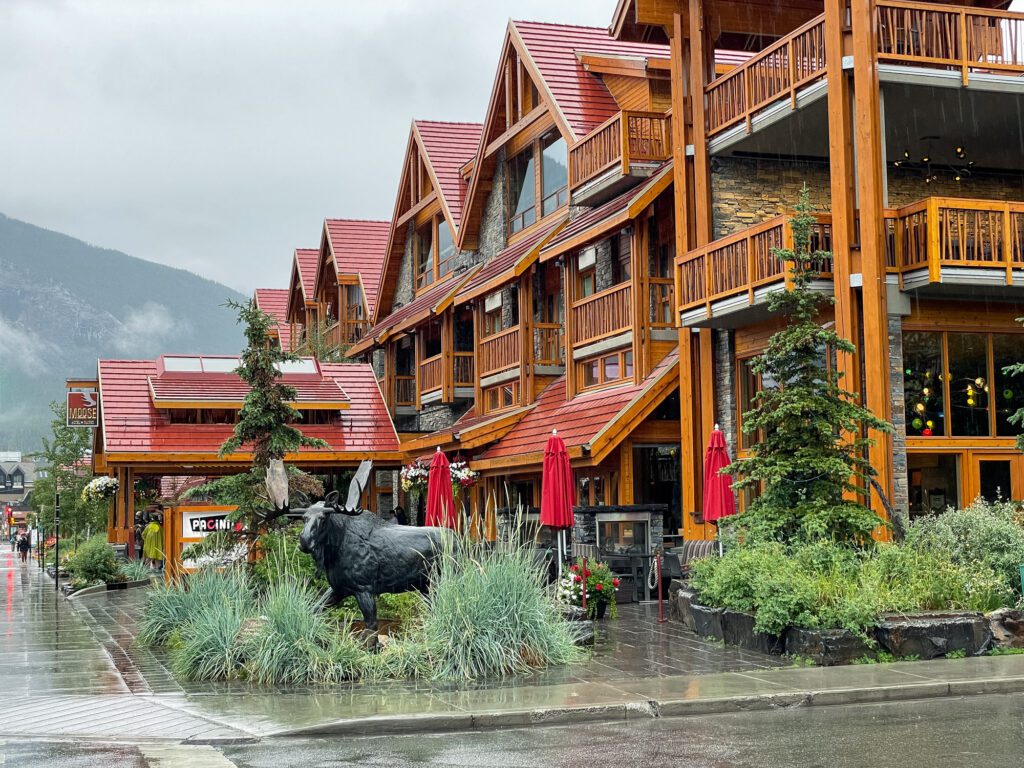
This is your first decision point, because you have two distinct options when it comes to choosing a home base for exploring around the town of Banff.
The two options are staying in the town of Banff, which is right in the middle of all the action, or staying in Canmore, a suburb (ish?) of Banff that is just outside the national park boundary.
In general, Banff is going to be a little more convenient in terms of location because it’s further west, closer to key trailheads like Johnston Canyon.
While Canmore is an extra 15 minutes away from things, it’s far more charming, with a better food and drink scene (we think) and a more laid back vibe.
Plus, it’s more affordable, and the accommodation options are more modern and updated (while some places in Banff feel a little dated because they’ve been constantly full for decades).
For what it’s worth, we’ve stayed in both places and, after this latest trip when we stayed in Banff, we decided we will always stay in Canmore on future trips because we like it better as a town, and it’s generally a better value.
In Banff, we stayed at Tunnel Mountain Resort , which is just up the hill from town on – you guessed it! – Tunnel Mountain. It’s a good location, with free parking and a bus line that runs right into town from right in front of the resort.
Our room was kind of a dim cave situation (which might be because we needed a dog-friendly room), and it probably needed a fresh coat of paint and some new fixtures to justify the price we paid for it. But, it’s Banff, so you’re never REALLY going to get a great value, are you?
We’d cautiously recommend it, especially if you need a dog-friendly place to stay with a kitchen, which is how we ended up there.
If you don’t need those things and you want to be based in Banff itself, look at Basecamp Suites Banff . We stayed at their location in Revelstoke and absolutely loved it – wish we’d stayed at their location in Canmore on this trip!
They have locations all through the Canadian Rockies, and this particular location is a suite hotel, where you have the amenities of a hotel like housekeeping and a front desk, while the units are all apartments.
Basecamp also happens to have multiple locations in Canmore , which is where we’d recommend staying if you’d rather stay in a less hectic town (and, also, is where we’ll be staying on our next trip).
Staying in Jasper
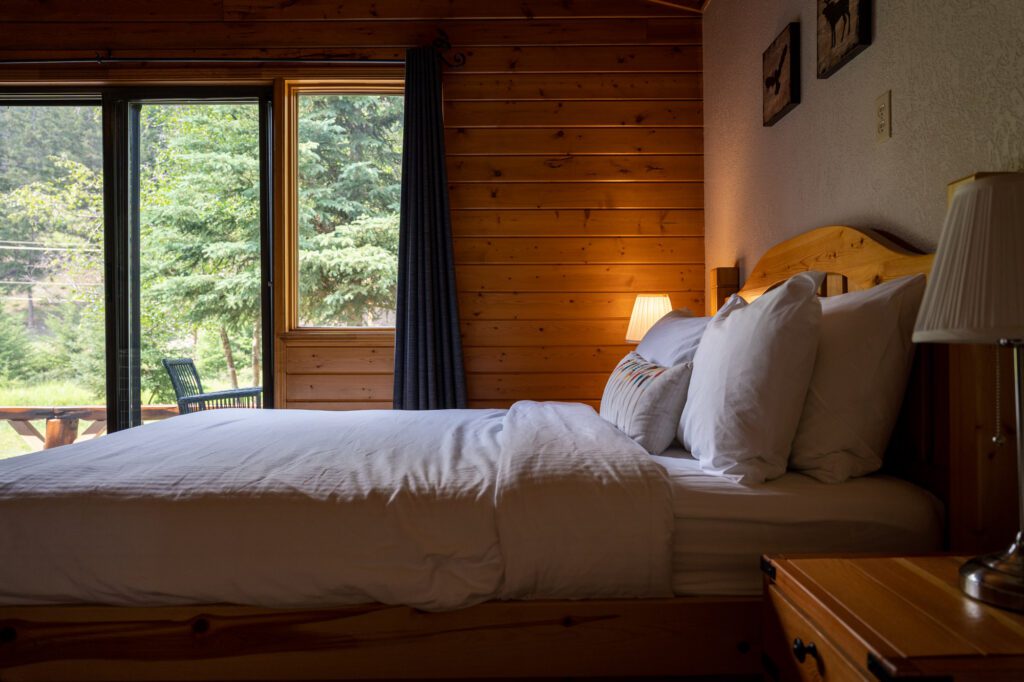
Jasper is a little more straightforward than Banff because you really only have two options here.
Your first option is staying at one of the many hotels right in town, which puts you within walking distance of all the amenities like grocery stores, restaurants and bars, and shopping in downtown Jasper.
Your second option is staying somewhere outside of town, which is going to be a more rustic experience, but is less convenient when it comes to accessing those aforementioned amenities.
For what it’s worth, we stayed at Bear Hill Lodge on our last trip, and absolutely loved both the cabins themselves, and the proximity to downtown Jasper (it’s a 10-15 minute walk).
Our other recommendations here would be either Pine Bungalows Resort , which is right across the river from downtown (though it’s not walkable), or the Pyramid Lake Lodge , which (as you might guess) is right on the shores of Pyramid Lake just outside of downtown Jasper.
Staying Near Lake Louise
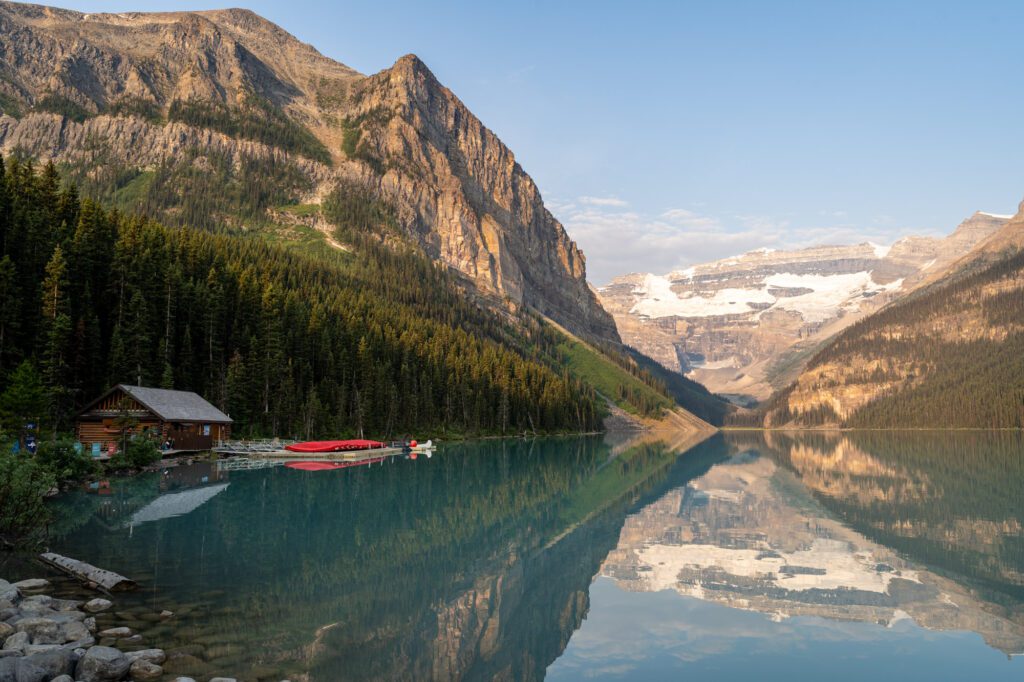
As we’ve already covered, we really think the best way to experience Lake Louise is to stay nearby, which is what we’ve done on our trips, and we haven’t regretted it one bit.
There are very, very few options near Lake Louise when it comes to hotels, and there are two that stand out to us as a good value (we’re not counting the Fairmont Lake Louise here, which is far out of our budget).
The two options we’d recommend are Paradise Lodge and Bungalows , which is where we stayed on our first trip and it has since been renovated and expanded, and Basecamp Baker Creek , which is a little further out, but looks like a lovely place to stay operated by our favorite hotel company in the Canadian Rockies.
The other great option is Lake Louise Campground , which you’ll need to reserve basically when the window opens in the spring (that’s what we did).
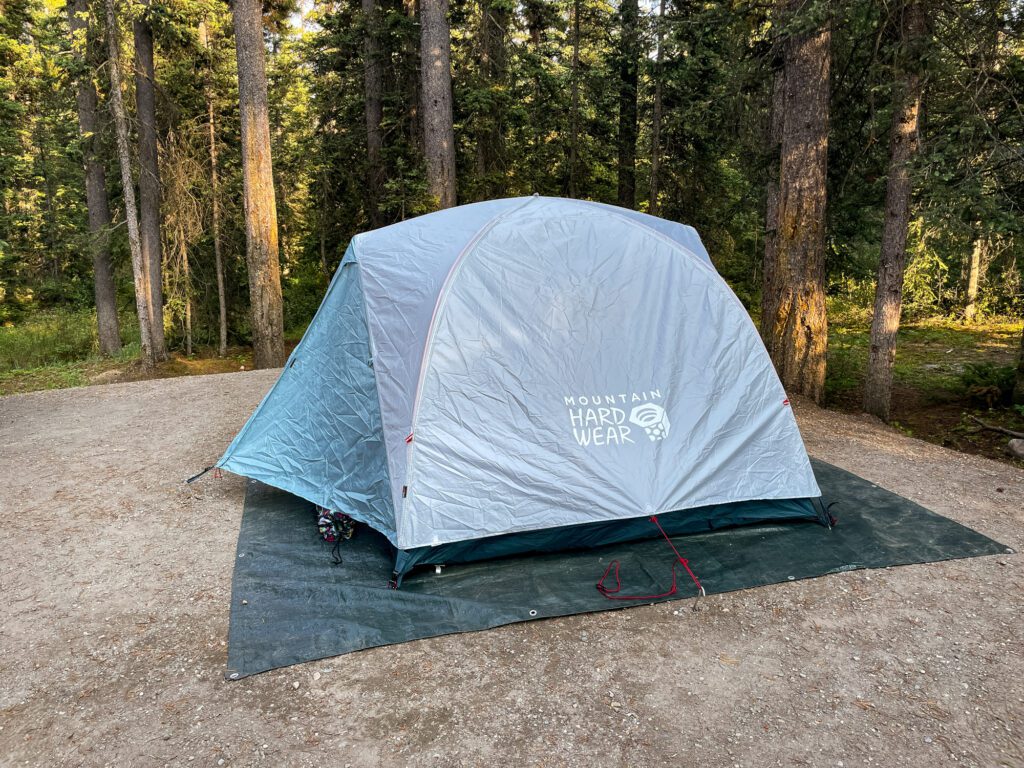
You can read more about the reservation procedures here , which are far more structured and relaxed than the US National Park processes. Obviously, that only works if you have camping gear with you.
The Best Time to Do This Road Trip
Summer and early fall, between July and mid-October, is going to be the best time to do the road trip we’re going through in this guide .
You’ll have the best weather, snow-free trails and roads, and longgggg days (we’re here in July, and sunrise is at 5:30am, sunset is at 10pm) to explore.
The big downsides of summer are crowds and prices , and they’re somewhat related. Summer is, by far, the most popular time to visit, which means trails are packed, and prices in Banff and Jasper are at an all-time high.
If you’re visiting in the summer, you’re going to want to book your accommodations as early as possible, too. Same with campsites – book them on the day they go on sale (which you can find here ).
Banff is a good winter destination, too, but that trip is going to look very, very different, with more skiing and snowshoeing, and less driving around and hiking. Keep in mind that winter driving is serious business in the mountains, and many roads require winter tires from October/November to April.
This is particularly important for the Icefields Parkway, which closes intermittently in the winter due to storms. Once you drive it yourself, you’ll understand why it wouldn’t be ideal to drive it during a winter storm.
Things to Know Before Your Trip to the Canadian Rockies
We’re going to use this section to cover important logistics – like shuttles, permits, and safety tips – that you should know before you hit the road.
- Park entry fees and passes . You’ll need to pay a fee when you’re in any of the national parks on this itinerary. You have two options – buying a pass for the number of days you need it for, or buying a Discovery Pass, which gives you access to all national parks in Canada for a full year. At a high level, the math on the Discovery Pass works out if you’re spending 7 days or more in the parks ($10.50 per day, $72.25 for an annual pass) though there are some permutations around family passes that might make the math change in your particular instance. You can buy both versions at the park entrance stations, or online in advance .
- Remember that you’re at elevation . The town of Banff sits at 4,500 feet above sea level, and Lake Louise is at 5,250 feet above sea level (Jasper is slightly lower). Two things to know here – stay hydrated, and give yourself a day or two to acclimate if, like us, you’re coming from around sea level. This is the reason we have you starting off with a lower intensity hike on the first day of the itinerary below.
- Expect it to be busy busy busy . If you’re in the Canadian Rockies in the summer, don’t expect to find a whole lot of solitude unless you head into the backcountry (and even then…). The best way to avoid crowds is to get a very, very early start. We arrived before 8am to trailheads (before 7am at Lake Louise), and found that we were often one of the first few groups on the trail, with far more people coming up the trail as we headed down.
- Book your Lake Louise and Moraine Lake shuttles ASAP . Especially if you want to get on one of the early morning departures, which you should. We’ll cover getting to Lake Louise below (if you choose to drive, get there before 7am to secure parking and be ready to pay $21 for the day), but Moraine Lake is only accessible via shuttle, and it’s SUPER competitive. You need to book it in advance, which means you’re unfortunately going to have less flexibility when it comes to weather. More information on the shuttles here .
- Know where to find gas stations . You’ll want to have a full tank of gas as you start your drive on the Icefields Parkway, because there’s exactly one gas station between Lake Louise and Jasper at the Saskatchewan River Crossing, and it’s more expensive than getting gas elsewhere. There are plenty of gas options in Canmore, Banff, Lake Louise, and Jasper.
- Wildlife is…wild . Banff and Jasper are amazing places to see wildlife. On this last trip, we saw Grizzly bears, black bears, elk, moose, bighorn sheep, mountain goats, tons of marmots, among other things. However, it is very very important that you remember that these are wild animals we’re talking about, and your actions impact their lives. Give them plenty of space, and avoid stopping in the middle of the road to gawk at them (though this inevitably happens – make sure to pull off the road and stay in your vehicle). Read this Parks Canada guide to responsible wildlife viewing before your trip.
How to Plan a Picture Perfect 10 Day Canadian Rockies Itinerary
And now, on to the actual itinerary!
We’ve written this as a day-by-day itinerary, with suggestions on exactly how to spend each day.
Obviously, as you’re planning your own trip, things are going to come up like shuttle availability and weather.
So, while you could just copy and paste this itinerary, you’re probably going to have to shift some things around.
That being said, we’d strongly recommend keeping the Banff-Jasper-Lake Louise structure intact, if you can.
Remember that structure as you’re reading through the itinerary, because it means that the highlights of Lake Louise and Moraine Lake are at the end of this itinerary (days 8-10), where you’ll find some useful tips on accessing the lakes, hiking, and more.
Day 1: Arrive in Calgary, Drive to Banff, Two Jack Lake for Sunset
Your first day is going to be at least half travel time, depending on when your flight lands in Calgary. We’d strongly recommend booking the earliest possible flight in (and the latest one on the way out) to maximize your time in the Canadian Rockies.
You’ll land in Calgary (assuming you’re flying in) and head over to the rental car agency to pick up your car.
It takes about two hours to go from the airport to Banff, depending on traffic and where exactly you’re going. Head to your accommodations, check in, drop your bags, and set out for an afternoon of exploring nearby.
If you’re not flying into Calgary to start your trip, you’ll want to make your way to Banff (and you’ll likely have an extra half day or so in and around Banff to hang out).
Lake Minnewanka & Scenic Drive
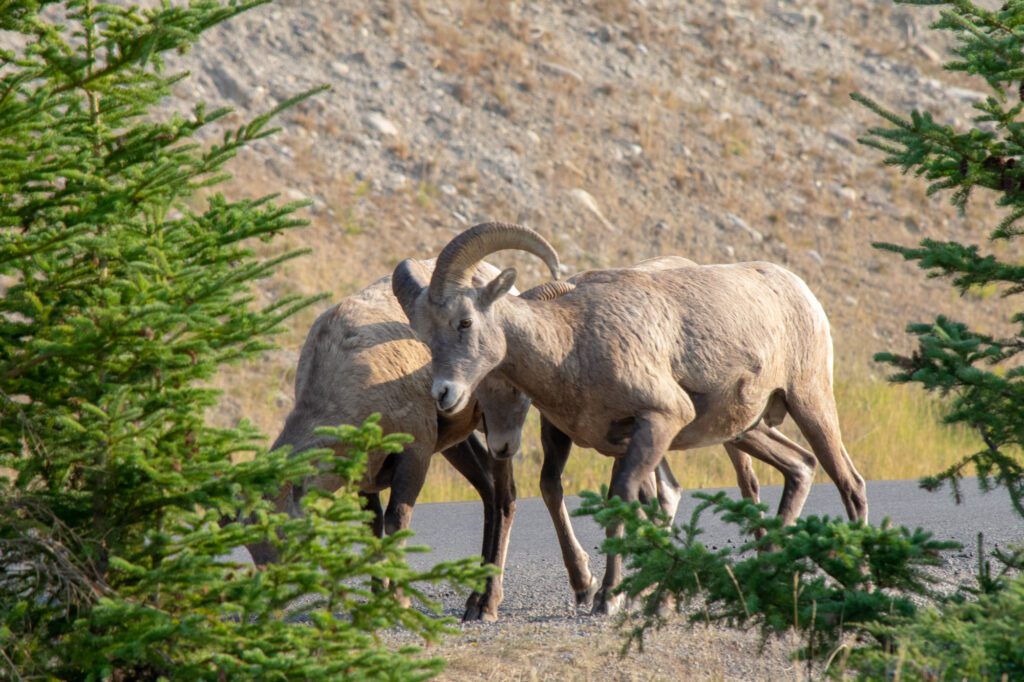
Your first stop is going to be Lake Minnewanka, which is a massive lake out to the east of Banff. It’s only about 15 minutes away, but by the time you’re on the lake, you might as well be in the middle of nowhere.
The drive out to the lake (and between this lake and Two Jack Lake, which is SPOILER ALERT your next stop) are particularly good places to see wildlife like bighorn sheep and elk. We’ve seen both, multiple times, along this road.
There are a couple of things to do at Lake Minnewanka, and the first is definitely the boat cruise (which we skipped because of the dog, but we absolutely would have done it if we were sans Lupine).
The cruise takes you out to Devil’s Gap at the far end of the lake, and brings you back. More information here .
The second thing we want to call out is renting a canoe or kayak . The lake is huge – it’s 13 miles long! – and it’s impossible to get very far on foot (more on that in a second). Getting out on the water in your own watercraft will allow you to get out to different parts of the lake that most people never make it to.
The third and final thing is hiking around Lake Minnewanka . There are two trails in particular that we’d consider.
The first is the simple lakeshore trail , which isn’t totally flat, but also isn’t a huge climb and would make a good first hike as your body gets acclimated to the elevation in the Rockies. This is a nice option because you can easily customize it to how you’re feeling, going for a mile or two and then turning around, or going the entire way to the end of the maintained trail.
The second is C-Level Cirque , which is a short but intense hike up to a rocky bowl with great views back towards the lake. It does involve some scrambling near the top, but it’s relatively easy compared to some of the other scramble trails in the area.
Two Jack Lake at Sunset
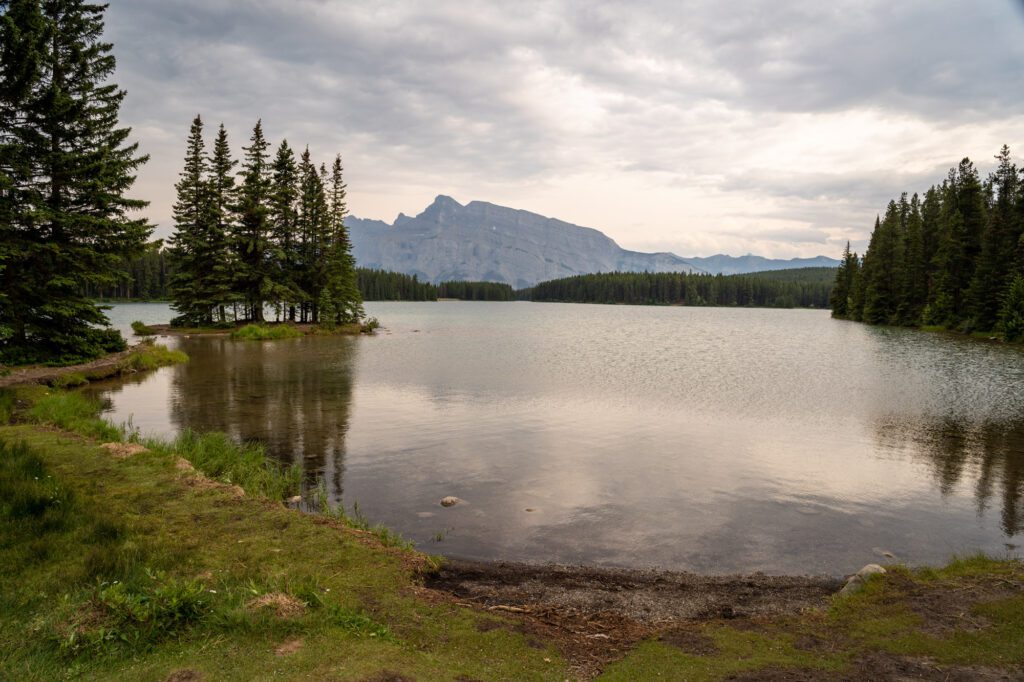
Spend your first sunset in Banff at nearby Two Jack Lake, which is a smaller (but arguably equally picturesque) lake near Lake Minnewanka.
Park in the lower parking lot and grab one of the picnic benches, either on the beach right there, or on the little spit out to the right, and watch the golden glow of the setting sun over the silhouette of Mount Rundle in the distance.
Day 2: Vermillion Lakes, Johnston Canyon, & the Town of Banff
On your first full day in Banff, start with an early morning (ideally, sunrise) trip out to Vermillion Lakes to admire the reflection of the curved peak of Mount Rundle in the still water of the lake (and look for elk and moose along the shoreline).
Then, tackle your first hike of the trip into Johnston Canyon (with an optional extension to the colorful ink pots) before spending the afternoon and evening in the town of Banff.
Vermillion Lakes
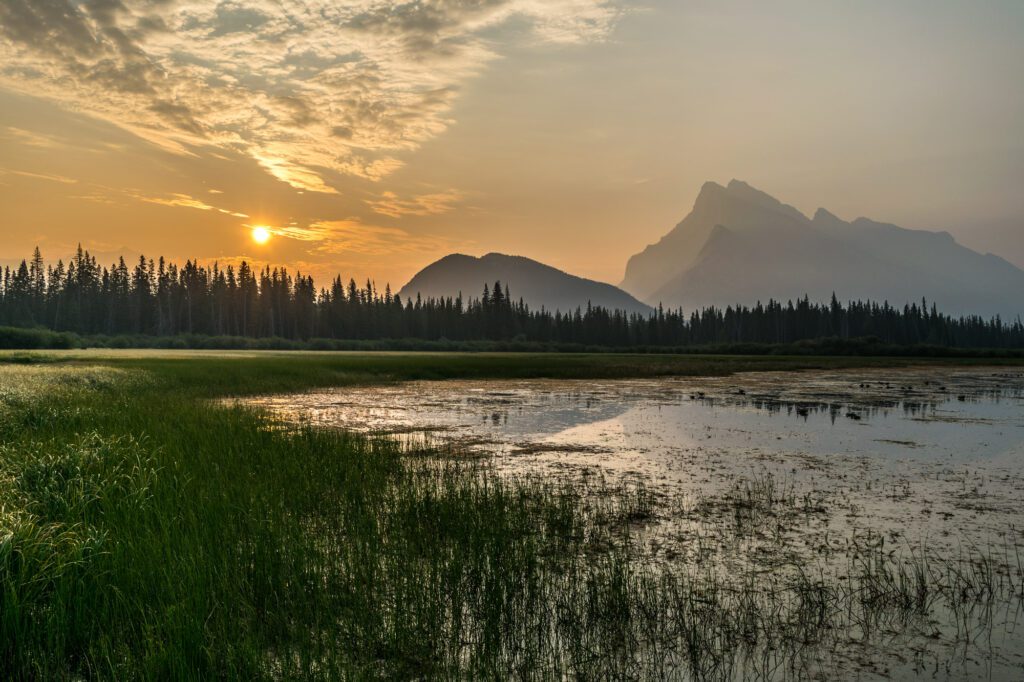
We love Vermillion Lakes at any time of day, but it’s particularly special in the early morning and late evening hours when the water of the lake is calm and you have the chance to get a perfect reflection of Mount Rundle in the still water.
This is a very popular spot for photographers for obvious reasons, and our favorite photo spots are along the stretch of shore just outside of town ( here on Google Maps).
This also happens to be a great place to see wildlife – we have seen elk along the road, and a variety of birds out on the lake (plus, muskrats).
Johnston Canyon (and the Ink Pots?)
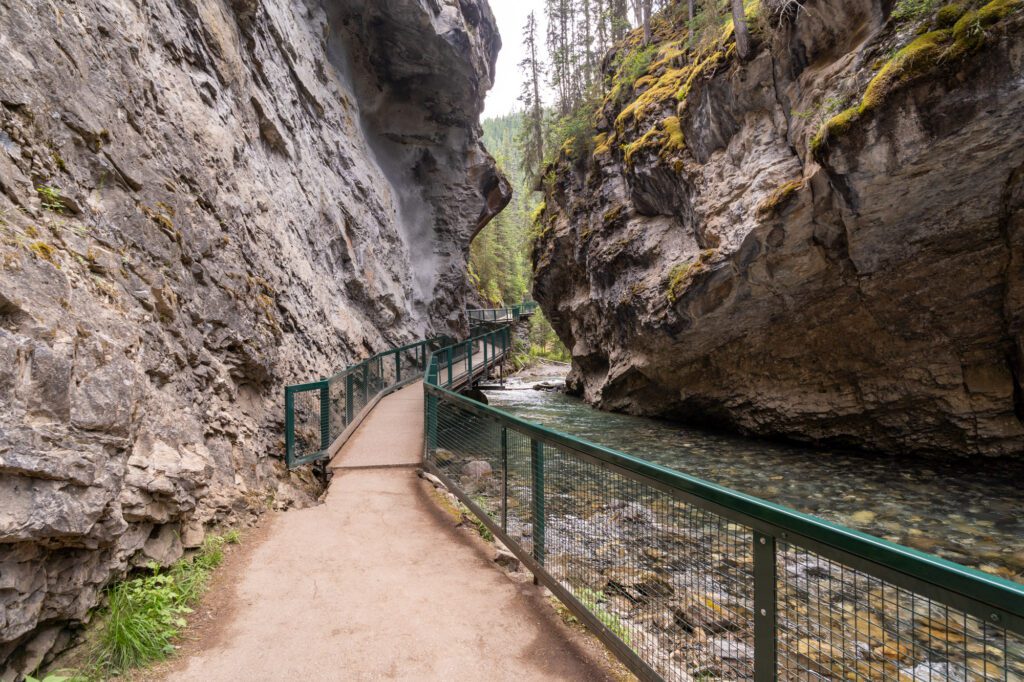
From Vermillion Lakes, head over to the Bow Valley Parkway to start the drive to your hike for the day, Johnston Canyon (with an optional extension for the Ink Pots).
Johnston Canyon is a unique experience, but it’s one that you really need to have before the crowds show up. We would arrive NO LATER than 8am or so for this hike, but the earlier the better .
At about 10am, the narrow boardwalk is packed with people. We know, because we came back down the trail and spent two miles trying to keep Lupine on one side of the narrow boardwalk when there were just SO MANY PEOPLE to get pets from.
The hike is worth it, though. You’ll follow a boardwalk through a canyon with high walls and a river running through it, and the crown jewels of the hike are the upper and lower falls.
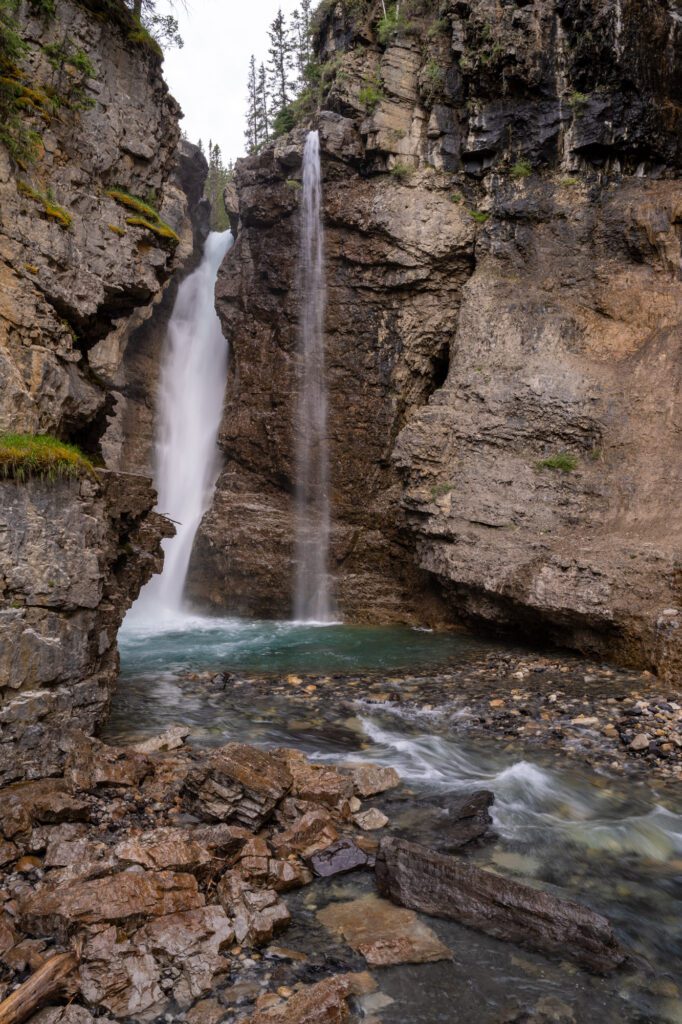
Looking for another reason to get an early start? The lineup to see the falls at 11am or so was wild.
Here’s a picture.
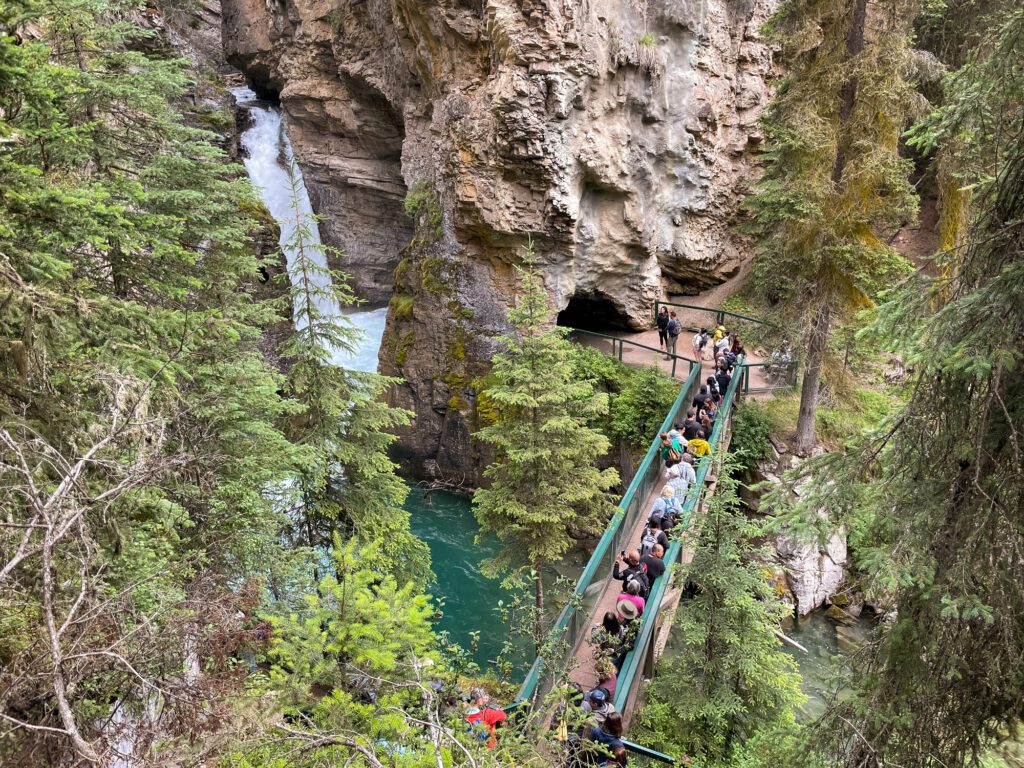
Looking to escape the crowds? We have some good news. The vast majority of people only go to one or both of the falls, which means you’ll have the continuation of this hike out to the Ink Pots – colorful pools in a beautiful valley – largely to yourself.
To get to the Ink Pots, it’s about a 2 mile hike in the woods, climbing the entire way. It’s a bit of a slog – there are no views or redeeming features of that stretch of trail to speak of – but the end point is worth it, we thought.
The Ink Pots are cool because they’re formed by thermal activity, but they’re not hot like thermal pools in Yellowstone, for example.
If you look closely at the bottom of the pools, which is made easy by the fact that they’re completely clear, you’ll see little swirls at the bottom which is where the water is coming up from below.
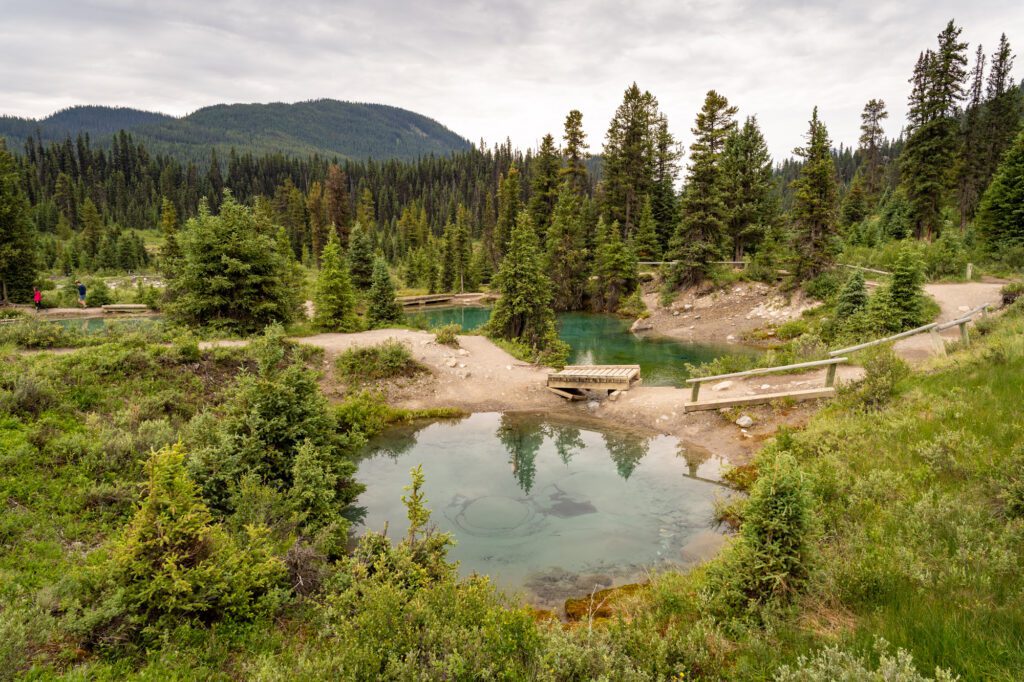
They’re particularly stunning on a sunny day, when the rays of the sun make them vibrant and bright, but we were there on a cloudy day and still thought it was worth the journey.
Exploring the Town of Banff
Spend your afternoon in and around the town of Banff, which is on the one hand very “touristy” in the sense that nearly everyone you’ll encounter outside of service workers is a tourist, but also has some pretty cool spots to check out.
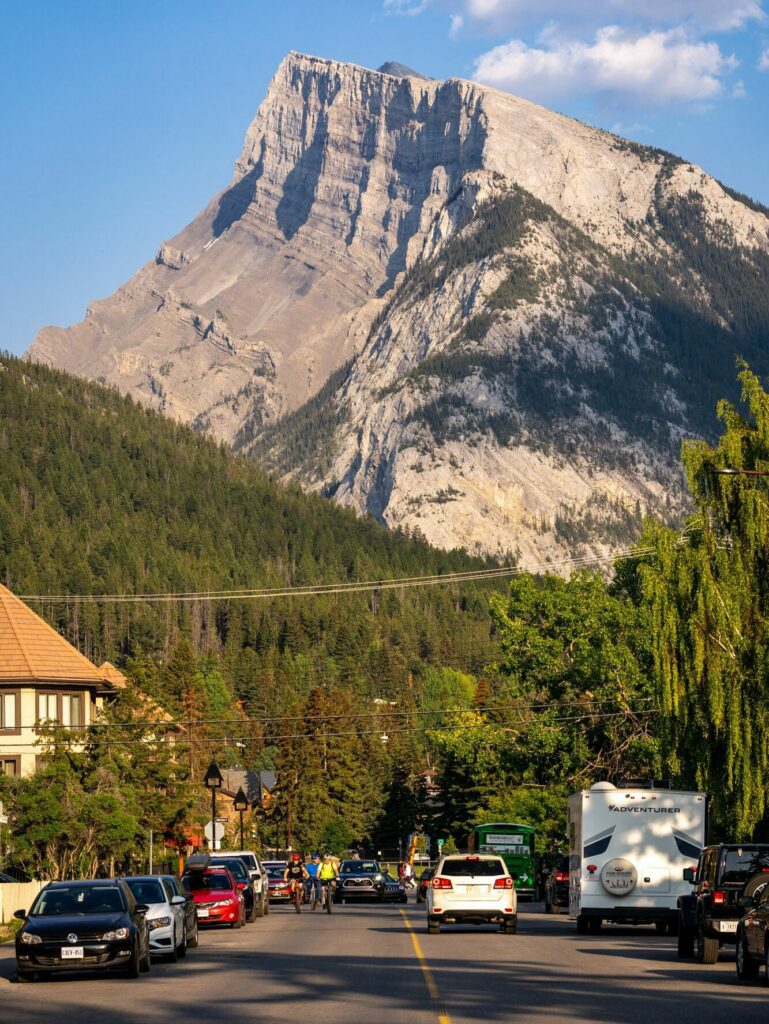
The main drag in town is (unsurprisingly) called Banff Avenue, and it’s where you’ll find the vast majority of restaurants, shops, and other places of interest in that vein. However, there are also a couple of walkable/driveable places with nice views that are worth seeking out.
Here are a few of our favorites.
- Surprise Viewpoint: This is the classic view of the Fairmont Banff Springs Hotel backed by the mountains. You can walk there from town, but it is uphill along a busy road. However, that’s probably preferable to navigating the parking situation, which is usually full of tour buses.
- Bow Falls: Probably not the most impressive waterfall you’ll see on this trip (especially if you make it over to Yoho National Park), but definitely the most accessible from downtown Banff thanks to the short flat riverside trail. Arguably the best views are actually not of the falls, but of the mountains towering over town (Norquay and Rundle).
- Cascade of Time Garden: This was Alysha’s discovery, and it’s worth walking through on your way back to town. It’s a little oasis with nice views of downtown Banff and some fun landscaping.
If you’re up for a little more walking, you can do all three of them as a fun little loop from town. Here’s a map of what that looks like.
There are also plenty of bars and restaurants in town for dinner and drinks.
Here’s the Eater guide for the Canadian Rockies for some inspiration. Special shout outs for the Balkan (where we’ve eaten and enjoyed) and to the Bistro at the Juniper Hotel for the views (we haven’t eaten there, but have admired the views and considered it).
Day 3: Choose Your Own Hiking Adventure & Canmore
On your second full day in and around the town of Banff, enjoy a morning hike before heading down the road to Canmore, a charming little mountain town that quickly became our favorite place to go to eat, drink, and shop.
Choose Your Own Hiking Adventure
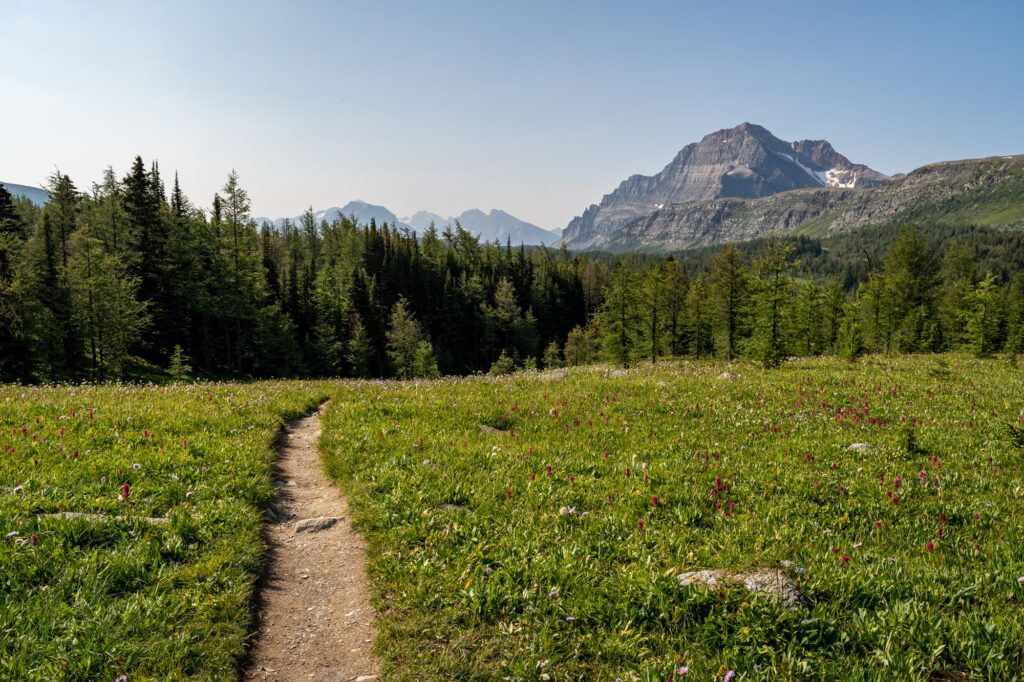
While we like to hike a bunch of miles a day when we’re in the Canadian Rockies (less so as we get older and recovery becomes harder!), we also recognize that not everyone is up for 10 miles a day.
For your hike today, you have a few options depending on what you’re up for.
If you are up for some mileage, we highly recommend Healy Pass . It’s a long hike, but it’s relatively easy in terms of elevation gain and intensity.
And the views from the pass are downright magical, especially in the early summer when the meadows are blanketed in wildflowers and fall when the larches are golden.
- Healy Pass (11.1 miles / 2,814 feet elevation gain): We loved this hike. It’s a must-do if you’re in the Rockies in early summer (call it mid-July?) for the stunning wildflowers or mid-October when the larches are lighting up. From the pass, you have a nice view of the Ramparts and the Monarch in one direction, and the peaks backing Egypt Lake in the other. It also leaves from the Sunshine Meadows parking lot, which is giant, which means there’s no parking nightmare.
- C-Level Cirque (5.8 miles / 2,490 feet elevation gain): We mentioned this earlier as an option around Lake Minnewanka, and we’re mentioning it here again as a moderate option that’s an easy drive from Banff. You climb up through the forest for the first few miles before emerging into a rocky bowl, at which point it’s a quick scramble up to a viewpoint back towards the lake.
- Tunnel Mountain (2.7 miles / 879 feet elevation gain): If you’re looking to take it easy for the day, we really enjoyed Tunnel Mountain. It’s a quick drive (or walk, depending on where you’re staying) from Banff, and the trail is the kind that gets you sweating a little bit, but not so much that you can’t wear those same clothes later. There are some nice views out in both directions from along the trail, with the final view looking out over Banff and the valley beyond.
Exploring Canmore
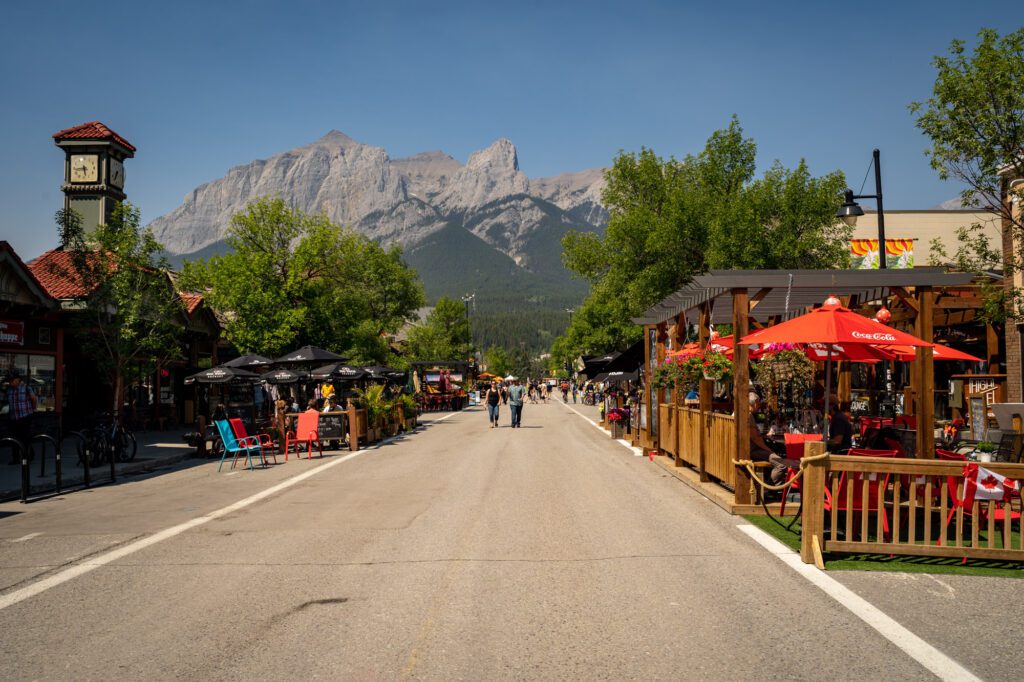
For the afternoon, head 15 minutes east from Banff over to what turned out (again) to be our favorite town in the Rockies, Canmore.
We liked Canmore so much that, while we will definitely be back to the Canadian Rockies and Banff National Park, we will likely never ever stay in the town of Banff again. It’s all Canmore for our future selves!
Canmore is our ideal version of a small-ish mountain town, because while it is very clearly on the tourist track (it’s 15 minutes from Banff, though it is technically outside of Banff National Park), it also feels like people actually live there. Which is not something we’d ever say about Banff.
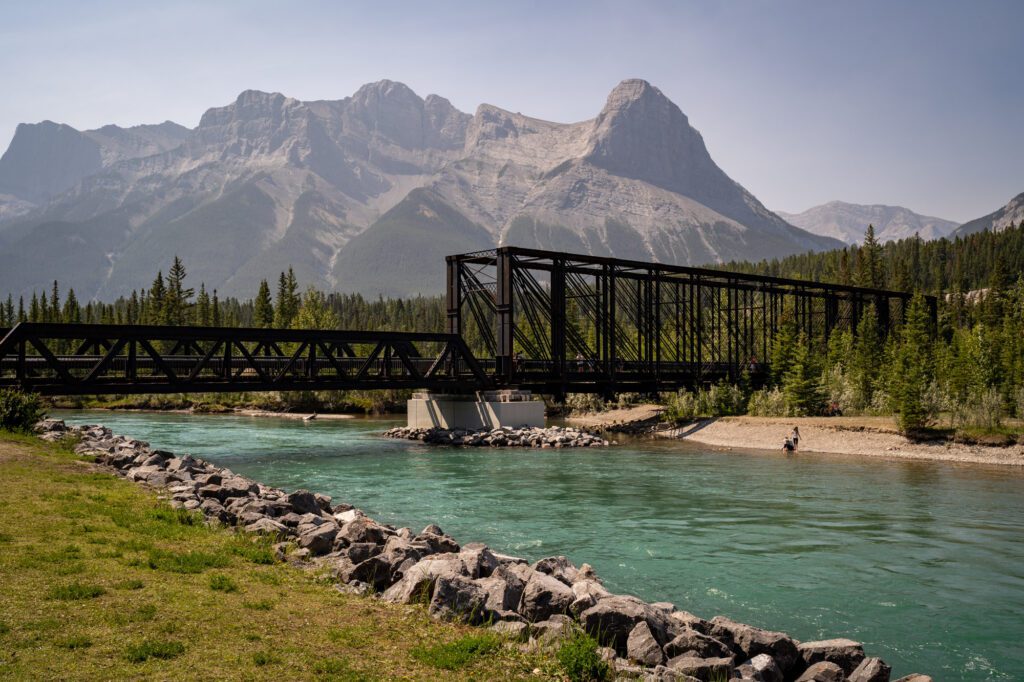
The fact that people actually live in Canmore (the population has been increasing, especially since the events of 2020 and the rise of remote work) means that, unlike Banff where, for example, there is not one single good coffee shop, there are a bunch of businesses catering to both tourists and locals.
And it’s truly just as beautiful as Banff, with downtown Canmore sitting along the Bow River, backed by the Three Sisters – which you’ll see and hear a lot about in the brief time you spend in Canmore.
Similar to Banff, there’s one main drag in Canmore – 8 Street – and that’s where we’d recommend you start with your explorations.
Here are a few of our favorite spots in Canmore.
- Eclipse Coffee : This was a recommendation from the barista at Prototype Coffee , one of the best coffee shops in Vancouver , and I’m so glad I mentioned that the Banff area doesn’t have any good coffee because I was SO wrong. They have two locations – one right on the main drag, and one over near the Safeway in a strip mall – and they roast their own beans. If you’re looking for good coffee in Canmore, head straight to Eclipse – do not pass go, do not collect $200.
- Mixed Culture : For the best selection of craft beer, cider, and wine in Canmore, go here. This is another one we stumbled upon, and the owner was extremely helpful in helping us choose some ciders AND gave us a great tip on finding wineries in the Okanagan Valley by connecting us with his natural wine distributor’s online guide. Highly recommend if you’re looking for some cans or bottles to enjoy at camp, or at a lake, or basically anywhere.
- Core Values Cider : On the recommendation of the owner at Mixed Culture, we moseyed over here to find them working hard on their new taproom, which should be open now (late summer 2023). I was definitely not expecting to find a cidery in Canmore, but here it is! They specialize in dry, wild-fermented cider too, which is very much in our wheelhouse.
- Communitea : We’ve now eaten here four or five times over a few trips, and are deeply in love with this little corner cafe in Canmore with a great food and tea menu. We like the Pad Thai (even though it’s not REALLY pad thai, if we’re being honest) and basically all of the salads and bowls. Good gluten free options, too).
- Stonewaters : We stumbled upon this cool store, which is a fun place to pop into for locally made (mostly, anyway) gifts, cards, and other fun stuff.
- Lovely Ice Cream : Right outside of Stonewaters is a little cart slinging cups of ice cream and ice cream sandwiches, all gluten free! We went here multiple times, and would recommend it for a nice sweet treat.
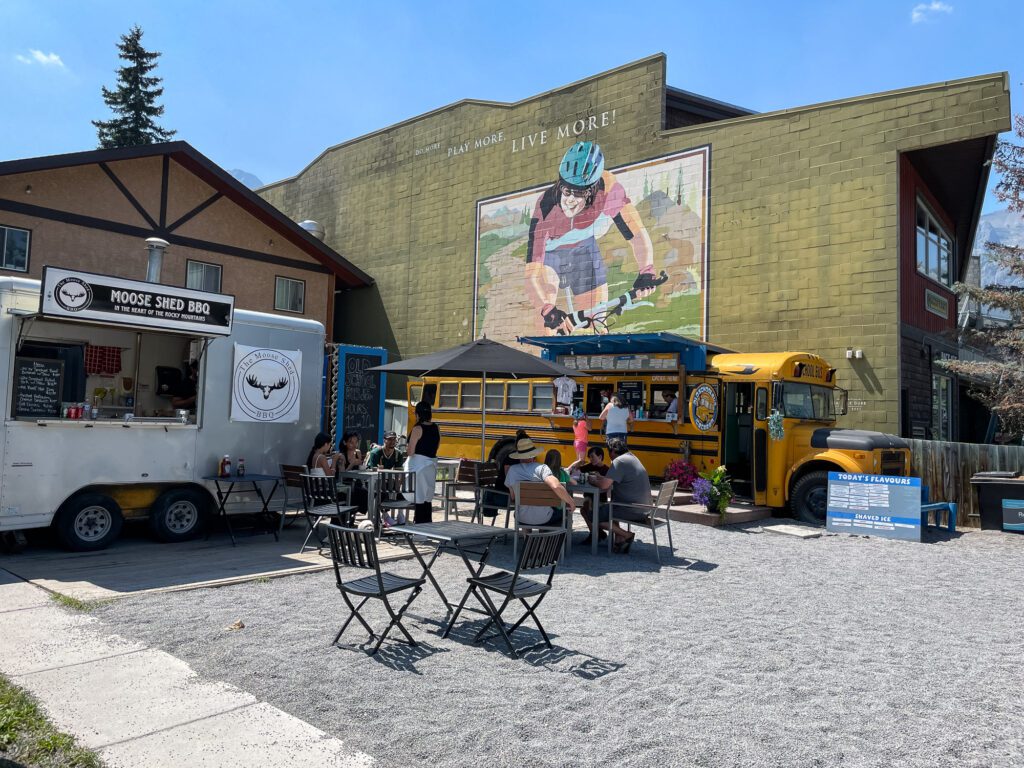
Aside from the food and drink (and shopping) scene, there are a few other spots in Canmore that are worth your time.
- Bow River Trail: We don’t have a specific route, but we do think you should walk along the river out to the Canmore Engine Bridge ( here on Google Maps), which is a cool view with the bridge in the foreground over the river, with the Three Sisters in the background.
- Three Sisters Viewpoint: This is a drive from downtown, but it’s the best view of the Three Sisters. It requires some navigation (park here and walk under the railroad tracks), but there’s a little pond with a nice reflection of the peaks. If you’re into photography, it’s worth coming back at sunrise, when the alpenglow lights up the Sisters just before the sun crests the horizon.
- Grassi Lakes & Quarry Lake: Some short hikes near Canmore, also with nice views of the Three Sisters. Quarry Lake is in a nice park with an easy, flat trail along the lakeshore. Grassi Lakes is a little more involved, and takes you out to a couple of bright greenish-blue lakes.
Mount Norquay for Sunset
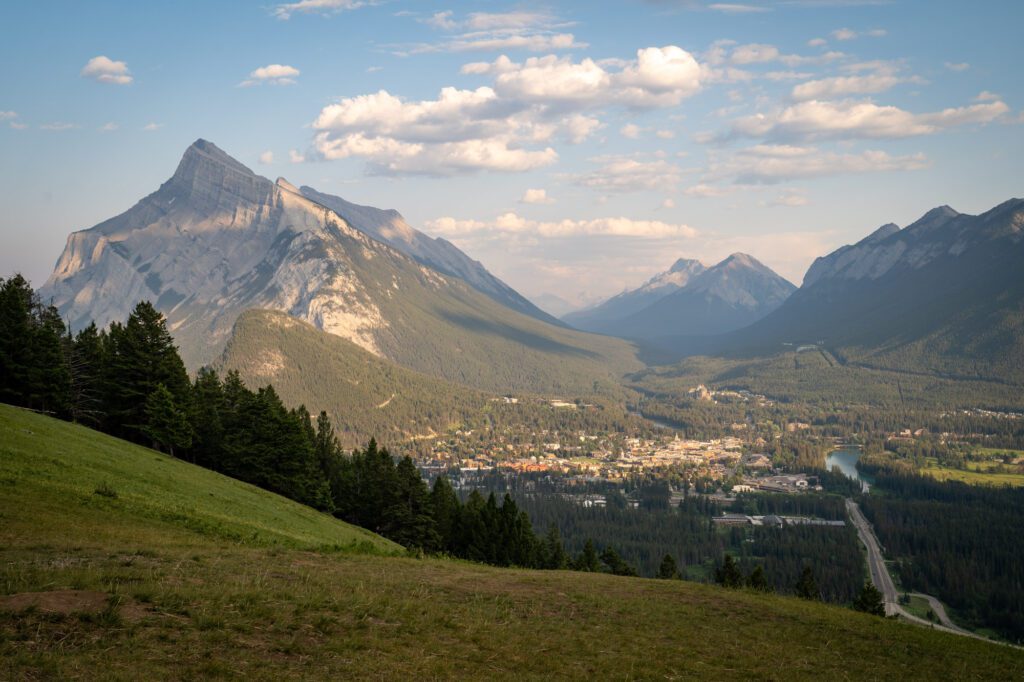
End your day up at Mount Norquay, which is across the Trans-Canada Highway from the town of Banff.
This was, perhaps, our favorite discovery of our time in Banff itself, because it’s hard to beat the view of Rundle towering over the city from the grassy slopes just below the parking area for the ski resort (which is what Mount Norquay is really famous for in the winter).
The lookout is almost the entire way up the mountain ( here on Google Maps), and this would be an excellent place to watch the sunset with one of those beers, ciders, or wines that you got at Mixed Cultures in Canmore earlier in the day.
Plus, this is one of the better places in Banff to see Bighorn Sheep – we saw a family (including babies) on the road on the way up, and got out the telephoto lens to watch them frolic a little bit.
Day 4: Driving the Icefields Parkway from Banff to Jasper
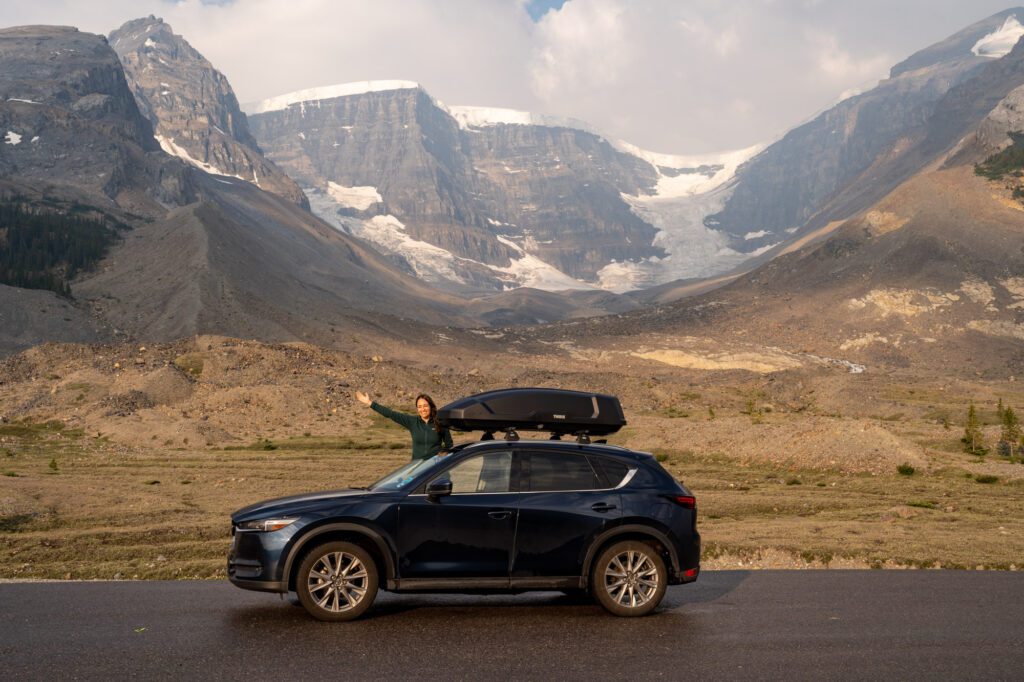
Today, the star of the show is the Icefields Parkway, which is the incredibly scenic drive from Banff to Jasper that will leave your jaw on the floor of the car at every bend in the road.
The first time we ever did this drive, it was so smoky that you could not see 50 feet in front of you, so we truly had no idea what we were missing until we came back down from Jasper on a clear day, and were flabbergasted at the sheer natural beauty on display along this two and a half hour drive.
We’ve allocated basically a day and a half of this itinerary to this drive, and we’d definitely plan on taking your time here, stopping often for short walks out to viewpoints.
We have an entire guide to driving the Icefields Parkway , which you should read for a full list of all the stops we’d recommend along the way. Here is a selection of our favorites, including a great hike to do along the way.
If you miss a stop on the way up, you have to make the drive back down in a couple of days anyway, so you can hit it then!
The Helen Lake Trail
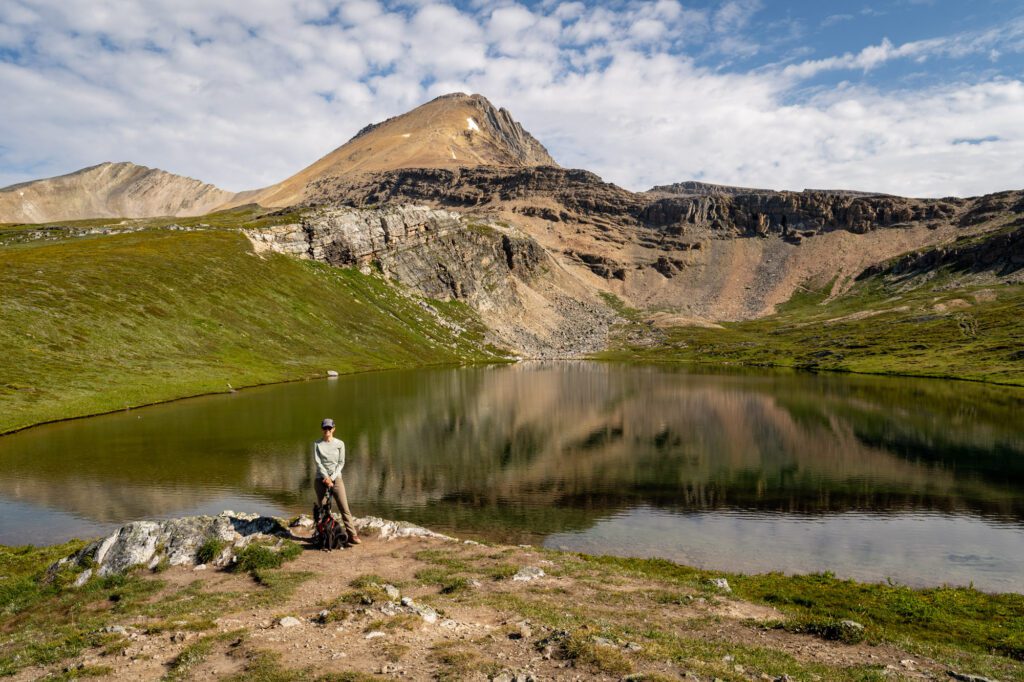
The trailhead for Helen Lake is just across the Icefields Parkway from the first Bow Lake viewpoint, and it fills up in the morning on most summer days.
The trail climbs through the forest for the first mile and a half or so, oscillating between mostly flat sections and sections that are surprisingly steep and rocky, making it seem harder than it is.
As you climb, you’ll start to get some nice views of Bow Lake behind you, so make sure to turn around and admire it when gaps in the trees appear.
The real show starts when you get above the treeline into a vast alpine meadow, full of flowers and marmots galore (at least in the early summer).
This stretch of trail is excellent, and it’s a slight uphill grade all the way up to the lake.
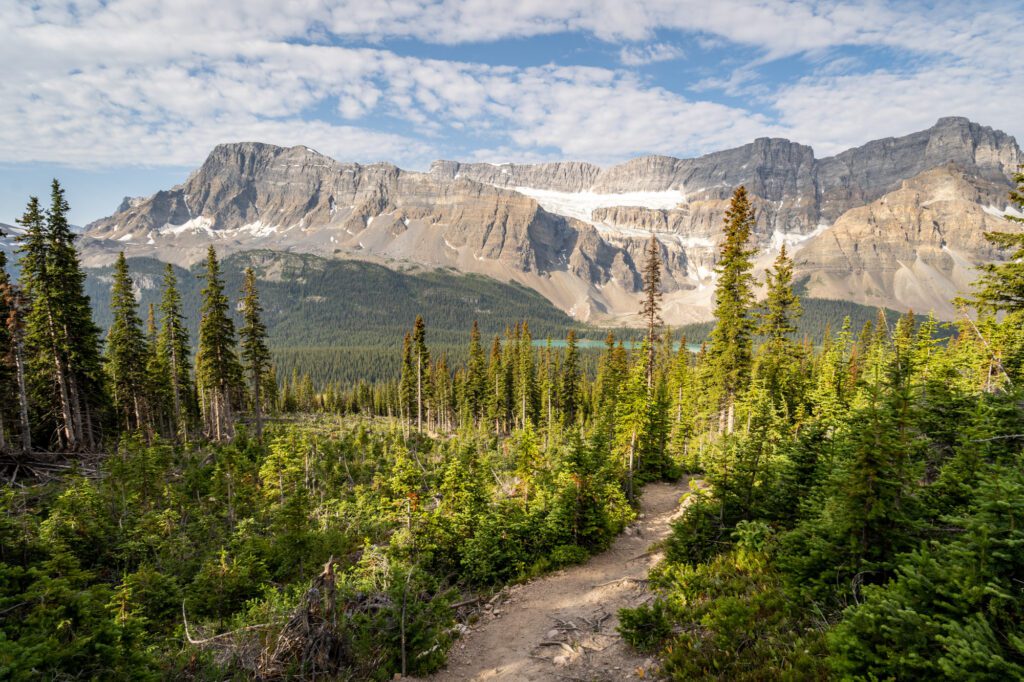
From the lake, you can continue on to the top of Cirque Peak, the mountain you see on the far side of Helen Lake. It’s another few miles (round trip), and double the elevation gain (including scrambling and route finding), so it’s not for the faint of heart.
We skipped it, but we did go around the lake and climbed the switchbacks on the far side to get a view back over the lake, which we’d recommend.
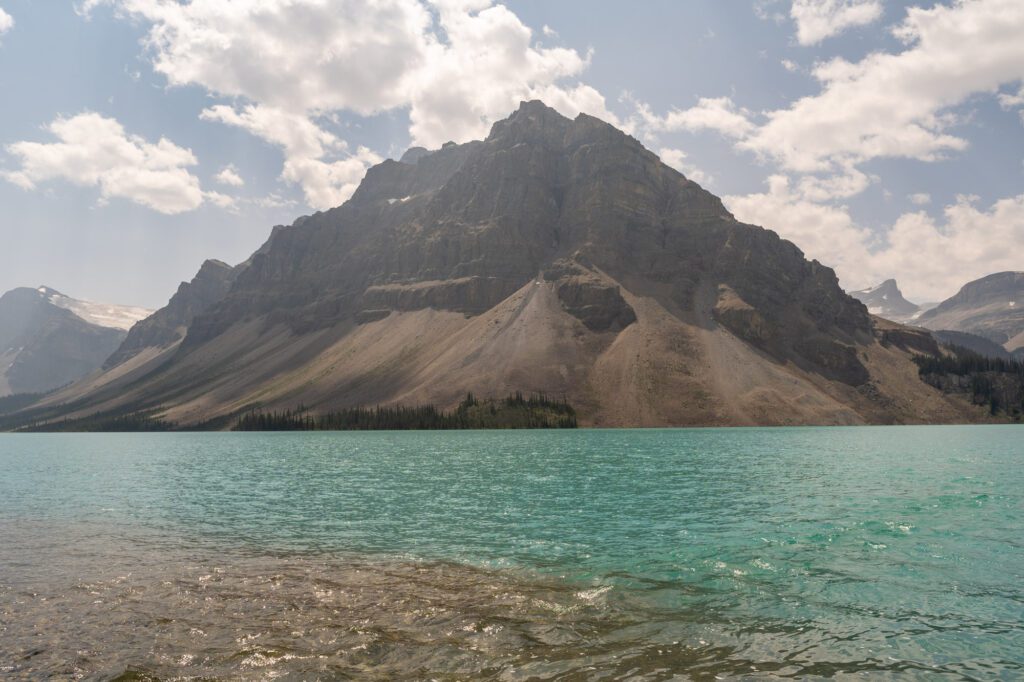
Bow Lake is one of the many majestic glacial lakes on the Icefields Parkway that features that brilliant turquoise water thanks to the glacial sediment in the water. It’s backed by Crowfoot Mountain (and the glacier of the same name).
There are two things to do at Bow Lake.
The first is to stop at the Bow Lake viewpoint , which is basically right across the road from the Helen Lake trailhead ( here on Google Maps). From there, if you get down to the water level, you have a great view of Crowfoot Mountain across the cloudy blue water of the lake.
The second is to park at the historic Num-Ti-Jah Lodge on the northern shore of the lake and explore that area.
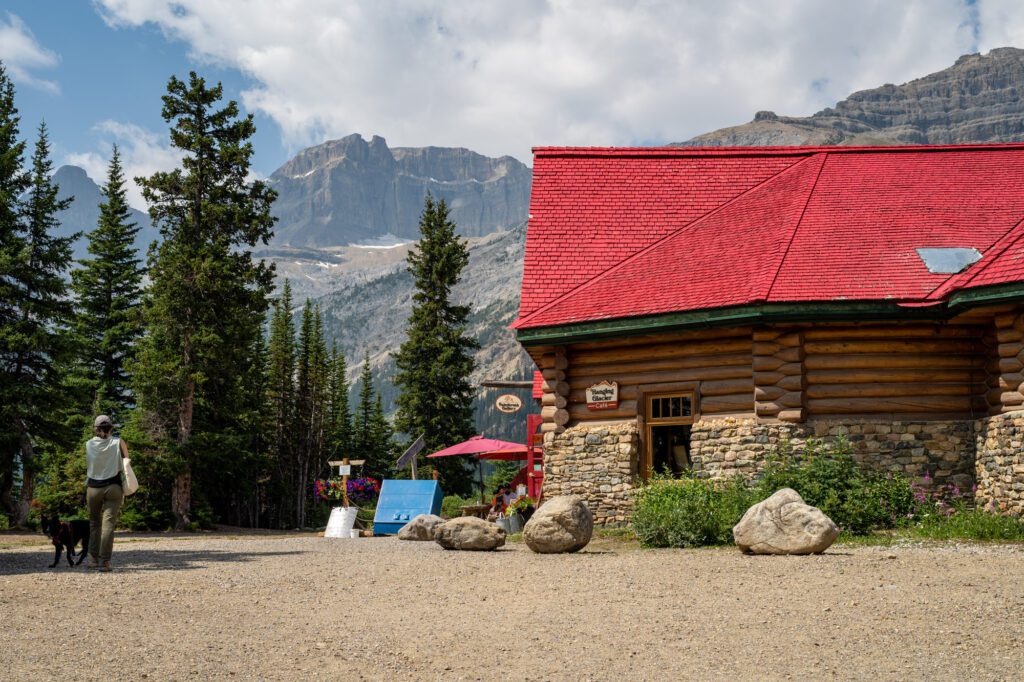
The cafe at the lodge, which has a nice little outdoor patio, is a good place to grab a snack and a cup of tea or coffee (or in our case, a well-earned cider from Core Values in Canmore).
Just a few steps from the cafe is the lakeshore, which has some pretty spectacular views.
We definitely think you should leave the crowds behind and walk out along the northern shore of the lake for a bit, where you’ll get a nice view of Crowfoot and a distant view of Bow Glacier falls in the distance.
If you’re up for it, there’s also a hike around the lake up to Bow Glacier Falls .
We skipped it, opting to do Helen Lake, Wilcox Pass, and Parker Ridge instead. However, all three of those hikes are fairly intense, while Bow Glacier Falls is in the easy/moderate category. It’s a good option if you’re looking for something a little more low-key.
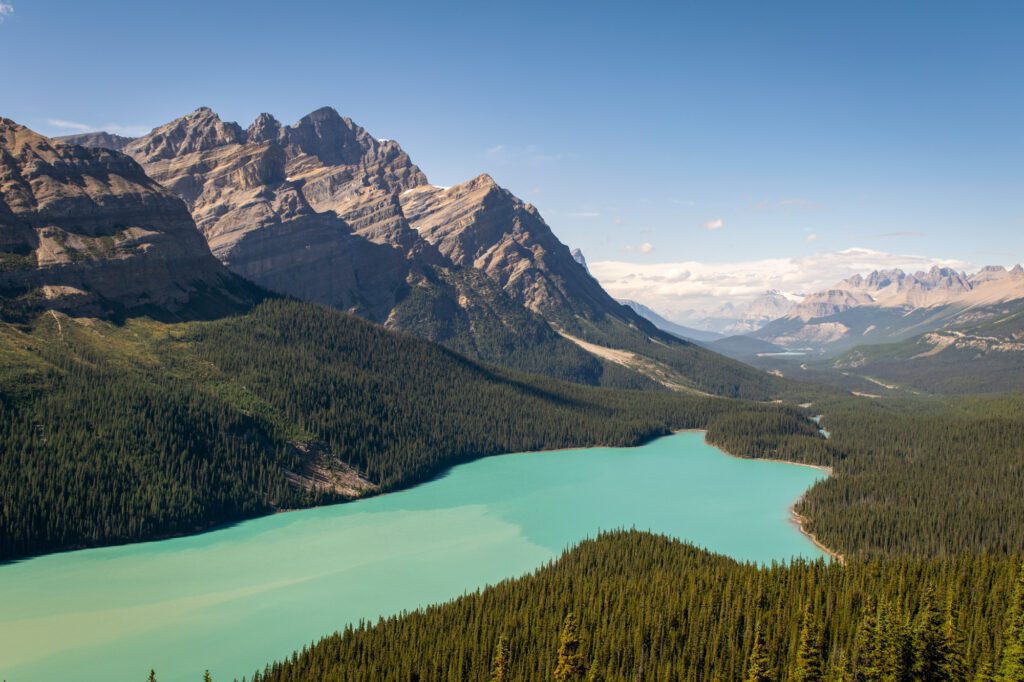
If you’ve seen pictures of Banff, you’ve probably seen at least one picture of Peyto Lake.
It’s that vibrant turquoise glacier-fed lake. Oh, there are tons of those in the Canadian Rockies? Right. Peyto Lake is special because you view it from above, and have the mountains backing it.
The timing here is a little unfortunate – if you follow this itinerary, you’ll be hitting the lake in the afternoon sometime, and that happens to be the busiest time to be there.
But there’s no real way to fix that (unless you skip the hike to Helen Lake, in which case we’d probably go here first then double back to the other stops), so it is what it is!
It’s a short half mile walk to the upper viewpoint, which you’ll certainly be sharing with hundreds of your new closest friends.
The Columbia Icefields Discovery Center
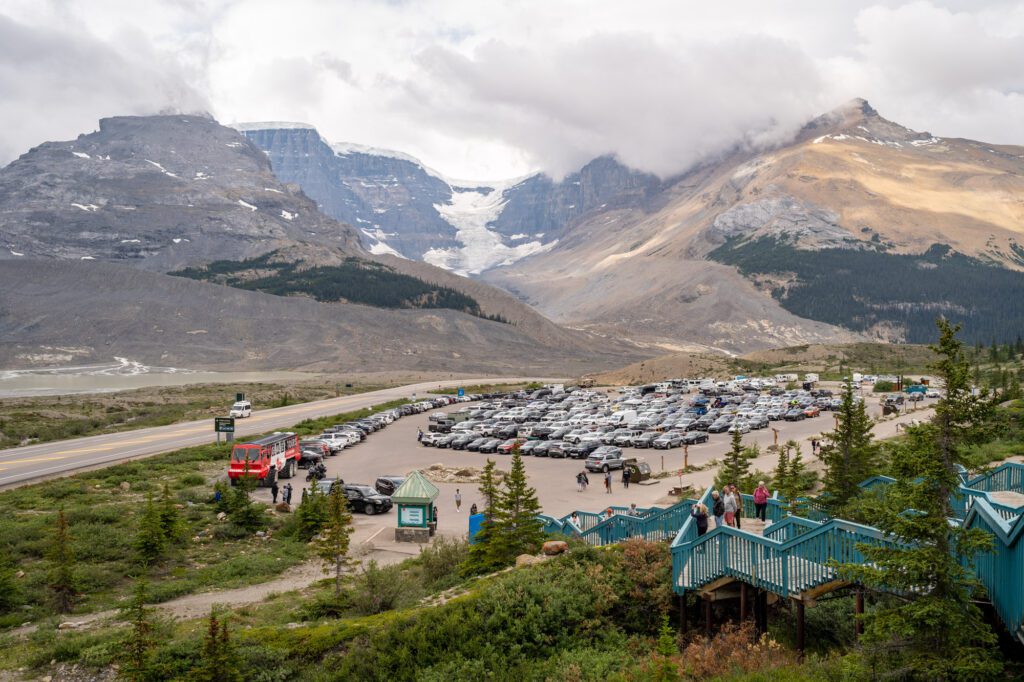
After another hour or so of driving (there are a couple of stops along the way that are worth making, like Waterfowl Lakes and Mistaya Canyon), you’ll cross over the border into Jasper National Park (saving our favorite hike, Wilcox Pass , for the trip back down to Banff) and arrive at one of the most impressive parts of the drive: the Columbia Icefield.
Which, by the way, is the largest icefield in North America (though it is shrinking at an alarming rate). There is 125 square miles of ice here, and from the roadside pullouts and Discovery Center, you’re only seeing an impossibly miniscule fraction.
If your vision for your trip includes walking on a glacier, this is the place to do it. You can’t go by yourself, though. You can book an Ice Walk to get out with a guide and all the equipment you need.
It’s worth stepping inside the Discovery Center and going to the lower level, where there is a cool interactive display that talks all about the ecosystems here.
Athabasca & Sunwapta Falls
This pair of waterfalls will be among your last stops as you roll into Jasper at the end of the day. They’re fifteen minutes apart, and they are both worth stopping for.
Athabasca is the first one you’ll encounter as you’re driving north. To be honest, it’s hard to take a picture of this waterfall that really does it justice because it comes through a little gorge, which obstructs the view of the falls from straight on.
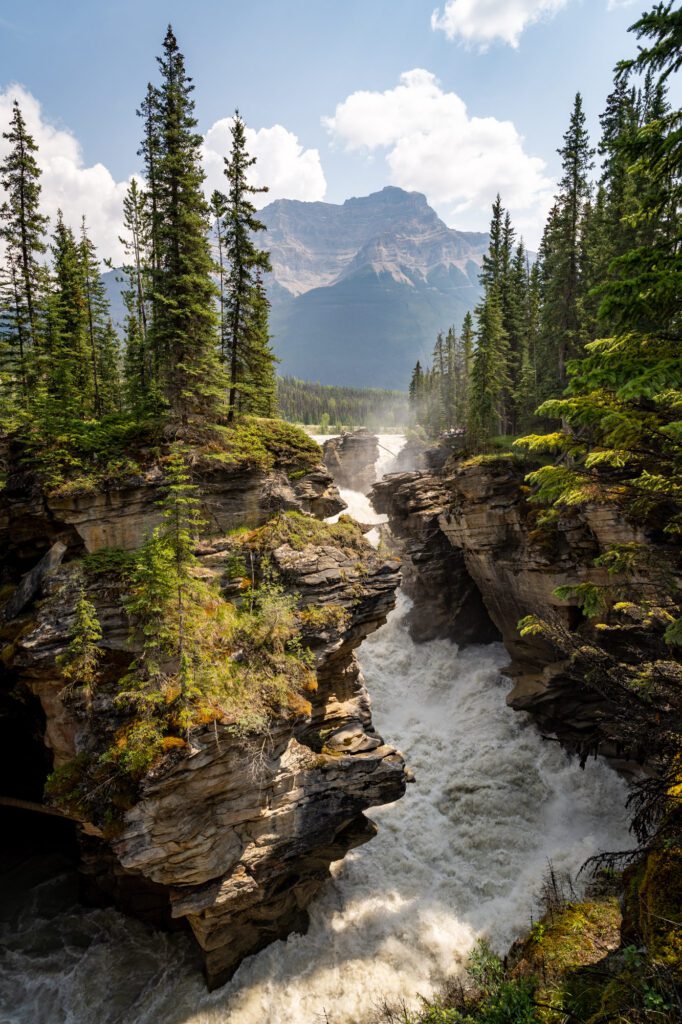
From the side, you can see the top of the falls, but you don’t get the view of the 80 foot drop.
Follow the trail from the parking lot to see the falls from multiple views, including the two we just mentioned.
Aside from, you know, the beautiful waterfall, the best part about Athabasca Falls is the short hike down into the canyon, which a tiny fraction of the people at the falls actually do. From there, you get a more bottoms-up view of the canyons formed by this impressively powerful waterfall.
Sunwapta Falls is a little further up the road, and is arguably more impressive, with the island of trees in the middle of the river just before it tumbles over the falls.
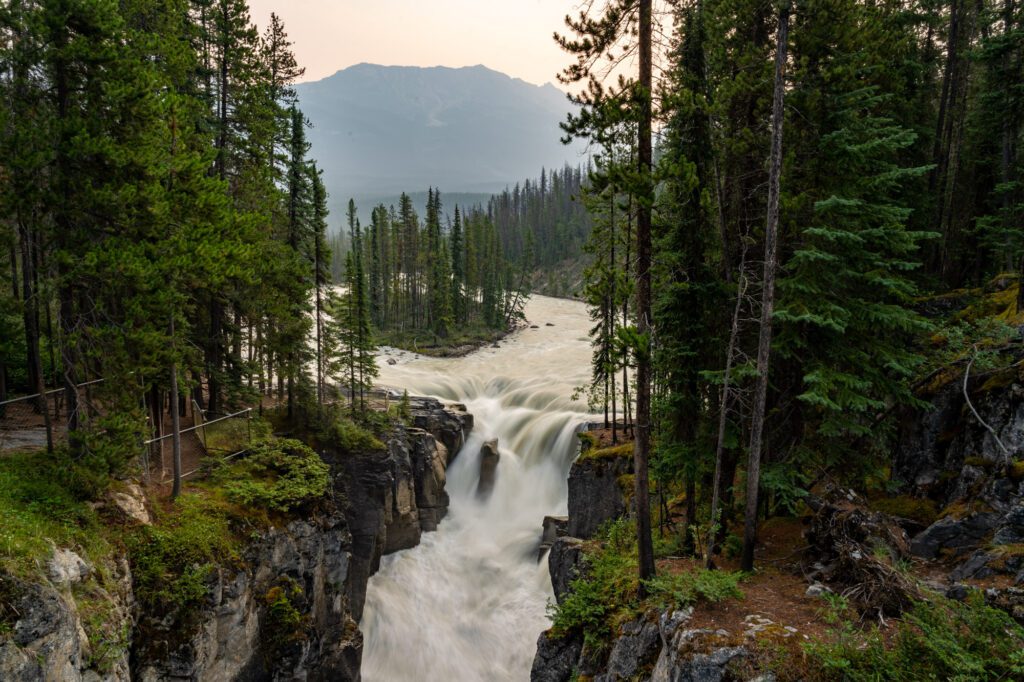
The drop here is shorter than Athabasca at just 61 feet, but we prefer the views of Sunwapta.
From Sunwapta Falls, it’s a nice short drive into the town of Jasper, which will be your home base for the next few days.
Day 5: Wildlife Drive, Maligne Lake, & Maligne Canyon
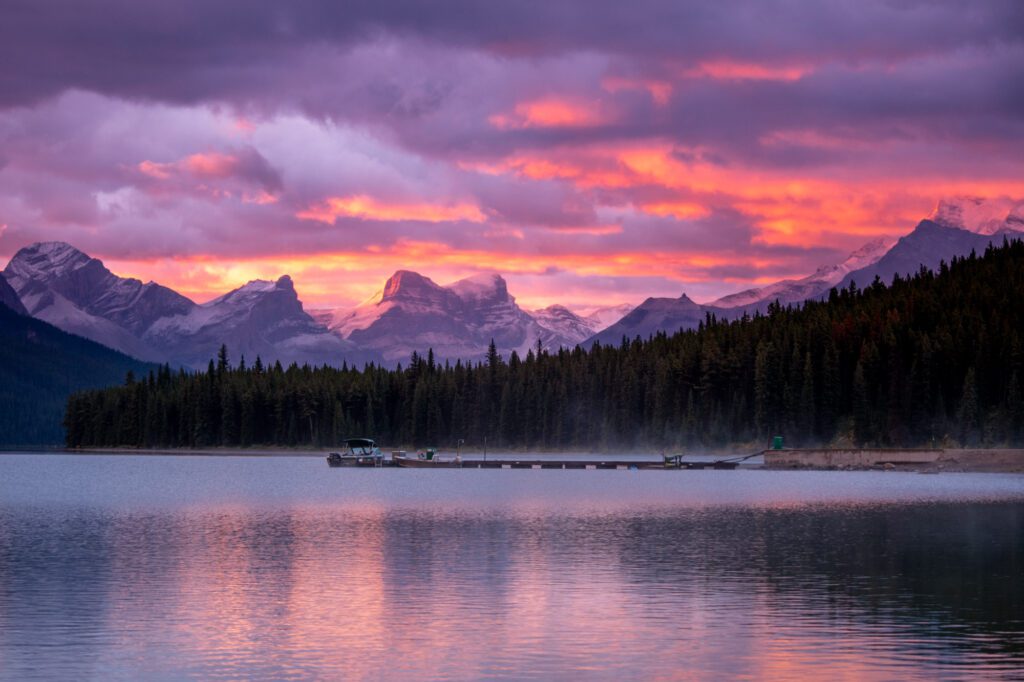
Jasper is more “wild”, for lack of a better word, than Banff, which probably has to do with its more remote location.
While Banff is an easy two hour drive along the Trans-Canada Highway from Calgary, Jasper takes around four hours to get to from nearby big cities like Calgary or Edmonton.
For that reason, along with the fact that many people who visit Banff just never make it up to Jasper because they have limited time, it feels more rugged and out there than most places in Banff.
However, with 7-10 days, we definitely think it’s worth visiting, and two days is a good amount of time to spend in and around Jasper.
One thing we will say about Jasper is that it just doesn’t have the amenities that Banff has. We found Nesters to be the best grocery store in town, and loved both Sunhouse Cafe (coffee and tea) and Neighborhood (wine and small plates), but that’s about all we got excited about.
On your first full day in Jasper, you’ll tackle what we think is the main attraction – Maligne Lake – and the surrounding area. It’s an hour-long drive from the town of Jasper out to Maligne Lake, but there are two nice stops along the way in Medicine Lake and Maligne Canyon that are worth your time.
We’re organizing the day as Medicine, Maligne Lake, Maligne Canyon to optimize for wildlife viewing in the early morning at both Medicine Lake and Maligne Lake, which does mean you won’t have Maligne Canyon all to yourself. But that’s the order we’d recommend.
Medicine Lake
While this entire stretch of land is a great place to see some wildlife – we saw a mama moose and her baby completely by accident in the parking lot of the Bald Mountain trailhead before sunrise – Medicine Lake is renowned as a hotspot for seeing moose, elk, bighorn sheep, and more.
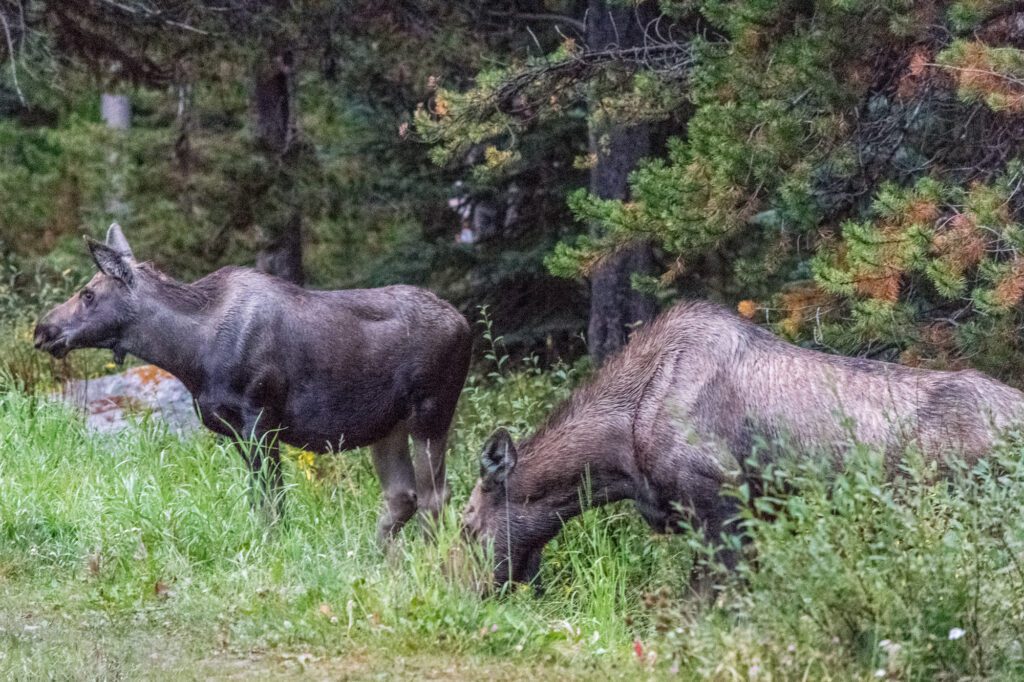
As we’ve already mentioned in some of the Banff sections, the best time to see wildlife is going to be dawn and dusk, so if you’re serious about it, you’ll want to be out at Medicine Lake around sunrise (an early wake up call, we know).
For what it’s worth, we’ve always had our best luck seeing wildlife within an hour of sunrise or sunset.
Aside from the wildlife, there’s not much to do at Medicine Lake. It’s worth noting that the lake is actually seasonal, and disappears when the water runs out (which is unusual in the Rockies, which is full of glacier-fed lakes).
You’re about halfway to your destination here, so you’ll continue your drive onwards to Maligne Lake once you feel like you’ve seen enough.
Maligne Lake (+optional boat cruise)
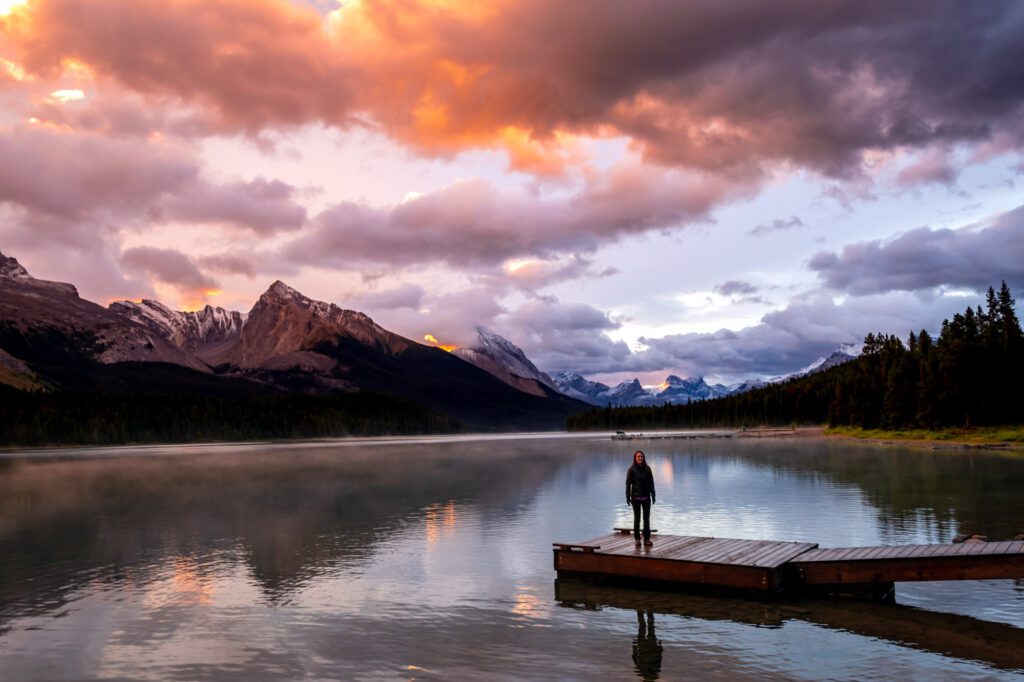
Maligne Lake is the crown jewel of this corner of the world. You’ve undoubtedly seen at least one picture of it on Instagram (probably of Spirit Island, a little tree-covered island miles and miles south from the parking area that’s only accessible by boat).
There are ample opportunities for hiking and other outdoor recreation at Maligne Lake. We’ll give you three ideas in terms of how to spend a half day at the lake.
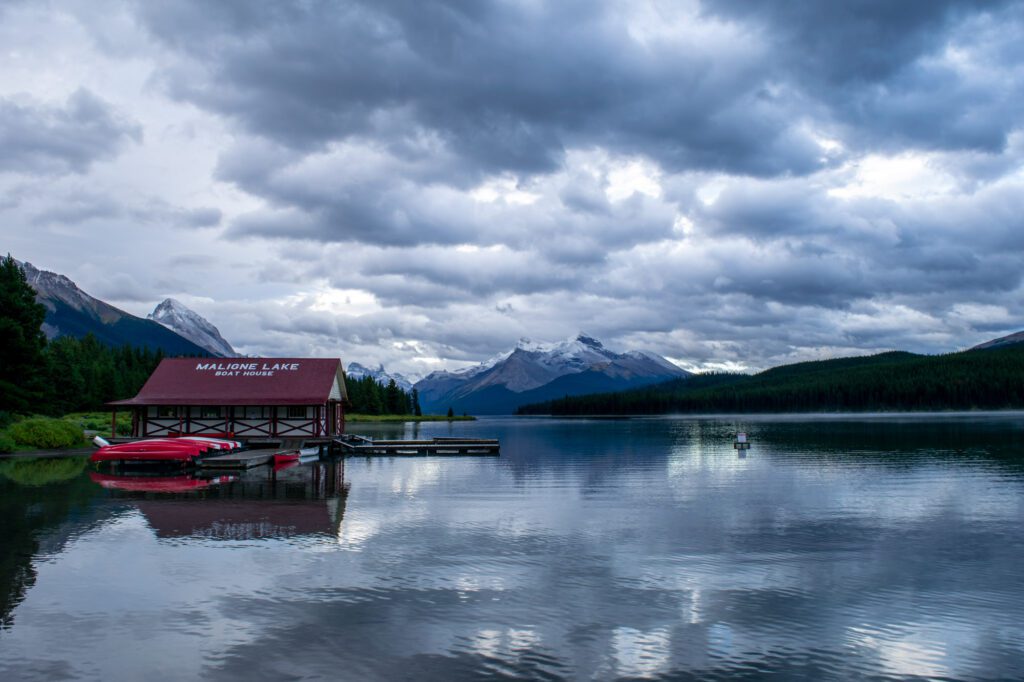
First is the boat cruise out to Spirit Island , which is one of the only ways to get that far out into the lake and see pieces of wilderness that only a tiny fraction of visitors get to see.
However, you will likely be crammed into a motorized boat (which, honestly, isn’t great for the lake) with other visitors, so don’t expect to find solitude out there. It’s a 90 minute cruise.
Second is a self-guided tour out to Spirit Island which, if you’re up for it, is the best way to do it from both an environmental and experiential perspective.
You can either rent a canoe or kayak from Maligne Lake Boathouse ($160 a day for a canoe), which is both the most convenient and also the most expensive option (funny how that works), or you can rent from Wild Current Outfitters in Jasper ($125 a day for a 1-2 person canoe).
With Wild Current, you book in advance and then pick up the canoe at Maligne Lake, so you don’t need to worry about transporting the boat to and from the lake.
From the boat dock out to Spirit Island is a hair under nine miles, which is no joke.
We’d suggest booking either an early morning or late afternoon rental (the latter would change your itinerary a bit) so that you avoid the bulk of the crowds and boat cruises heading out there. Bring lots of water, snacks, and sun protection!
Third is hiking near Maligne Lake . There are several trail options nearby, from easy flat loops to tough climbs.
Here are a couple of hiking options near Maligne Lake, some of which we’ve done personally (Bald Hills is great, but be prepared for wind at the top) and others that were on our list for our latest trip, but either got smoked out or didn’t allow dogs.
- Moose Lake (1.7 miles / 472 feet elevation gain): Super easy hike that takes you southwest from the boat house and parking lot to a nice lake. There’s a reason they call it Moose Lake, and if you can get to the lake early in the morning (or around dusk) there’s a nonzero chance you’ll get to see a moose frolicking in the lake.
- Mary Schaeffer Trail (2 miles / 275 feet elevation gain): Another easy loop, this time along the lakeshore and then back through the forest. Less about the moose and more about the views of Maligne Lake.
- Opal Hills (5 miles / 1,696 feet elevation gain): This one is more in the moderate category, and it’s a good way to get a sense for how the landscape changes as you gain elevation. As you climb, there’s an abrupt shift from green, lush forests to a barren rocky landscape. It’s a distinct line that you can see from afar, which is odd. If you’re feeling spicy, continue on to Opal Peak .
- Bald Hills (9.3 miles / 2,559 feet elevation gain): This is the hike we’ve done, and while we enjoyed it and the view from the top is spectacular, the wind and cold up there made it so miserable that I legitimately have only one or two pictures of the entire hike (rather than the hundreds I have from other hikes).
Maligne Canyon
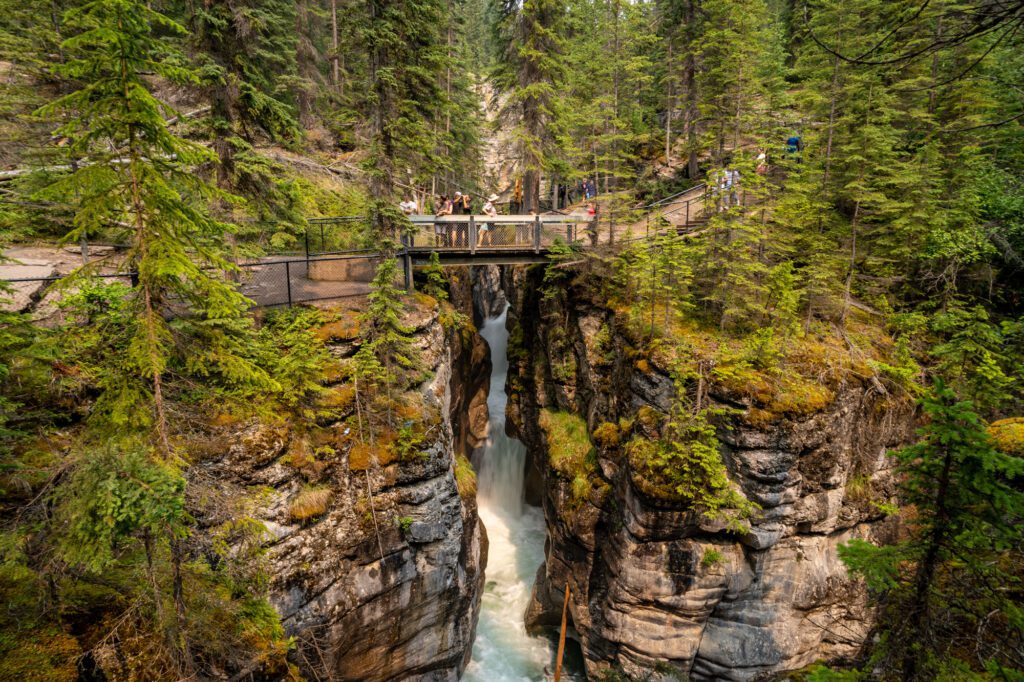
On your way back to Jasper, it’s worth stopping at Maligne Canyon for a short hike down into the canyon, where you’ll have a bottom-up (sometimes top-down) view of the tall limestone walls and the rushing river.
This is another popular spot, but it’s a big parking lot, so parking isn’t as much of an issue as it is at some of the other stops on this itinerary.
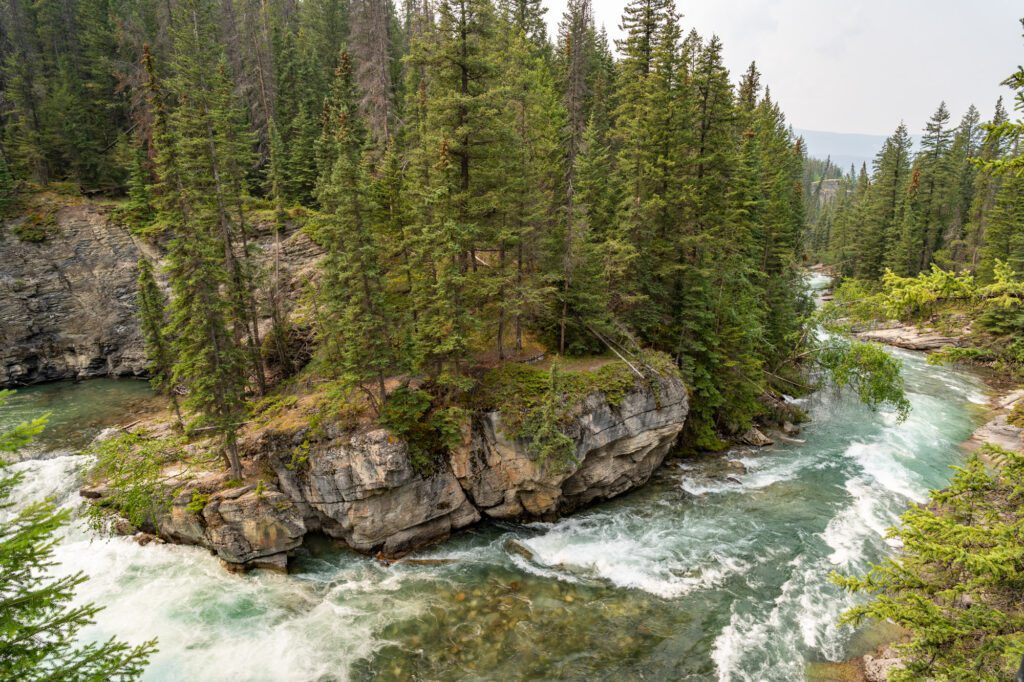
One tip here : we’d strongly recommend this version of the hike , which is an out-and-back that follows the river the entire way, rather than doing a loop that takes you away from the canyon. We did the loop, and the part of the hike that’s not in the canyon is pretty “meh.”
Day 6: Valley of Five Lakes OR Edith Cavell Meadows & Pyramid Lake
On your second full day in Jasper, pick from three of Jasper’s most iconic trails for your morning hike, and then head up to Pyramid Lake for the afternoon before ending in downtown Jasper.
A Morning Hike: Choose Your Own Adventure
Can you tell we’re big fans of giving you a few hike options to choose from based on how you happen to be feeling that particular day?
That theme continues here, where we have a couple of good hikes within an hour of Jasper that offer different experiences and intensities.
Edith Cavell Meadows (5.1 miles / 1,879 feet elevation gain): We did this one on our first trip, and we’re glad we did because it’s not dog-friendly and wouldn’t have been nearly as pleasant with the smoke we encountered on our second trip. It starts with a short hike to the base of the Angel Glacier (and the glacial pond at its base) before continuing up into the alpine meadows beyond. Then, it quickly turns into a barren, rocky alpine landscape, and the views open up to include the rocky ridge that towers over the parking lot and first section of trail.
Valley of the Five Lakes (3 miles / 534 feet elevation gain): We did this hike on our latest trip, and it’s a lovely, mostly easy stroll that takes you past – you guessed it! – five lakes. It’s a good hike, though we’d caution you that the longer loop takes you through a very poorly maintained stretch of trail on the northwestern end of First Lake. If you want a longer hike, we’d go along the north shore of First Lake, then come back along that same route to head back to the parking lot (rather than going around the lake, which doesn’t actually follow the lakeshore).
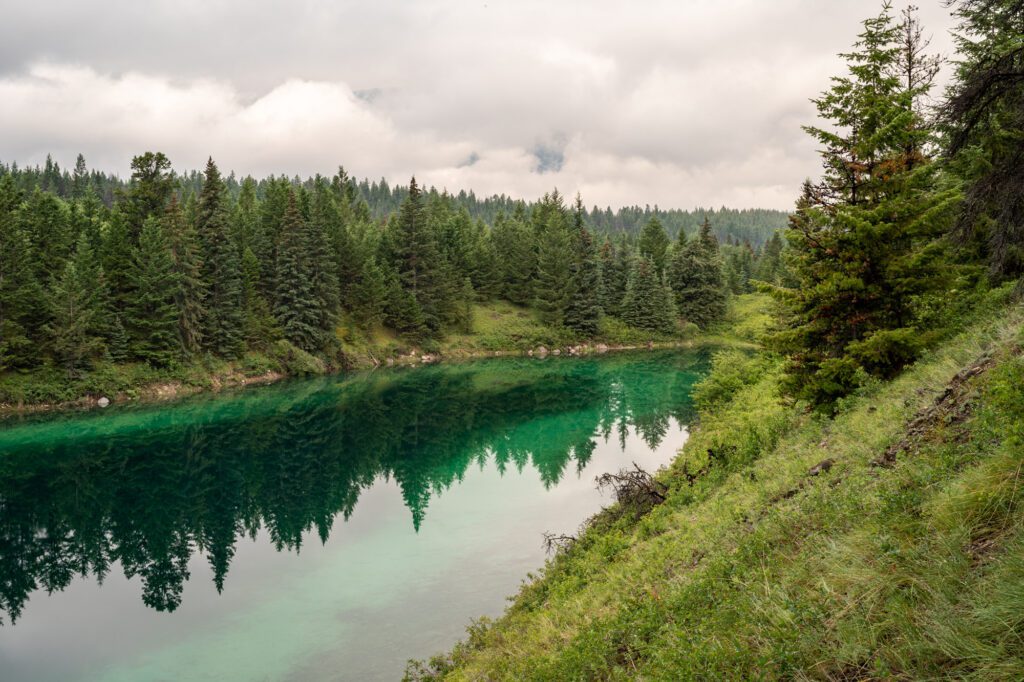
Sulphur Skyline (4.9 miles / 2,142 feet elevation gain): One of the premier hikes in Jasper National Park, this is a tough hike that starts about an hour away from the town of Jasper (to the northeast). The climb isn’t going to be easy, but the views from the top are equal parts expansive, with 360 degree views, and spectacular, with rocky mountain spines and winding rivers.
Pyramid Lake
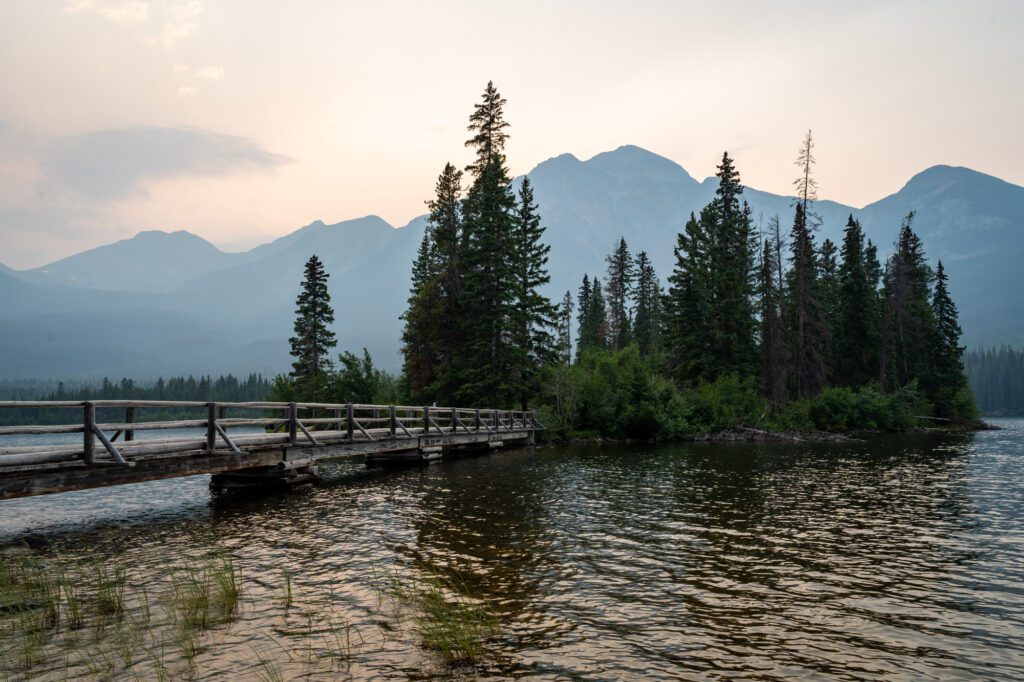
After a break for lunch and a little siesta, head up to Pyramid Lake, which is about 15 minutes north of Jasper.
For what it’s worth, we saw TONS of elk on this stretch of road, and got a kick out of the fact that Lupine saw them out the back window of our car and, after driving for another 10 minutes or so up to the lake, immediately leaped out of the car and scoured behind it for said elk. Guess dogs don’t necessarily comprehend distance traveled in a car.
You’ll pass Patricia Lake on the way up, and aside from the nice Patricia Lake Bungalows along the lakeshore, there’s not much to do or see there (though it is, unsurprisingly, beautiful).
There are three destinations up at Pyramid Lake that are worth your time, and the first is the dock outside of the Pyramid Lake Lodge, which is THE place to rent a boat of some kind to paddle the lake.
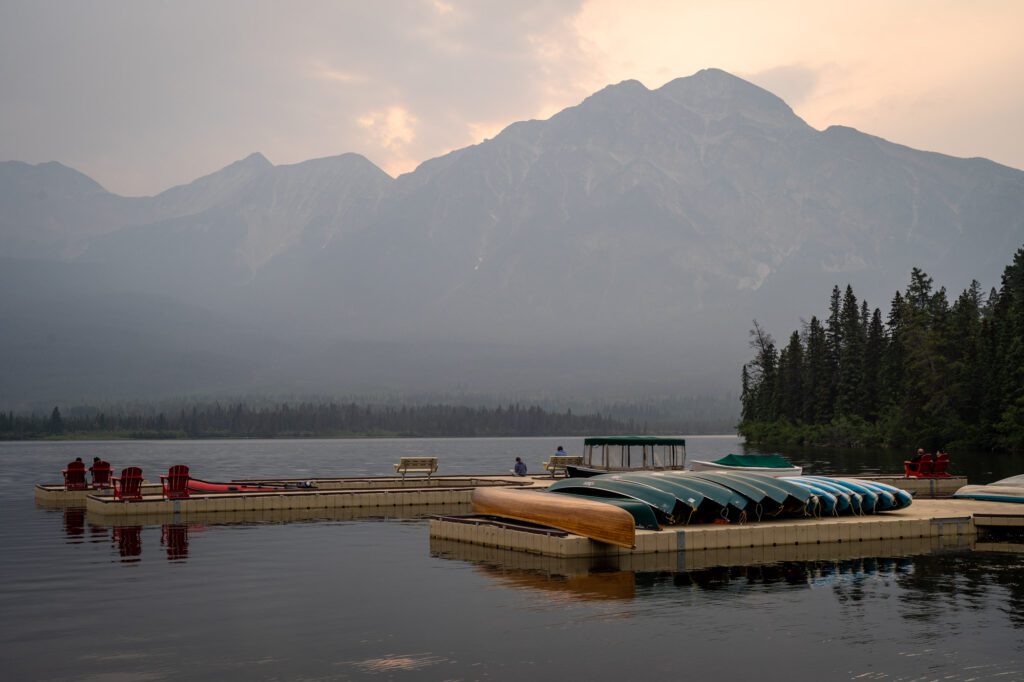
The second destination, and the arguably most famous of the three, is Pyramid Island. Accessed by a picturesque wooden footbridge, this little island is worth walking out on, especially for the views across to the other shore with Pyramid Mountain’s hulk looming over the lake.
The last destination is the beaches on the the south end of the lake, which you’d access by heading left when the road forks as you approach the lake. We were here on a very drizzly morning, and despite the drizzle loved the view of the lake and surrounding mountains from here.
Downtown Jasper
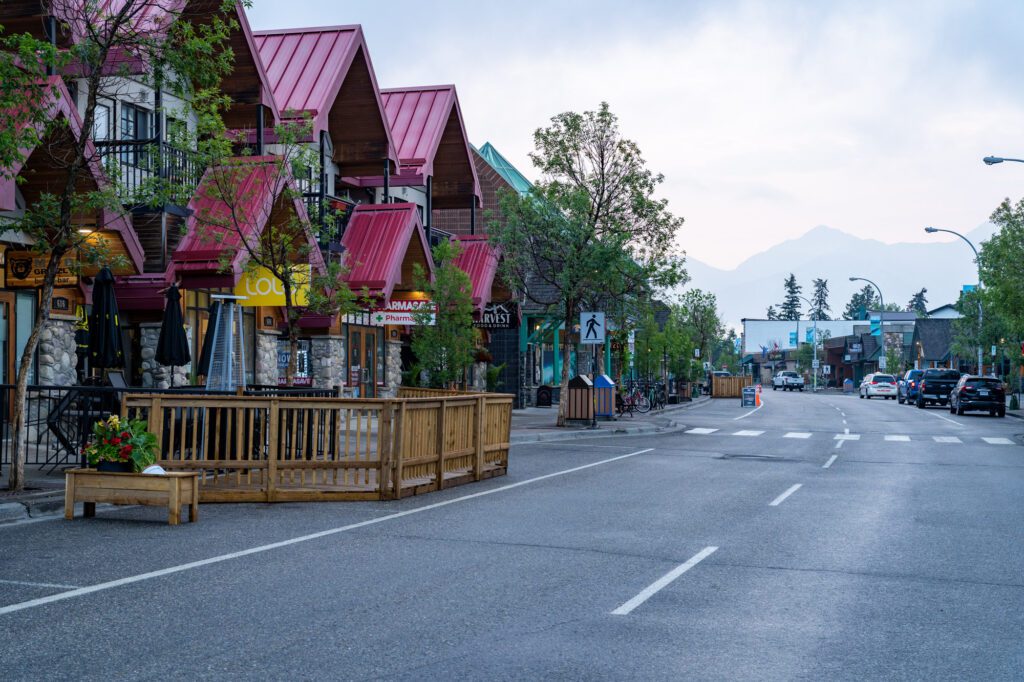
We don’t have too much to say about exploring Downtown Jasper since we spent most of our time cooking at home while we were in town (the Jasper farmers market is fun, and we found it interesting that most of the produce seems to come from British Columbia).
However, there were a few places that stood out to us in Jasper.
First is the duo, owned by the same group, of Neighbourhood Food and Drink (for wine and small bites) and Sunhouse (for coffee and brunch with an Australian flair).
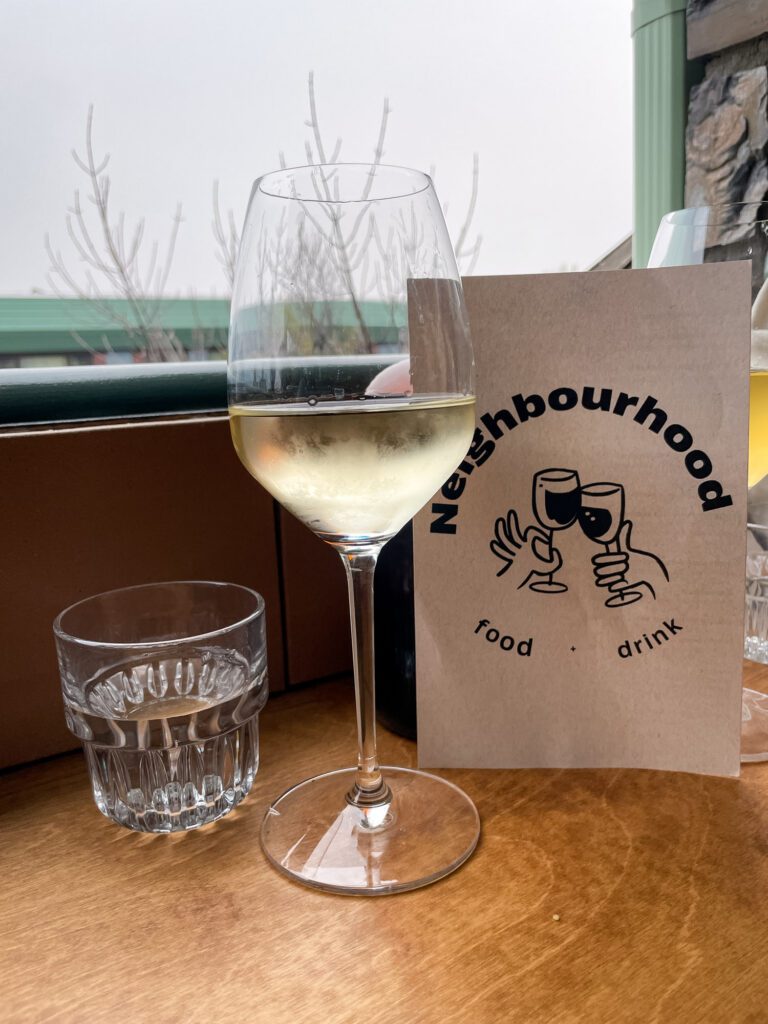
We got great coffee at Sunhouse on a smoky morning, and had a blast chatting with the barista. We then had a similar experience at Neighbourhood a few nights later, which is a natural wine focused bar where we discovered Daydreamer wines , a favorite stop of ours in the Okanagan Valley.
Jasper Brewing Company and the Raven Bistro were also recommended to us by various people we encountered.
Day 7: Icefields Parkway (Round 2) & Lake Louise at Sunset
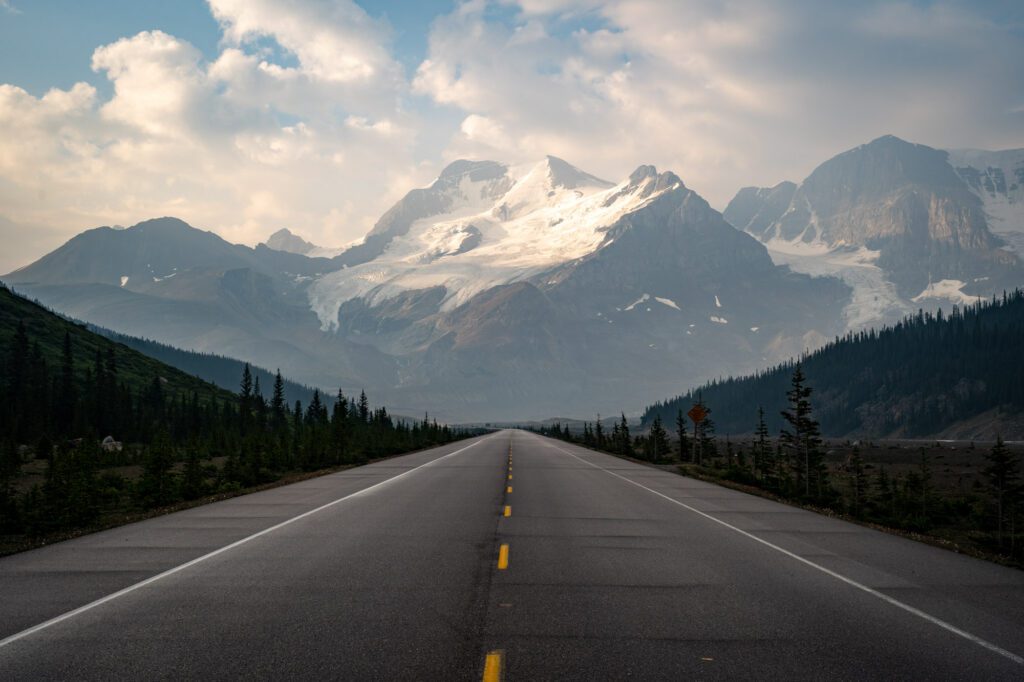
This day is about hitting the stops along the Icefields Parkway – including our favorite hike along the Icefields Parkway – that you missed on the way up a few days ago en route to Lake Louise, where you’ll head for sunset.
Your first stop is the border of Jasper National Park and Banff National Park, which is a little over an hour from Jasper.
If you skipped any of the Icefields Parkway stops that we recommended on the way up to Jasper, like Athabasca Falls or Sunwapta Falls, now is the time to do them!
Wilcox Pass
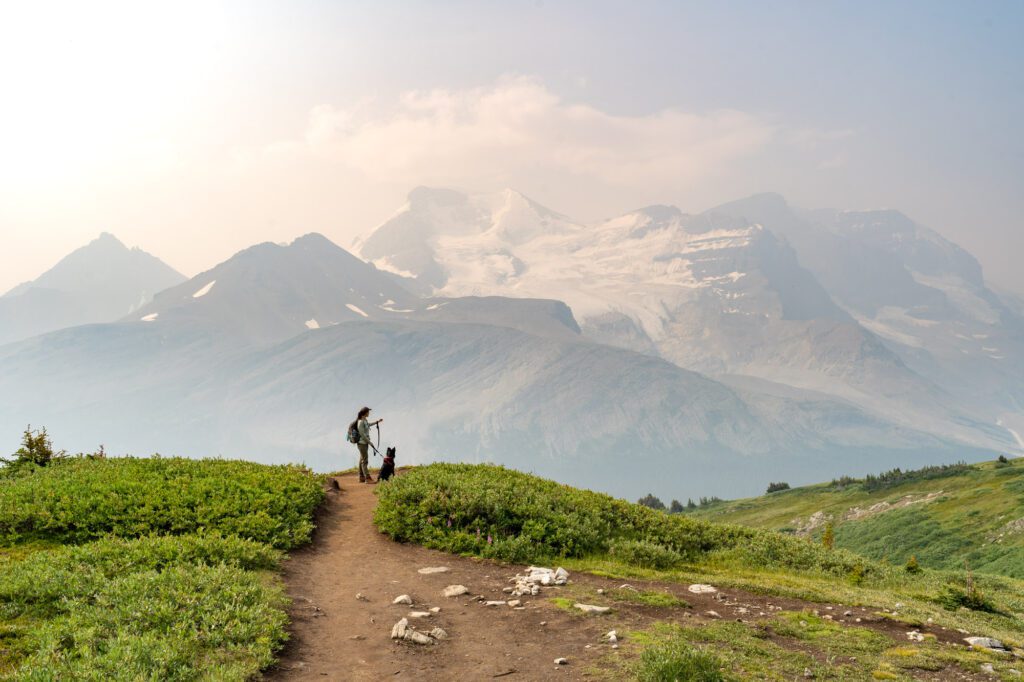
We’ve saved the best for last, we think, because Wilcox Pass is our favorite hike along the Icefields Parkway.
It’s a 5.8 mile hike with 1,700 feet of elevation gain, and the only hard part is the last mile or so, which is a steep rocky ascent to the Wilcox viewpoint.
After the first mile or so, the views on this hike are bangers all the way through, starting with the red Parks Canada chairs, morphing into stunning views of the valley you’re hiking through, and ending with a nice view out over the Icefields Parkway and the glaciers beyond.
The name is a bit of a misnomer, because you’re going to reach the sign for Wilcox Pass, look around, and feel underwhelmed. Fear not! Follow the trail left for another mile or so as it climbs to the final viewpoint, which is well worth the effort it takes to get there.
Not only are the views excellent, we also saw multiple groups of bighorn sheep on this trail, along with a huge family of mountain goats (with a bunch of babies) along the way.
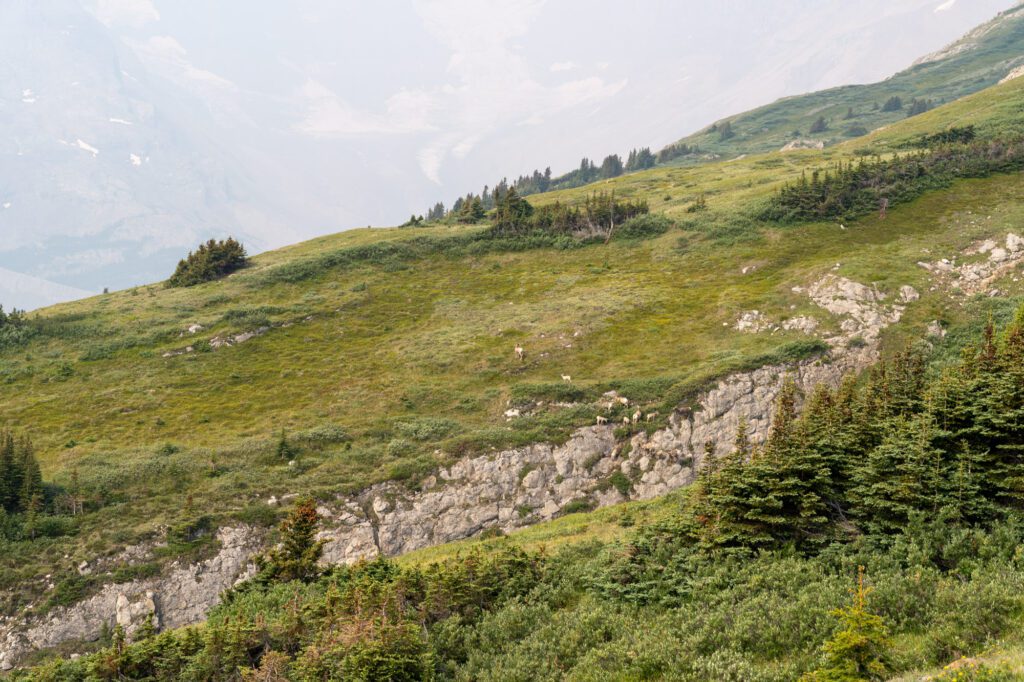
Remember to give them plenty of space – just because they’re herbivores doesn’t mean they’re not dangerous, especially when their babies are involved.
There is a pit toilet at the trailhead, which is just off of the Icefields Parkway.
Parker Ridge is another good hike that is about 10 minutes further south on the Icefields Parkway. It’s slightly easier (but slightly less spectacular), and would be a good option if 6 miles seems too aggressive for your tastes.
Lake Louise
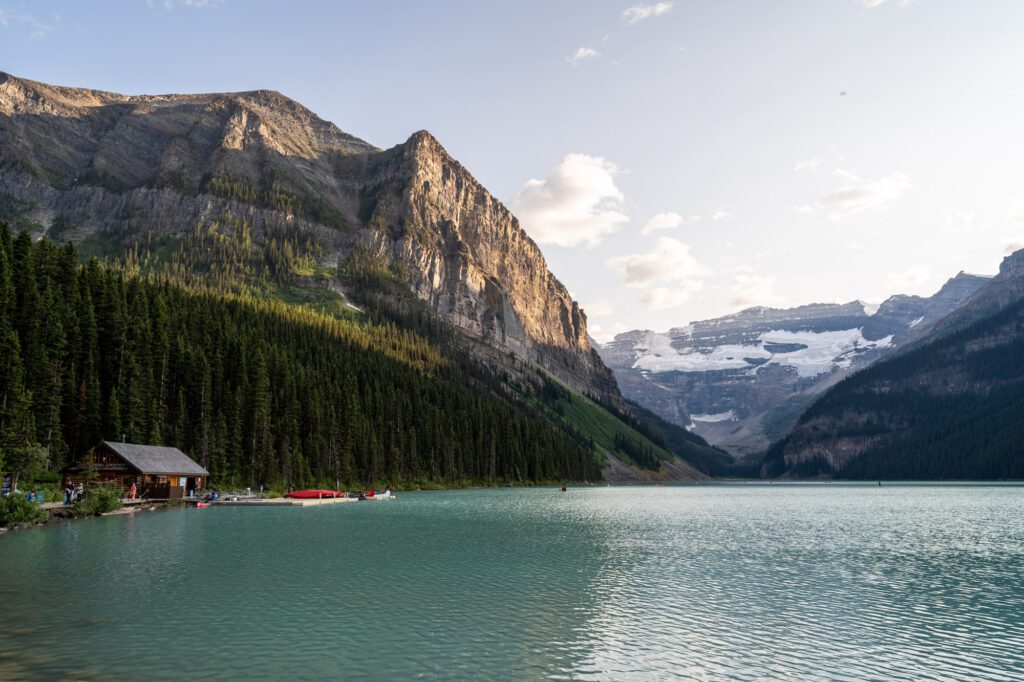
Finish your day with a sunset at Lake Louise.
Now, we think Lake Louise is worth seeing twice – in the early morning (before a hike), and in the late evening. The light does different things at each time of day, and it’s well worth seeing both.
Check into your hotel or campground, drop your stuff, and head out to the lake. Make sure to arrive after 7pm. Why after 7pm? Parking at Lake Louise, which normally costs $21 (no matter how long you’re parked there), is free after 7pm.
Day 8: Lake Louise & Hiking Nearby
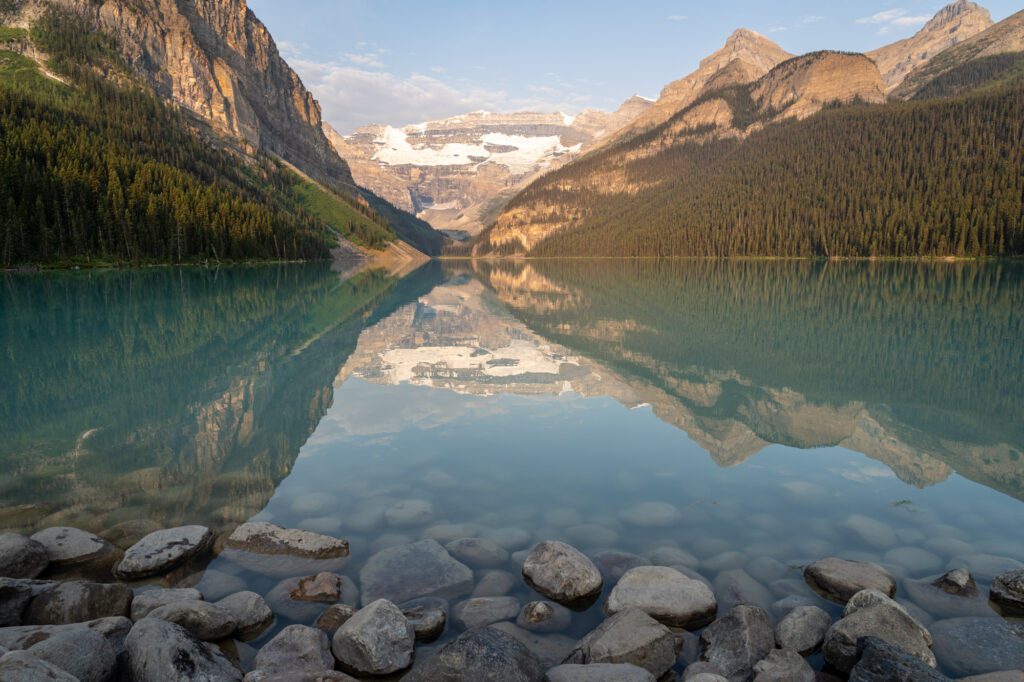
For the two days you’ll spend near Lake Louise, split your time between Lake Louise and Moraine Lake.
This is going to be, by far, the most complicated piece of your trip because of the logistics involved in getting to the two most popular spots in Banff National Park, but it’s 100% worth it.
While some people opt to do both lakes on the same day, we’d strongly recommend that, if you’re interested in hiking, you do them on separate days because some of our favorite hikes leave from both lakes, and it would be impossible to do them on the same day.
This does mean you’ll need two days of shuttle reservations (more on that in a second), but we think it’s more than worth it.
On your first full day in the area, tackle Lake Louise, which is one of the most popular places in all of Canada and is home to some of our favorite hikes in Banff .
Getting to Lake Louise
Of the two lakes here, Lake Louise is slightly easier to get to. But only slightly.
As of 2023, you can still drive to the parking lot at Lake Louise , while the parking lot at Moraine Lake is only accessible via shuttle or bus (more on that in the section on Moraine Lake).
You have three options when it comes to getting to Lake Louise: drive yourself and arrive super early, or take the shuttle or bus to the lake.
Each of the three options has its own pros and cons, which we’ll go through here.
Option 1: Driving Yourself to Lake Louise
The first option is to drive yourself , which gives you more flexibility and allows for an earlier start on the trail (unless you’re on the first shuttle). However, the cons arguably outweigh the pros here.
The first con is that you need to arrive super early, which is partially why we recommend staying nearby so that it’s a 10 minute drive, not an hour. There are two big lots at Lake Louise, and by 7am or so on summer days, they are both full. You need to arrive by 7am at the latest to get a spot. From our own personal experience, we were there at 6:15ish, and they were almost full by the time we had strapped on our hiking boots and headed to the trail.
The second con is that it costs $21 to park for the day , between 7am and 7pm. However, this might actually work out to be cheaper than the shuttle if you have a full car of people, so this is probably less of a con and more something to know going in.
Option 2: Taking the Parks Canada Shuttle
Your second option is taking the Parks Canada Shuttle , which starts and ends at Lake Louise Ski Resort, just across the highway from Lake Louise ( here on Google Maps).
This is a good option if you don’t want to get up super early to deal with the nightmarish parking situation at the lake, or if you want to do both Lake Louise and Moraine Lake in the same day using the Connector shuttle that runs between Lake Louise and Moraine Lake.
However, there are two downsides to this option. First is less flexibility – you’re beholden to shuttles on the way there and back, and the tickets are very competitive, so you might not be able to snag an early morning seat unless you book months in advance…when you won’t know what the weather is going to look like that day.
The second is that it’s not super convenient if you’re staying in Banff or Canmore. Keep in mind that this option does mean that you have to drive out to Lake Louise, which is 45-60 minutes from the town of Banff. If you’re staying in Banff, we have a better option next.
Shuttles run every 20 minutes from 6:30am to 7:30pm, and you should make advance reservations as soon as possible. More information here .
Roam Transit Bus 8x from Banff
The third option is to take Roam Transit bus 8x – the Lake Louise Express – from Banff High School in downtown Banff out to Lake Louise.
This is the best option if you’re coming from Banff because it means you don’t have to drive 45-60 minutes just to catch the Parks Canada shuttles.
There is an option here to connect with the Parks Canada Moraine Lake Shuttle, and you’ll need to buy the “Superpass” to do that (for the record, we recommend doing the two lakes on separate days).
This is the most convenient option if you’re coming from Banff, but it’s also the most expensive, costing $10 each way per adult (seniors are $8 each way, kids 17 and under are free).
Reservations should, again, be made as far in advance as you can. More information here .
Hiking Options Around Lake Louise
There are two main hiking routes from Lake Louise, and both are excellent, and both feature backcountry tea houses that this part of the world is famous for.
They are the Plain of Six Glaciers , which takes you out into the glacial valley at the far end of Lake Louise, and Lake Agnes and the Beehives, which takes you up to a ridge high above the lake.
We slightly prefer the Plain of Six Glaciers because it’s a more unique landscape, but that’s just us.
Here’s a brief description of each of those hikes (including two versions of the Beehives), along with a route that combines them into one long all-day affair, which is what we did on our latest trip.
The Plain of Six Glaciers (9.1 miles, 1,929 feet elevation gain): Of the hikes at Lake Louise, this is our favorite (we’ve done it twice now, and it was breathtaking boh times). It takes you out and back to a magnificent view of Abbot Pass and the glaciers up there, with a fun teahouse stop along the way. Great views all the way through! Read our trail guide: Hiking the Plain of Six Glaciers .
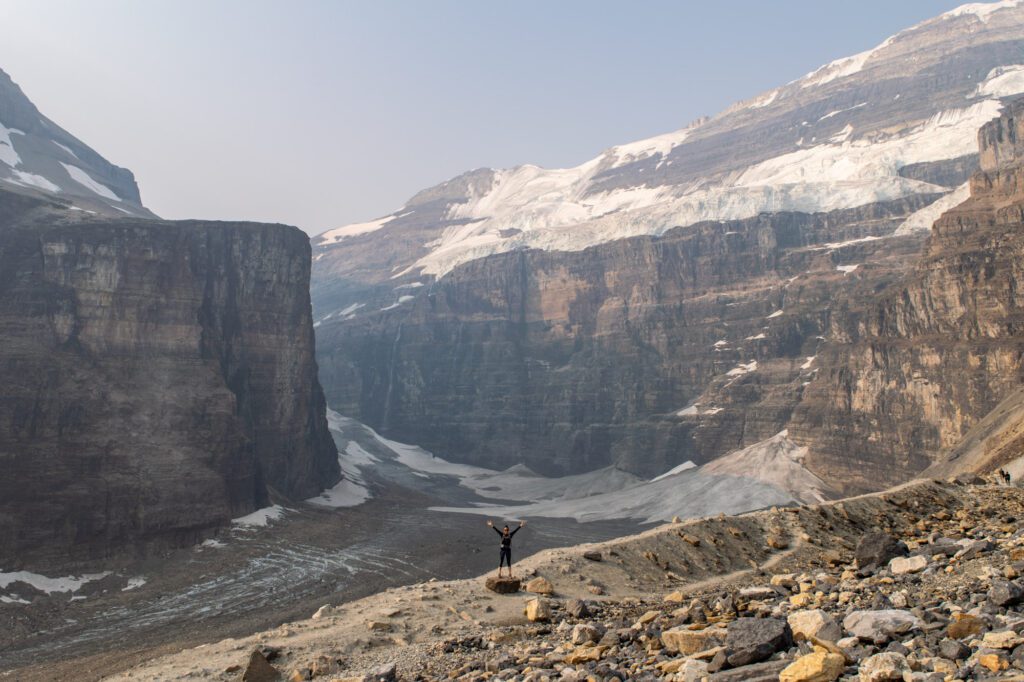
The Big Beehive Loop (6.7 miles, 2,552 feet elevation gain): A close second, this hike takes you up past picturesque Lake Agnes (and the teahouse of the same name) to the top of the Big Beehive, which has a commanding view out over Lake Louise and the Bow River Valley. It’s a great hike, especially in the fall when the Larches along Lake Agnes turn bright gold.
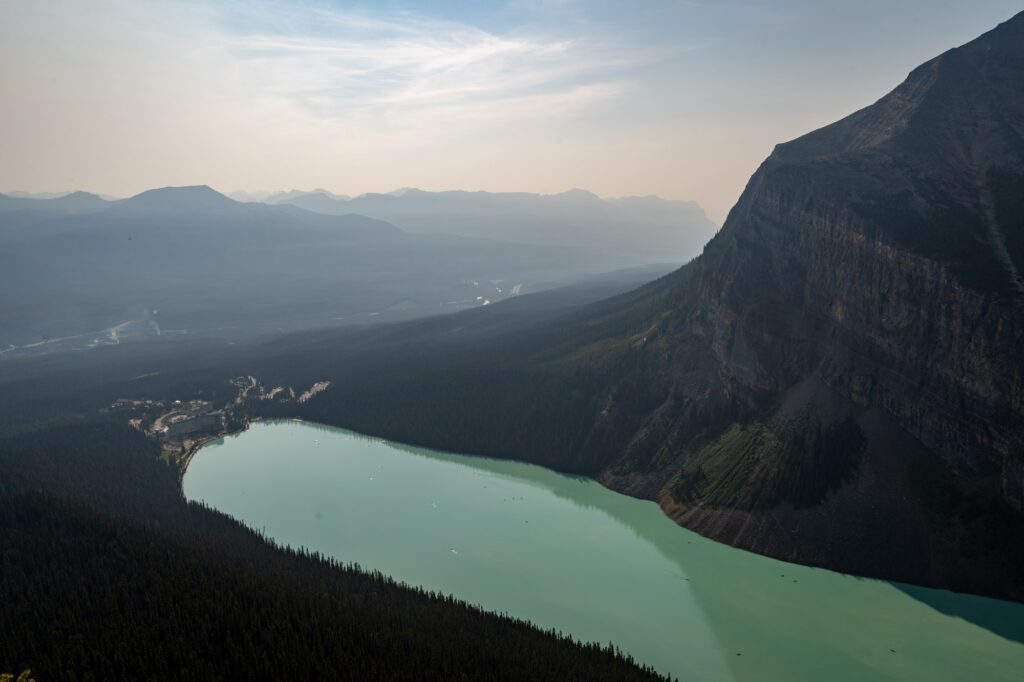
The Little Beehive and Lake Agnes (5.7miles, 1,955 feet elevation gain): A stripped back version of the Big Beehive hike, this takes you up to the Little Beehive (which has a slightly worse view) and then ends at Lake Agnes Teahouse before returning back to the shore of Lake Louise. It’s slightly easier, but we’d really urge you to try for the Big Beehive if you can because it really is much better.
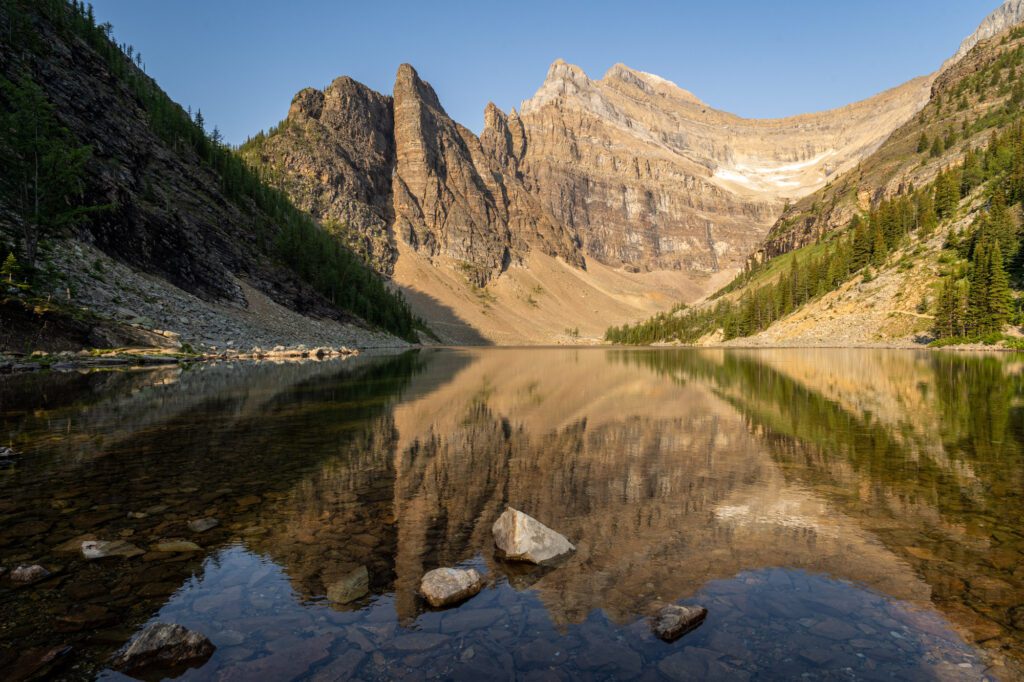
Now, if you’re an experienced hiker, you’re mentally and physically prepared, and you absolutely MUST experience both, you can combine the two hikes into one big loop, which is what we did. Here is the Alltrails guide for that hike.
For what it’s worth, we use Alltrails+ to download maps and track distance and elevation and we clocked 12 miles and 3,500 feet of elevation gain.
It’s a tough hike, but it’s doable if you’re prepared with plenty of snacks, water, and a reasonable fitness level. It will take you all day, especially if (like us) you linger for a bit at each of the two teahouses to catch your breath.
If you are going to do the full loop, we’d advocate for two things.
First is skipping Little Beehive, because it’s not worth the effort given you’ve already done the Big Beehive.
Second is going clockwise, out to the Plain of Six Glaciers first (which is very exposed and is tough in the beating sun) then looping back to Lake Agnes and the Big Beehive.
Basically all of these hikes are going to take the better part of a day, and you’re going to want to spend the rest of it recovering and replenishing, because there’s another big day coming tomorrow!
Day 9: Moraine Lake & Hiking Nearby
Moraine Lake might just be the most popular lake on Instagram. And we’re not saying that’s necessarily a bad thing.
It’s pretty clear why that is, with the spectacular blue water of the lake with the Valley of the Ten Peaks rising above it.
To this day, out of the tens of thousands of photos I’ve captured around the world, the picture above is one of my favorite pictures that I’ve ever taken.
Experiencing the beauty of Moraine Lake is absolutely one of the quintessential Canadian Rockies experiences that you definitely shouldn’t miss, but over the past few years it has become more complicated as the park has done its best to grapple with overwhelming visitor numbers.
As of 20233, they’ve completely closed the road to Moraine Lake to passenger vehicles year round, and introduced a reservation-based shuttle system in an effort to mitigate some of the negative impacts of thousands of visitors per day.
Don’t worry, we have a whole section on how to navigate those systems to get your tickets in this section.
You might be tempted to visit Moraine Lake on the same day that you visit Lake Louise, but if you’re an avid hiker, we’d recommend doing them on separate days, because each lake has a couple of the best hikes in Banff that leave from its shore.
For us, a perfect day at Moraine Lake starts with the famous rockpile viewpoint, followed by a stroll along the lakeshore, and ending with one of the many hikes nearby. Including the shuttle rides to and from the lake, it’s really an all-day affair.
Getting to Moraine Lake
The first thing we need to cover here is getting to Moraine Lake, which has changed over the past few years as record traffic numbers overwhelmed the infrastructure at the most popular lake on Instagram and necessitated some limitations on visitation.
As of 2023, Moraine Lake Road – the only road into the lake – is closed to private vehicles .
That means that the only way to access Moraine Lake is by shuttle or bus, and there are both public transportation options and private options. It’s also worth noting that the lake is only accessible by vehicle from May to October.
We’ll talk about both public and private offerings, but we’re going to focus more on the public transportation options.
The first option is the Parks Canada Shuttle . This option leaves from Lake Louise Ski Resort, which is just across the highway from Lake Louise Village.
That does mean that, if you’re coming from Banff or Canmore, you will need to drive about an hour to catch the shuttle (the next option might be better, depending on what you’re looking for).
This option connects you to the Lake Louise Lakeshore, Moraine Lake (via a connector shuttle that leaves from Lake Louise lakeshore), and the Lake Louise Campground. It runs frequently – every 20 minutes between 6:30am and 7:30pm – but it still fills up in the summer.
Book well in advance. More information here .
The second option is combining the Roam Transit Lake Louise route (route 8x) with the Moraine Lake Connector shuttle (operated by Parks Canada) .
This is a great option if you’re staying in Banff, because it means you don’t have to make the 45-60 minute drive out to Lake Louise Ski Resort to connect with the Parks Canada Shuttle.
Instead, you take the 8x from downtown Banff to the shore of Lake Louise, and then hop on the Parks Canada connector that takes you to Moraine Lake.
This requires you to purchase the “Roam Superpass” when you book your ticket, which gives you access to the connector shuttle. More information here .
The third option is the Moraine Lake Express through Roam Transit (route 10 ).
The most important thing to know is that this option is only available in the fall , September through mid-October.
This route leaves from the town of Banff (in front of Banff High School) and makes a beeline to Moraine Lake, which makes it a really nice option if you’re staying in Banff and don’t want to drive out to Lake Louise. More information here .
All three options are very competitive, and you should book your tickets well in advance, especially if you want the coveted early morning slots.
Keep in mind that even if you want to just use the connector to Moraine Lake, you need to check in at Lake Louise Ski Resort and take the shuttle from there to Lake Louise.
There are two private transportation options we want to highlight for different reasons.
- The first is the Sunrise Shuttle , which is the only option for photographers who want to see Moraine Lake at sunrise (aside from spending $$$ to stay at Moraine Lake Lodge). It takes you from Banff to the lake, arriving around 45 minutes before sunrise, where you’ll stay for two hours before being whisked back to Banff. It’s pricey, and we wish there was an option to stay at the lake to get an early start on a hike, but it’s the only way to have the lake to yourself at sunrise.
- The second is the open top buses operated by Wow Banff , because it’s the only way to bring a dog to Moraine Lake (their route goes from Lake Louise Ski Resort, to Lake Louise, to Moraine Lake). Dogs are only allowed on the upper deck, and we seriously considered doing this to get to Moraine Lake with our dog, Lupine.
The Rockpile Viewpoint and Lakeshore
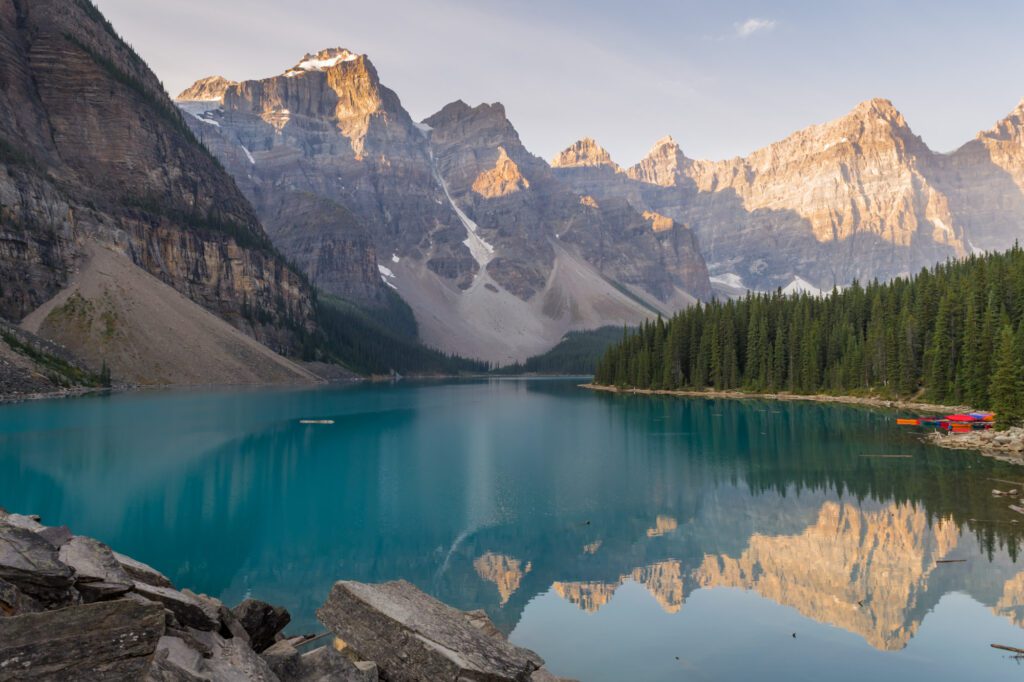
Your first stop off of the shuttle should be the famous rockpile viewpoint, which is a short walk off to your left. From here, you’ll have an excellent view of the lake, backed by the mesmerizing Valley of the Ten Peaks.
Early in the morning, the water is a bright shade of blue, and as the sun rises and interacts with the fine rock particles in the water, it becomes a unique shade of turquoise.
Both are beautiful in their own right, and if you’re on an early shuttle you might have the opportunity to see both versions.
After the rockpile, we would also recommend strolling the lakeshore for some more excellent views.
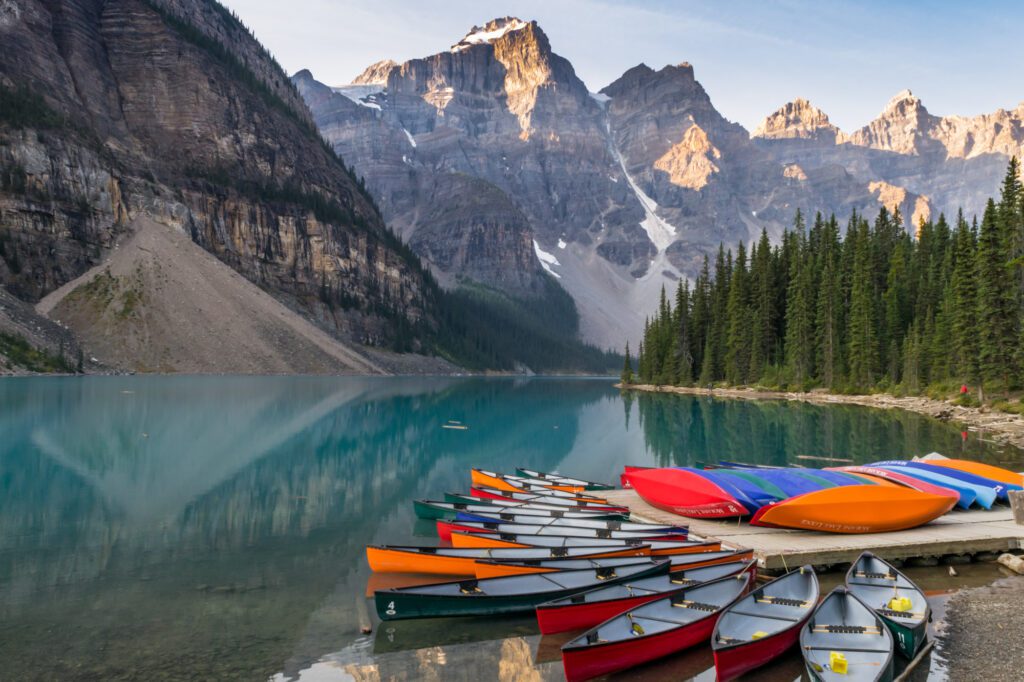
Head back to the parking lot and walk the other way, passing the Moraine Lake Lodge and canoe rentals. You could walk all the way to the end of the lake, but we’d probably go half way or so and turn back, because you’ve got a hike ahead of you!
Choose Your Moraine Lake Hiking Adventure
After poking around the lakeshore and taking some photos, it’s time to embark on your daily hike. As usual, we have a few options for you to choose from based on your own comfort and fitness levels.
However, we should say that we highly recommend the hike to Sentinel Pass. It is our favorite hike in the park, though it’s not an easy one. The views out over Larch Valley and back towards the Valley of Ten Peaks are nothing short of spectacular.
Here are the three hikes, in order of difficulty (easier to harder).
- Consolation Lakes (4.6 miles, 1,000 feet elevation gain): This hike continues past the rockpile to a string of two lakes. It’s the easiest of the three, and is a very gradual grade.
- Eiffel Lake (7.6 miles, 2,000 feet elevation gain): Another alpine lake, surprise! This hike is longer with more elevation gain, but it’s still in the moderate category. The first mile and a half climb the same switchbacks as Sentinel Pass, which aren’t easy, but then it’s a mostly level walk out to Eiffel Lake, another turquoise lake with a tiny fraction of the crowds at Moraine.
- Sentinel Pass and Larch Valley (7 miles, 2,600 feet elevation gain): The switchbacks at the beginning and end of this hike are the hardest parts, with a nice stroll through beautiful Larch Valley in the middle as a break. The views from Sentinel Pass back over Larch Valley and Minnestimma Lake are breathtaking, as is the final ascent to the pass.
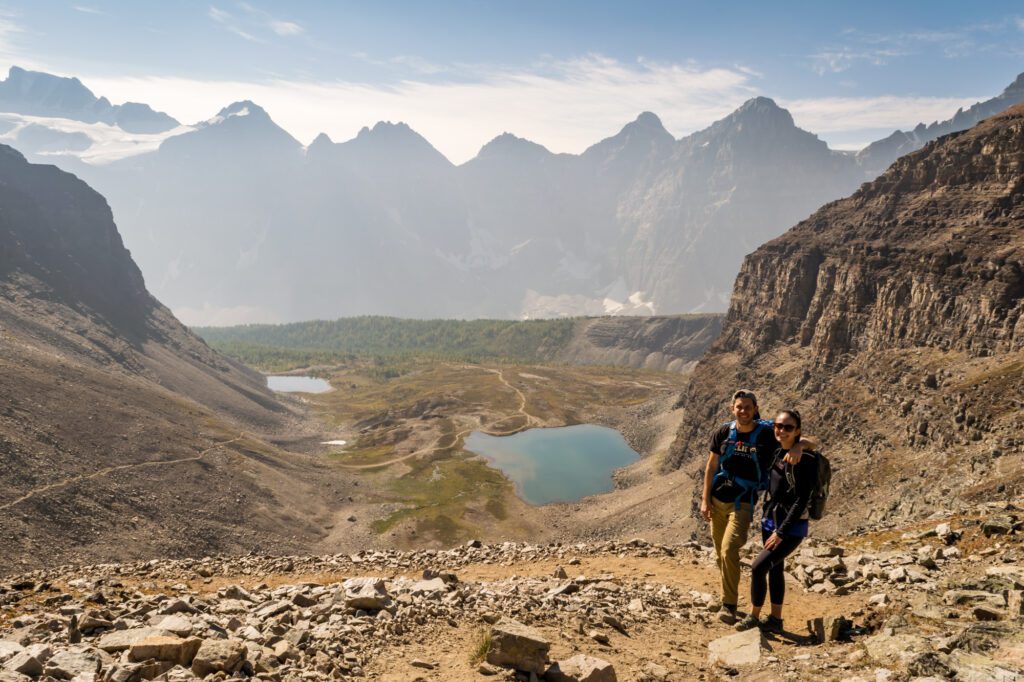
Day 10: Emerald Lake, Takakkaw Falls, & Drive Back to Calgary
On your last day, spend the morning skimming the surface of Yoho National Park, which is immediately west of Lake Louise, and then finish your trip by driving back to Calgary, tears streaming down your face because you can’t believe that every day isn’t filled with rocky peaks, alpine lakes, and 10+ mile hikes (what, just us?).
For logistical purposes, we’d go out to Emerald Lake – the furthest point from Calgary – and stop at Takakkaw Falls as you head back towards Calgary.
Emerald Lake
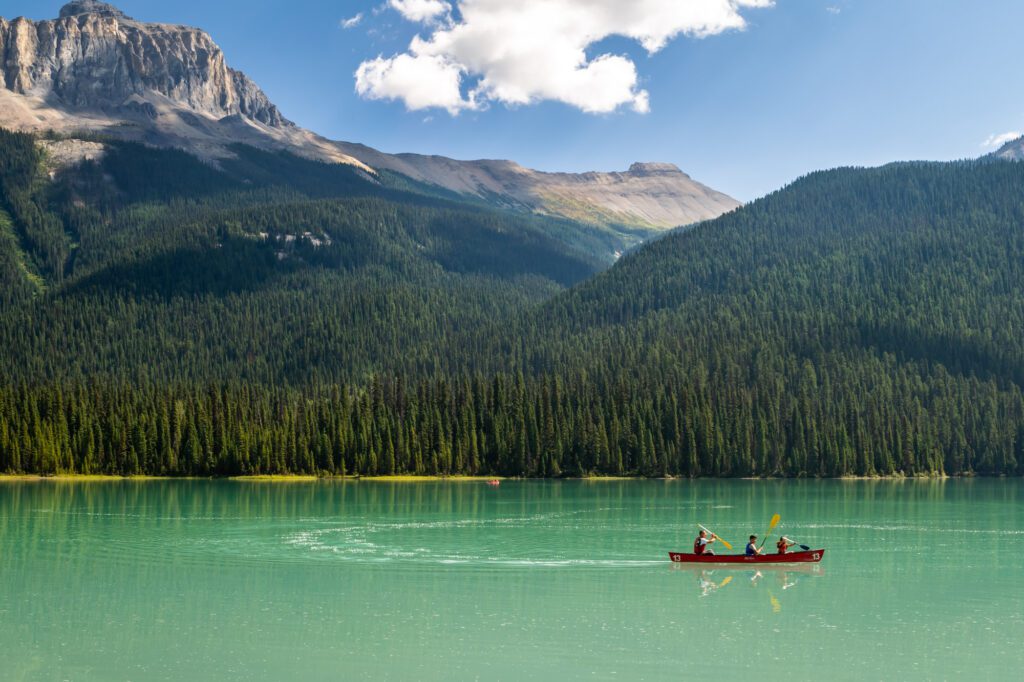
Moraine Lake is the Instagram darling, but Emerald Lake isn’t far behind. And, again, it’s easy to see why. Emerald Lake, as you might imagine based on the name, skews more green than blue when the sun hits the water and interacts with all that glacier dust floating in it.
It’s a very popular spot, and tour buses start rolling in at 9am or so. We’d recommend getting out there as early as you can (we were there at sunrise, which was magical).
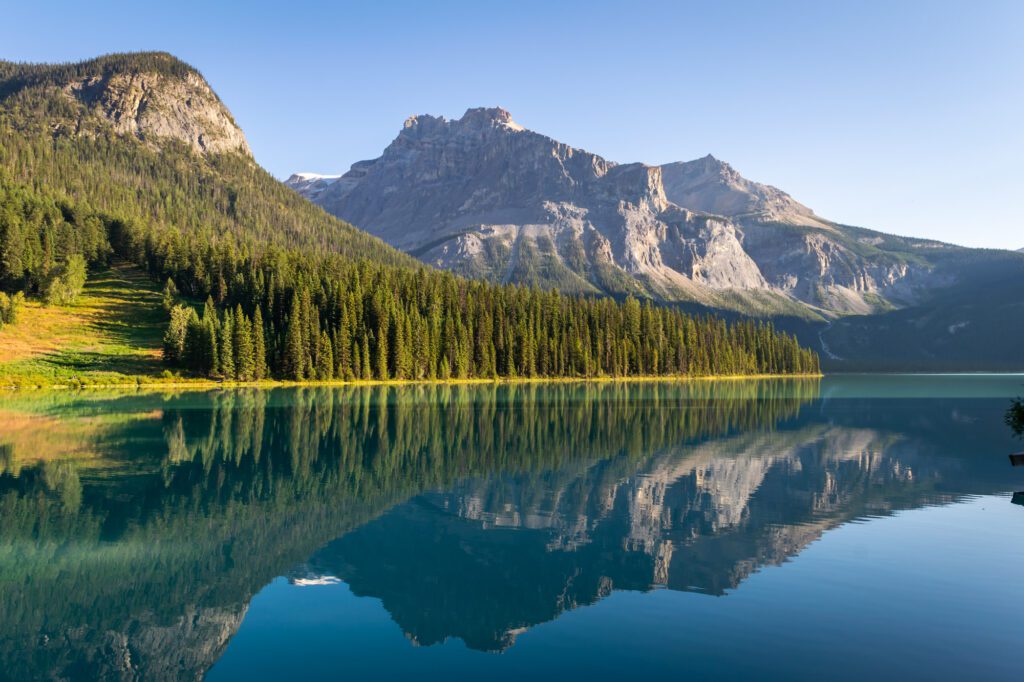
If you have the time, there are two things worth considering here.
First is a walk along the lakeshore, particularly on the left side of the lake (if you’re coming from the parking lot). There’s a loop all the way to the other side of the lake, and the views from the far side back towards Emerald Lake Lodge are stunning.
Second is renting a canoe and exploring the lake from a different vantage point. They’re not particularly cheap, but they ARE cheaper than Lake Louise or Moraine Lake.
There are also some hikes here, but if you want a good hike, we’d save it for your next stop.
Takakkaw Falls
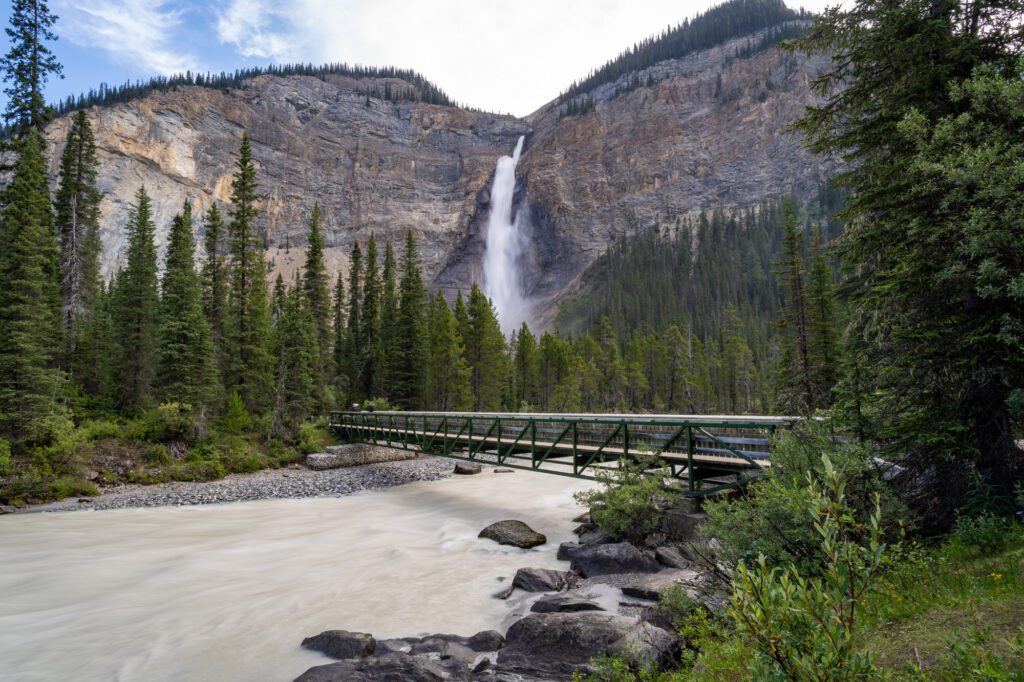
Your second stop in Yoho National Park is Takakkaw Falls, which is one of the tallest waterfalls in Canada and is well worth the drive on the narrow road to reach. It’s a short one mile round trip walk from the parking lot to the base of the falls.
If you’ve got the time for a hike (we have this in the “more time” section below), there are two here that are worth your time.
The first is the hike to Laughing Falls , which involves two more waterfalls and a mostly flat hike out into the Little Yoho Valley.
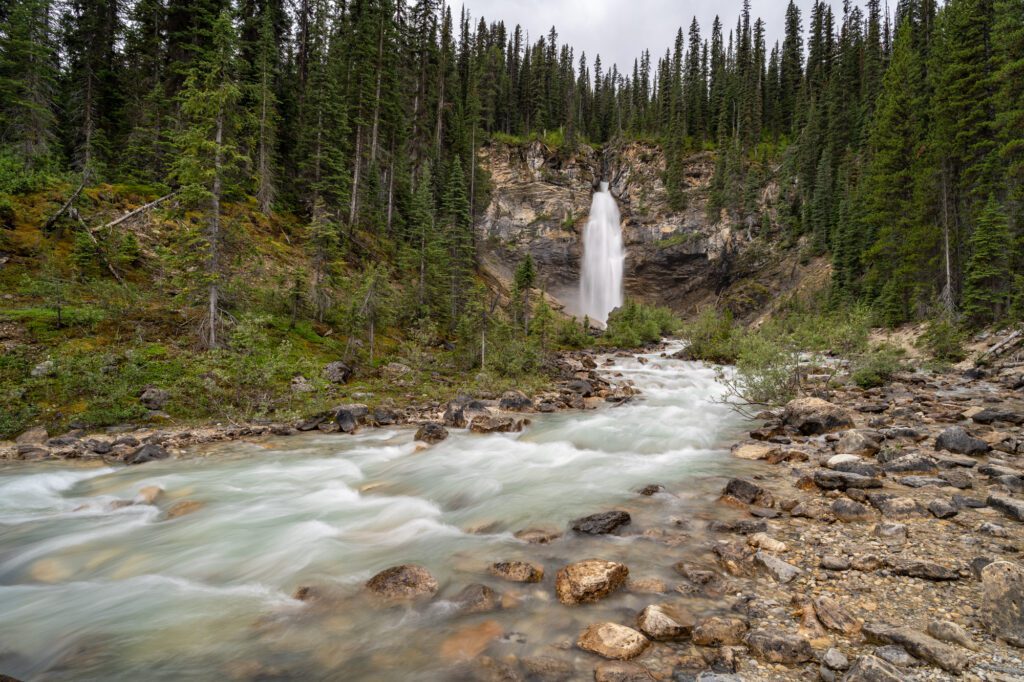
If you have the energy, you can continue on to Twin Falls , which is a full day excursion, but takes you deep into the Little Yoho Valley out to the Twin Falls Chalet and the waterfall of the same name.
The second hike to consider is the Iceline Trail loop , which is the one we’d choose with unlimited time (we’ve done it, and it’s amazing). This one aggressively climbs to get above the treeline up on the ridge, where you’ll have great views out over the valley and, in our opinion, one of the best views of Takakkaw Falls from across the valley.
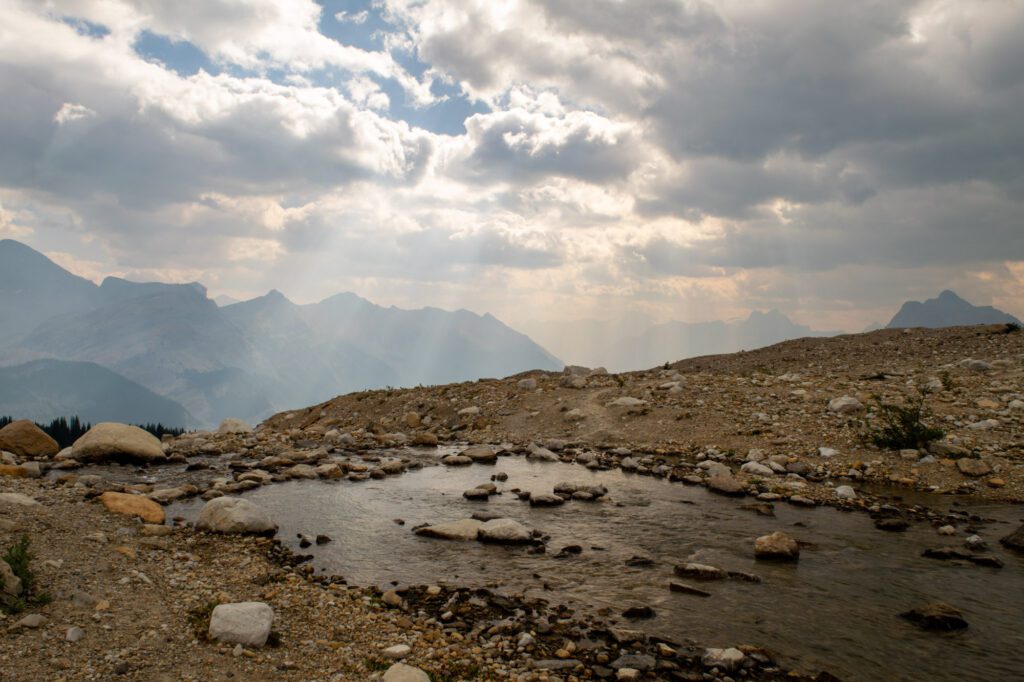
Instead of doing the out and back, loop down past Celeste Lake and Laughing Falls to vary the terrain. It’s a long hike, and spends a big chunk of time above the treeline, so watch for thunderstorms and get an early start.
Drive Back to Calgary
The drive from Yoho back to Calgary will take you about 2.5 hours, and we’d suggest giving yourself plenty of time to get back to the airport to catch your flight.
What to Add With More Time (11-14 Days)?
If you have more time in the Canadian Rockies, congratulations! There is PLENTY to do and see to fill two weeks (a lifetime, really), so you will never feel like you’re running out of things to do if you have two weeks or more.
Here are some things we love, and think are worth adding to your itinerary with extra time.
More Hikes! (1-2 Days)
There are plenty of other hikes in Banff and Jasper to add to your itinerary, and we’d recommend adding an extra day for each long hike that you’re interested in.
One option is to add another of the “choose your own adventure” hikes in the itinerary above. For example, if you only did the Big Beehive at Lake Louise, you could add a day and do the Plain of Six Glaciers too.
The other option is to refer to our guide to the best hikes in Banff and choose from there. Here are a few that aren’t included in the main itinerary above, but that we think are worth your time.
- Bald Hills (Jasper): This hike leaves from the shores of Maligne Lake and takes you up to the top of a ridge with great views. Lots of wildlife possibilities, too – we saw a mama and baby moose in the parking lot early in the morning before our hike. It was incredibly windy at the top of the mountain and, as the name suggests, there’s not a whole lot of tree cover up there to protect you.
- Paradise Valley and Lake Annette (Lake Louise): We actually didn’t get to do this hike because it’s on Moraine Lake Road and requires the shuttle (no dogs allowed!), but it was high on our list. You can do it as a shorter out and back hike, or you can do it as a through hike to Moraine Lake up and over Sentinel Pass, which would be one (long) epic day.
- Healy Pass (Banff): Of all the hikes we did that were not at Lake Louise or Moraine Lake, this was our favorite. It’s also the least crowded, and the gigantic parking lot means that parking isn’t really an issue either. It’s relatively long, but the elevation gain is very gradual, and we would put this in the moderate category (bring plenty of snacks and water though, because it’s a long walk). The first three miles or so are in the trees, but once you burst out of the treeline and are met with sweeping views from Healy Pass, you’ll understand why we enjoyed this hike so much. We will say that this is a must-do in the early summer (early to mid-July) for wildflowers, and in the fall (mid-October, but it depends on the year) for the golden larches.
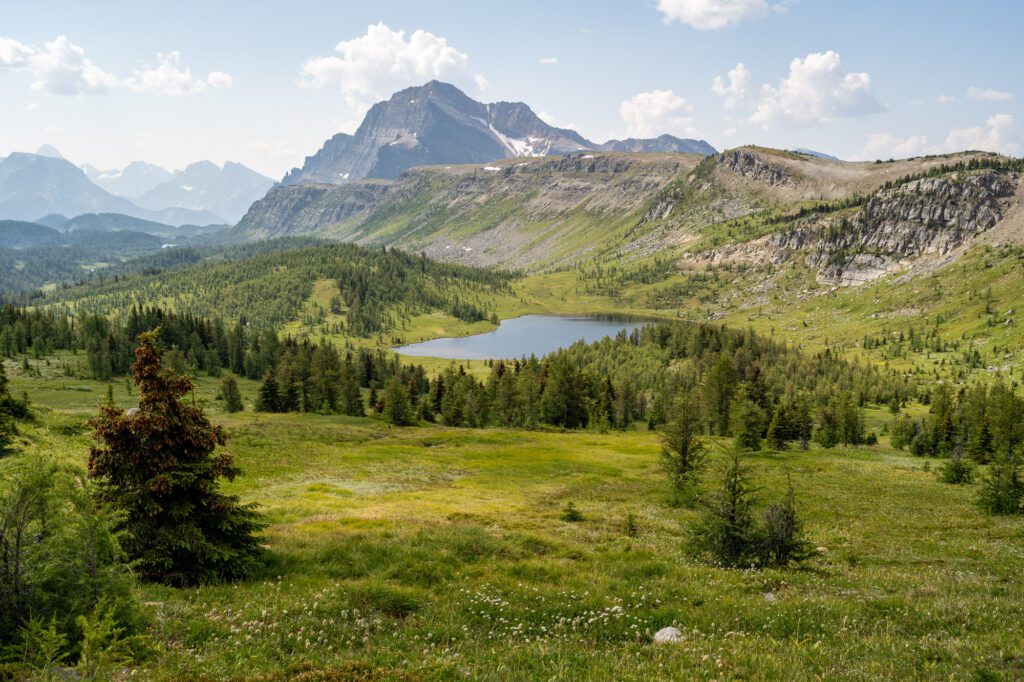
Yoho National Park (1 Day)
Yoho National Park sits on the eastern border of Banff National Park, just a few minutes west of Lake Louise.
However, despite its proximity, relatively few people make it to Yoho, and we think that’s a shame. It’s not like it’s a hidden gem – it’s very much on the beaten path these days with Emerald Lake’s popularity on Instagram – but it’s far less hectic than its neighbor, Banff National Park.
Now, we’ve included a half day or so in Yoho in the itinerary above before driving back to Calgary, but it definitely deserves a full day to itself, if not more.
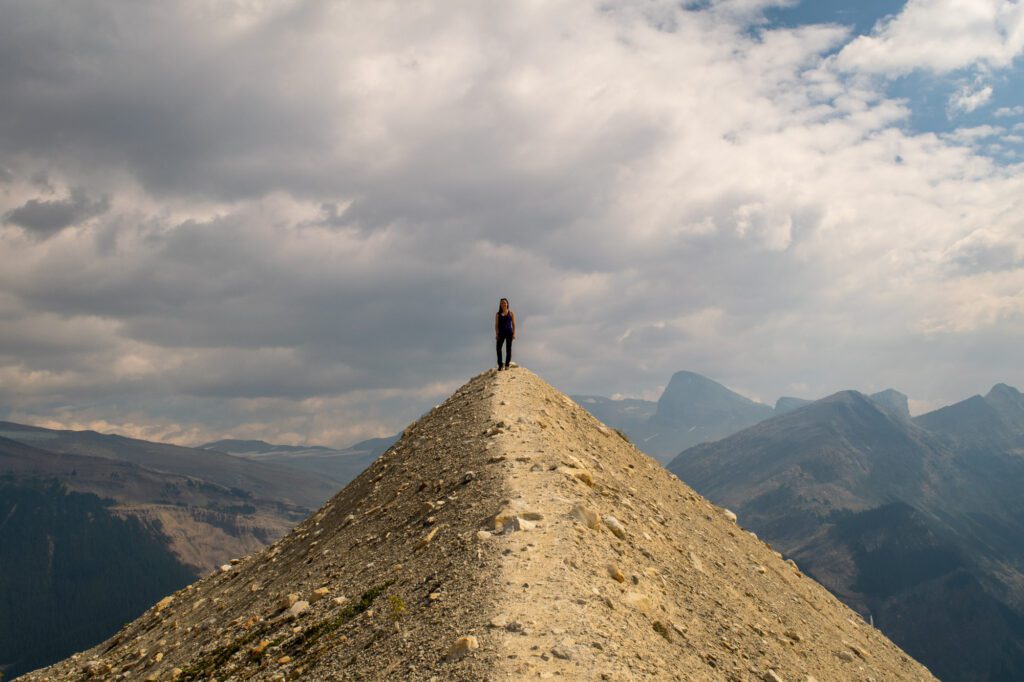
There are several world class hikes – namely, the Iceline Trail (we’d do it as a loop – more on that in a second) – and plenty of other attractions to occupy an extra day.
- The Iceline Trail : If you’re up for a big hike, this is the one you should do. It has two things going for it. One, you get up above the treeline into the rocky alpine landscape high above Takakkaw Falls. Two, you get what is probably the best view of Takakkaw from the ridgeline looking across the valley. The best way to do this – and we wish we had known this before our hike – is as a loop that goes up the Iceline Trail switchbacks and comes back down via Laughing Falls.
- Twin Falls & Laughing Falls: This is an easier hike, heading out from Takakkaw Falls to the Little Yoho Valley, passing three waterfalls along the way. The full lollipop hike is nearly 10 miles and 2,500 feet of elevation gain, but the shorter out-and-back hike to Laughing Falls gets you two of the waterfalls at a much lower effort. More information on the longer hike here.
- Wapta Falls : This is in a different part of the park, a few miles west along the Trans-Canada Highway from the turn offs to Takkakaw and Emerald Lake. It’s an impressive waterfall, though the hike isn’t particularly beautiful. It’s worth a stop if you’re heading west to Glacier (or you’re driving back to Vancouver to finish a Vancouver to Banff road trip ), but probably not worth the detour for most people.
Lake O’Hara (1-2 Days)
You caught us! Technically, Lake O’Hara is in Yoho National Park, but we think it deserves its own line item here because it is both spectacular and hard to access. It’s a paradise of alpine lakes and hanging valleys.
We didn’t get to do it this last trip because the shuttle doesn’t allow dogs (which we totally understand), and Matt is currently contemplating going back on his own JUST to go to Lake O’Hara for a few nights (don’t tell Alysha or Lupine).
Basically, the only ways to access Lake O’Hara – which is a hub for some great hikes and also a gorgeous lake itself – are by shuttle or by walking a long forest road (11km each way).
You can learn about how to secure a shuttle spot here , including when the reservations open, how to get one, and everything else you might want to know.
In terms of staying overnight, there is a campground at the lake, along with a couple of lodges. All of the options are very, very competitive, and if you want to stay overnight out there you’ll have to book early. More information here .
Glacier National Park of Canada (2 Days)
Though it is a little far from Banff and Jasper, we think Glacier National Park (of Canada) is worth the slight detour. If you’re a mountain lover like us, it offers some of the best high alpine hiking in Canada with a TINY fraction of the crowds that you’ll find in Banff and Jasper.
The hiking is the main draw here, and two days and two nights is enough to get in a couple of great hikes.
We’d do Abbott Ridge (we met a search and rescue person at Glacier who said this is her favorite hike in the park, but we had to skip it) and either the Great Glacier Trail (shorter and easier) or Asulkan Valley (longer trek with more Grizzly bears) on your second day.
As you might expect, the best way to experience Glacier National Park is to camp, because there just aren’t very many places to stay near the park.
Stay at Illecillewaet Campground , if you can, which is also the trailhead for most of the best hikes in the park.
However, we originally booked a room at Heather Mountain Lodge , which is the closest lodging option to the park, before we realized they didn’t have a kitchen (which does not work for Matt, who has Celiac Disease and needs to be able to cook) and we had to cancel.
It’s pricey, but the proximity to the park and the sheer beauty of the cabins are worth it, we think.
What to Do With Less Time (7-9 Days)
With less time in the Canadian Rockies, there are a few changes you can make to the itinerary above to maximize your time.
The first thing we’d say is that you should not cut any time in Lake Louise. Don’t try to do Lake Louise and Moraine Lake in a single day – keep those two days as written above.
The two places you can and should cut time are going to be around Banff, which we think you can limit to two days (including the day you arrive) and the Icefields Parkway, which you can spend less time on than the 1.5 days we recommend above.
To make it work in eight days, we’d drive back to Lake Louise from Jasper on the second full day, so you’re only spending two nights in Jasper.
Oh, and you won’t be able to fit in Yoho, we think, so save it for next time.
Here’s what an eight day trip might look like.
- Day 3: Drive Banff to Jasper (Sleep in Jasper)
- Day 4: Jasper National Park
- Day 5: Jasper & Drive to Lake Louise
- Day 6: Lake Louise
- Day 7: Moraine Lake
- Day 8: Drive Back to Calgary
Matt is the founder and main writer behind Wheatless Wanderlust, which he started back in 2018 as a way to share his gluten free travel guides with his fellow Celiac travelers.
Since then, Matt and his wife Alysha have visited 18 national parks, spent three months in Europe and six weeks in Colombia, and have explored every corner of the Pacific Northwest, which is where Matt grew up.
He writes super detailed guides to the places they visit, bringing together personal experience and historical context to help YOU plan an amazing trip.
Hi Matt and Alysha thank you so very much for publishing this Canadian Rockies Tour Guide it is so far the most informative article I’ve ever read . It is very detailed and will surely guide us if ever we will be given a chance to travel . More power to you and GOD be less
You’re so welcome! Hopefully you’ll get to explore the Canadian Rockies at some point soon – it’s an incredible place and we can’t wait to go back! Cheers!
You’re so welcome! Hope you get to make it to the Canadian Rockies at some point in the future 🙂
Hi there, thanks for this brilliant itinerary. I am looking to do something like this but with adding Vancouver on. How much time do you think I would need for this and is there a way you would recommend doing this sort of trip where you fly in/out of Vancouver/Calgary and leave from the other? Thanks
Hey Emma! I’d probably say that you need 10 days or more for that trip, and it’ll probably be pretty rushed. 14+ days would be better. And I would DEFINITELY fly in/out of Vancouver and Calgary to avoid having a long drive to get back to the airport. One way is the way to do it!
Love your blog! You explain like a teacher, lol. (Going to Banff in a couple of weeks.)
That is not the first time someone has likened my (Matt’s) style to a teacher. Breaking things down and explaining them in an understandable way is important for both a teacher, and what we do! Hope you enjoy(ed) Banff!
Leave a Reply Cancel reply
Your email address will not be published. Required fields are marked *
This site uses Akismet to reduce spam. Learn how your comment data is processed .

CHARLIES WANDERINGS
THE TRAVEL BLOG FOR HIKING LOVERS AND AESTHETIC TRAVEL GUIDES

CANADA · November 27, 2022
The Ultimate 2 Weeks Canadian Rockies Itinerary
This post is also available in: Nederlands
Are you on the hunt for the best Canadian Rockies road trip itinerary that will take you along the most spectacular places in both British Columbia and Alberta? When planning your own trip feel free to modify our Canadian Rockies itinerary based on the amount of time that you have!
Or maybe you don’t want to spend too much time driving? That’s totally fine as well! Most of our itinerary covers places in the state of Alberta but we chose to fly to and from Vancouver because we absolutely wanted to see killer whales.
I recommend visiting the Canadian Rockies for at least a week, but 2 weeks is way more ideal for a Canadian holiday . And know that no matter how long you choose to spend in this wonderful part of the world you’ll have an absolutely fantastic time!

I did a ton of research while I was planning our very own road trip but one day before we left I discovered that almost all of the hiking trails that I had planned on doing were still completely covered in snow and way too dangerous.
So I pretty much had to wing it but in the end we were able to create an incredibly diverse itinerary that will take you through amazing nature and wildlife sightings like you’ve never experienced before .
Here is our Canadian Rockies road trip guide!

The Ultimate Canadian Rockies 2 Week Road Trip Itinerary
Planning a trip to the Canadian Rockies can feel a little overwhelming sometimes. Especially if it’s your very first time visiting the country the logistics of it all can seem a little daunting.
From figuring out which National Parks to visit to how to get around and where to stay. I will share all of the details of our Canadian Rockies road trip so that if you want you can simply copy paste our itinerary .
Quick facts about our Canadian Rockies road trip itinerary
Starting point – Vancouver. Fly into Vancouver International Airport
End Point – Vancouver. Fly from Vancouver International Airport
Both or one of these can be replaced by Calgary, depending if you want to make it a one way trip.
Mode of transportation – We rented a camper van from Outdoorsy . They are like the AirBnb for campers and RV’s in both Canada and the USA . If you would like your pick up location to be different from your drop off location, this is usually possible at an extra fee.
📖 READ MY ULTIMATE GUIDE ON CAMPING AND CAMPGROUNDS IN THE CANADIAN ROCKIES
Best time to plan this trip – Halfway June to end of September
States covered in Canada – British Columbia and Alberta
Parks covered in Canada – Joffre Lakes Provincial Park, Jasper National Park, Banff National Park , Kananaskis Country and Yoho National Park
Duration of itinerary – 2 weeks
Parks Canada Discovery Pass – This allows you entrance to all Parks Canada destinations for the year and is only $145.25 for a family ($72.25 per person).

Best time of the year for a Canadian Rockies road trip
When planning your Canadian Rockies road trip, the time of year that you visit is one of the most important factors to take into consideration. The best time of the year to travel to the Canadian Rockies is summer and early fall.
Winter is not a good idea because a lot of the roads will be closed off due to harsh weather conditions.
Spring can also be very cold and all of the places that are a little higher elevation will still be snowed in or the lakes will still be frozen. This road trip will take you straight through the mountains and that’s not a good idea if all the roads are covered in snow.
The best time to plan a Canadian Rockies road trip is late summer and early fall . By then all of the snow will have melted, the weather will be warm and you’ll be able to enjoy all the activities. Do know that this is also high season and that campings can book up pretty fast during this season.
If you go too late then chances are high that roads will close again because well it can already start snowing in Canada as soon as October.

When to start planning your Canadian Rockies road trip itinerary
How much from before you need to start planning your Canadian Rockies road trip itinerary depends entirely on when exactly you’re planning to go.
If you’re visiting in July and August you’ll have to book your accommodation from before . This won’t give you a ton of flexibility but these two months are peak season for the Canadian Rockies.
When traveling with a camper van make sure to book it in time. Rent an RV or camper through Outdoorsy and you won’t have to worry much about accommodations.
In the peak summer months you will find it very handy to book camp sites in advance , especially in the more popular areas like Banff, Lake Louise or Jasper. All bookings can be made on the Parks Canada Reservation Website.
If camping is not your thing you can find the best accommodations through Booking.com . I’m a big fan of their loyalty program that offers up to 20% booking discount once you reach Genius Level 3. I recommend looking at hotels and B&B’s at least 5 months from before .
When it comes to renting a car I always choose SunnyCars . You can cancel free of charge up to 1 hour before departure and all insurance is included in the price upfront. You don’t need a 4×4 vehicle when exploring the Canadian Rockies.
We planned our trip during the last 2 weeks of June and I arranged our camper van at the start of January. For our camp sites we were able to simply drive up during the day and grab a spot.

Best Canadian Rockies Road Trip Itinerary
Below I’m sharing a suggested itinerary for your Canadian Rockies road trip, based on our own adventure.

Now let’s talk through the day to day itinerary
DAY 1 – VANCOUVER
Fly into Vancouver International Airport and pick up your rental car or camper/RV. From here it’s time to start driving towards Yoho National Park which is about 9 hours driving. After a long flight it’s totally fine if you don’t get a ton of driving done yet today. Just do some basic grocery shopping and drive as far as you can.
You’ll drive along the Trans Canadian Highway 1 towards Kamloops. If you’re traveling with a camper or RV you can find a camp site nearby using the phone app WikiCamps Canada . For our first night we stayed close to Spences Bridge, British Columbia . We found a free camp site, cooked our very first meal and crawled underneath our blankets.
After a 36 hour travel day it didn’t take long before both of us were sound asleep.

DAY 2 – YOHO NATIONAL PARK
Wake up early, grab some breakfast and keep on driving towards Yoho National Park , which sits at the end of British Columbia. On the way you’ll see the scenery changing and once you reach Emerald Lake you’ll be in the heart of the Canadian Rockies. No matter where you look you’ll be surrounded by incredible mountain ranges.
Emerald Lake is the perfect place for an afternoon stroll and can be found after driving up a side road of the TCH near Field . There’s a pretty big parking lot where you can station your car/camper.
💡 TIP – Almost every parking lot is equipped with spaces large enough for RV’s and motorhomes. Our camper from Outdoorsy was still small enough to fit a regular size parking.
We completed the hiking trail around Emerald Lake, which is about 5.2km and has little to no elevation. Pretty much the perfect hike after a long day of driving!
We spent the night at the nearby campsite Kicking Horse Campground . If you want to splurge and stay at an incredible location you should book a night at the Emerald Lake Lodge . Their rooms come with a view over Emerald Lake and the Rocky Mountains.

DAY 3 – BANFF NATIONAL PARK
Rise and shine today because today you’ll visit Moraine Lake at sunrise . Make sure that you arrive 1 hour before sunrise because there’s only one road leading to Moraine Lake and once the parking lot is full this road gets closed off.
❗️ 2023 UPDATE – As of 2023, Moraine Lake Road will be closed to privately owned vehicles. According to Parks Canada, access to the lake will be by Parks Canada Shuttle, Roam Transit, commercial buses and taxis from June to mid-October.
The trail to the rock pile viewpoint is located on the left once you leave the parking and it takes about 10 minutes to reach the top. It’s easy to find yourself a spot more away from the crowds. Cause no matter what time of day, there will be a lot of other people here.

Drive down to Banff and grab breakfast at Melissa’s Missteak and enjoy the view over the mountains from their second floor. If you’re still tired after this morning grab the best coffee in Banff at Whitebark Cafe and explore the town on foot.
From Banff drive to the nearby Cascade Ponds . Cascade Ponds are a series of ponds that lie under Cascade Mountain and they’re beautiful to visit year round. But in the summer you can hold a bbq here at one of the picnic tables.

The last stop of day 3 of your Canadian Rockies road trip itinerary is Lake Minnewanka and the Lake Minnewanka scenic drive . Hike the shoreline trail for incredible views over the Lake Minnewanka reservoir and its surrounding mountains.
💡 TIP – Since this hike is on the edge of core grizzly territory, there are seasonal restrictions in place. Between July 10 and September 15, cycling is not permitted, hikers must hike in tight groups of 4 or more (carrying bear spray) and dogs are not permitted past the Stewart Canyon Bridge.

The Lake Minnewanka Scenic Road starts close to the Trans Canada Highway exit and it’s a short loop that passes by lake Minnewanka and Two Jack Lake.
I highly recommend circling this road before sunset or in the early morning the next day for the biggest chance of wildlife sightings. Don’t forget to stop by Two Jack lake for an incredible view over Mount Rundle .
Set up camp at the Two Jack Lakeside Campground . This is a rather popular campground so I suggest checking in at 2pm.
Another option is to stay at Banff. You can stay at one of the most iconic hotels in Canada, the Fairmont Banff Springs or the Mount Royal Hotel , another historic hotel that dates back to 1908 and is located right in the center of Banff.

DAY 4 – LAKE LOUISE
Day 4 of your Canadian Rockies road trip itinerary starts with a drive up to Lake Louise . Start your day early so you can get the most out of your time here. Lake Louise is one of the most iconic places in the Canadian Rockies.
There’s a pretty big parking lot at Lake Louise but during the busiest summer months it can definitely fill up rather fast, especially on the weekend. So make sure to arrive early, that means before 8am to secure yourself a spot. Lake Louise introduced paid parking from 7 a.m. to 7 p.m during high season. The parking at Lake Louise costs 12.25CAD for a full day of parking per vehicle.
Start your morning by watching the sunrise over Lake Louise and if you’re really lucky (like we were) you can also spot a grizzly bear with her cubs.

By 8am make sure to get in line at the boat dock to be one of the first ones in line to rent a canoe. The dock is run by the Fairmont Chateau Lake Louise and its open daily in-season from 8.30am to 7pm . The price is 145CAD for 1 hour , which is plenty of time to paddle across the entire lake. It’s definitely not cheap but renting a canoe is definitely one of the top things to do at Lake Louise .

Next up is one of the most fun hikes in the Canadian Rockies , the Little Beehive and Agnes Lake Teahouse. On your way up you’ll first come across Agnes Lake Teahouse where you can grab a cup of their famous tea. Make sure to bring cash with you cause they don’t accept cards.
Afterwards you can continue hiking and after a short burst upwards you’ll reach one of the most spectacular views over Lake Louise and the Canadian Rockies . There are several outlook points at the Little Beehive just be careful when you’re standing close to the edge.

In the evening we’ll drive back down to Banff where you can stay at the same accommodation as the night before. If you want you can drive the Lake Minnewanka Scenic Road again to increase your chances of spotting wildlife.

DAY 5 – KANANASKIS COUNTRY
Kananaskis Country is one of the more remote areas but should definitely be a part of your Canadian Rockies road trip itinerary ! To visit Kananaskis Country you’ll need a Kananaskis Conservation Pass ($90/year for 2 vehicles), which can be purchased through the Alberta Parks website . You can also buy a daily pass at $15/day but this only registers 1 vehicle.
We only needed a pass for 2 nights and bought them at the Kananaskis Visitor Information Centre .
💡 TIP – Cell service in Kananaskis Country is pretty much non existent so make sure to download all of your maps and trails from before.
Today we’ll hike the Barrier Lake Trail , one of the very few places in Canada where you’ll find yourself in the Canadian Rockies and also see the prairie.
You can do the trail to the Prairie View Lookout either as an out & back hike or as a loop. I highly recommend doing it as a loop! It will add a couple more kilometers but it’s a lot less dull and you’ll also pass by a waterfall! The total length of the Barrier Lake Trail is 15.4km.

Drive down to the Kananaskis Interlakes Campground , one of the most scenic campgrounds in Kananaskis Country.
We were also greeted by an older female grizzly bear who roams this campground eating flowers wherever she goes.

DAY 6 – KANANASKIS COUNTRY
For your second day in Kananaskis Country you can choose from an abundance of different hikes. there’s the Smutwood Peak Trail, Tent Ridge, Sarrail Ridge or Windtower . We opted for the last one cause at the time of our visit there was still too much snow on the other trails and a high risk for avalanches.
Drive up to Spray Lakes and park at the West Wind Pass Trailhead . Make sure to bring enough layers with you cause even on a sunny day it can get incredibly windy on top of the mountain and the weather can shift in a minute. The hike starts pretty mild and winds up through the forest until you reach the West Wind Pass . For a lot of people this is the end of their hiking journey and while the view from here is already pretty stunning, it’s nothing compared to what you’ll find on top of the mountain!

The path now goes alongside the mountain and for a while it remains flat with some climbing involved. the last part of the hike is another 400 meter climb up on loose gravel rocks. Easy to hike back down but a pain in the ass to hike up. Take small steps and bring hiking sticks with you for some extra support.
Once you’re at the top get ready to enjoy spectacular 360° views !

After your hike get ready to drive back up towards Banff National Park cause tomorrow you’ll drive one of the most scenic roads in the Canadian Rockies!
We camped at the Mosquito Creek Campground , which is really close to Peyto Lake. And no worries, its name is just very unfortunate. You won’t find any more mosquitos here as anywhere else in the Canadian Rockies.
DAY 7 – ICEFIELDS PARKWAY
On day 7 of this Canadian Rockies road trip itinerary you’ll drive one of the most spectacular roads in the entire world. The Icefields Parkway connects Banff National Park with Jasper National Par k and with its 232km (144 miles) it’s easy to drive in a single day.
Along the way you’ll have to make several stops cause the Icefields Parkway is dotted with more than 100 ancient glaciers, cascading waterfalls and emerald lakes set in sweeping valleys of thick pine and larch forests.
Below you can find our favorite stops
- Mistaya Canyon
- Tangle Creek Falls
- Sunwapta Falls
- Athabasca Falls

After driving the Icefields Parkway you’ll arrive at Jasper National Park where you’ll stay for the next couple of days.
With our camper we chose to stay at the Wapiti Campground . If you’re looking for a hotel then I would either go for the Fairmont Jasper Park Lodge or the Pyramid Lake Resort , which gives you an incredible view over one of the most beautiful lakes in the Canadian Rockies .
DAY 8 – JASPER NATIONAL PARK
Start your day early by watching the sunrise over Pyramid Lake , one of the best things to do in Jasper National Park . Head to the wooden bridge that connects the shore to Pyramid Island for one of the best viewpoints.

Next up is the Valley of the Five Lakes Trail , one of the most beautiful and rewarding hikes in Jasper National Park. This easy hike will take you along 5 pristine lakes, one even more beautiful than the other and can be enjoyed by the entire family.
It’s a very popular hike in Jasper National park and the parking lot is located right next to the Icefields Parkway. It’s not the biggest parking lot so I do advise you to arrive before 9am to make sure you can grab a spot!

Next you should head to Downtown Jasper to grab lunch at Jasper Brewing Company .
After lunch it’s time to visit one of the most popular places in Jasper National Park, the Maligne Canyon . Maligne Canyon is the deepest canyon in Jasper National Park , with a depth of more than 50 meters at certain points. You can explore this incredible landmark by crossing 6 bridges built across various points of the canyon. There are several parking lots from where you can start this loop. We started at the fifth bridge which was pretty cool cause that way we saved the best for last! At bridge number 3 you’ll find an impressive waterfall and towards bridge number 2 and 1 the canyon is at its deepest.

Drive back to Jasper and go and grab your canoe gear at Pure Outdoors for tomorrow’s adventure! It’s best to contact them a couple of days from before and if you want to replicate our itinerary you need to ask them for a 24 hour rental that starts the day before at 7pm. Renting a canoe for 24 hours will cost you €100 .
Drive up to Maligne Lake and Pure Outdoors will make sure your canoe is already there. All you have to do is unlock it.
Watch the sunset over Maligne Lake and park at the parking lot next to the dock . If you’re with a camper you can still catch a few hours of sleep before getting up in the middle of the night.

DAY 9 – SPIRIT ISLAND
So the goal for today is to reach Spirit Island by sunrise ! Spirit Island is one of the most iconic landmarks in Canada’s Rocky Mountains and the only way to reach it is by boat. Everyday at 9am overpriced tourist boats head out to see it but we will already be there at sunrise!
To reach Spirit Island you’ll have to canoe 14km one way which takes 3.5 to 4 hours depending on your skills and physique. Don’t do this adventure on your own, make sure there’s two of you in the canoe. We timed our start 4.5 hours before sunrise which meant we had to start paddling at 1am.

Once you reach Spirit Island drag your canoe on the shore across from it and enjoy the quiet and solitude while watching one of the most incredible moment s from this Canadian Rockies road trip itinerary.
After 2.5 hours we decided to paddle back so we weren’t bothered too much by the currents created by the tourist boats.

After arriving back to your camper/car you can drive back to Jasper to indulge in some much deserved breakfast or lunch. We tried to stay awake as long as possible afterwards on our campsite but by 6pm we were sound asleep that day.
DAY 10 – JASPER NATIONAL PARK
Your last day in Jasper National Park is another hiking day! But with this hike the reward versus the endurance is definitely worth it!
Drive up to the Miette Hotsprings to hike the Sulphur Skyline Trail . I really enjoyed this hike cause the elevation goes gradually and at the very end there’s a bit of a steep climb. But by then you are already above the tree line and you can enjoy the incredible views while hiking up.
And do you want to know the best part? After completing this hike you can take a dip in the Miette Hotsprings.

Since this will be your last day in the province of Alberta and tomorrow will be a long driving day, make sure to also rest enough. We spent the afternoon at Jasper Brewing Company before spending our last night at the Wapiti Campground.
DAY 11 – DRIVE FROM JASPER TO JOFFRE PROVINCIAL PARK
Today you’ll be doing a lot of driving, especially if you also want to see some of the most incredible places in British Columbia.
Make sure to stop by the Mount Robson Visitor Centre for one of the most incredible views over Mount Robson.

Along the way you can also make a small detour to the Helmcken waterfall and later on grab lunch at Kamloops at either the Sandbar Grill or at the Red Beard Cafe and try their hamburger with Brie cheese.
Our final stop of the day is one of the campsites closest to Joffre Lakes Provincial Park. We opted for the Rogers Creek Rec Site . If you’re looking for a hotel in the area the closest town is Pemberton .
DAY 12 – JOFFRE LAKES PROVINCIAL PARK
During this hike near Pemberton you’ll pass by all 3 lakes and all of them are vibrant turquoise in color. That is if the sun is shining, otherwise they’ll look more emerald. You’ll pass by the first lake after only 200 meter into the hike but after that it’s a bit of a climb up. My favorite was lake number 2 and from there it’s only a short hike up to lake number 3 which will also take you across a couple of bridges and alongside a waterfall.
I recommend starting your hike in the early morning since it’s a very popular route.
💡 TIP – A free Day-Use Pass is required to hike this trail during high season. Reservations can be made with BC Parks .

After spending the morning at Joffre Lakes it’s time to drive down to Vancouver. A fun activity to do is visit the Capilano Suspension Bridge Park , one of the most popular activities in Vancouver. Tickets are 63CAD, which gives you access to all park attractions.

In Vancouver we stayed at the Capilano River RV Park , a big difference from all of the scenic campgrounds from before but your best option if you also want to visit Vancouver with a camper.
If you’re looking for a hotel in Vancouver then the area of Downtown Vancouver is a really good option.
DAY 13 – VANCOUVER
Start your last day of this epic Canadian Rockies road trip itinerary with one of the best activities to do in Vancouver. Head over to Granville Island where you can board the Prince of Whales which will take you towards the area of Vancouver Island to go whale watching .
🐳 This is the exact whale watching tour from Vancouver that we booked – Vancouver, BC: Whale Watching Tour
During this tour you’ll have a guaranteed chance of seeing killer whales, also known as orca’s.

If you’re up for one more hike then I highly recommend driving up to Cypress Mountain to hike up to St Marks Summit . This 11km round trip will take you through a beautiful forest trail and at the end offers you an incredible view over Lion’s Bay.

On your drive down make a quick stop at Cypress Lookout to watch the sunset over Vancouver. If you’re in the mood for good food I highly recommend booking a table at either Miku Vancouver or Cardero’s Restaurant

DAY 14 – VANCOUVER
If you have a little time before your flight leaves this is an ideal time to simply wander around Vancouver.
Below you’ll find some of my favorite things to do in Vancouver:
- Wander around Queen Elizabeth Park
- Visit the Vancouver Art Gallery
- Enjoy Vancouver’s Beaches
- Exploring Historic Gastown
Afterwards it’s time to drop off the camper or rental car and checkin for your flight back home.
I hope you’ve found this 2 week Canadian Roadtrip Itinerary useful and that you’ll have an amazing time exploring this beautiful region.

All rights reserved © Charlies Wanderings. Republishing this article and/or any of its contents (text, photography, etc.), in whole or in part, is strictly prohibited.

Charlotte Lint is the founder, main photographer and writer of Charlies Wanderings . She has traveled all over the world and is based in Belgium where she also owns her very own dental practice. She is an expert on writing insightful hiking guides and creating unique and efficient travel itineraries . Every month she helps over 134.000 people discover the most beautiful places in the world through her detailed travel guides.
You’ll Also Love

Leave a Reply
You must be logged in to post a comment.
DESTINATIONS
TRAVEL ITINERARIES
TRAVEL WITH KIDS

Charlies Wanderings is a travel blog for unique travel itineraries and hiking guides with colorful photos and insightful travel info.
COPYRIGHT ©2024 CHARLIES WANDERINGS
Copyright © 2024 CHARLIES WANDERINGS Theme by 17th Avenue
Copyright © 2024 · Charlotte on Genesis Framework · WordPress · Log in
Rocky Mountains in Canada

- 2.1 Alberta
- 2.2 British Columbia
- 3 Other destinations
- 4 Understand
- 6.1 By plane
- 6.3 By train
- 7 Get around
- 10 Stay safe
<a href=\"https://tools.wmflabs.org/wikivoyage/w/poi2gpx.php?print=gpx&lang=en&name=Rocky_Mountains_(Canada)\" title=\"Download GPX file for this article\" data-parsoid=\"{}\"><img alt=\"Download GPX file for this article\" resource=\"./File:GPX_Document_rev3-20x20.png\" src=\"//upload.wikimedia.org/wikipedia/commons/f/f7/GPX_Document_rev3-20x20.png\" decoding=\"async\" data-file-width=\"20\" data-file-height=\"20\" data-file-type=\"bitmap\" height=\"20\" width=\"20\" class=\"mw-file-element\" data-parsoid='{\"a\":{\"resource\":\"./File:GPX_Document_rev3-20x20.png\",\"height\":\"20\",\"width\":\"20\"},\"sa\":{\"resource\":\"File:GPX Document rev3-20x20.png\"}}'/></a></span>"}'/> The Rockies are a region of Canada that more or less form the border between the provinces of British Columbia and Alberta . The roads and railway routes here are amongst the most beautiful in the world. Much of the Rocky Mountains of Canada lie within various national and provincial parks. The Canadian Rockies continue southward, as the American Rockies .

Wikivoyage has a separate article for the Alberta Rockies region so see there for more detail, but in brief the main attractions here are:
- Banff National Park , including the towns of Banff and Lake Louise
- Jasper National Park , including the town of Jasper
- Kananaskis Country , including the town of Canmore
However, the Rockies also extend into Southern Alberta , notably the Crowsnest Pass and Waterton Lakes National Park .
The British Columbian half of the Canadian Rockies are within the Northern British Columbia and Kootenays regions, and more specifically the sub-regions of Columbia-Rockies and East Kootenays (which includes Yoho National Park and Kootenay National Park )
Cities and towns
- 51.05 -114.066667 1 Calgary , not in the Rockies, but the closest major city and airport to them.
- 51.1781 -115.572 2 Banff , oldest and most famous resort town in the Canadian West.
- 51.083667 -115.368028 3 Canmore , newer cousin to Banff.
- 49.625 -114.468056 4 Crowsnest Pass , a series of small, former mining towns which amalgamated, less touristy than Banff or Jaser.
- 53.4114 -117.564 5 Hinton , gateway to Jasper park.
- 52.8731 -118.082 6 Jasper , hub of Jasper Park, less crowded alternative to Banff.
British Columbia
- 49.5136 -115.769 7 Cranbrook , main town in southeastern BC, complete with a small airport.
- 49.5042 -115.063 8 Fernie , right in the Rockies, famous for skiing and snowboarding.
- 51.3019 -116.967 9 Golden , increasingly popular resort town, and closest town west of Yoho National Park.
- 50.508333 -116.030278 10 Invermere , sporting town with ski resort, outdoor skating trail, and outdoor curling tournament; hot springs located at nearby Fairmont Hot Springs and Radium Hot Springs .
- 49.669722 -115.9775 11 Kimberley , former mining town, now known mostly for German-themed kitsch and mountain biking trails.
- 52.831111 -119.276111 12 Valemount — a world-class snowmobiling destination close to Mount Robson Provincial Park.
Other destinations
- 51.166667 -115.55 1 Banff National Park , the granddaddy of all Canadian national parks. A world-famous destination since 1885.
- 52.34 -116.36 2 David Thompson Country , wilderness area centred around the hamlet of Nordegg along the David Thompson Highway (Highway 11)
- 52.8 -117.9 3 Jasper National Park , northern cousin to Banff, with all the scenery and half (or less) the traffic.
- 50.9 -114.9 4 Kananaskis Country , not a national park, and therefore not as famous, but also full of mountain scenery.
- 50.8831 -116.049 5 Kootenay National Park
- 53.0339 -119.232 6 Mount Robson Provincial Park , home to the tallest peak in the Canadian Rockies.
- 49.05 -113.933333 7 Waterton Lakes National Park , southern Alberta park with resort town and a lake that stretches into Montana, part of Waterton Glacier International Peace Park .
- 51.3953 -116.487 8 Yoho National Park , in BC just across the border from Banff
The history of the Canadian Rockies - like that of so much else of Canada - is based in the fur trade and the railway. The first Europeans to view the Rockies were a ramshackle collection of pioneers who ventured there on behalf of their respective fur trading companies. Most significantly, David Thompson ventured through Howse Pass on behalf of the North West Company in 1804, establishing Kootenay House, near what is now Invermere .
In 1871, Canadian Prime Minister Sir John A MacDonald convinced British Columbia to join Canada with the promise of a national railway that would connect it to the rest of Canada. The Canadian Pacific Railway was completed on November 7, 1885, and the last spike was driven in Craigellachie, BC.
In the following 50 years, Banff , Jasper , Waterton, Yoho and Kootenay National Parks were established, and the area became a tourist destination. The gorgeous scenery and unblemished wilderness are but some of the reasons that most of the area is a designated UNESCO World Heritage Site and draws millions of visitors every year.
There is wide variability of atmosphere throughout the area. Banff and Lake Louise are likely the most developed towns, while the villages of Field and Elkford attract more through their natural splendour than via any attractions within the communities themselves.
The region is probably one of the most scenic in the world between the spectacular mountains, widespread forests and glacier fed lakes. The weather in the summer tends to be hot (30°C) and sunny. In winter it is colder at around -15°C and fantastic for skiing at the area's many resorts.
The people living in this area are Anglophone Canadians and therefore speak English. Many Brits, Australians and New Zealanders work in the tourism industry during the peak summer months, meaning that you will hear English with a wide variety of different accents. Canadian National Parks are operated under Federal jurisdiction, and therefore have signs, brochures and (theoretically) all services in French, as well as understandable pictograms. Banff is a major international destination, and the tourist industry recognizes the role of international visitors; tourist services are usually available in Japanese and German, and increasingly in languages such as Mandarin and Spanish.
In the Canadian Rockies, Banff townsite is the most foreign-language-friendly, followed closely by Lake Louise. Jasper is the next best bet, with travellers advised to check before travelling to smaller or more remote sites such as Radium, Field, Waterton and Kananaskis.
The closest international airports are located in Calgary and Edmonton . Some travellers arrive into Vancouver either fly to the regional airport in Cranbrook or drive to the Rockies.
There are tour operators that transport passengers between Edmonton and Jasper via train and bus.
Banff is about a 2-hour drive from Calgary . Jasper is about 3 hours from Edmonton . Either one is about a 10- to 12-hour drive from Vancouver. The highways from Vancouver run through alpine passes, and can be closed or slowed due to avalanches, accidents or other such problems. Closures are most common in winter, which is roughly from October to May. Drivers with little or no winter driving experience are cautioned against long alpine drives in snowy, icy or cold conditions.
Several intercity bus operators have route that cross the Rocky Mountains, while traveling between Alberta and British Columbia , including the following:
- Mountain Man Mike's Bus Service , ☏ +1-778-382-7729 , [email protected] . Once per week bus service between Nakusp and Calgary including stops in Cranbrook and Fernie. ( updated Mar 2022 )
- Thompson Valley Charters , ☏ +1 877-769-3287 . In partnership with Ebus, operates twice per week service between Kamloops and Edmonton including stops in Valemount, Jasper, and Hinton. ( updated Mar 2022 )
A few additional bus operators have routes between Calgary and Banff , and Edmonton and Jasper . Refer to the listing for the destination city for available operators.
There are a number of extremely scenic highways through the Rocky Mountains.
- Icefields Parkway - connects Banff to Jasper
- Hiking in the Canadian Rockies — a popular pastime in the region.
- Has custom banner
- Has mapframe
- Has map markers
- Go listing with no coordinates
- All destination articles
- Extra regions
- Region articles
- Has Geo parameter
- Pages using the Kartographer extension
Navigation menu
Avid adventurer, travel blogger, and experience seeker. Starting each morning with a desire to see the world through a different lens.

19 Incredible Places to Visit in the Canadian Rocky Mountains
The Canadian Rocky Mountains are filled with incredible places to visit, ranging from stunning hikes, powerful waterfalls, and colourful lakes. Also known as the Canadian Rockies, this mountain range is a popular destination throughout every season. Travellers from around the world visit to admire the roaring mountains, which look straight out of a postcard.

With so many incredible places to visit in the Canadian Rocky Mountains, you will struggle to visit them all in a single trip. After visiting once, the Rockies are sure to have you wanting to visit again as soon as possible!
Continue reading the explore the best places to visit in the Canadian Rocky Mountains in both Alberta and British Columbia!
**Please note that this blog post uses affiliate links. If you make a purchase through my link, I will receive a small commission at no cost to you.
Table of Contents
Where the Canadian Rocky Mountains Are Located
The Canadian Rocky Mountains are located along the border of Alberta and British Columbia. There are so many incredible places to visit throughout the mountain range that you will have to spend quite a long time here to explore the highlights.
To get to the Canadian Rockies, most people fly into Calgary or Edmonton. From there, it is typical to rent a car and drive out to the mountains.
When to Visit the Canadian Rocky Mountains
While the Canadian Rocky Mountains are great to visit all year round, you will certainly get a different experience depending on when you visit.
Spring: The Rockies are beautiful to visit in Spring as the trees and flowers become full of life again. During this time, you can expect the waterfalls to be at their peak volume, and be able to hike before the peak tourist season.
Summer: Summer is definitely the peak tourist season and it’s no secret why! The weather is beautiful for exploring and the mountains look incredible. It will definitely be busy during this time. You may have to arrive at the popular attractions very early in the morning.
Fall: My favourite time to visit the Rocky Mountains is during the fall. The weather is cooler and you can find some pretty fall foliage around the area.
Winter: The Rocky Mountains in the winter can have quite treacherous conditions for driving. You definitely need a 4×4 vehicle with great snow tires in order to adventure. In addition, some of the side roads are closed and require you to hike to certain waterfalls or viewpoints. However, seeing the mountains and the area covered in snow is an incredible experience!
Best Places to Visit in the Canadian Rocky Mountains in Alberta
Jasper national park.

One of the most popular places to visit in the Rocky Mountains is Jasper National Park. Within the park, there are numerous waterfalls and hikes with views that are definitely postcard-worthy! There is a quaint town in the park with plenty of restaurants and shops to explore as well.
Check out some of the best places to stay in Jasper!
Athabasca Falls

Athabasca Falls is one of the best waterfalls to visit within Jasper National Park. It is located along the Athabasca River and is one of the most popular places to visit in this area.
Sunwapta Falls

Also located within Jasper National Park, Sunwapta Falls is a great waterfall to stop by on your way between Jasper and Banff. The waterfall is easily accessible, requiring only a few minutes of walking from the parking lot to reach. Here, you’ll be amazed by the power of the waterfall with incredible mountain views all around.
Valley of the Five Lakes

Valley of the Five Lakes is home to the best hike in Jasper National Park, in my opinion. This part of the park is home to – you guessed it – five lakes! Each lake has varying shades of emerald greens and turquoise blues that are sure to leave you speechless. The hike around the trails is low to moderate intensity, making it a great hike for the whole family.
Sulphur Skyline Trail

The Sulphur Skyline Trail is one of the best places to hike and visit in the Canadian Rocky Mountains due to the incredible views of the mountains. The hike is about 8 km roundtrip and offers the most incredible panorama views in Jasper National Park.
Maligne Lake & Maligne Canyon

Maligne Lake is quite popular as it is the largest natural lake in the Canadian Rockies. The water boasts incredible shared of blue and green and is surrounded by roaring mountains. One of the best attractions is taking the Maligne Lake Cruise to Spirit Island !
Banff National Park

Banff National Park is famous worldwide as it’s home to beautiful glacier lakes, incredible hiking, and jaw-dropping views. I find that it is much busier than Jasper National Park as it is home to the famous Lake Louise and Moraine Lake. You’ll have to arrive early during the peak season to avoid the crowds!
Check out the best places to stay in Banff!
Lake Louise

Lake Louise is famous worldwide as it is one of the most photogenic lakes in the world. Many arrive at sunrise to experience the beauty of the rising sun colouring the peaks of the mountains, creating beautiful reflections on the water. During peak season, you must arrive early in the morning to avoid crowds.
Moraine Lake

Moraine Lake is another world-famous lake located within Banff National Park. It is definitely one of the best places to visit in the Canadian Rocky Mountains! Like Lake Louise, people often arrive during sunrise to capture the beauty of the bright blue lake with the soft glow of the morning sun (pictured above).
Morant’s Curve

Morant’s Curve is a beautiful viewpoint located near Lake Louise and Moraine Lake. After visiting one (or both!) of the lakes, stop here to admire the beautiful blue river and the mountains in the distance. If you’re lucky, a train will be driving by, creating the perfect postcard shot!
Fun Fact: This is the place pictured on the Canadian $10 bill!

Lake Agnes is a beautiful lake accessible via a hike from Lake Louise. The hike brings you to a teahouse, where tea has been served in the mountains since 1905.
Plain of the Six Glaciers

Another fantastic hike near Lake Louise is Plain of the Six Glaciers. You will walk by roaring mountains and again reach a unique tea house to enjoy a warm beverage before continuing on your hike.
Columbia Icefield

The Columbia Icefield is the largest icefield in the Canadian Rocky Mountains. It is definitely one of the best places to visit in the Canadian Rocky Mountains overall due to the extravagance of the icefield and the six major glaciers it feeds.

Canmore is a popular town to visit on a trip to Banff National Park, as it is located close nearby. This quaint town offers great restaurants, boutique shops, and more incredible hiking trails!
Best Places to Visit in the Canadian Rocky Mountains in British Columbia
Helmcken falls.

Helmken Falls is one of the largest waterfalls in all of Canada. The powerful waterfall looks like it forces it’s way out of the side of the wall and drops 141 meters into a canyon. It is located just steps from the road and is beautiful to visit all year round.
Mount Robson Provincial Park

Mount Robson Provincial Park is the second oldest park in British Columbia. It is home to Mount Robson, which has the highest mountain peak in the Canadian Rockies at 12,972 feet. The park is filled with incredible hikes and camping for a wonderful nature-filled getaway.
Yoho National Park

Yoho National Park is one of the best parks and places to visit in the Canadian Rocky Mountains. It is home to stunning glacial lakes, tall waterfalls, and amazing fossil beds. It is home to the famous Emerald Lake, which boasts unique emerald colours.
Fun Fact: The word “Yoho” is a Cree expression for awe and wonder.
Kootenay National Park

Kootenay National Park has been high on my bucket list for a very long time, due to the amazing hikes the park has to offer. The park is home to fossil beds to explore, along with relaxing hot springs to visit.
Glacier National Park of Canada

Most of the most picturesque places to visit in the Canadian Rocky Mountains is Glacier National Park of Canada. It is home to many incredible hiking trails, amazing waterfalls, and panoramic views of the roaring mountains.
Book an Adventure in the Rocky Mountains
There are so many exciting excursions to book when visiting the Canadian Rockies, so be sure to check them out!
Book Your Stay Now
What would you add to this list of the best places to visit in the Canadian Rocky Mountains? Let me know in the comments!
Be sure to Pin this post for later!

You might also like:
- Exploring Sunwapta Falls, Jasper National Park
- Visiting Athabasca Falls, Jasper National Park
- The Best Day Hike in Jasper National Park
- The Perfect Winter Weekend Getaway in Mont-Tremblant, Quebec
16 of the Absolute Best Day Hikes In Canada
- Inglis Falls: The Most Beautiful Waterfall in Grey County, Ontario
- Taking Maligne Lake Cruise to Spirit Island in Fall
Subscribe to my blog to get updates on my latest posts!
Enter your email address

Related Posts

Amazing Fall Hiking Trails Near Toronto for a Scenic City Escape

Breathtaking Places to Visit This Fall in Ontario
19 comments.
I got a little sneaaak peak of the Rockies when I visited Kelowna, BC a few years ago – and wow. Even from a distance they were BEAUTIFUL. I miss Canada so much. As soon as borders open safely, I’m headed straight to Alberta.
deventuretime
Kelowna is so beautiful! Alberta is a great destination after the borders open. 🙂
There are so many great places that each would deserve a whole article. It must not have been easy to put everything in one.
They definitely all deserve their own articles! One day I will get around to writing about them all.
Canadian Rockies leave me speechless each time I see images of those unearthly-colored glacial lakes and monumental mountain peaks. I’m slowly becoming convinced that I’m living in the wrong country. Would love to visit the Rockies so much!
The lakes and mountains are certainly breathtaking! 🙂
Marjut | The Smooth Escape
This area looks like a real paradise for hiking! I’ve only visited a couple of towns in Canada but never really got to explore the nature. Saving this post for the future because I need to see these turquoise lakes and amazing waterfalls! 😀
There are so many incredible hiking trails in Canada, especially in the Rockies! A must visit for sure.
One Canada opens for Americans, I’ll be the first one to go!!
CHELSEA MESSINA
Canada has the most beautiful national parks i’ve seen. Ive visited Banff/Yoho twice, and then Jasper, Revelstoke, and Glacier love every single one of them.
Such incredible parks! I hope to visit again soon.
Eromonsele Emmanuel
So much green, falls and rocks. Canada seems like a dream destination and I’d sure want to hike these paths if I come visiting.
Thanks for the exquisite views.
Leave a Reply Cancel reply

Canadian Rockies Travel Guide

Canadian Rockies Travel Guide | Written by Brian Callender | Photography by Julie Boyd

The Canadian Rockies are easily recognizable as one of the more beautiful destinations in North America. It’s no wonder that if you spend any time on social media, you likely have seen photos of some of the greatest hits.
We often tell anyone who will listen that the Canadian Rockies, and more specifically, Banff and Jasper National Parks, truly have something for everyone. The parks are a hiker’s paradise, but there is also spectacular beauty accessible from the roadside or a short walk from the parking lot. This is a trip you are definitely going to want to take!
Getting to the Canadian Rockies
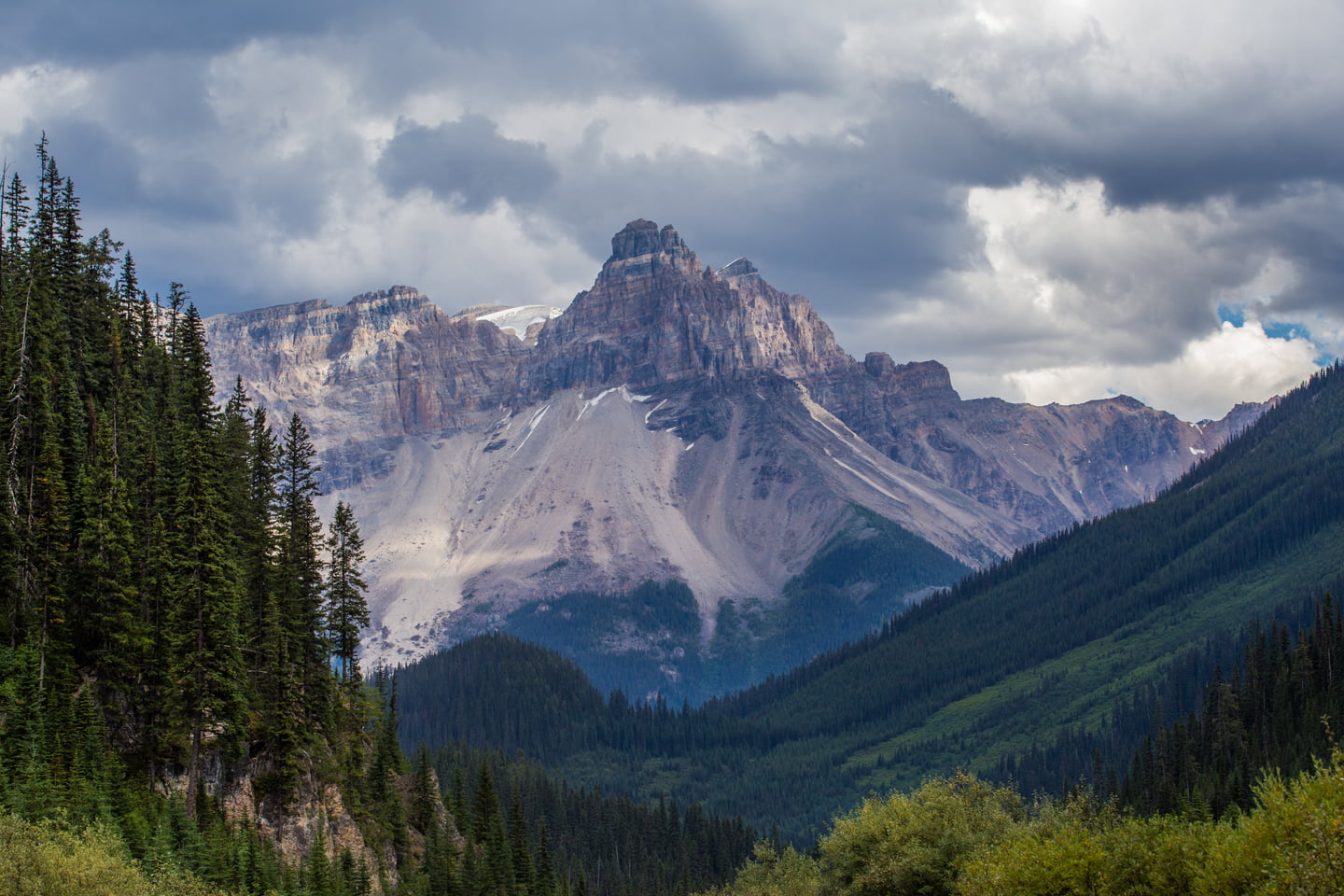
There are a few ways to reach the Canadian Rockies and what route you chose is up to you!
Calgary (YYC) is the closest airport to Banff and where we recommend you fly into for a visit to Banff and beyond. From Calgary Airport, the town of Banff is 1 hour and 30 minutes west and 90 miles (144 kilometers). Once you leave the city, the first half of the drive is flat land, but once you start to see the mountains, you will be treated to some of the famous views.
Edmonton (YEG) is north of Calgary and makes for a longer drive heading west to Banff and Jasper. In our trip planning research, there has been no significant advantage to flying in and out of Edmonton, so we always go to Calgary. The drive from Edmonton Airport is 4 hours and 243 miles (392 kilometers).
Vancouver (YYR) is west of Banff and Jasper on the coast of Canada. If you’re planning to spend an extended amount of time in Canada (2 weeks or more) it could be worthwhile to extend your trip and visit Vancouver and British Columbia. The drive from Vancouver to Banff is 9 hours and 30 minutes and is best broken up over at minimum, two days. At 533 miles (859 kilometers) this is a long drive, but there are points of interest to stop at along the way, if you decide to go this route.
Driving is a big part of experiencing the Canadian Rockies and we are big fans of road trips. You can pick up a rental car at the airport you fly into and be on your way. We recommend checking sites like Kayak or Costco (if you’re a member) to find the best deals on car rentals. Our preferred rental company is National since we like being able to grab a car and go.
If you’re bringing your own car from the U.S., you can find additional information about border crossings here .
RV and Campervans are another popular option if you’re traveling as a family or prefer to sleep on the road. While we haven’t personally utilized this method yet, there are numerous options available and many of the major attractions have parking options for larger vehicles.
For those looking for a more luxurious way to experience the Canadian Rockies, the Rocky Mountainee r train goes from Vancouver to Banff and Jasper. The trains are famous for their glass dome roofs allowing passengers expansive views. We hope to experience this route some day!
Canadian Rockies Entrance Fees

A pass is required for entry into the Canadian National Parks and the fees associated with them are on a daily and per-person basis.
Depending on the length of your visit, it may be advantageous to purchase an annual pass. A pass can be purchased at the entry station to each National Park, information centers, campgrounds, online and is valid for the following parks: Banff, Jasper, Yoho, Kootenay, Waterton, Elk Island, Mount Revelstoke, and Glacier (Canada).
It’s important to note that you need a pass if you are planning to make any stops throughout either of the parks. This includes, but is not limited to, having lunch in Banff, stopping for a roadside photo of Bow Lake, hiking, etc. The only time you are not required to have a pass is if you are driving straight through the parks without stopping (example: driving from Calgary to Edmonton).
Current park fees can be found on the Parks Canada website .
Where to stay in the Canadian Rockies

There are several options to consider when deciding where to stay on your visit to the Canadian Rockies. The two most important in our eyes are location and budget.
Where are you planning to spend most of your time while visiting the parks? How long do you want your drive to be each day you head out? And lastly, how much are you willing to spend for your accommodations?
Based on each of these factors, here are the main locations we recommend staying in:
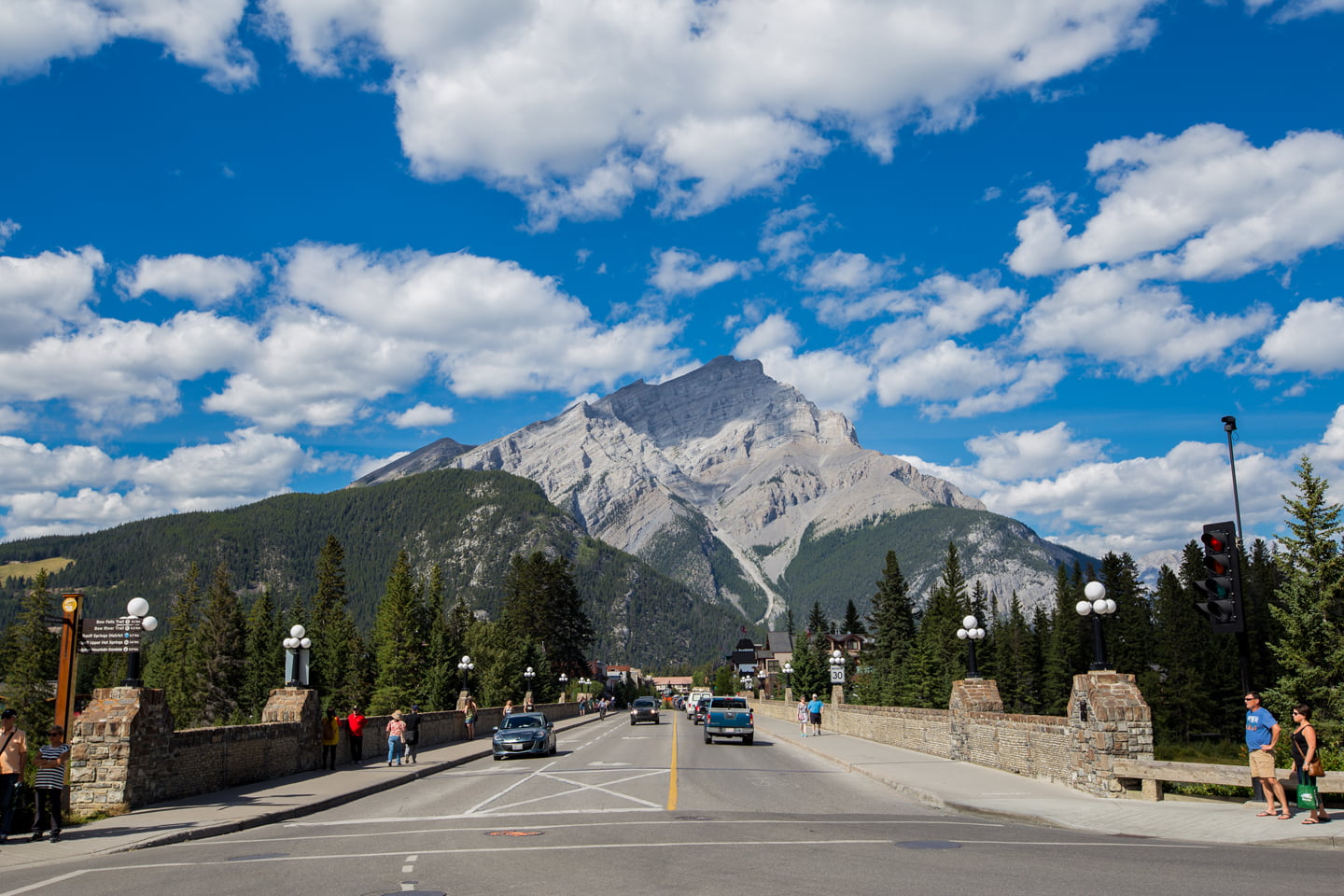
The town of Banff is centrally located and a great place to make your home base for time spent in the National Park. A prime location also comes with a premium price, and staying in Banff proper can be costly, depending on when and where you stay. The peak summer season tends to book up quickly and it’s best to plan on booking accommodations a year out, if you can. Closer deals can be found, but the price goes up as the supply goes down, so be sure to book early!
There are plenty of great dining options in Banff (we recommend Bear Street Tavern ) including grocery stores if you’re packing your own snacks or making meals.
From Calgary, Banff is 1 hour and 30 minutes west and 90 miles (144 kilometers).
For a list of available camping options, check out the National Park’s website .
One of the larger mountain towns, Canmore is located just south of the Banff National Park entrance station and twenty minutes (15 miles/25 kilometers) south of the town of Banff.
The drive to Banff and beyond is an easy one and there are plenty of dining options. Canmore is generally seen as a more cost effective alternative to the town of Banff.
From Calgary, Canmore is 1 hour and 20 minutes west and 75 miles (120 kilometers).
Lake Louise

While not officially a town (it’s a hamlet), the Lake Louise area has a few lodging and dining options. You can stay right at the actual Lake Louise at the Fairmont Chateau or at the Moraine Lake Lodge at Moraine Lake. There are a handful of other lodging options in Lake Louise, as well as select quick dining options and a small grocery store.
The proximity comes with a high premium and staying here will be expensive, but at least the exchange rate is good if you’re coming from the U.S. Hiking options are fantastic if Lake Louise is your starting point and it is arguably a more central location than even Banff.
From Calgary, Lake Louise is 2 hours west and 123 miles (198 kilometers).

The small town of Field is located in British Columbia, but just 25 minutes and 17 miles (28 kilometers) from Lake Louise. Lodging in Field is almost exclusively Guest Houses (think similar to AirBnB) and there are only two dining options.
If you opt to stay here, which we did on one trip, you’ll want to stock up on food in Banff or Lake Louise. Field is a great option for exploring Yoho National Park, and as a quiet alternative to the other busier destinations.
From Calgary, Field is 2 hours and 25 minutes west and 139 miles (224 kilometers).
The town of Jasper is the primary lodging option for visiting Jasper National Park. It’s slightly smaller than the town of Banff and when we visited it was definitely less crowded.
There are a mix of budget options when staying in Jasper and we opted for a lower cost hotel on our stay. Jasper has a good selection of dining options, in particular we enjoyed the Jasper Brewing Company .
From Calgary, Jasper is 5 hours west and 266 miles (429 kilometers).
When to visit the Canadian Rockies

The peak season for visiting the Canadian Rockies is mid to late June through September. You can expect snow to be present in June (and potentially even later, depending on the year), and the possibility of it in September. Remember that the mountains are notorious for creating their own weather, so it’s important to be prepared for anything and to plan accordingly.
June: When we visited in early June, hiking trails were mostly free of snow, but some still lingered at higher elevations. We received light snow at both Moraine and Peyto Lakes, which made these lakes even more magical. If you visit in June, plan to do so later in the month for the best weather chances. Bugs were mostly non-existent, with a couple of exceptions.
July: Our trip in late July was met with a hot first day, which made our accommodations mostly unbearable (and included a blackout!). The remainder of the trip was mostly ideal weather, with the exception a consistent rain when we hiked to Eiffel Lake. In general, July is a good month to visit, but expect crowds to be plentiful. Days are long, so be sure to take full advantage with an early start.
August: The best weather of our three trips occurred in August. We didn’t experience any rain or snow during our week in the Canadian Rockies. Bugs were a non-issue and all hiking trails were in great condition. The main downside to visiting in August were the crowds, which were plentiful everywhere we went. Like July, days are long so an early start is essential and if you are willing to stay out past dinner time, you can enjoy a bit more solitude.
September: While we have yet to visit in September, this is the time you are most likely to see the famous larches turning yellow. Fall color starts earlier in the Canadian Rockies than many other destinations. With kids back in school by this point, you can expect a reduction in the crowds. Much like June, inclement weather is a possibility, so it’s important to be prepared for the possibility of less than ideal conditions.
These are our recommendations for visiting the parks, but it is certainly only that, our opinion. The parks are open year-round and we have heard great things about skiing, dog-sledding, and a variety of other off-peak activities. But to see the famous blue lakes and cascading waterfalls, your best bet is to visit during one of these four months.
Where to go and what to do in Banff National Park
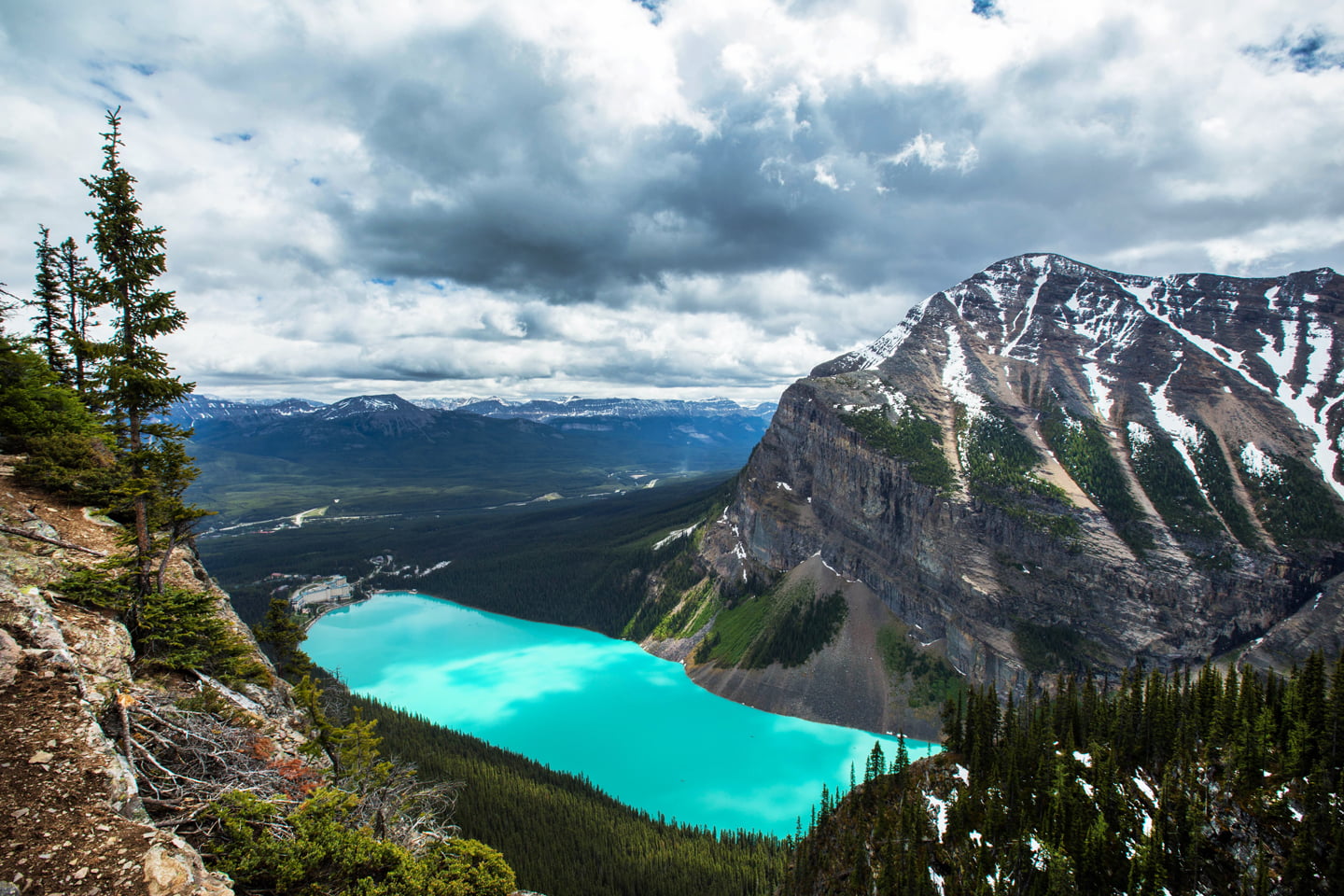
Easily the most well-known of the National Parks in the Canadian Rockies, Banff is synonymous with beautiful lakes and stunning mountains. It’s the second largest National Park in the Canadian Rockies at 2,500 square miles. We have found that for most people, this is where you will want to dedicate most of your time, as we did on our first trip to the region. There are no shortage of lakes you can enjoy while visiting Banff National Park. From roadside lakes, to short to medium distance lakes, below are the ones we recommend visiting.
Moraine Lake

Moraine Lake is easily one of our all-time favorite lakes. It sits at the Valley of Ten Peaks, and is famous for the vista of the mountains diving into deep into it’s blue waters.
Canoeing at Moraine Lake

Moraine Lake Lodge rents canoes during the summer months (mid June — September) for one-hour ($85 USD/$120 CAD)
Moraine Lake Hikes

Consolation Lakes (3.7 miles round-trip, 5.95 kilometers): A mostly flat trip to a rocky shoreline. Some boulder hopping is required to get to the lakeshore but is not required to see the lake.
Eiffel Lake (7.5 miles round-trip, 12 kilometers): A dark blue lake at the end of the Valley of Ten Peaks makes for a nice day-hike from Moraine Lake. All of the climbing is in the first part of the trail before it splits to Eiffel Lake and Sentinel Pass.
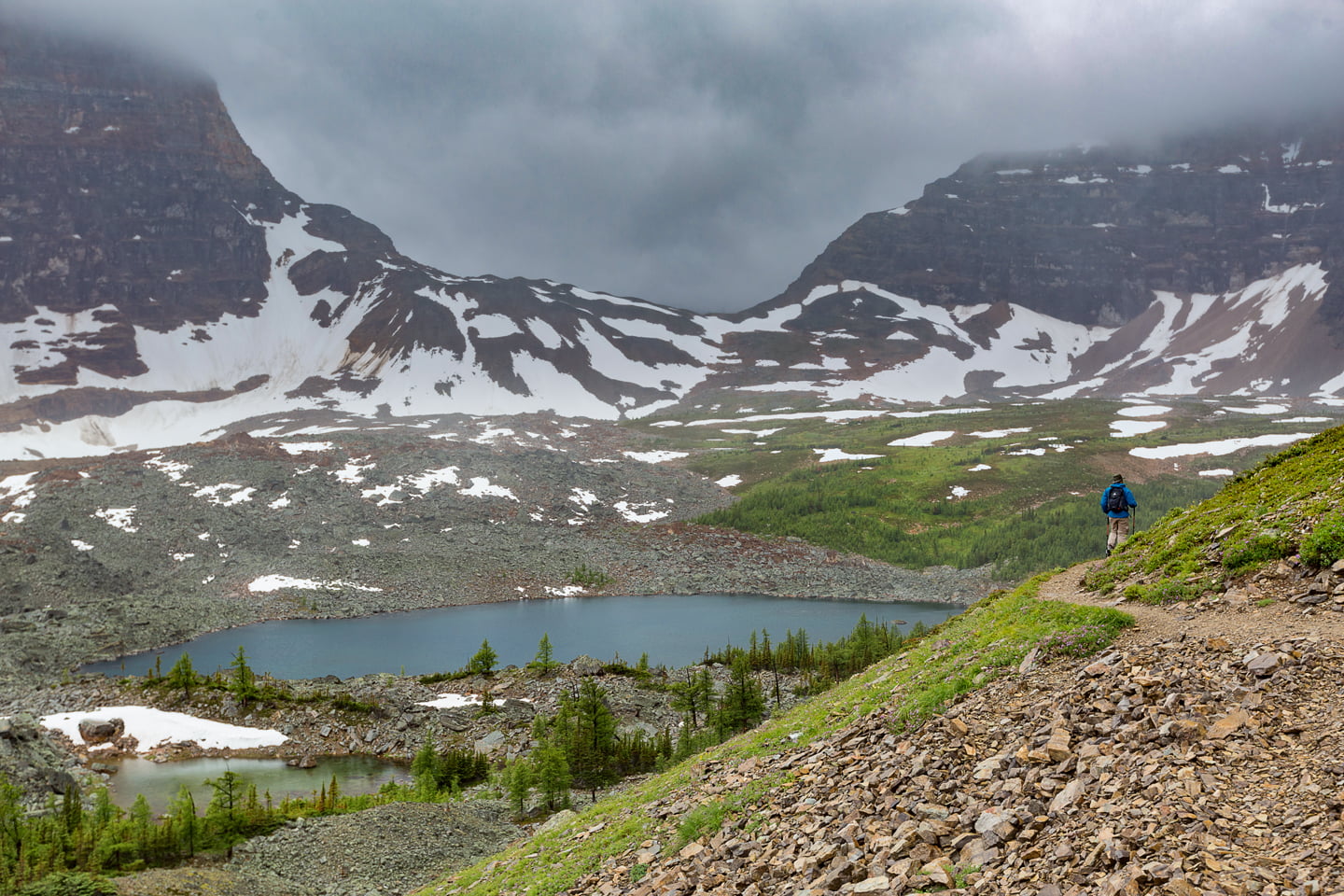
Sentinel Pass (7.2 miles round-trip, 11.5 kilometers): Starts at the same trailhead as Eiffel Lake but then splits off to visit the Larch Valley and Sentinel Pass. Go in September for fall colors!

An immensely popular lake, Lake Louise, with its striking turquoise waters sits at the edge of Mount Victoria and the Victoria Glacier.
Canoeing at Lake Louise

Canoes can be rented from the Fairmont Chateau Lake Louise and Banff Canoe Club during the summer months (mid June — September) for one-hour ($33-47 USD/$45-65 CAD)
Lake Louise Hikes
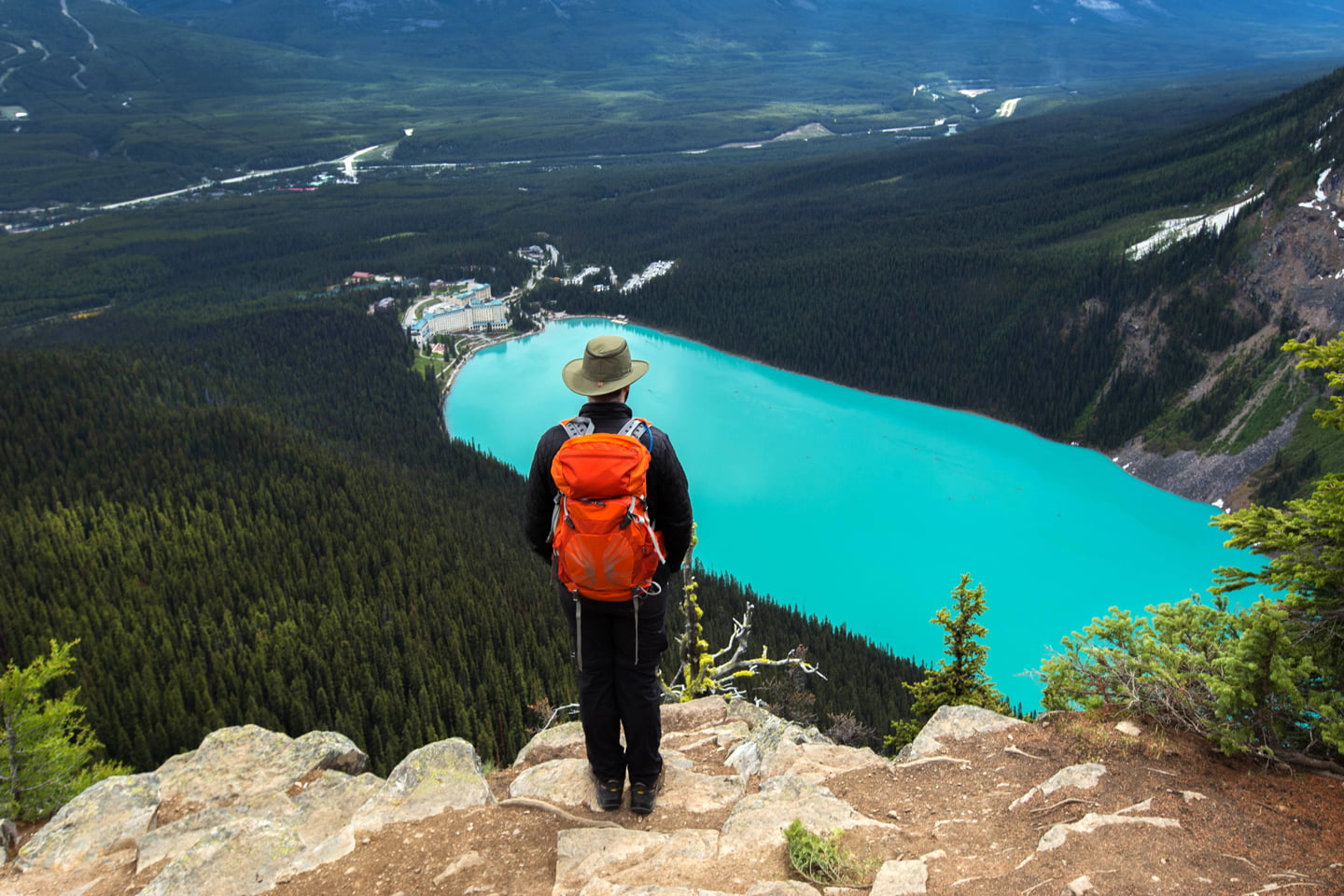
Lake Louise Shoreline (3 miles round-trip, 4.8 kilometers): An easy walk along the lakeshore provides different vantage points of the lake and the historic Fairmont Chateau.
Lake Agnes and the Big Beehive (9.5 miles round-trip, 15 kilometers): Two lakes, a teahouse, and spectacular views from above Lake Louise can be found on this longer day-hike.

Plain of the Six Glaciers (9 miles round-trip, 14.4 kilometers): Incredible glacier views and a tea house to snack and enjoy the fruits of your efforts, this is another must-do hike!

Another famous lake just north of Lake Louise along the Icefields Parkway is Peyto Lake. Check out the view from the overlook and see if you can spot the fox-like shape of Peyto Lake.
Peyto Lake Hikes

Peyto Lake Panorama Overlook (1.7 miles round-trip, 2.7 kilometers): An easy, albeit uphill paved walk to a viewpoint above Peyto Lake. It’s nearly impossible to take a bad photo from here!
Peyto Lakeshore Hike (2 miles round-trip, 3.2 kilometers): For a different perspective of Peyto Lake, follow this easy hike to the shoreline and enjoy the perfect blue water up close.
Johnston Canyon
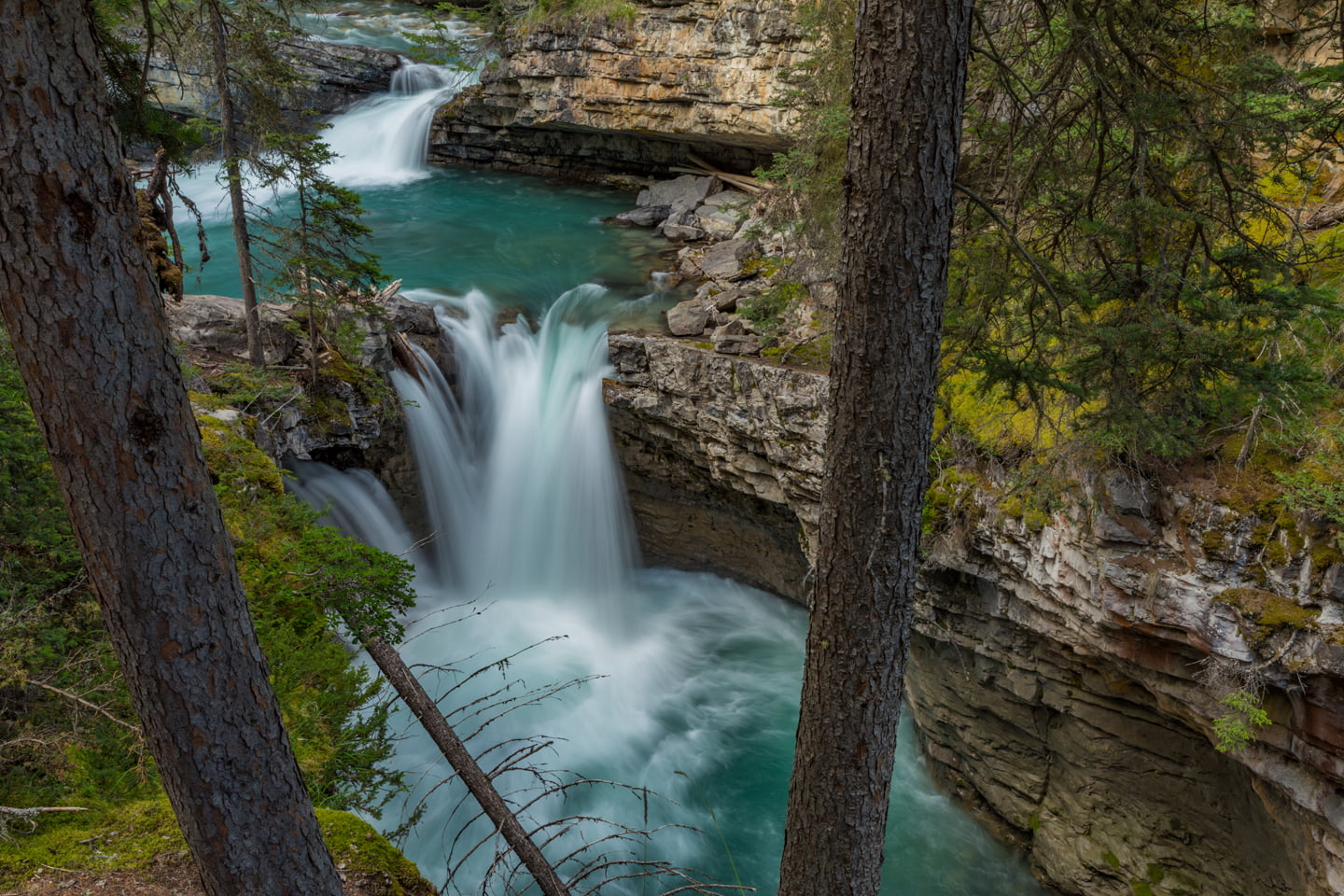
Johnston Canyon is an easily accessible attraction off of the Bow Valley Parkway in Banff. You can read more about the short hike to see the beautiful canyon and its many waterfalls here .
Other Lakes to see in Banff
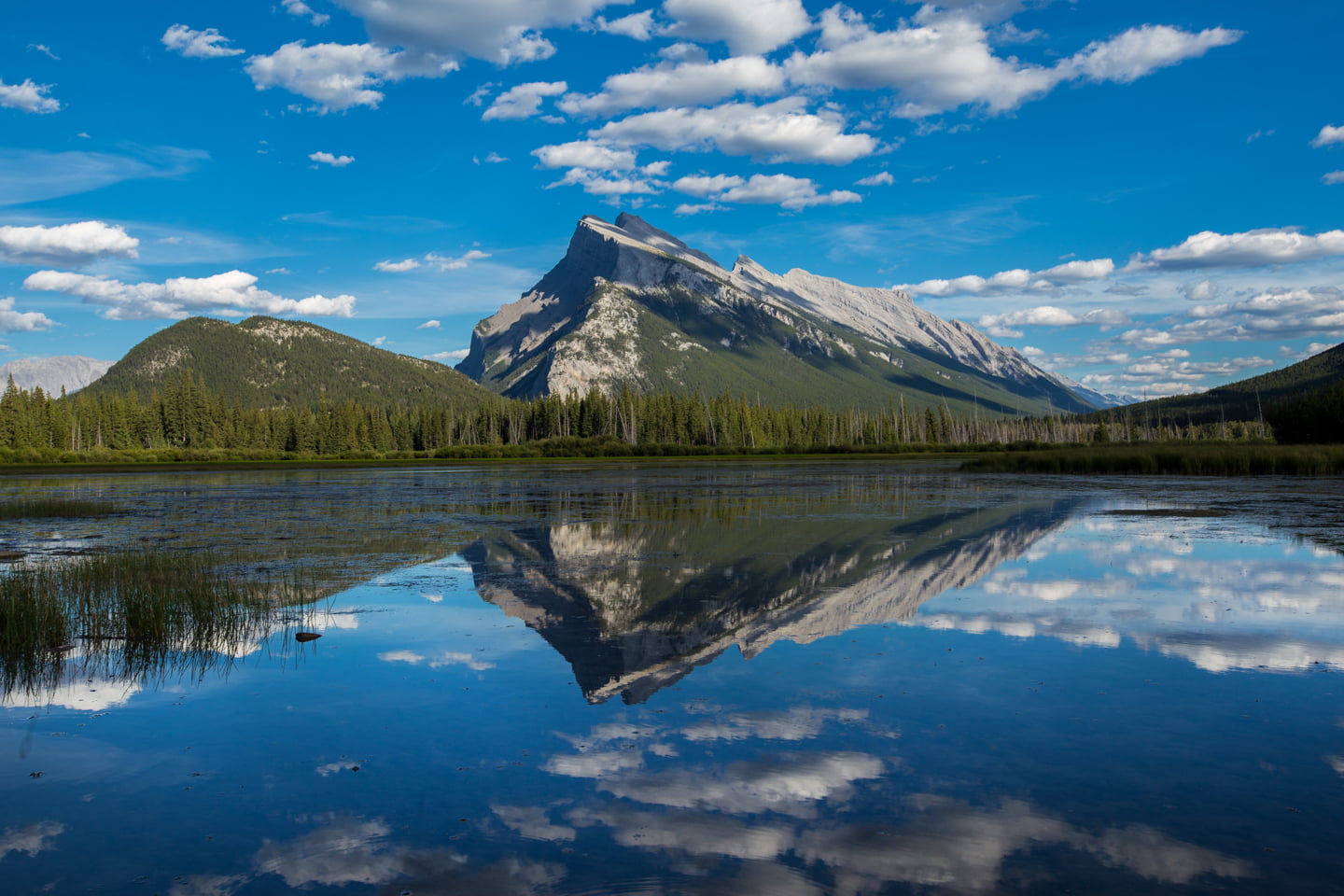
Vermillion Lakes, Two-Jack Lake, Lake Minnewanka, and Bow Lake are all easily accessible, while there are countless additional lakes that can be reached by hiking or backpacking.
Drive the Icefields Parkway

The drive between the towns of Banff and Jasper, along the Icefields Parkway , is arguably one of the most scenic and breathtaking in North America. Along the way, there will be ample time to stop and enjoy lakes, waterfalls, hikes and more! Here are some of our tips for a successful drive:
1. If you’re starting in the town of Banff, the drive to Jasper is 179 miles or 288 kilometers and takes 3.5 hours with no stops.
2. Start early! We recommend setting aside a full day as you will want to make plenty of stops between the two towns. An early start (before 9:00 a.m.) means a greater chance at beating some of the crowds and tour buses.
3. Pack a lunch and snacks as food options will be limited. There are grocery options in both Banff and Lake Louise and you can make yourself up a picnic and have your choice of lunch stops with a view.
4. Be sure to fill up on gas in Banff or Lake Louise as the only other option for it before Jasper is at the Saskatchewan River Crossing and prices will be high there. If you do stop at the River Crossing, this is a great place to stock up on additional snacks or enjoy an ice cream cone with a view.
5. Stop at the Columbia Icefield and take an informative hike on the Athabasca Glacier . This is the perfect way to spend a few hours and a nice opportunity to stretch your legs after being in the car.
6. Enjoy the views! There are so many great places to stop along this drive, we find it best to take your time and go with the flow. Some places will undoubtedly be more crowded than others, but the beauty remains unquestionable.
For more information about the scenic stops on the Icefield’s Parkway, be sure to check our or guide here .
Where to go and what to do in Jasper National Park

Slightly less popular than it’s neighbor Banff, Jasper National Park is a wonder in its own right. It’s the largest National Park in the Canadian Rockies at 4,200 square miles. In the namesake town, we found less crowds and more of a small-town feel. The lakes and waterfalls alone are worth the trip from Banff.
Visit Maligne Lake

While arguably less famous than some of their Banff counterparts, there are some great lakes to visit in Jasper as well. A 45-minute drive from the town of Jasper sits the beautiful Maligne Lake where you can see the famous Spirit Island. To access the island, you can either take a guided tour, or you can rent a canoe and paddle out to the island.
Maligne Lake Boat Tour: There are two boat tour options that reach Spirit Island run by the Banff Jasper Collection. The “Classic” choice is 90 minutes and starts at $51 ($70 Canadian) for adults and $25 for children ($35 Canadian). While the “Premium” option is 120 minutes and starts at $73 for adults ($100 Canadian) and $36 for children. Rates depend on the time of year/season.
Paddle to Spirit Island: If you prefer a more “eco” friendly approach to reaching Spirit Island, you can choose a kayak, canoe, or rowboat and make the 8.5 (14 kilometer) trek yourself. 2020 prices can be found on the Maligne Lake Boathouse website.
Visit Pyramid Lake

Take a scenic walk around the lake, or rent a canoe, kayak, paddle-boat, or electric cruiser to get out on the water. Pyramid Lake also boasts a resort, and additional outdoor opportunities including hiking and mountain biking.
Visit the Waterfalls Along the Icefield’s Parkway
These three waterfalls are easily accessible in Jasper and must-visits during your trip to the park.
Sunwapta Falls
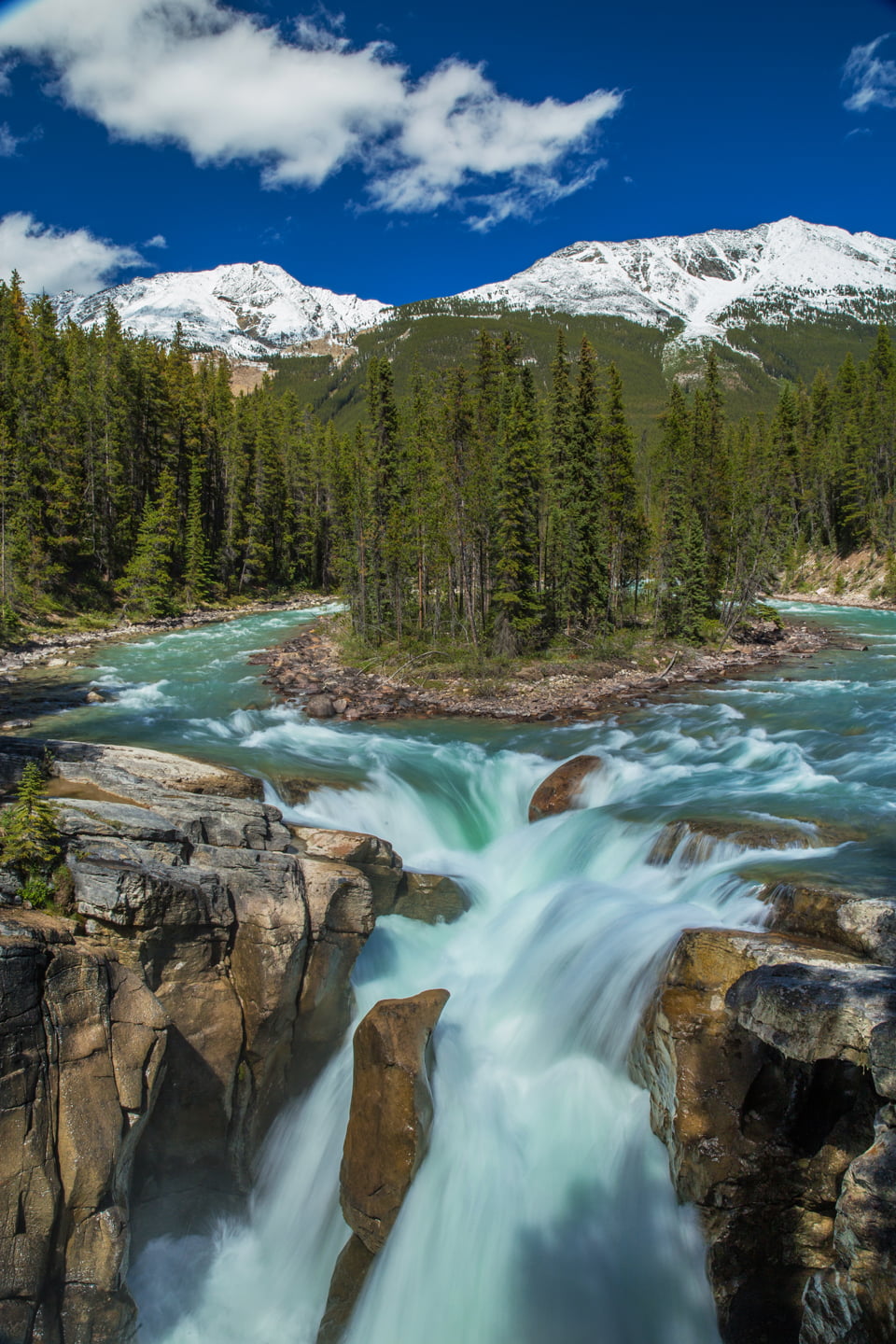
Powerful and framed by an island just behind them, Sunwapta Falls is one of our favorites in the Canadian Rockies. A short walking from the parking lot takes you to a bridge that overlooks the falls.
Athabasca Falls

Similar to Sunwapta in terms of sheer power, Athabasca Falls is easily accessed from a nearby parking lot. You can actually get quite close to the falls, so it’s especially important to stay behind the safety railings.
Tangle Creek Falls

Just 15 minutes from the Columbia Icefields Center, Tangle Creek Falls are located right on the side of the Icefields Parkway. Chances are, there will be cars stopped here, but we drove right past them on our second visit. If the water flow is low, you can walk up the side of the falls a bit to get closer to them.
Explore Athabasca Glacier

Whether you stop briefly to take in the scale of this diminishing glacier, or extend your day by hiking on it, Athabasca Glacier is a sight not to be missed in Jasper National Park. We highly recommend taking the opportunity to take a guided hike on the glacier with Ice Walks, a small tour company. You can read more about our adventure here .
Visit Angel Glacier
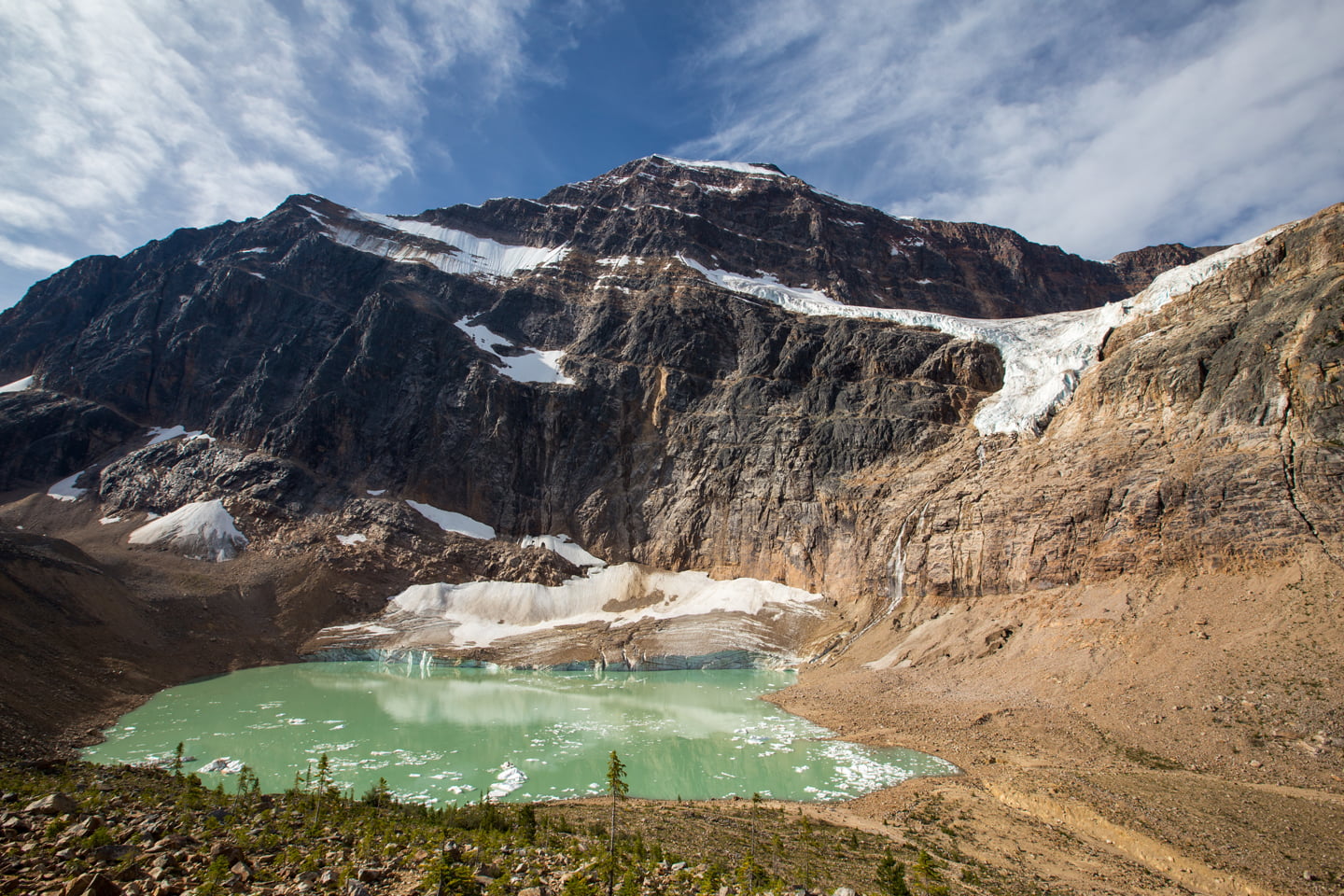
Located 45 minutes outside of Jasper, Mt. Edith Cavell and the Angel Glacier are a great way to spend a few hours.
An easy 1 mile (1.6 kilometer) round-trip hike along the Path of the Glacier trail will bring you to stunning views of Mt. Edith Cavell (named after a British nurse who saved lives on both sides during World War I) and the Angel Glacier.
For a longer hike, the Cavell Meadows Trail is 4 miles round-trip (6 kilometers) and provides further stunning views of the mountain and glacier.
Where to go and What to do in Yoho National Park

If you’re looking for something a bit more off the beaten path with less crowds, Yoho National Park is for you. It’s the smallest National Park in the Canadian Rockies at 507 square miles but is well worth a visit during your trip.
Explore Emerald Lake
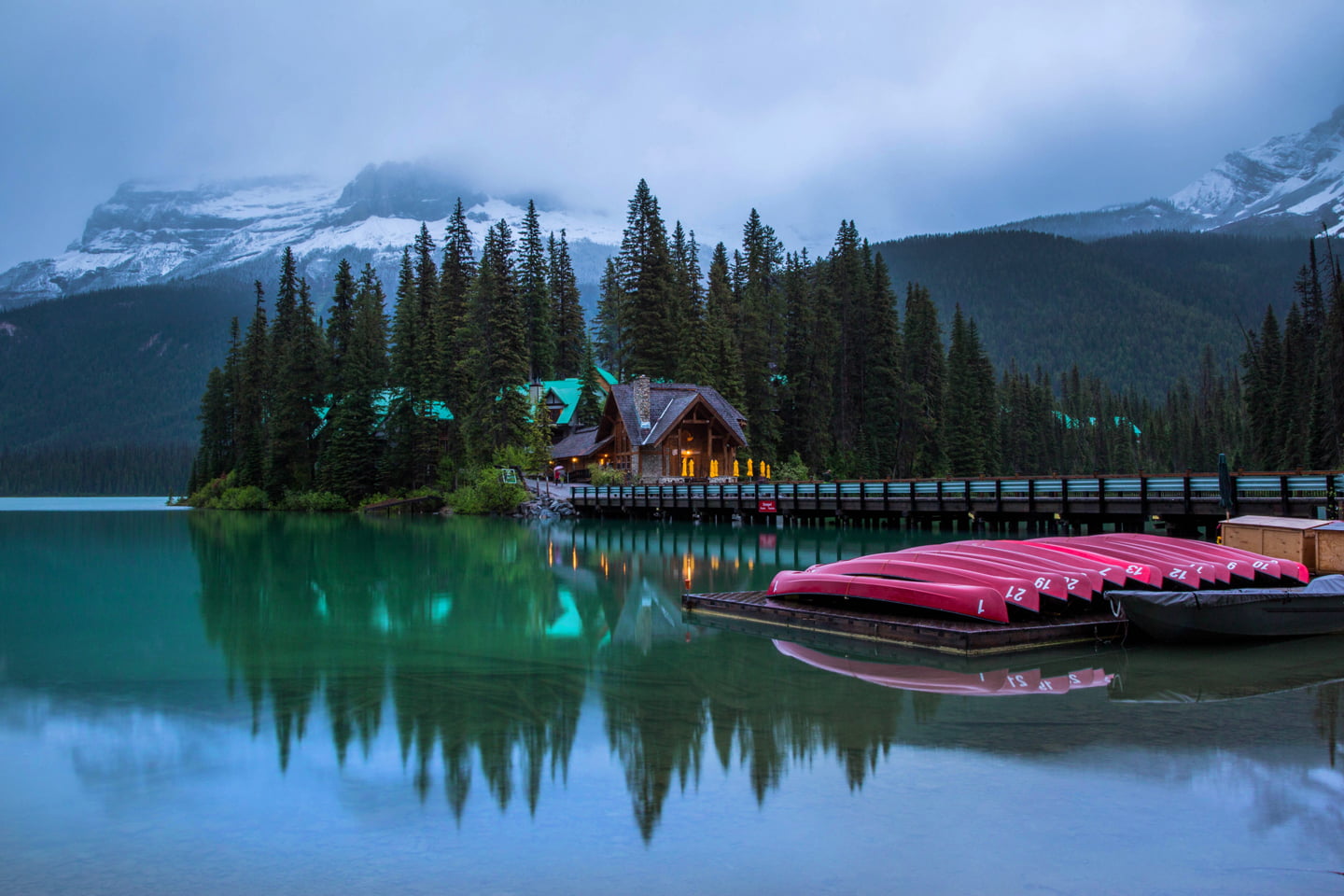
Chances are, you have seen photos of Emerald Lake on social media, and it’s namesake lodge. The views of the lake and the mountains that frame its backdrop are reason alone to visit Emerald Lake.
Emerald Lake Canoeing
As you can with other popular lakes, you can rent a canoe through The Boat House Trading Co. for $36 per hour ($50 Canadian)
Emerald Lake Hikes
Lake Loop Hike : Take a walk around Emerald Lake with an easy 3.2 mile (5.1 kilometers) trek.
Visit Natural Bridge

A stop on the Emerald Lake Lodge Road, this beautiful geologic wonder is not to be missed.
Marvel at Takakkaw Falls

The second tallest waterfall in Canada at 1,224 feet, Takakkaw (“wonderful” in Cree) Falls is a stunning display of the power of water. Located at the end of the Yoho Valley Road, this is one of our all-time favorite waterfalls! Feeling the cool mist spraying off the falls on a warm summer day is an amazing experience.
The falls are a great place to have a picnic lunch with beautiful views and plenty of room to spread out.

For those looking for a bigger adventure, we recommend hiking to Twin Falls (11.5 miles, round-trip) where you will be treated to 4 waterfalls, including the namesake double falls.
Hike to Wapta Falls

35 minutes west of the small town of Field, Wapta Falls is a unique waterfall in the Canadian Rockies. Just 3 miles round-trip makes this hike easily accessible as most of the 450 of elevation gain is on the way up from the falls.
Some of the best views of Wapta Falls are from above, so be sure to stop at the viewpoints along the way.
You can’t get an unobstructed view of the falls from the river thanks to a large mound of dirt and rock that blocks it.
Standing on top of the dirt pile will get you soaking wet (during peak season) as the power of the falls sends up a lot of mist!
Visit Lake O’Hara
If you’re looking for incredible views, alpine lakes and some serious hiking, you will want to book a trip into Lake O’Hara. Unlike some of the other destinations in the Canadian Rockies, this one takes a bit more planning:
To reach the lakes, you will need to either book a bus ticket which runs seasonally during the summer. Alternately, you can hike in the 6.8 miles (11 kilometers) one-way before exploring the area further.
The bus is available only via lottery, so you’ll need to have some flexibility with your trip if you are selected.
Camping is the most cost-effective option for accommodations in the Lake O’Hara region and will also guarantee you a spot on the bus. Parks Canada allows you to stay a maximum of three nights.
Elizabeth Parker Hut is a backcountry hut that offers shared accommodations for up to 24 guests. Rates start at $33 ($45 Canadian) per night, per adult.
Lake O’Hara Lodge is considered the luxury option with rates starting at $555 ($755 Canadian) per night, minimum two night stay. Note: The Lodge is closed for the 2020 season due to Covid-19.
Extending Your Trip in the Canadian Rockies

Kootenay National Park: Located in Southeastern British Columbia, it is the third largest National Park in the Canadian Rockies. Kootenay is a great place for hiking and backpacking trips and you can easily spend several days here doing both.
Mount Assiniboine Provincial Park: This gem is also in Southeastern British Columbia and home to the namesake peak, known as the Matterhorn of the West. Due to the park’s more remote nature (no roads lead to the park), it can be accessed either through a multi-day hike (17 miles, one-way) or via helicopter (runs three days a week).
Vancouver: 527 miles west of Banff National Park, Vancouver is a coastal city in British Columbia and the most populous in the region. If you’re looking for more hiking options we recommend checking out nearby Joffre Lakes and Garibaldi Provincial Parks
Tips for Getting the Most Out of Your Visit
1. Get up early or stay out late! Most parking lots fill up by 8:00 a.m. (earlier for Moraine Lake!), so make sure you get an early start. We have also found that many places are the least crowded in the evening when everyone has gone back into town for dinner.
2. Save money by renting bear spray from one of the stores in town instead of buying a canister. Please don’t use bear bells. They don’t work and they are incredibly annoying to other hikers.
3. Bring a collapsible ice chest . We found that packing a small cooler saved us tons of money and time on meals and drinks. It allowed us to pack lunch in advance so we could eat on the road.
4. Buy your pass in advance so that you don’t have to stop when entering the park.
5. Purchase and know how to read a map if you are planning on hiking. We found The Canadian Rockies Trail Guide and these National Geographic Maps to be very useful resources.
Canadian Rockies Packing List
Clothing: Prepare to experience every kind of weather. During our last trip in July, it was in the 90’s one day, then it snowed the next day! Moisture-wicking material is key, as well as dressing in layers. In the spring, fall, and winter, be sure to bring extra layers to protect against snow and colder weather.
Footwear: Comfy shoes are essential for any trip to the mountains. Julie wears these Keen Durand hiking boots on longer hikes, and the Brooks Cascadia for exploring shorter trails. Wool socks are great for wicking moisture and preventing blisters. We have used and liked both the Darn Tough and Smartwool brands. It is also good to consider bringing a a pair of micro-spikes if you are visiting in months where there may be snow or ice present.
Hiking Backpack: Even if you aren’t planning on doing long hikes, it is a good idea to use a day pack to carry water, snacks, and other essentials. Brian loves this one from Gregory while Julie uses this Osprey pack because it works well for her photography gear.
Hiking Poles help with stability and prevent soreness and injury. We love our Black Diamond Trail Ergo Cork Trekking Poles .
Sun Protection: Make sure you are prepared for the intense mountain sunlight with sunscreen , SPF chapstick , and a hat .
Bug Protection: You will most likely encounter mosquitoes if you are visiting in the spring or summer. We have found picadarin lotion to be somewhat effective for skin, but deet has worked best for us in our ongoing battle against our blood-sucking enemies.
A First-Aid Kit: We use this travel-size kit so that we can put it in our day pack on hikes. We have definitely used it a few times, and were glad to have it handy. Remember to restock your supply after you use something!
Hydration: Bring plenty of water when you set out on a hike. We recently switched to the Platypus bladders and love them. For longer hikes, we often bring along a couple of extra Nalgene bottles filled with water or an electrolyte mix.
Snacks: Some of our favorite high-energy snacks include GU (Salted Caramel is a favorite) and Cliff Shot Blocks (We love Mountain Berry and Ginger Ale).
Be sure to check out our posts: Summer Hiking Gear and Photography Gear for more tips on what to pack for a trip to the Canadian Rockies.
SAVE THIS POST FOR LATER
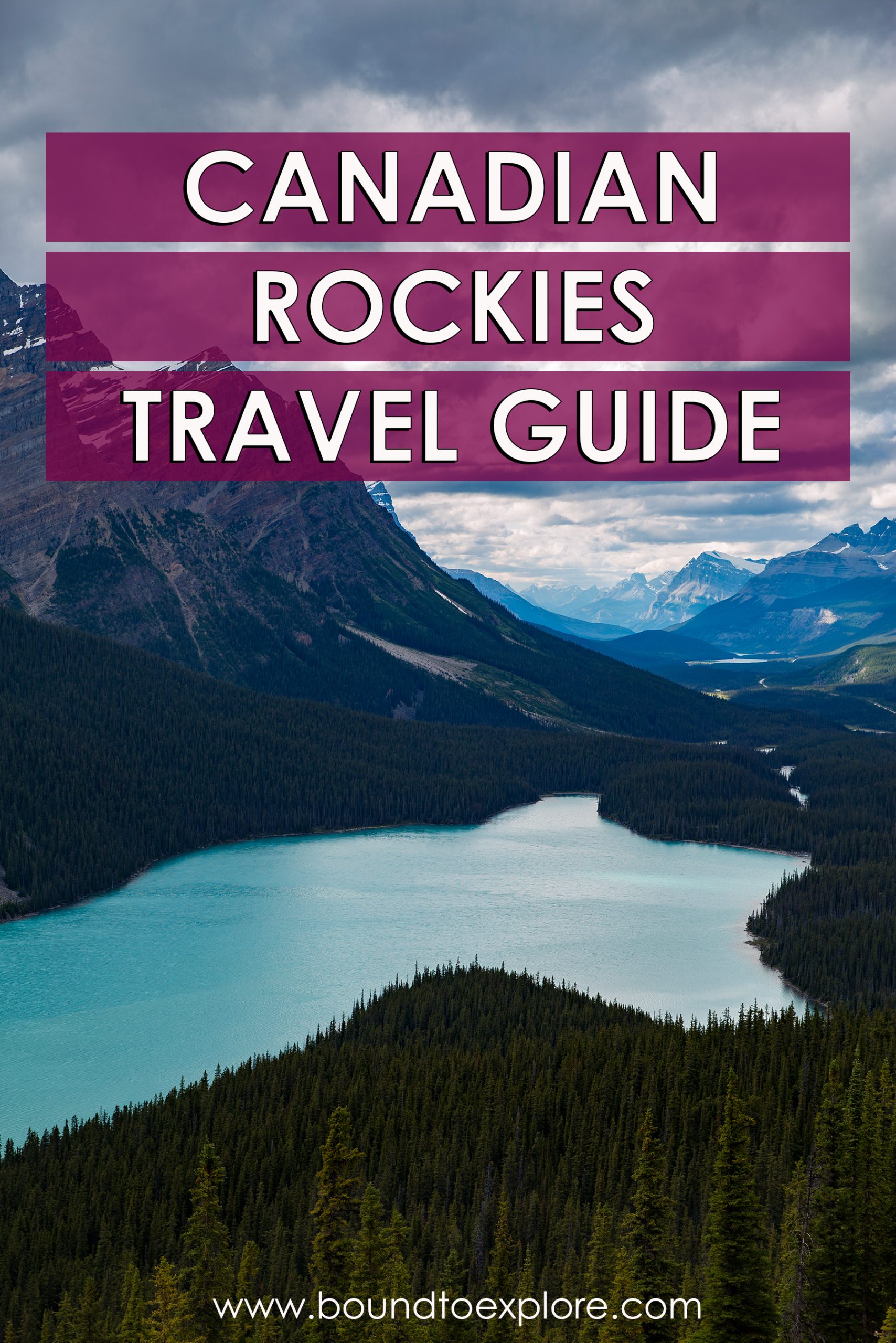
10 thoughts on “Canadian Rockies Travel Guide”
the Canadian Rockies are one of my favour places and icefield Parkway is one of the most beautiful drives in the world. When i was there I stayed at the hotel by the gondola. VERY expensive. Next time I will stay in Canmore.
They are definitely one of our favorite places too! Hotel are expensive, but you pay a premium for the incredible locations. Canmore is a great alternative option to Banff and Lake Louise but still within an easy drive.
Your pictures are breathtaking! I LOVE the mountains, definitely pining this article, so helpful!
Thanks Laurel! We hope you get a chance to visit in the future!
The Canadian Rockies are truly a special place and these images are positively STUNNING! The image of SUNWAPTA FALLS just took my breath away! Your tips and packing lists are especially helpful! Thanks for all the hard work that went into creating this awesome travel guide!
Thanks so much for the kind words, Michelle! We think that the Canadian Rockies are pretty special too!
The Canadian Rockies are still on my bucket list, and this is a fantastic guide. Very thorough and full of useful information. Banff gets all the credit, but I’m looking forward to checking out some of your less crowded suggestions!
Thanks Rachel! We hope you get to visit the Canadian Rockies in the near future!
This looks so incredible. I have visited the Rocky Mountains in the United States several times and have loved it every time. Now I guess I need to add the Canadian Rockies to my list 🙂
Thanks Michelle! We highly recommend a trip to the Canadian Rockies and hope you have the opportunity to visit!
- Privacy Policy
Forbes Travel Guide Stories
8 Bucket List Experiences In The Canadian Rockies By Correspondent Carolyn B. Heller
December 3, 2015
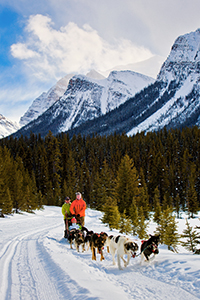
In any season, the Canadian Rockies are a spectacular vacation destination, with a seemingly limitless range of one-of-a-kind travel experiences. We’ve highlighted eight great Rocky Mountain adventures with tips on how and where to try these bucket-list-worthy activities.
For all these Canadian Rockies experiences, fly into Calgary , then head for the mountains in Banff , Jasper or eastern British Columbia. Or combine a Rockies tour with time on the coast in Vancouver . Either way, prepare for an epic Canadian holiday.
Walk on a Glacier A drive along the strikingly beautiful Icefields Parkway between Lake Louise and Jasper is a bucket-list adventure in itself, with ice-capped mountains and bluer-than-blue, glacier-fed lakes around every turn. Add to the experience with a walk on the Athabasca Glacier, which is part of the Columbia Icefield, the largest area of glacial ice in the Canadian Rockies. A specially equipped bus with massive tires takes you down a steep and rocky slope onto the dense ice, where you can explore, even in mid-summer.
How to do it: Brewster Travel offers Glacier Adventure tours from the Columbia Icefield Centre along the Icefields Parkway, as well as day tours that include transportation from Calgary, Banff, Lake Louise or Jasper.
Dog Sled Across the Continental Divide In just a couple of hours, you can travel by dog sled through two of the Canadian Rockies’ mountain national parks, journeying from Banff to Yoho through the Continental Divide. Your guide will lead the dog team while you take in the views (there will be time to stop for photos along the way, too) and, on your return trip, you’ll have a chance to guide the dog team yourself.
How to do it: Based at Lake Louise in Banff National Park, Kingmik Dog Sled Tours offers several sledding trips. Before or after your tour, luxuriate overlooking the water at Fairmont Chateau Lake Louise .
Climb a Via Ferrata If you’ve never tried rock climbing, cross this adventure off your wish list with a guided ascent on the Via Ferrata in Banff National Park. From the Italian for “iron way,” a Via Ferrata is a system of iron rungs and fixed cables high on a mountain rock face, designed to enable novice climbers to reach new heights. Banff’s Mount Norquay has three guided Via Ferrata routes, from a 2.5-hour introductory climb to a six-hour route that takes you up to dramatic views along the mountain’s 8,038-foot-high East Summit.
How to do it: Reserve a spot on a Via Ferrata tour at Banff’s Mount Norquay. Your guide will outfit you with the gear you need and give you an orientation before leading you up the mountain.
Take Yoga to New Heights Imagine taking your downward dog to the top of a peak in the Canadian Rockies — by helicopter. On a heli-yoga tour, you’ll start by flying over the waterfalls and glaciers along the Icefields Parkway. Then follow your hiking guide along a backcountry trail to a secluded mountaintop location for a private yoga class. When you’ve achieved your mountain zen, the helicopter returns for a scenic flight back to civilization.
How to do it: Book a heli-yoga tour with Rockies Heli Canada , which runs Icefields Heli-Yoga tours from May through mid-October.
Ice Walk Through a Frozen Canyon Both Banff and Jasper national parks have spectacular rock canyons carved by rushing rivers. In the summer, you can hike along the catwalks through Banff’s Johnston Canyon or follow the riverside trail through Jasper’s dramatic Maligne Canyon, but these scenic spots are even more impressive in winter when the rivers and waterfalls freeze into walls of sculptural ice. You’ll strap on ice cleats to keep your footing as you hike into the frozen gorges on this distinctively Canadian adventure.
How to do it: In Banff, ice walk through Johnston Canyon with Discover Banff Tours . In Jasper, Maligne Adventures and Sun Dog Tours lead ice walks through Maligne Canyon.
Go Cat Skiing Any skier or snowboarder can ride a lift up the mountain, but when your goal is to reach deep powder on untracked slopes, book a cat skiing tour. Surrounded by the Rockies, with an average annual snowfall of 35 to 40 feet, the southeastern British Columbia town of Fernie is a center for cat skiing, where you ride up the surrounding mountains in a heated snowcat, a machine that looks like a cross between a bulldozer and a limousine. Your guide will point you down the best backcountry terrain, and you dive into the powder.
How to do it: Fernie’s Island Lake Catskiing runs cat skiing tours from its deluxe wilderness lodge. Fernie Wilderness Adventures offers one-day and multi-day cat-skiing trips.
Motorcycle Into the Mountains Have you always wanted to ride a motorcycle? In Jasper National Park, you can arrange a guided tour on three wheels (can’t forget the sidecar), riding south to scenic Athabasca Falls, touring park highlights like Maligne Canyon and Medicine Lake, or winding up Mount Edith Cavell near the base of the Angel Glacier. You can even do a full-day tour along the Icefields Parkway. You’ll be outfitted in leather, and ride either on the bike behind your guide or in a sidecar attached to your guide’s motorcycle. Cool, right?
How to do it: Book a stay at Fairmont Jasper Park Lodge on Lac Beauvert, then schedule a guided ride with Jasper Motorcycle Tours .
Soak in Historic Hot Springs After all these adventures, you’ll want to relax your muscles, and what better place to unwind than at “The Castle in the Rockies,” the stately Forbes Travel Guide Four-Star Fairmont Banff Springs Hotel, which has been pampering guests in its grand chateau for more than 125 years. The hotel’s Four-Star Willow Stream Spa has an expansive indoor mineral pool, surrounded by three hot pools, each with a cascading waterfall. It also has a full menu of massage and other treatments — just the thing to wrap up your Canadian bucket list experiences in style.

Dreaming of your next trip?
I agree to the Forbes Travel Guide Privacy Policy and Terms . I understand I can withdraw my consent at any time.
Sign up for our newsletter

The Best Canadian Rockies Itinerary For First-Time Visitors
By: Author Lotte
Posted on Last updated: July 24, 2024
Categories Canada

Listed by UNESCO as a World Heritage site, the Canadian Rockies Mountains are home to some of the most beautiful and breathtaking landscapes in the world.
From snow-covered peaks to lush green forests and vivid blue lakes, the Canadian Rockies provide a stunning backdrop to explore and admire.
The Rockies Mountains are home to a variety of wildlife, including elk, bighorn sheep, mountain goats, moose, grizzlies, black bears, and more.
With its abundance of incredible nature and wildlife, the Canadian Rockies are an ideal destination for hikers, campers, skiers, and other outdoor enthusiasts.
To make sure you don’t miss out on any of its epic grandeur, I have compiled the ultimate Canadian Rockies itinerary. Let’s get started!
Canadian Rockies itinerary
Disclosure: Some links in this post are affiliate links. If you make a purchase through one of these links, we may earn a small commission (at no extra cost to you!). We're very grateful when you use our links to make a purchase:-).
This post was written by Kyle Kroeger, a travel blogger for his site ViaTravelers.com . Via Travelers is a modern travel blog providing the best tips, hacks, and itineraries to ensure you have an amazing adventure.
Be sure to give him a follow on Instagram to get the latest travel updates.
The ultimate guide to the Canadian Rockies
When to visit the canadian rockies mountain range.
While the Canadian Rockies are mesmerizingly beautiful year-round, the best time to visit is during the late spring .
Roughly between May and June, the weather is moderate, the hiking trails are open, and you’ll have time to travel around before the summer crowd arrives.
Please note that if you want to travel to the Canadian Rockies during summer (July and August), you’ll have to conduct some planning and reservations in advance.
Canadian Rockies chalets and other accommodations, car rentals , and tours get booked up quickly so make sure to plan ahead.
Fall is a wonderful time to admire the brightly colored trees. The Canadian Rockies weather in September can be very pleasant and because the summer crowds have left, you'll have the trails mostly to yourself.

If you want to experience the Canadian Rockies covered in a white blanket, visiting Canada during winter is also a great idea.
Start your trip in Calgary before you travel to Banff to enjoy winter sports like skiing and get the scenic locations to yourself.
Additionally, you can get great deals on Canadian Rockies hotels, transportation, and tour bookings when visiting the Canadian Rockies in winter.
Interested in doing a working holiday in Canada ? Check out the Global Work & Travel Canada package and get a €100 discount with the coupon code PHENOMENALGLOBE.

Getting around the Canadian Rockies
The best way to get around in the Canadian Rockies is to rent a car and drive it yourself.
Getting a rental car is relatively easy and accessible in Canada, so you’ll have a hassle-free experience getting the right vehicle for your family.
Moreover, you can take add in as many stops as you like and adjust your itinerary for the Canadian Rockies as you go, depending on your experiences.
Please take my word for it, a Canadian Rockies road trip will be an unforgettable experience. You could also rent a campervan , thereby arranging transportation and accommodation all at once.
Note that you'll need to stay at the official Canadian Rockies campgrounds in Banff and Jasper National Park. Wild camping is not allowed (and rightly so) to preserve the magnificent nature of the Canadian Rockies.
While I highly recommend traveling around by car, you can use public transport if you prefer. I'll be honest though: it makes getting to most sites more complex.
You can use the connecting buses between Lake Louise and Jasper. Once you get there, you’ll have to figure out how to get to the nearby attractions.
There are shuttle buses ( or this Hop-On and Hop-Off bus ) that take you to must-visit tourist spots, but you will only get limited time to spend at every location.
Also, most of these buses run only during summertime, so make sure to make the necessary inquiries before planning your trip.
Where to stay in the Canadian Rockies
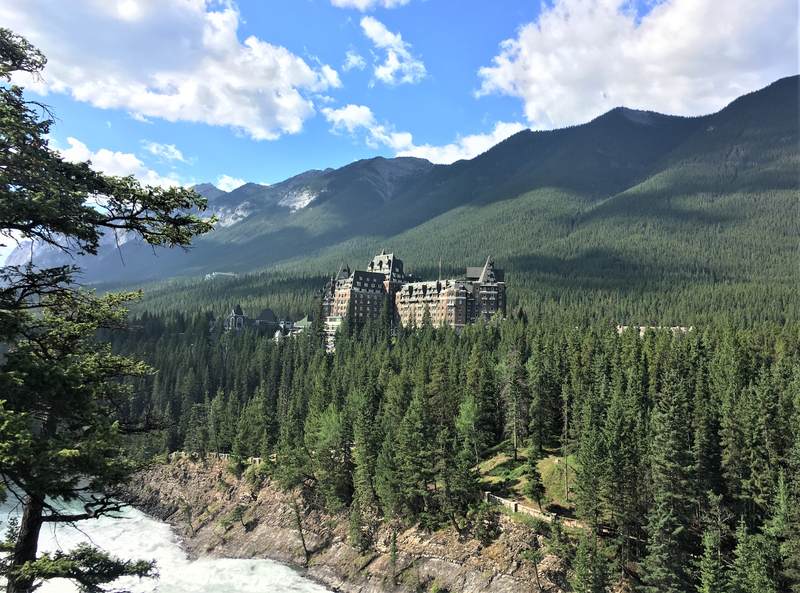
Another essential aspect to consider while planning a Canadian Rockies holiday is to find suitable accommodation at every location.
Accommodation options range from luxury hotels to modest B&Bs, budget hostels, and well-maintained camping grounds.
No matter which option you go for, you should plan your bookings based on your time of travel. For example, you will find it (very) challenging to get your preferred lodgings upon arrival if you’re traveling between July and September.
For those months I strongly recommend booking ahead. Here are some recommendations for every budget.
Best places to stay in the Canadian Rockies
Note: Prices for these hotels depend on the time of year and how far in advance you book. Use ‘click here' to see the latest prices Booking and book ahead to get the best deal.
Campgrounds in the Canadian Rockies
If you're looking for some Canadian Rockies camping options, Parks Canada runs about a dozen campsites in Banff National Park. Some are open year-round, while others are only open during the summer.
You can reserve campsites online , which is a must during peak season (July and August).
There are RV campsites, serviced campsites with electricity and bathrooms, as well as backcountry campsites where you can get off the grid.
Camping is a suitable activity for families as well as adventurous travelers, as you can choose a campground that meets your needs.
There are plenty of beautiful campgrounds found around Jasper as well, you can find more information here .
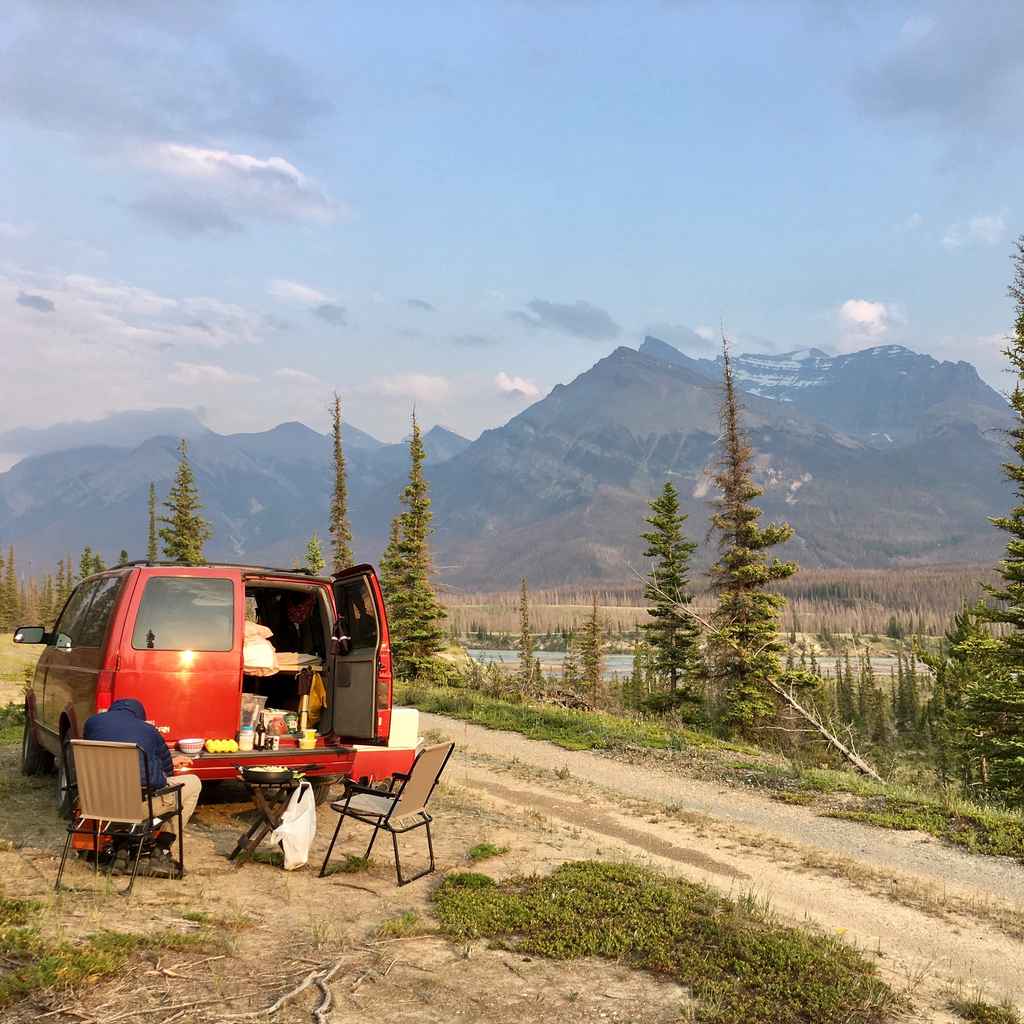
Canadian Rockies trip: things to know before you go
Here are some things you should consider while planning your trip.
- Be prepared for unpredictable weather conditions. Even if you’re traveling during summer, make sure to carry some warm and waterproof clothes as well as a reliable travel backpack so you can store hiking or camping accessories without being completely bogged down.
- Apart from accommodation bookings, you will also have to pre-book tickets to National Parks and other attractions. However, you can get an affordable Annual Discovery Pass to avoid paying individually at every location.
- Check your passport and visa validity to avoid any inconvenience at Calgary international airport. There are different requirements for every nationality, so always double-check which requirements apply to you.
- Get proper travel insurance! Accidents and delays are expected at natural destinations, so make sure you’re prepared for any unpleasant occurrence.

Canadian Rockies 7 day itinerary
Now that you know everything about planning a trip to the Canadian Rockies, it is time for my ultimate Canadian Rockies Itinerary.
Read along to find out how to spend a momentous week in a breathtaking location.
The Canadian Rockies map
I've created a map with all the spots included in this post so you can easily plan your trip.

Click here for the interactive map
Top 5 Canadian Rockies tours and activities
- Banff Gondola : Maximize your views of Banff National Park with minimal exertion during this round-trip gondola ride to the top of Sulphur Mountain. Click here to book.
- Glacier Skywalk : feel the adrenaline rush of stepping out onto the glass-bottomed, 1,312-foot long (400-meter) walkway, perched 1,000 feet (304 meters) above the floor of the Sunwapta Valley, offering unobstructed vistas of the snow-capped mountains and valleys beyond. Click here to book .
- Discover Grizzly Bears : head out for a gondola ride up to 7,700 feet for a mountain-top lunch at Canada’s highest restaurant, and then take a chairlift ride up to the world’s largest enclosed and protected grizzly bear habitat to see Boo the resident bear rescued as a cub. This 10-hour excursion through Banff and Yoho National Parks is perfect for the animal- and nature lovers. Click here to book.
- Banff Historical Walking Tour : this fun historical walking tour brings you to local landmarks and trails around Banff. Enjoy wonderful stories about the area's famous legends and natural history. Click here to book.
- Athabasca River Raft Trip : this small group float trip takes you down several miles on the Class II rapids. That means you can expect a few splashes along the way, but nothing too scary so it's the perfect introduction to Canadian Rockies rafting. Click here to book.

Day 1: Calgary To Banff
Considering you land in Calgary ( which is a great destination in itself ) from your home destination, the best way to start is by driving to Banff.
The scenic drive takes around 2 hours, so it's best to start in the early morning. Before checking into your accommodation in Banff , there is a whole day of sightseeing ahead!
Johnston Canyon

Taking a soul-cleansing walk ( click here for more detailed information about this trail) across the blue river through the majestic canyon walls is a great way to start your Rockies vacation.
The trail is well-paved, so you can take your kids along and fascinate them with the gorgeous waterfall at the end.
Similarly, if you’re a hiking enthusiast, you can continue hiking all the way to the green and blue waterholes to enjoy the scenic Canadian Rockies landscapes and expansive views of the surrounding mountains.
Known as ‘The Ink Pots,’ these waterholes make up one of the most mesmerizing Canadian Rockies hiking spots.
Sulphur Mountain Gondola
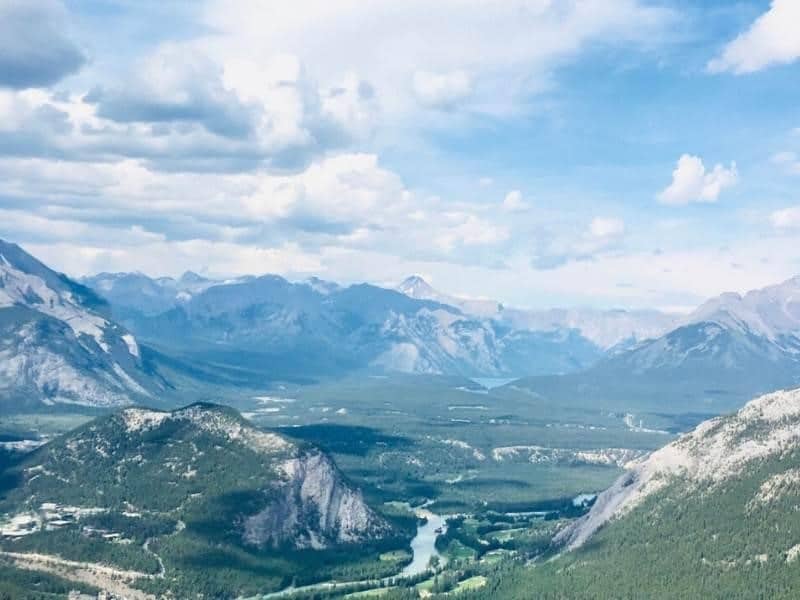
Another beautiful place to visit is the Sulphur Mountain Gondola. Here, you can hop on a gondola to take you up to the top of Sulphur Mountain to enjoy the majestic views from above. Click here to buy your Banff Gondola tickets .
The best time to head over to Sulphur Mountain is later in the afternoon. This way, you can also enjoy dinner at one of the restaurants atop the mountain and eat alongside the exquisite views.
Day 2: Visit The Majestic Lakes
On the next day, you can drive from Banff to some of the most spectacular lakes in the region. The must-visit locations you can cover within the day include.
Moraine Lake
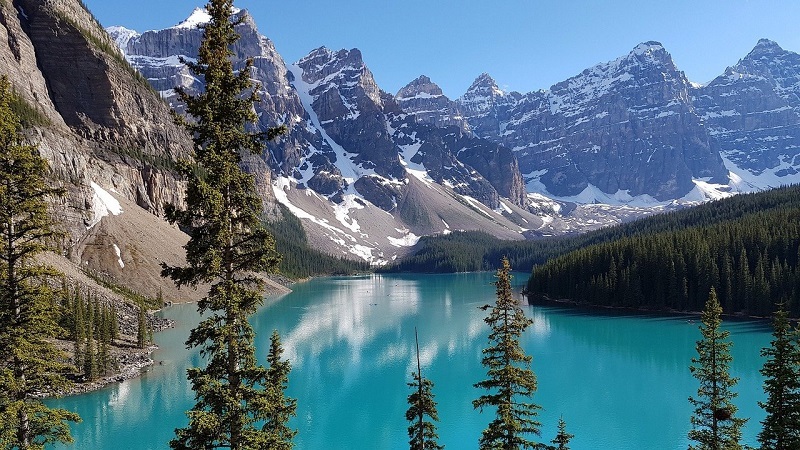
Only an hour’s drive from Banff, Moraine Lake is beautiful enough to sweep you off your feet.
The tranquil waters surrounded by the snow-capped Ten Peak mountains allow you to experience nature at its best. While there are many beautiful lakes in Canada , Lake Moraine might be the prettiest one…
For the best experience, make sure to arrive before sunrise at around 5:30 am. Then you can head over to Lake Agnes.
A short drive (about 20 minutes) from Lake Moraine lies Lake Agnes. Along with the breathtaking view, you can enjoy breakfast at the historic teahouse in the vicinity.
Built back in 1905, the teahouse still operates without electricity and is famous for its tea and scones.
Lake Louise

Lake Louise is easily the most famous lake in Banff. Its milky blue waters are surrounded by great glaciers that make for Instagram-worthy vacation photographs.
Here, you can indulge in multiple activities like canoeing, fishing, and even swimming. Later, you can end your day by having lunch at the F airmont Chateau Lake Louise with its amazing views and delicious cuisine.
Day 3: Experience The Icefields Parkway

If your family loves road trips, you’re in for a treat when visiting the Icefields Parkway. It is one of the most beautiful roads globally with mountains on both sides and plenty of spots to stop for fun.
You can also spot Canadian Rockies wildlife while driving through the parkway so remember to keep your eyes and cameras out. Read about some of the best stops along the Icefields Parkway below.

Although you’ve already visited your share of turquoise lakes the previous day, this place is a must-visit.
The vividly-colored waters are a feast for the eyes, though you’ll have to take a steep but short walk to reach the ideal viewpoint.
Later, you can cruise through the nearby glaciers using an ice explorer vehicle and experience the thrill of your lifetime.
Athabasca Glacier
The Athabasca Glacier is a magnificent location near Peyto Lake, where you can walk across ice without any special equipment.
However, it is still a good idea to take Yaktrax or similar traction devices to stay safe. As you walk, you can enjoy the breathtaking scenery around you and take memorable photos with your family.
Day 4 and 5: Spend some time hiking
On your fourth day, you can take a bus or drive yourself from the Icefield to Jasper. After reaching the famous town within an hour, you can visit the attractions nearby and enjoy some natural escapades.
Tackle the Sulphur Skyline trail
This trail is around 9 km long if you count the return trip and involves some uphill climbing. The hike is suitable for people with a moderate fitness level and you'll need sturdy footwear .
While going up, you might find the trail quite tedious. But, the fantastic views of the forest and the occasional mountain views make the trip worth it.
And when you reach the summit, you’ll be glad you made the effort as the views are spectacular.

Miette Hot Springs
After the exhausting hike, you’re probably done with exploration for the day. Luckily, the Sulphur Skyline Trail has the Miette Hot Springs, where you can relax your tired muscles.
After enjoying the springs, you’d probably call it a day.
Beaver Boardwalk in Hinton
You can camp in the nearby campgrounds for the night and set out for the one-hour drive to Beaver Boardwalk the next day. Here, you can watch beavers in their natural habitat and enjoy feeding them and taking photographs.
Remember, the best time to watch beavers is late in the afternoon. So, spend some time in nearby coffee shops and restaurants in Hinton before heading off for the adventure.
Day 6 and 7: Explore Jasper and Banff
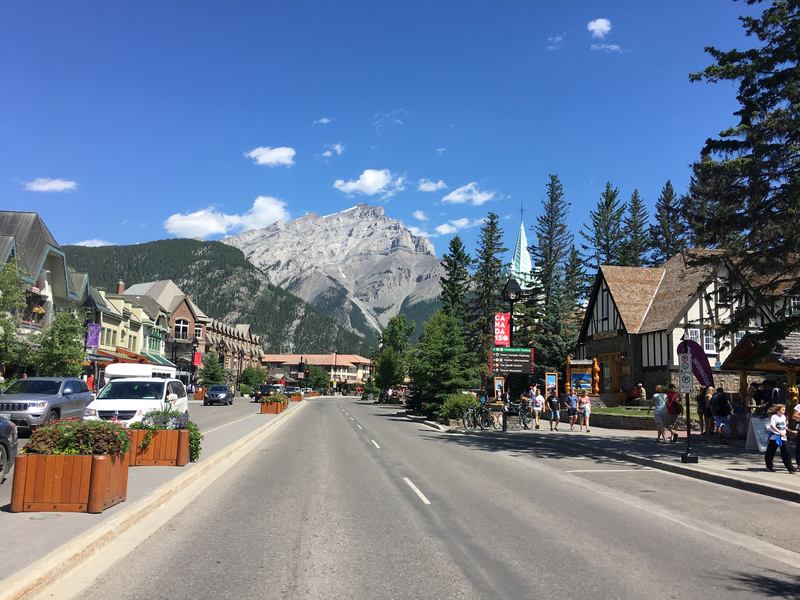
For the next two days of the week, you can enjoy tourist locations in and around the most popular Canadian Rockies towns.
If your family loves wildlife, the best option is to head over to Moose Lake. Located at a 45-minute drive from Jasper, Moose Lake lets you experience moose in the wild set against beautiful natural views.
You’ll have to take a 3km hiking track and spot the moose along the way.
Bald Hills Track
After that, you can head over to the Bald Hills Track for a scenic hike. The trail is surrounded by snow-capped mountains and provides a magnificent view of Maligne Lake from above.
Although the hike is challenging, the views and activities at the summit are worth the climb.
Maligne Lake

If you’re looking for adventurous activities and relaxing views, Maligne Lake is the ideal spot to head over next. You can hire kayaks and canoes for low prices and enjoy your day cruising the waters.
Jasper National Park
The next day, you can visit the Maligne Canyon at Jasper National Park. Watching the stream of water surge through the narrow waters is nothing short of a fairy tale scene.
The park has multiple viewpoints where you can stop for photographs and refreshments. The best part is, you can walk as much as you like and withdraw from the trail when you’re done for the day.
Also check out my post about the best hotels in Jasper to find the perfect accommodation for your trip.
Mount Edith Cavell
This spectacular mountain requires a 14-kilometer drive along Cavell Road, a twisting and turning road with equally spectacular views.
From the parking lot, the short Path of the Glacier trail leads to the north face of Mt. Edith Cavell and offers beautiful views of the mountain, Cavell Pond, Cavell Glacier, and the Angel Glacier.
Athabasca Falls
These powerful waterfalls are one of the most famous falls in Jasper National Park.
Not because of their height, but because of the huge amount of water pressed through the gorge, creating potholes as the softer limestone rock slowly gives away under the pressure of the thundering water.
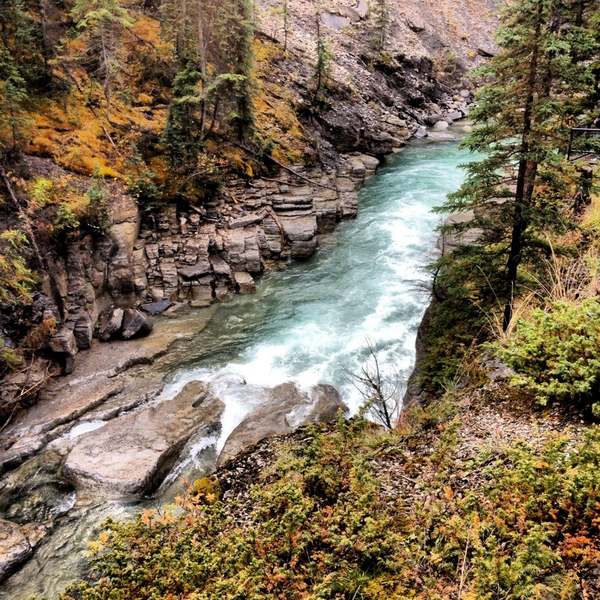
The Iceline Trail
Next, it is time to drive back towards Banff to end the final day of your 7-day Canadian Rockies itinerary. Finally, you can hike alongside the glaciers at the Iceline Trail while viewing the Takakkaw Falls from above.
After that, you can head over to Ha Ling Peak for the grueling thigh-burning hike. Or, you can enjoy the rest of your day relaxing at the famous Grizzling House Fondue.
The place offers delicious savory fondues of cheese and sweet fondues of chocolate against a cozy mountainous ambiance to give you the ultimate Rockies experience.
Plan your Canada trip like a pro with these tools: ✈️ Find the best flight deals with Kiwi.com . ? Rent a campervan for your Canada road trip (or a car via Rentalcars.com ). ? Arrange your Canada working holiday with Global Work & Travel . ? Plan your journey with the Canada Lonely Planet . ?️ Find the best hotel deals on Booking.com . ? Join the best tours in Canada via Get Your Guide or Viator . ?️ Travel safely and get reliable travel insurance from Safety Wing .
Itinerary Canadian Rockies: in conclusion
A trip to the Canadian Rockies is an experience of a lifetime. So make sure you meticulously plan your Canadian Rockies vacation and pack all the necessary gear for travel.
Start planning your trip a few months in advance to avoid any unpleasant situations during your getaway.
Most importantly, a Canadian Rockies itinerary is best suited for people with an active lifestyle. So prepare yourself beforehand to enjoy the destination to its full potential.
Also read my other Canada posts for more travel inspiration!

This post was updated in January 2023.
Best Canadian Rockies Train Tours
Glide through some of the world's most amazing mountain scenery on a Canadian Rockies train trip.
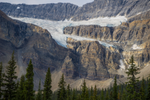
Carving out a route through the Rocky Mountains wasn't easy. Early pioneers had to lay rails on steep switchbacks and blast through rock with dynamite. But they persevered. And their efforts resulted in a track that hugs pine-clad slopes and clings to the mountainside. It twists and turns through view after stunning view. This Vancouver-to-Banff train route is a vital part of Canada's history. And it gets you so much closer to the wilderness than any road trip ever could.
From your seat, see ice-blue glacier lakes, alpine forests and dramatic rock formations. There's no better way to immerse yourself in the wild backcountry of the Canadian Rockies .
The travel expert at Canadian Train Vacations have local knowledge of these scenic Rockies train trips. We can customised our trip itineraries to your interests and preferences. You can choose your activities, train service level, and hotel type for the best vacation possible. Discover more about these trips.
Table of contents
Top canadian rockies train trips in 2024/25, why a canadian rockies train trip.
- Experience of Train Ride Through the Rockies
- Places to Visit in Canadian Rockies by Train
- How to choose your trip
- Planning a perfect Canadian Rockies train trip
Frequently Asked Questions
Our travel experts have picked some of our favourite Canadian Rockies train tours below. Get in touch for more information.

Keep reading or chat with one of our local travel experts. We’re passionate about Canada and can help you at any stage of your vacation planning.
Essential Rockies by Train
Discover the best of the Canadian Rockies in six days! Start your trip with a Rocky Mountaineer daylight train journey between Vancouver and Lake Louise. Admire the lake’s sparkling turquoise waters, then head to the mountain town of Banff for more adventures.
Miles on train : 594 Miles
Days on train : 2
Stops : Vancouver, Kamloops, Banff and Lake Louise
Complete Canadian Rockies by Rail
This 8-day Canadian Rockies itinerary is full of exciting activities so you can experience all the highlights in just over a week. Enjoy a train journey to Jasper and a sightseeing tour down the Icefields Parkway to Lake Louise. Explore both Banff and Jasper national parks on your choice of sightseeing tour. Read our Canadian Rockies train trip reviews and see why this is one of our bestselling trips!
Miles on train : 559 Miles
Train Stops : Vancouver, Kamloops, and Jasper
Canadian Rockies Voyage by Train
Experience an overnight train journey on this Rockies vacation package . See the towns of Banff and Jasper, as well as the West Coast city of Vancouver. This 6-day itinerary also includes a tour along the awe-inspiring Icefields Parkway and is packed with impressive mountain views.
Miles on train : 332 Miles
Days on train :1
Night on train : 1
Train Stops : Vancouver and Jasper
Download a brochure
Get inspired with sample itineraries, train information, route maps, and travel advice from our local experts.
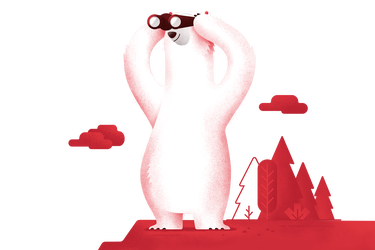
Canadian Rockies tours by train transcend the mode of transportation – it's an experience that captivates the senses, offering unparalleled relaxation as one discovers the classic appeal of train travel. Whether you’re seeking adventure, tranquility, or a bit of both, this journey through one of the world's most beautiful regions is sure to leave you with lasting memories.
Stand in awe of the turquoise waters and glacier mountain views at Lake Louise. Travel along the Icefields Parkway between Jasper and Lake Louise — this 232-kilometre stretch of highway is one of the most beautiful drives in the world. Watch for Rocky Mountain wildlife like elk, mountain goats, and bears. Glide past Mount Robson, the highest peak in the Canadian Rockies, as you travel by train. Discover emerald lakes and rushing waterfalls, which provide amazing photographic opportunities.
Here’s why you should consider embarking on a train ride through the Canadian Rockies:
Immersive Scenery
One of the most compelling reasons to choose a Canadian Rockies train vacation is the immersive experience of the stunning landscapes. From the comfort of your seat, you can gaze through panoramic windows and witness the awe-inspiring beauty of the region. There’s snow-capped peaks that glow in the sunlight, dramatic ancient glaciers that have shaped the land over millennia, and vibrant turquoise lakes that reflect the surrounding mountains. The journey also takes you through lush forests, each turn offering a new, captivating view.
Wildlife Spotting
The Canadian Rockies are home to a diverse range of wildlife, and a train ride trough the Rockies offers a front-row seat to observe these magnificent creatures in their natural habitat. As the train passes through the wilderness, keep your eyes peeled for bears roaming the forests, elk grazing in open meadows, and moose making their way through the marshlands. Eagles can often be seen soaring overhead, adding to the sense of awe and connection with nature. The trains’ routes through remote areas increases your chances of spotting animals.
Relaxing and Nostalgic
In an era where travel often involves hectic schedules and crowded airports, Canadian Rockies railroad trips offers a refreshing alternative. It's a stress-free way to travel, allowing you to sit back, relax, and enjoy the journey without the usual travel hassles. The gentle rocking of the train and the rhythmic sound of the tracks create a soothing ambiance, perfect for unwinding. The extended time during a scenic train ride in the Canadian Rockies and the many sights along the route allow you to fully appreciate the landscapes and wildlife, making the trip as enjoyable as the destination.
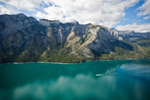
#1 Travel tip: Banff Gondola
There are many exciting activity options and attractions in Banff, including the Banff Gondola. Ride to the top of Sulphur Mountain and enjoy beautiful panoramic views of six mountain ranges!

Canadian Rockies Train Experiences
These are some suggested train experiences for your Canadian adventure.
Rocky Mountaineer, Daylight train
The Rocky Mountaineer winds through British Columbia and Alberta and stops in Jasper, Lake Louise, Banff, Vancouver, Whistler, Quesnel and Kamloops. There are three main train routes, including the Canadian Rockies train Vancouver to Banff . The train only runs during the daytime and from April to October (start and end dates vary annually). Large windows, an outdoor platform, and glass-dome coaches are perfect for sightseeing.

SilverLeaf and GoldLeaf are the two service levels on Rocky Mountaineer.
In SilverLeaf, guests have assigned seats in a single-level dome car. Breakfast and lunch are served to guests at their seat, with complimentary snacks and beverages available throughout the day.
In GoldLeaf , guests have assigned seats in a bi-level dome car. Seating is on the top level and a dining room is on the lower level. Breakfast and lunch are served in the dining room, with complimentary snacks and beverages available throughout the day.
VIA Rail Train
VIA Rail runs trains across Canada all year round. There are a few major train routes. The Canadian train passes through the Canadian Rockies, stopping at Jasper on its way to Vancouver from Toronto (or vice versa). On VIA Rail, you can also go to Prince Rupert, Winnipeg, Toronto, Ottawa, Montreal, Quebec and Halifax. VIA Rail offers daylight and overnight sleeper train experiences.
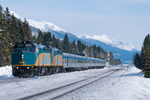
#2 Travel tip: Winter train trip
VIA Rail trains operate year-round. So, if you’re looking to visit the Canadian Rockies in winter, you can travel to Jasper by sleeper train from Vancouver or Toronto.

Sleeper Train, VIA Rail
One option for your Canadian Rockies train travel is the Sleeper train. Sleeper Class is available on The Canadian between Vancouver and Toronto. You can go all the way from coast to coast or choose to stop in Jasper or Winnipeg. Jasper is where you would disembark for your Canadian Rockies adventure.
There are three service levels on The Canadian train: Economy, Sleeper Plus, and Prestige. Both Sleeper Plus and Prestige classes are recommended if you are spending a long time on the train. Sleeper Plus includes a private berth or a cabin with bunk beds. Hot meals are served in the dining car of the train, and these are included throughout your journey. Prestige Class is a luxury service that includes priority meal reservations, afternoon tapas, snacks, drinks, meals, and more. Prestige Class cabins are larger than Sleeper Plus cabins and feature a lower bed for two. Prestige guests also have a dedicated concierge. Both Sleeper Plus and Prestige guests have access to the train’s viewing cars.
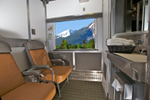
If you want to extend your stay in Canada, you can also sleep on board The Ocean train. This VIA Rail train travels between the provinces of Quebec, New Brunswick and Nova Scotia.
Both sleeper train routes are available all year long.
Alaska Cruise - suggested add-on
Canadian Rockies train tours from Vancouver can combine with an Alaska Cruise. The rail part of your trip can come before or after your Alaska cruise. There are two types of cruise ships. Choose a larger, more luxurious vessel or a smaller ship that allows you to visit more coves and inlets. Each type of ship has its advantages, so it depends on your style of travel and what you want to get out of your Alaska cruise adventure.

Download our Brochures and Mini Guides
Top 5 places to see in the canadian rockies.
These are examples of the places you can visit on a Canadian Rockies trip. Please get in touch to discuss your options and to check availability for your Canadian Rockies train ride.
1. Banff, Alberta
The townsite of Banff, established in 1885, is the hub of Banff National Park. A lively mountain town with great restaurants, Banff is a welcome change of pace. Enjoy strolling Banff Avenue or try one of the outdoor adventures. Banff was declared a UNESCO World Heritage Site in 1984 for its incredible mountain peaks, glaciers, lakes, and waterfalls.
[ Explore: Vancouver to Banff Train Tours ]

2. Jasper, Alberta
Nicknamed the 'gentle giant of the Rockies,' Jasper is a small alpine town in the heart of Jasper National Park. It’s the largest park in the Canadian Rockies and a UNESCO World Heritage Site. Jasper is also a Dark Sky Preserve, making it the perfect place for stargazing.
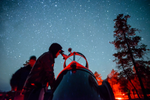
3. Lake Louise, Alberta
Lake Louise, named after the nearby lake, is a quaint hamlet in the heart of the Rockies. The lake is known for its sparkling turquoise waters and impressive glacier-clad peaks. It offers a surreal paddling experience in the warm summer months. In winter, the lake turns into one of the most scenic skating rinks in the world.
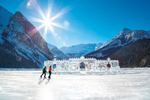
4. Yoho National Park, British Columbia
Yoho National Park, situated in eastern British Columbia, is part of the Canadian Rockies UNESCO World Heritage Site. The park is home to dramatic waterfalls, emerald lakes, fossil sites, and towering mountains. Field is a small town in the centre of the national park and the perfect place for lunch stops or cozy overnight stays.
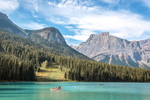
5. Canmore, Alberta
Surrounded by the peaks of the Rocky Mountains, Canmore’s lively arts scene, charming shops, and diverse dining options make it a welcoming mountain community. This quaint small town is in Kananaskis County, just 22 kilometres (12 miles) east of Banff.
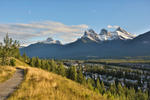
Choosing the Right Train Experience for You
Selecting your perfect train trip in the Canadian Rockies depends on various factors including your desired level of luxury, the specific route you wish to travel, and the time of year you plan to go.
Luxury vs. Classic
When it comes to choosing a luxury versus classic train experience, you need to consider your desired level of comfort, the type of service, and the amenities you’d like, as well as factoring in your budget.
Luxury Options
If you prefer a high-end experience with premium amenities, consider the GoldLeaf service on the Rocky Mountaineer.
- GoldLeaf Service: This top-tier option features bi-level coaches with full glass-dome windows on the upper level for panoramic views, gourmet meals prepared by executive chefs served in a dining car, and an exclusive outdoor viewing platform. The service is impeccable, with attentive staff ensuring every detail of your journey is perfect. For an ultimate luxury experience on a sleeper train, upgrade to VIA Rail’s Prestige Class, which offers unparalleled comfort and exclusivity on longer overnight journeys.
- Prestige Class: On VIA Rail's sleeper trains, Prestige Class provides private modern cabins with en-suite bathrooms, dedicated concierge service, and priority access to dining and lounge cars. It's an ideal choice for those seeking a blend of luxury and extended travel across Canada.
Classic Options
For travelers who prefer a more traditional experience or have a tighter budget, the other service tier options on these trains offer a charming and comfortable way to see the Rockies. You can still enjoy stunning views, cozy accommodations, and friendly service, making it a memorable journey without the premium price tag.
- SilverLeaf Service: While more affordable than GoldLeaf, Rocky Mountaineer’s SilverLeaf still offers an elevated experience with single-level dome coaches that provide excellent views, locally inspired cuisine served at your seat, and a high standard of service.
- Sleeper Plus: with VIA Rail’s Sleeper Plus, you still enjoy a private cabin and access to the lounge and dining cars. While some options have a private toilet, there are shared showers.
Route Considerations
Your choice of route will shape your overall experience, depending on whether you want an immersive Rockies adventure or a broader cross-country exploration.
- Rockies-Focused Routes : If your primary interest is in experiencing the Canadian Rockies, consider Rocky Mountaineer's daylight sight-seeing trains. These routes are specifically designed to highlight the most scenic and iconic parts of the Rockies, offering a concentrated and intensive experience of the region’s natural beauty.
- Cross-Country Journeys : For those looking to extend their adventure beyond the Rockies, VIA Rail’s "The Canadian" offers an epic journey from Vancouver to Toronto. This route provides a comprehensive cross-country experience, including the train across the Canadian Rockies, as well as the diverse landscapes of Canada, from prairies to forests to urban centres. It's a great option if you have more time and want to see more of what Canada has to offer.
Time of Year
The time of year you choose for your train trip in the Canadian Rockies can significantly influence your experience, as the scenery and available activities change with the seasons.
- Spring (April to June) : Spring brings a burst of colour to the Rockies with blooming wildflowers and rushing waterfalls fed by melting snow. Wildlife is also very active during this time, making it a great season for animal sightings.
- Summer (July to September) : Summer offers the most comfortable weather and the longest days, perfect for outdoor activities like hiking, kayaking, and sightseeing. The lakes are at their most vibrant turquoise, and the mountains are lush and green.
- Fall (October to November) : Fall is a spectacular time to visit for the autumn foliage, with its rich reds, oranges, and yellows. The cooler temperatures and fewer tourists also make for a more tranquil experience.
- Winter (December to March) : Winter transforms the Rockies into a snowy playground. While Rocky Mountaineer does not operate in winter, VIA Rail’s Canadian is affectionately known as the Snow Train, and offers a stunning train ride in the Canadian Rockies, especially as it travels between Vancouver and Edmonton. Tours at this time offer unique activities like skiing, snowshoeing, and ice skating. The snow-covered peaks and frozen lakes provide a serene and magical backdrop.
Practical Tips for Planning Your Train Trip
Planning a Canadian Rockies train trip requires thorough preparation to ensure you make the most of this extraordinary experience. From booking your tour to packing your bags, here are some essential tips to help you get ready for your adventure.
Booking in Advance
One of the most crucial steps in planning your Canadian Rockies train trip is booking your tickets well in advance. Popular routes and services, especially those during peak seasons, tend to sell out quickly.
- Peak Seasons: Summer (June to September) and the holiday season (December) are the busiest times. To secure your preferred dates and service level, it’s advisable to book several months ahead.
- Special Offers: Keep an eye out for early bird specials or promotional discounts that can save you money.
Booking early not only guarantees your spot but also gives you more flexibility in choosing the best travel dates and accommodations.
Combine with Other Destinations
Maximize your trip by combining your train journey with stays in nearby cities and attractions.
- Vancouver: Start or end your trip in Vancouver, a vibrant city known for its scenic waterfront, diverse culinary scene, and cultural attractions like Stanley Park and Granville Island.
- Calgary: If your route includes Calgary, take some time to explore this dynamic city, famous for its western heritage and the Calgary Stampede.
- Banff: Extend your time in Banff during your train vacation to experience everything this mountain town has to offer. Nestled in the heart of the Rockies, Banff offers stunning natural beauty, hot springs, and outdoor activities.
Activities and Excursions
Enhance your train trip with various activities and excursions available in the Canadian Rockies.
- Hiking: The Rockies are a hiker’s paradise with trails ranging from easy walks to challenging climbs. Popular hikes include Johnston Canyon and the Plain of Six Glaciers.
- Wildlife Tours: Join guided tours to see the region’s wildlife up close. Expert guides can take you to the best spots for viewing bears, elk, moose, and more.
- City Sightseeing: In cities like Vancouver and Calgary, take advantage of sightseeing tours to explore local landmarks, museums, and cultural sites.
What to Pack
When packing for a train trip through the Canadian Rockies, consider both comfort on the train and the area’s varying weather conditions.
- Clothing: Layered clothing is essential due to the fluctuating temperatures. Include a waterproof jacket, warm sweaters, and comfortable pants.
- Footwear: Bring sturdy, comfortable walking shoes for excursions and casual footwear for onboard.
- Essentials: Don’t forget your camera for capturing stunning landscapes, binoculars for wildlife spotting, and a good book or travel journal.
- Health and Comfort: Pack any necessary medications, travel-sized toiletries, and personal comfort items like a neck pillow or blanket.
Tailoring your packing list to the unique demands of train travel and the outdoor adventures in the Rockies ensures you’re well-prepared for a comfortable and enjoyable journey. By following these practical tips, you can effectively plan and prepare for a Canadian Rockies train trip and make the most of your spectacular rail journey through one of the world's most beautiful regions.
What Our Customers Say
The canadian rockies were amazing.
The landscape and scenery were some of the most beautiful we've ever seen. And the only way to see it is by train. The Canadian Rockies were amazing!
![canadian rocky mountains travel guide Susan and Brian review of their [object Object] trip](https://cdn.bfldr.com/UAHFH8T4/as/km9cj7cw6nhs5xp8nqxnwqg9/Susan_Brian_521?auto=webp&format=webp&width=75)
Susan and Brian
The scenery in the Rockies was breathtaking
Our vacation was awesome. Kudos to Fresh Tracks Canada as all our scheduled connections and tours went exactly as planned. All the services provided were excellent and the people w... read more
![canadian rocky mountains travel guide John and Kathy review of their [object Object] trip](https://cdn.bfldr.com/UAHFH8T4/as/q9q4nk5qq5s9rkfvxvc75bbm/John_Kathy_197?auto=webp&format=webp&width=75)
John and Kathy
It could not have been better! I will recommend you to everyone!
First if all, the absolute best part about our trip was all the arrangements you made. Everything was perfect - all limos were great and on time, hotels were wonderful (especially... read more
![canadian rocky mountains travel guide Carol Ann and Jim review of their [object Object] trip](https://cdn.bfldr.com/UAHFH8T4/as/7fjvfr35qgw6kp4gqpvtj589/Carol_Ann_Jim_152?auto=webp&format=webp&width=75)
Carol Ann and Jim
The natural beauty of the Canadian Rockies amazed us
The natural beauty of the Canadian Rockies amazed us. We thoroughly enjoyed our dinner in Vancouver while watching float planes take off and land. The Rocky Mountaineer provided us... read more
![canadian rocky mountains travel guide Larry and Myra review of their [object Object] trip](https://cdn.bfldr.com/UAHFH8T4/as/rvpbtb9kw5vb6st4q9sjk4jp/Larry_Myra_529?auto=webp&format=webp&width=75)
Larry and Myra
The Athabasca Glacier walk was everyone's favorite!
We absolutely LOVED the Rockies! We took our kids to Europe last year and my oldest said, "I'd take this trip (meaning the Rockies) over Europe, any day!" It was even more beautifu... read more
![canadian rocky mountains travel guide Heidi and Christopher review of their [object Object] trip](https://cdn.bfldr.com/UAHFH8T4/as/jtfq3mk5cm8jnvgxckrpw/Heidi_Christopher_213?auto=webp&format=webp&width=75)
Heidi and Christopher
The Rockies were the highlight of the trip
The Rockies were the highlight of the trip. We loved it. We could have stayed in Jasper another day. The staff at Fresh Tracks were both very helpful. I felt they both cared about... read more
![canadian rocky mountains travel guide Brenda and Damon review of their [object Object] trip](https://cdn.bfldr.com/UAHFH8T4/as/s5ctcz8nps989xqr7r5nj77p/Brenda_Damon_479?auto=webp&format=webp&width=75)
Brenda and Damon
All of the activities were wonderful!
All of the activities were wonderful! The river rafting and kayaking were the best. All of the feedback and help from Fresh Tracks was excellent. We were extremely satisfied with t... read more

Jeff and Cathy
We had an awsome holiday
Well we're all back now, and we had an awsome holiday! Thank you so much for putting that together, and how you managed to get such great suites in each of the hotels I dont know! But cheers!

Glenn, Brett and Matthew
We loved everything!
We loved everything! Lake Louise is perfect. The helicopter and dogsledding were amazing on a perfect day. We were very impressed by the efficiency and good advice from Fresh Track... read more

Pauleen and Anthony
QLD, AUSTRALIA
Where are the Canadian Rockies located?
The Canadian Rockies cover parts of northern British Columbia and Alberta. The Canadian Rocky Mountain UNESCO World Heritage Site is made up of seven parks. Banff, Jasper, Kootenay and Yoho national parks. Mount Robson, Mount Assiniboine and Hamber provincial parks.
When is the best time to visit the Canadian Rockies?
The best time to visit the Canadian Rockies is the fall, but they are a great destination year-round. Each season offers a different experience, so the ideal time depends on what you'd like to see and do. To see snow-covered peaks and frozen lakes and go skiing or snowshoeing, head to the Rockies between December and February. Spring and summer months bring ideal hiking and wildlife viewing conditions. With warm temperatures and sunshine, June, July, and August are the most popular months to visit. For those who want a quieter experience, travelling to the Rockies in September and October is ideal. Larch trees change from green to yellow during mid to late September. If you would love to witness the mesmerising fall colours, this is the perfect time to go.
How much does a Canadian Rockies train trip cost?
The price of a train trip through the Rockies depends on season, length and inclusions. For example, if you’re considering the Rockies Rail Winter Wonderland itinerary, this train trip through the Canadian Rockies starts from $2,430 USD per person. Pricing includes transfers, hotels, and some meals and activities. Reach out to one of our Canadian Train Vacation Advisors to find the Canadian Rockies tour by train that best suits your preferences and budget.
How tall are the Canadian Rockies?
Mount Robson, at 3,954 metres (12,972 feet) tall, is the highest peak in the Canadian Rockies.
How can you see the Canadian Rockies?
You can get to the Canadian Rockies by train or vehicle. You can fly to Vancouver, Edmonton or Calgary, then make the journey to Banff, Jasper or Lake Louise. There are so many ways to explore the Canadian Rockies. Enjoy sightseeing tours, lake cruises, mountain gondolas, alpine hiking and more.
Schedule a call with one of our Vacation Advisors to learn more about Canadian Rockies train excursions.
Can you drive through the Canadian Rockies?
Yes, you can drive the Trans Canada Highway through the Canadian Rockies. Between Banff and Lake Louise, the Bow Valley Parkway is a more scenic driving route. The Icefields Parkway between Banff National Park and Jasper National Park is beautiful.
Is Whistler in the Canadian Rockies?
Whistler is in the Coast Mountains of British Columbia and is not part of the Canadian Rockies. Whistler is about a two-hour drive from the city of Vancouver.
Which train ride is best through the Canadian Rockies?
If you are looking to enjoy a daylight train ride through the Canadian Rockies, then a Rocky Mountaineer journey is best. If you want to experience sleeping on the train as you travel to the Rockies, then choose VIA Rail’s Canadian train. Our Ultimate Rockies Rail Journey includes both trains.
How long do you need in the Canadian Rockies?
The amount of time you need to fully experience the Canadian Rockies depends on your interests and the specific places you want to visit. A minimum of 4-7 days is recommended to see the highlights of the Canadian Rockies, though you can easily spend two weeks exploring this area.
About the author: Katherine is Product Manager with Fresh Tracks Canada. Having worked in the Canadian travel industry for almost 20 years, she enjoys sharing her local expertise with visitors. She is based in Calgary and one of her favourite Canadian destination is the... Read more
Explore More Tours
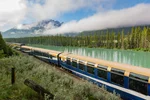
Rocky Mountaineer trips

Tours for Seniors

Vancouver train tours

Bucket list trains

Sleeper Trains

Explore VIA Rail
Discuss your Canadian train vacation with a local travel expert
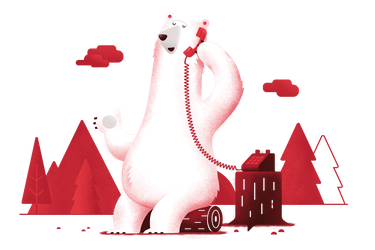
Or call us toll free
Current promotions
Sign up for special offers, monthly Canadian Insider tips, and vacation inspiration.
By submitting this form, you agree to our collection and use of your personal data as detailed in our Privacy Policy . Your information will be used to process your request and improve our services.
Canadian Rockies Tours & Vacations

‘There’s no way that’s not Photoshopped’...
This is what your friends will say when you show them your Canadian Rockies travel pics. This mighty mountain range is a (huge) segment of the Rocky Mountains which spans 3000 miles from British Columbia to New Mexico . It’s home to four national parks – Banff, Jasper, Kootenay and Yoho – and some of North America ’s most breathtaking scenery. Think impossibly blue lakes, sprawling glaciers and ice fields, and ink-blank skies occasionally graced with the Northern Lights . If you like the sound of trekking in the shadows of snow-dusted peaks, standing in the mist of some of Canada ’s tallest waterfalls or canoeing to a secluded beach to camp under the stars, then a Canadian Rockies trip has your name all over it.
Our Canadian Rockies trips
Let's create an exclusive trip for your group.
Canadian Rockies highlights
Canadian rockies tour reviews.
Filter by rating
Hiking in the Canadian Rockies
Real Canada
Canadian Rockies travel FAQs
How to get to the canadian rockies.
There are a few ways you can get to the Canadian Rockies depending on where you're travelling from.
The easiest (and quickest) way is to fly to Calgary, about an hour and a half from Banff National Park. (Most of our Rockies trips begin in Calgary or Vancouver, anyway). You can then hire a car at the airport or jump on a shuttle bus to Banff.
You could also fly to Edmonton, which is about a four hour drive away from Banff and Jasper.
How do I get around the Canadian Rockies?
Covering almost 77,000 square miles across Alberta and British Columbia, the best way to get around the Canadian Rockies is to join a tour or drive.
If you've flown into Calgary (the closest airport to Banff National Park), you can hire a vehicle from several car rental companies and continue your journey to the Rockies.
Without a car, you may struggle to travel around the region's national parks.
When is the best time to visit the Canadian Rockies?
The best time to visit the Canadian Rockies depends on the activities you want to do. Summer is for kayaking, swimming, hiking and camping, while winter calls for ice skating, dog sledding and skiing down Canada's best slopes. Winter also offers a chance to see the Northern Lights.
The summer (June through August) is the peak season in the Rockies thanks to the milder weather, which also means higher accommodation prices and more people on the trails. Try going in the 'shoulder' months of April, May, September or October for a balance of good weather and smaller crowds.
What do I pack for a trip to the Canadian Rockies?
Packing for a trip to the Canadian Rockies is similar to packing for a trip anywhere. What you pack largely depends on the time of year you're travelling.
If you're going in winter, pack appropriate weather clothing such as gloves, beanies, waterproof jackets, long pants etc.
If you're travelling in summer, pack sunscreen, a sunhat, t-shirts, dresses, and shorts.
You should also pack the essentials: a camera, a reusable drink bottle, and a backpack/day bag.
Are Intrepid trips accessible for travelers with disabilities?
We are committed to making travel widely accessible , regardless of ability or disability. We do our best to help you see the world, regardless of physical or mental limitations.
We are always happy to talk to travelers with disabilities and see if we can help guide them toward the most suitable itinerary for their needs and, where possible, make reasonable adjustments to our itineraries.

COMMENTS
Spring in the Canadian Rockies is a transitional season marked by melting snow, emerging wildlife, and blooming wildflowers. The temperatures gradually rise, ranging from 5°C to 15°C (41°F to 59°F), and the days become longer. Spring is a quieter time to visit, with fewer tourists compared to the summer months.
There are several other alternative parks and overlooked areas in the Rocky Mountains that are worth your time. Driving a circle route that includes the west coast of B.C. warrants at least ten days to two weeks. It's nearly 850 km's between Vancouver and Banff and a minimum of 9 hours of driving time each way.
LAIDBACK TRIP. Planning a budget trip to the Canadian Rockies is challenging. Our travel guide includes tips on the best things to do, top attractions, activities, must-visit places, when to go, where to stay, how to get around, and how much things cost in Canada. Simply put, here's everything you need to know before traveling to the Canadian ...
The Class 3 Sunwapta River, 55km south of Jasper, offers some thrilling stretches of water, magnificent landscapes and good chances to spot wildlife. The Class 2-3+ Maligne River, 45km from town, includes a lively 1.6km stretch of rapids and is used for a variety of trips from July to September.
Winter is usually middle/late September to around early April in the Rockies. Summer is for blue likes and incredible hiking, which runs mid-late June to early September. The weather can be pretty unpredictable in the mountains, so be prepared for at least one cold day during your trip because it is possible! 5.
What to Pack for the Canadian Rockies. The Ultimate 10-Day Canadian Rockies Itinerary. Day 1: Calgary to Canmore. Day 2: Hiking in Canmore. Day 3: Banff Town & Iconic Sights. Day 4: Hiking in Banff National Park. Day 5: Lake Louise, Moraine Lake, & Johnston Canyon. Day 6: Icefields Parkway.
June weather in the Canadian Rockies is mostly rainy as it is the wettest month. July and August weather is the best for any summer activities with the longest daylight. Temperatures hit even 30 °C mark. This is the best time for hiking, trekking, biking, kayaking, and even swimming in the lakes.
Discuss your Canadian train vacation with a local travel expert. Schedule a call Send us a message. Or call us toll free. Discover the best of Rocky Mountains with this official Canadian Rockies Train Travel Guide. Get sample itineraries and experiences to start planning your trip.
The 232 km stretch of road from Lake Louise in Banff National Park to Jasper encompasses what I consider to be the heart of the Canadian Rockies. Travel past monumental glaciers, icy blue lakes, enormous mountains, and stretches of road that simply have to be seen to be believed.
Setting off from Banff town, you can follow the 4.3 km (2.7 mile) Tunnel Mountain Trail, which winds up 300 m (984 ft) through pine forest to a viewpoint at Banff's lowest summit. Again, the trail is quite steep in places, but well maintained and signed. At the top, stop to take in a panorama of the town and the Bow and Spray River Valleys.
Day 1: Arrival in Calgary and Drive to Banff. Upon landing at Calgary, pick up your rental car and hit the road for a short 90-minute drive to the picturesque town of Banff. It's not long after you leave the city of Calgary that you'll get your first glimpse of the Rocky Mountains.
Calgary in Alberta and Vancouver in British Columbia are the key international gateway cities to the Canadian Rocky Mountains, which sit astride the two provinces. For an instant hit of big ...
ABOUT THE CANADIAN ROCKIES. Snowcapped mountains, glaciers and icefields, turquoise lakes, rushing rivers, colourful wildflower meadows, abundant wildlife, and outstanding recreational opportunities make the Canadian Rockies a destination that is rivaled by few places in the world.
This is also true if you're driving back home, unless you live in Edmonton, which is up near Jasper. This is what the resulting 10 day trip looks like, at a high level: Day 1: Arrive in Calgary (Sleep in Banff) Day 2: Banff. Day 3: Banff. Day 4: Drive Banff to Jasper (Sleep in Jasper) Day 5: Jasper. Day 6: Jasper.
Here is our Canadian Rockies road trip guide! Table Of Contents. ... The best time of the year to travel to the Canadian Rockies is summer and early fall. ... Spirit Island is one of the most iconic landmarks in Canada's Rocky Mountains and the only way to reach it is by boat. Everyday at 9am overpriced tourist boats head out to see it but we ...
Operates trains routes across Canada, including The Canadian into the Canadian Rockies via Edmonton or Vancouver. (updated Apr 2022) Rocky Mountaineer, toll-free: +1-877-460-3200. Operates a luxury tourist train service, which is a beautiful way to get to the Rocky Mountains and to see many spectacular sights from the dome car. See also Rocky ...
Best Time To Take A Road Trip Of The Canadian Rockies. The best time to take a road trip through the Canadian Rockies and visit the likes of Banff National Park and Yoho National Park is during the summer months, from June to September.. During this time, the weather is generally warm and sunny, and the roads are clear of snow and ice.This makes it easier to access the parks and enjoy the many ...
The Canadian Rocky Mountains are filled with many amazing places to visit. The Canadian Rockies are home to incredible hikes and waterfalls! ... Avid adventurer, travel blogger, and experience seeker. ... A Complete Guide to Capilano Suspension Bridge Park in Vancouver. Pingback: May 2, 2021 at 6:10 pm. Incredible Places to Visit in Canada This ...
Slightly less popular than it's neighbor Banff, Jasper National Park is a wonder in its own right. It's the largest National Park in the Canadian Rockies at 4,200 square miles. In the namesake town, we found less crowds and more of a small-town feel. The lakes and waterfalls alone are worth the trip from Banff.
For all these Canadian Rockies experiences, fly into Calgary, then head for the mountains in Banff, Jasper or eastern British Columbia. Or combine a Rockies tour with time on the coast in Vancouver. Either way, prepare for an epic Canadian holiday. Walk on a Glacier. A drive along the strikingly beautiful Icefields Parkway between Lake Louise ...
The Iceline Trail. Next, it is time to drive back towards Banff to end the final day of your 7-day Canadian Rockies itinerary. Finally, you can hike alongside the glaciers at the Iceline Trail while viewing the Takakkaw Falls from above. After that, you can head over to Ha Ling Peak for the grueling thigh-burning hike.
Discover the best of the Canadian Rockies in six days! Start your trip with a Rocky Mountaineer daylight train journey between Vancouver and Lake Louise. Admire the lake's sparkling turquoise waters, then head to the mountain town of Banff for more adventures. Miles on train: 594 Miles. Days on train: 2.
This is what your friends will say when you show them your Canadian Rockies travel pics. This mighty mountain range is a (huge) segment of the Rocky Mountains which spans 3000 miles from British Columbia to New Mexico. It's home to four national parks - Banff, Jasper, Kootenay and Yoho - and some of North America 's most breathtaking ...
Four red Adirondack chairs in the wilderness. Two luxurious 5-star stays. One full-fledged breakdown on top of a mountain. We're kicking off our 10-day Canadian Rockies Road Trip exploring Banff, Yoho National Park, and the iconic Fairmont Chateau Lake Louise.